Early Los Angeles City Views (1800s)
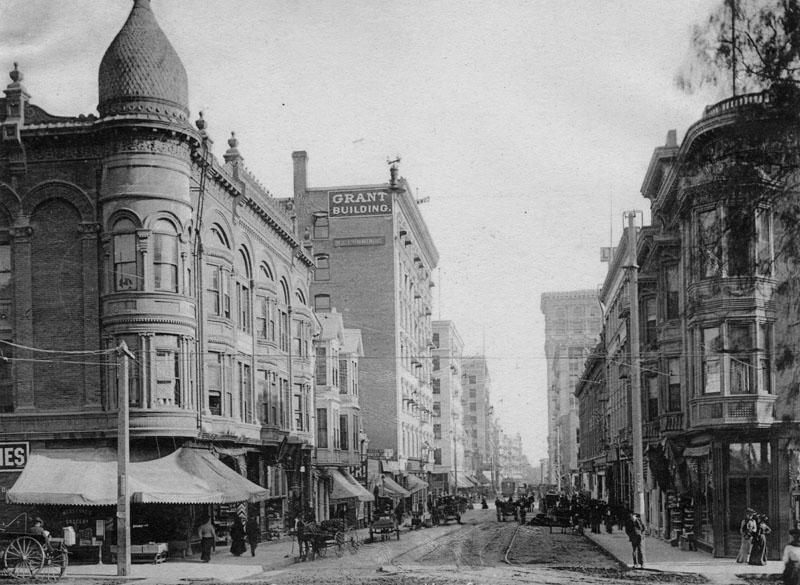 |
|
| (ca. 1890)* - View looking east down an unpaved 4th Street from Hill Street. An awning covers Meuschke's Grocery located on the ground level of the Brighton Hotel building on the N/E corner (left). The Grant Hotel can be seen in the background. Deliveries are being made by horse-drawn wagons to the various stores. |
Historical Notes Between 1880 and 1890, the City of Los Angeles saw one of its fastest growing periods (percentage wise). Population increased from 11,200 to 50,400 (350%). |
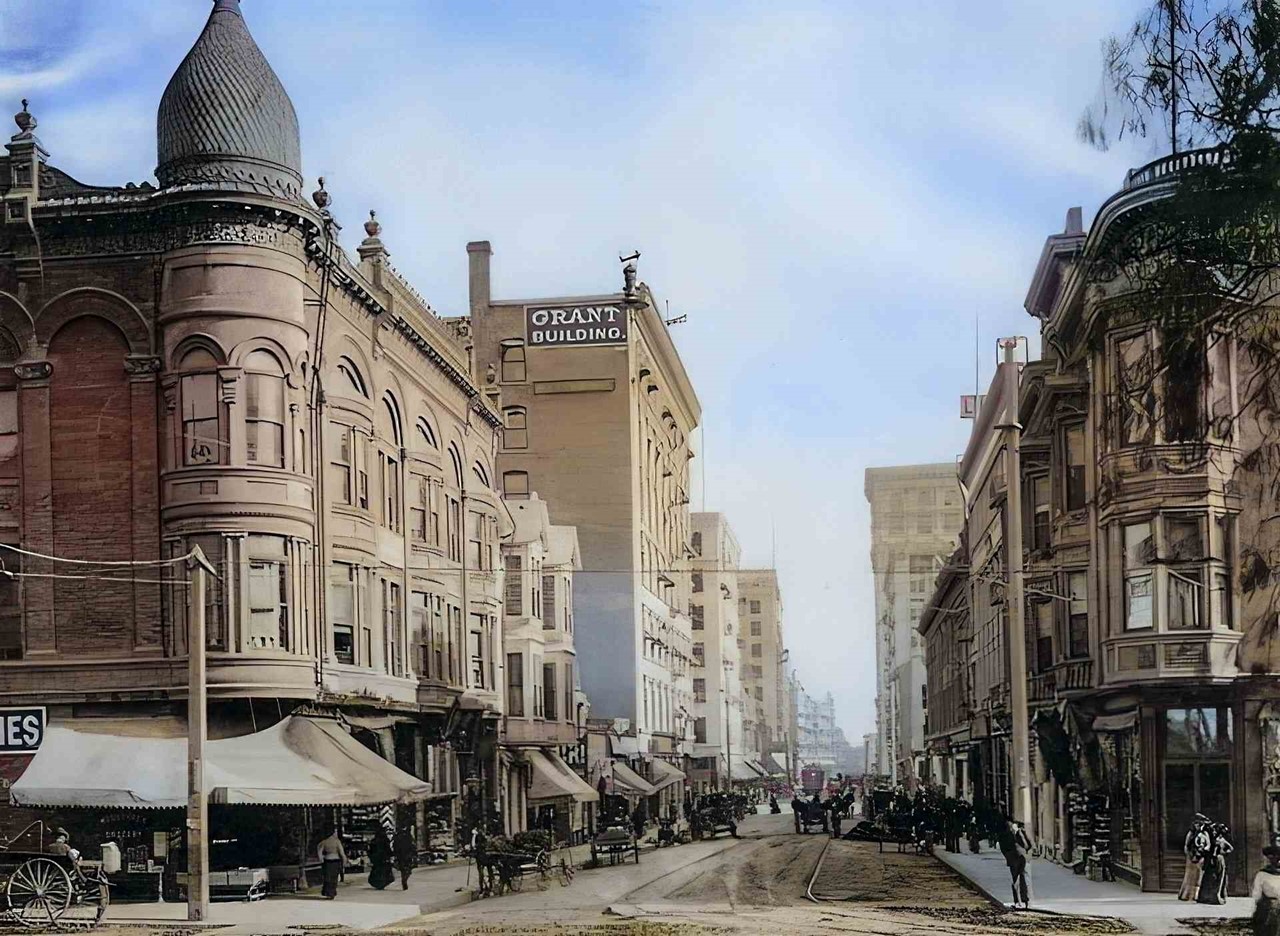 |
|
| (ca. 1890)* - View is looking east on 4th Street at Hill Street with the three-story bay-windowed and turreted Brighton Hotel seen on the northeast corner, and horse-drawn wagons seen throughouht. (AI image enhancement and colorization by Richard Holoff) |
30 Years Later
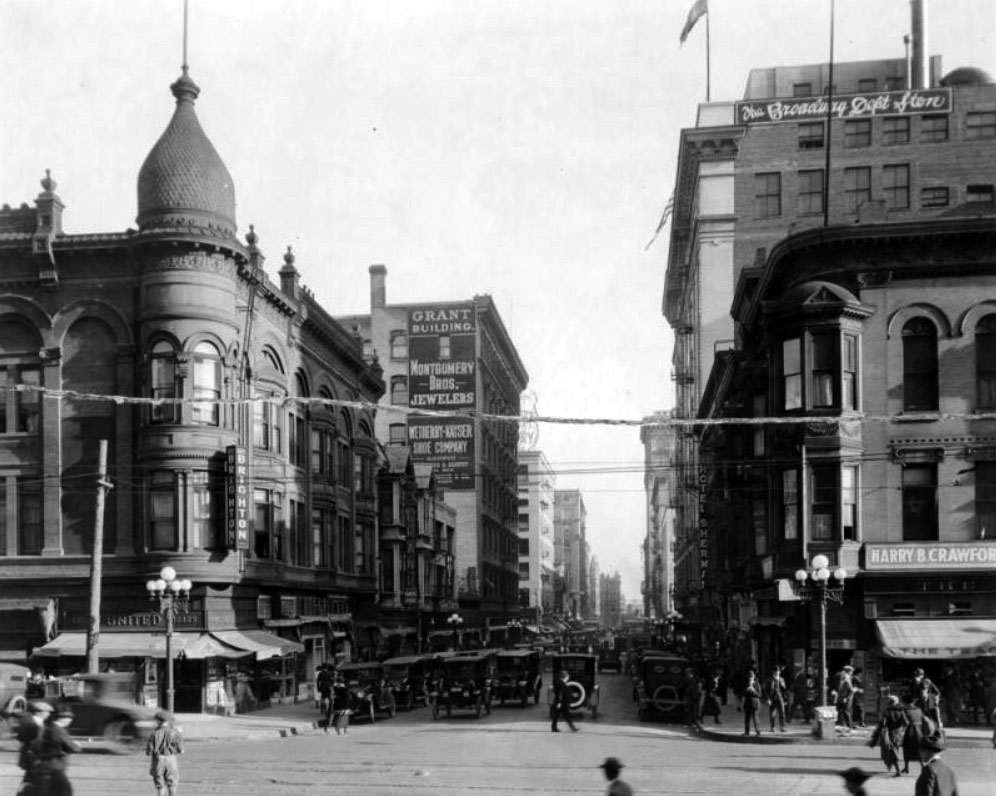 |
|
| (ca. 1920)* - A view looking east down busy 4th Street and its intersection at Hill in downtown Los Angeles. A crowd of pedestrians and autos wait to cross Hill. United Cigars, left, is below the fanciful Brighton Hotel. Center is the Grant Building with the Broadway Department Store opposite. The Teague Drug Co., opposite United Cigars, is below the Hotel Sherman. Other businesses include clothing stores, cafeterias, and dentists. Click HERE to see contemporary view. |
Historical Notes Between 1890 and 1920, the City of Los Angeles saw its population increase from 50,400 to 576,700. That's an 1,044% increase in 30 years. |
Then and Now
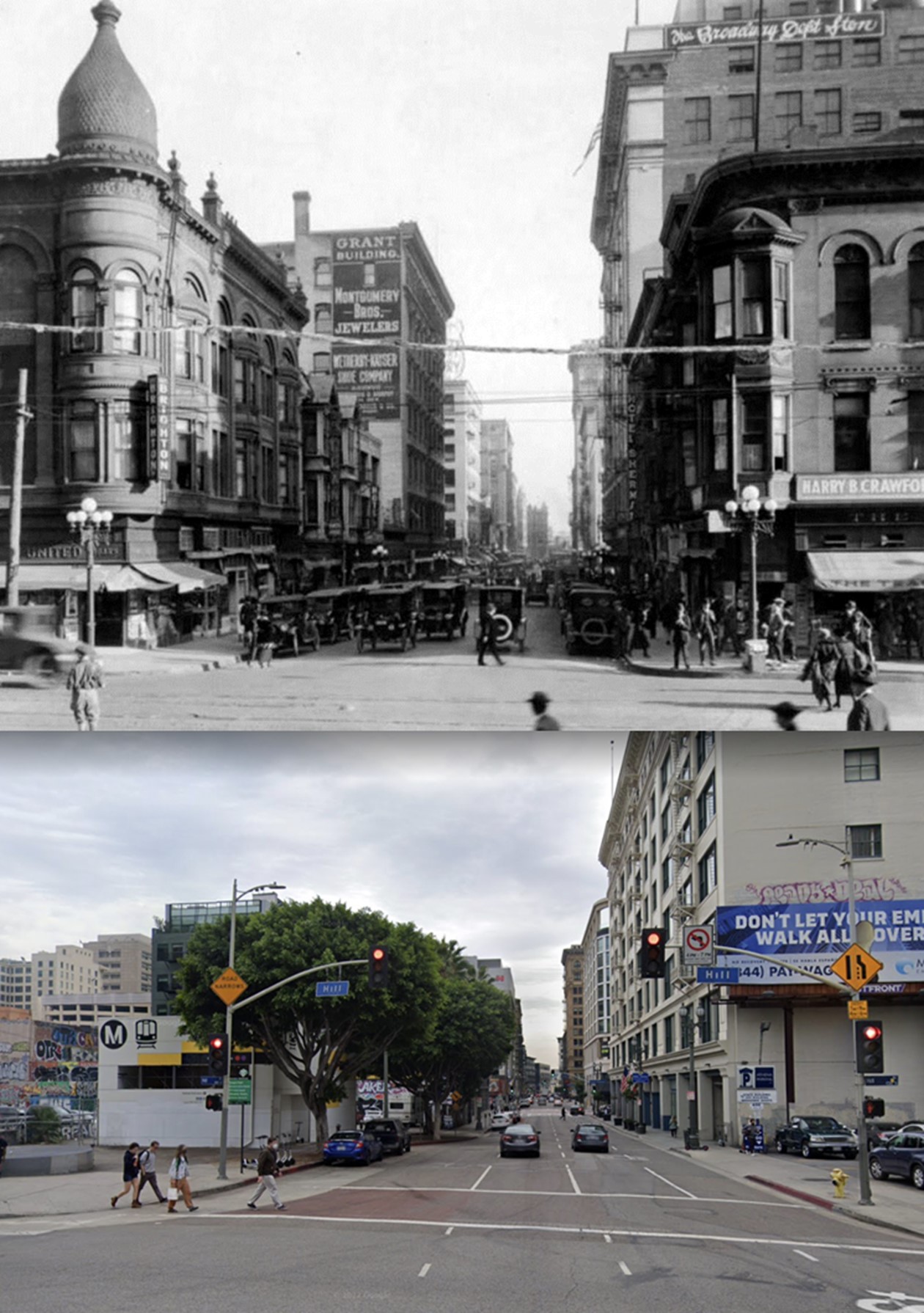 |
|
| (1920 vs. 2022)* – Looking east on 4th Street at Hill Street. Photo comparison by Jack J. Feldman. |
* * * * * |
Spring and 1st Street
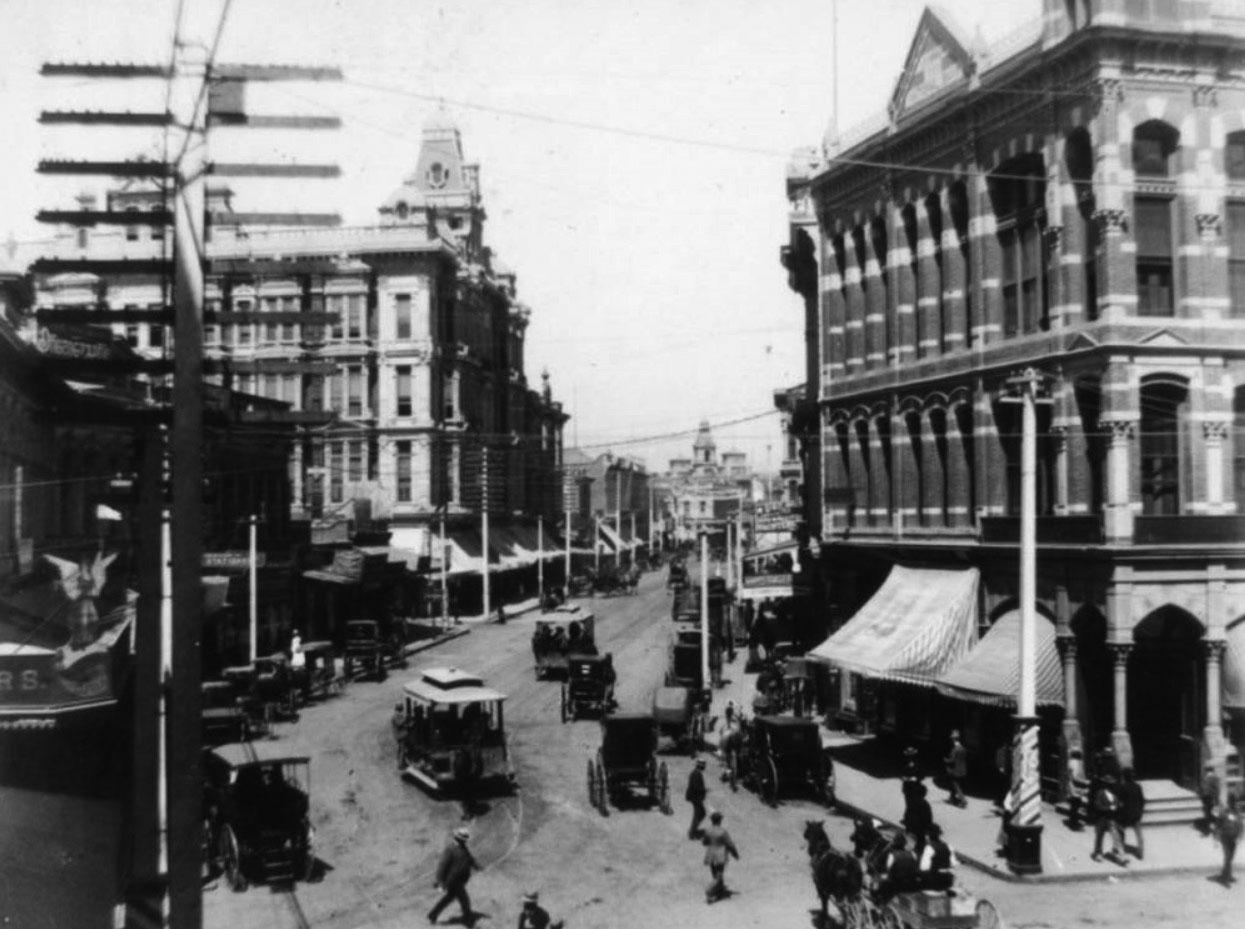 |
|
| (ca. 1888)* - Postcard view looking north on Spring Street from 1st Street. Los Angeles National Bank Building is on the northeast corner on the right. Down the block (center-left) is the 1887-built French Renaissance-style Phillips Block who's main tenant was the Hamburger & Son's People's Store. In the far distance can be seen the main cupola of Baker Block located on Main Street. Note the Horse-Drawn Streetcars (in operation from 1874 to 1888). |
Historical Notes With a thriving population of 50,395 (1890), 1st and Spring Streets, where present-day City Hall now stands, was the heart of the city. At that time the downtown section extended north of 1st Street, while the residential section started about 4th Street to the south. Spring Street between Temple Street and 1st Street was a vital part of early downtown Los Angeles in the late 1880s. This section formed the heart of the central business district, with the intersection of 1st and Spring considered the city's center. The area was characterized by significant commercial development, reflecting the rapid growth of Los Angeles during this period. Notable buildings along this stretch included the Los Angeles National Bank Building, the Phillips Block (which housed A. Hamburger & Son's People's Store), and the Nadeau Hotel. Transportation evolved from horse-drawn streetcars to electric streetcars by the early 1890s, further enhancing the street's importance as a bustling hub. As Los Angeles experienced a population boom, increasing from 11,200 in 1880 to 50,395 by 1890, this section of Spring Street became increasingly busy and commercially vibrant. The area's significance in the 1890s laid the foundation for future development, though many of the original buildings were later demolished to make way for the Civic Center district in the 20th century. |
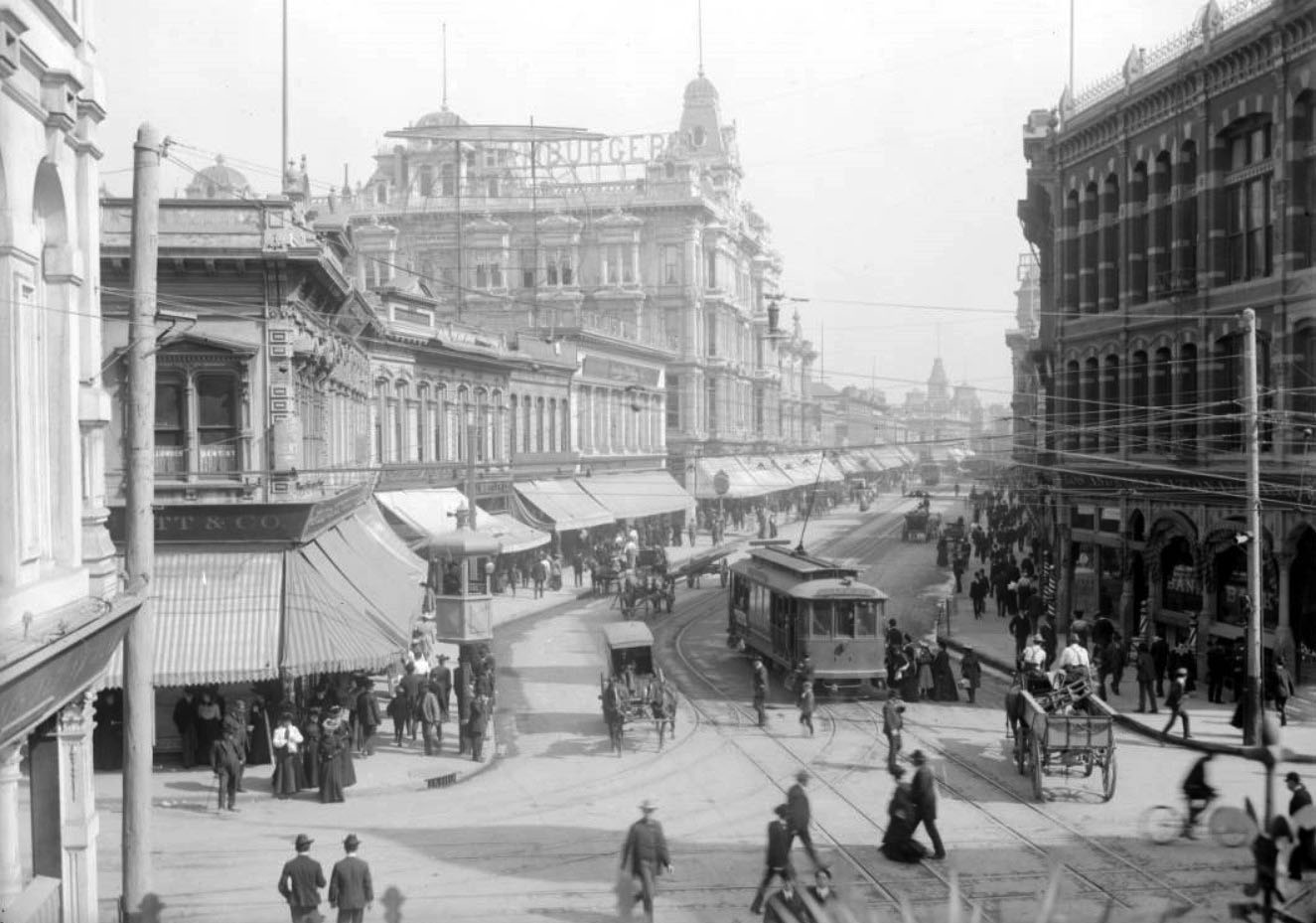 |
|
| (ca. 1890s)* - View is looking north on a very busy Spring Street from 1st Street. A portion of the Nadeau Hotel (1882), LA's first 4-story building, is seen at far left (SW corner of Spring and 1st). Across the street (NW corner) stands the Larronde Block. A very large sign for Hamburger's Department Store can be seen on top of the 4-story Phillips Block (1887) at center of photo. To the right (NE corner) is the Los Angeles National Bank (also built in 1887). This is where City Hall stands today. Note that electric streetcars have now taken over for the Horse-Drawn Streetcars seen in previous photo. |
Historical Notes A. Hamburger and Sons was one of the first department stores to operate in Los Angeles. Originally known as A. Hamburger & Son's People's Store, the name later changed to Hamburger's Store. In 1908 the company relocated their store from Spring Street to a newer building located at Broadway and Eighth Street. May Department Stores acquired Hamburger's in 1923 and renamed it the May Company. Much later in the century, the May Company and Robinsons chains of department stores would affiliate under the name Robinsons-May; and this entity would be bought out by Macy's in 2005. |
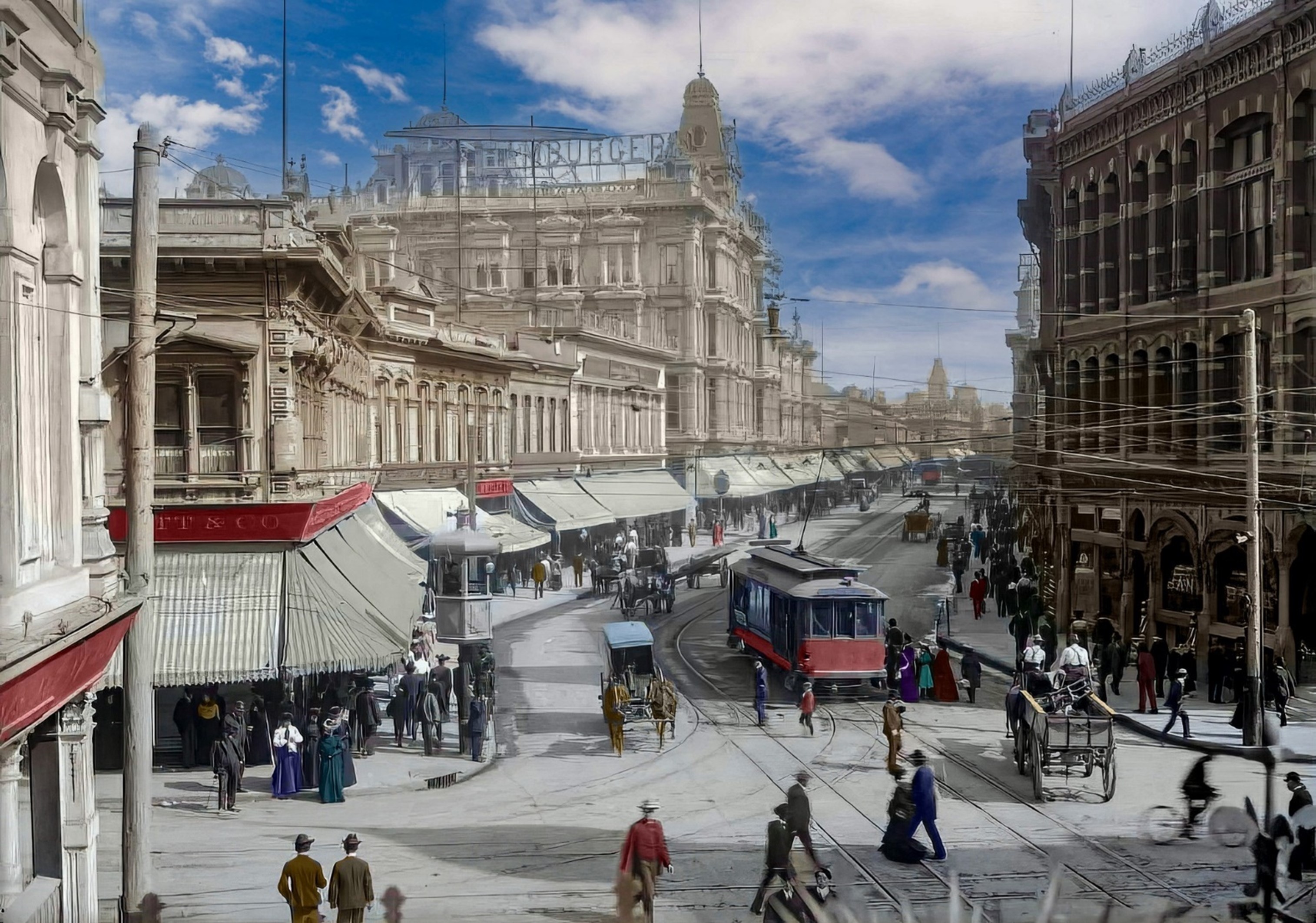 |
|
| (ca. 1890s)* - Looking north on Spring Street at 1st Street. Photo: C.C. Pierce / USC Image Library; Image enhancement and colorization by Richard Holoff. |
Historical Notes Note the elevated kiosk on the northwest corner of the intersection. Elevated booths like these were used by the Los Angeles Railway and the Yellow Cars as a switchman’s tower to control the flow and path of streetcars through the intersection. Many of these were still standing well into the 1920s. |
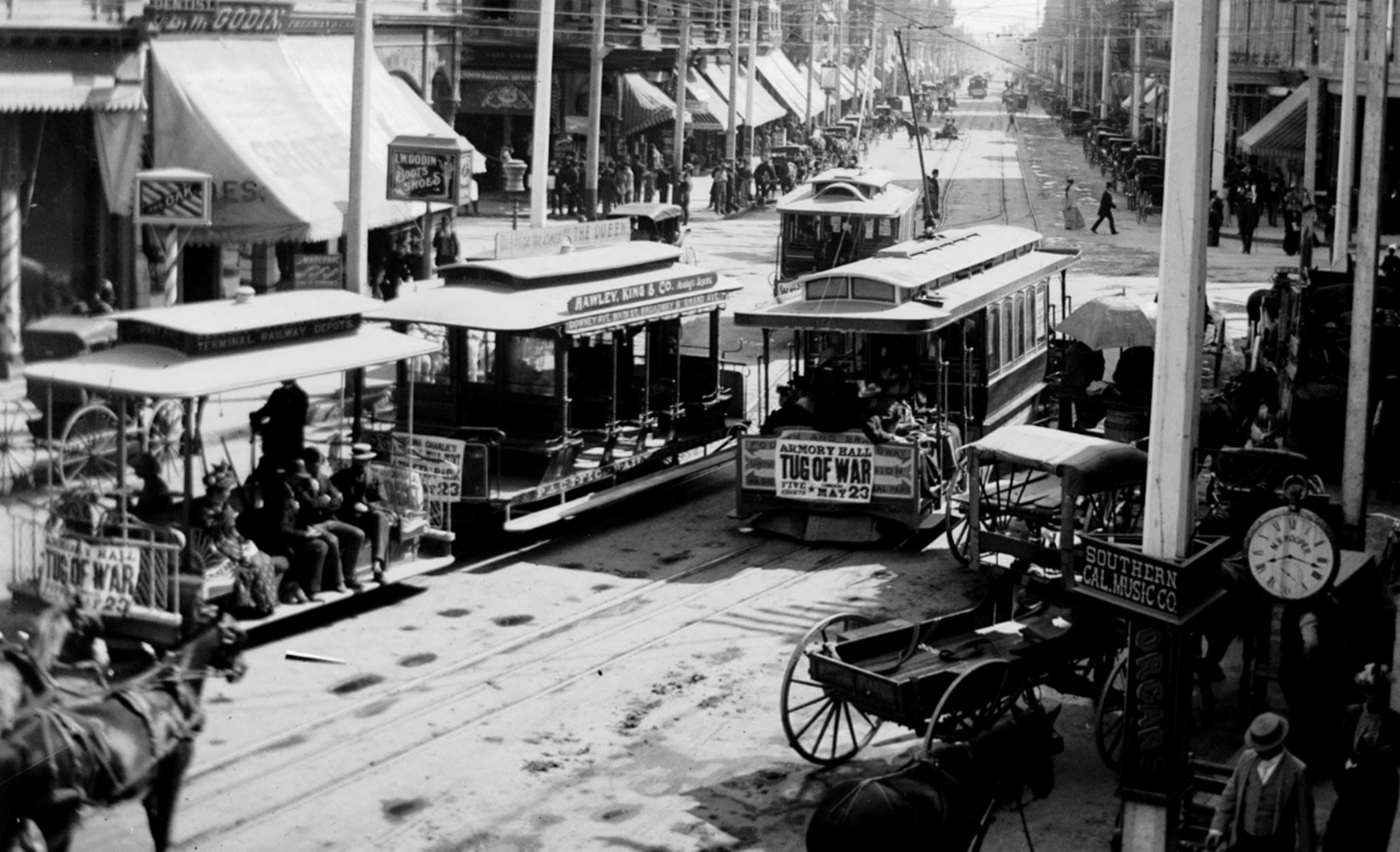 |
|
| (1896)* – Passing of the Guard: A new electric streetcar is seen side by side with a cable streetcar at Spring Street and 1st Street in downtown Los Angeles. Cable streetcars, first introduced in the 1880s, were short-lived in the city. Just 16 years after L.A. celebrated its first cable railway as a technological marvel, the last of its cable cars rolled down Spring Street and into obscurity, replaced by the more modern electric streetcar. View is looking south. Photo courtesy of Ray Long. |
Historical Notes There were three cable railways in Los Angeles. The Second Street, which lasted but a few years, was tied into a real estate development west of Bunker Hill. It succumbed with the collapse of Echo Park Lake. LA Cable closed in 1896. The third line, Temple Street Cable Railway, survived until 1902 when it became Los Angeles Railway’s “A” Line. |
 |
|
| (1897)* - The Nadeau Hotel, showing the entire SW corner at 1st and Spring Streets, the present site of the LA Times iconic building. The hotel was built in 1882 as the first 4-story building in L.A. A paved street now visible. Horses, carriages, cars and trolleys, along with people are now visible. A sign giving the name of the hotel sets on the corner of the roof. The hotel advertises that it is heated by F.E. Brown's hot air furnace, and testimonials are available. Architects, Morgan & Walls. |
Historical Notes Remi Nadeau was a French Canadian pioneer who arrived in Los Angeles in 1861 driving a team of oxen. During the silver-mining excitement in the Cerro Gordo region of Inyo County his teamster operation brought tons of silver to Southern California and hauled back food and supplies to the miners. By 1873 he operated 80 such teams. He also built the Nadeau Hotel, Los Angeles's first four-story structure and the first building with an elevator. |
* * * * * |
Spring and Temple
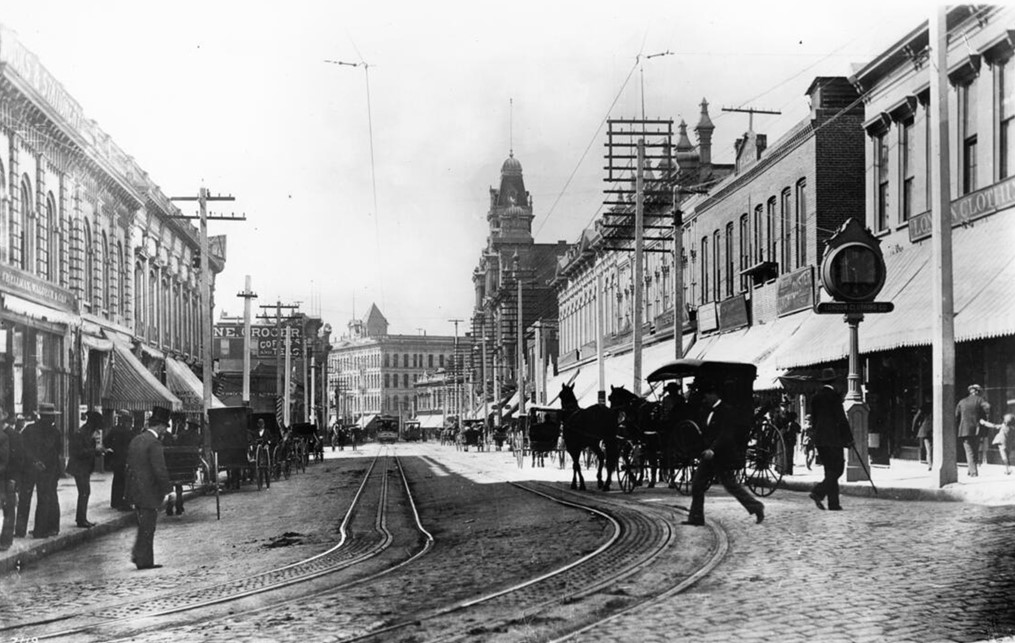 |
|
| (1896)* - Spring Street looking south from Temple. Horse-drawn vehicles are seen mainly parked along the curbs while pedestrians cross the cable car tracks. The two largest building seen in the distance are the Nadeau Hotel (SW corner of Spring and 1st) and the more ornate Phillips Block (25-37 N. Spring Street). The tower seen behind the Nadeau Hotel is the 1888-built City Hall located on Broadway. Photo by C.C. Pierce |
Historical Notes Spring Street between Temple Street and 1st Street was a vital part of early downtown Los Angeles in the 1890s. This section formed the heart of the central business district, with the intersection of 1st and Spring considered the city's center. The area was characterized by significant commercial development, reflecting the rapid growth of Los Angeles during this period. Notable buildings along this stretch included the Los Angeles National Bank Building, the Phillips Block (which housed A. Hamburger & Son's People's Store), and the Nadeau Hotel. Transportation evolved from horse-drawn streetcars to electric streetcars by the early 1890s, further enhancing the street's importance as a bustling hub. As Los Angeles experienced a population boom, increasing from 11,200 in 1880 to 50,395 by 1890, this section of Spring Street became increasingly busy and commercially vibrant. The area's significance in the 1890s laid the foundation for future development, though many of the original buildings were later demolished to make way for the Civic Center district in the 20th century. |
.jpg) |
|
| (1896)* - Spring Street looking south from Temple. Horse-drawn vehicles are seen mainly parked along the curbs while pedestrians cross the cable car tracks. The two largest building seen in the distance are the Nadeau Hotel (SW corner of Spring and 1st) and the more ornate Phillips Block (25-37 N. Spring Street). The tower seen behind the Nadeau Hotel is the 1888-built City Hall located on Broadway. Photo by C.C. Pierce |
Then and Now
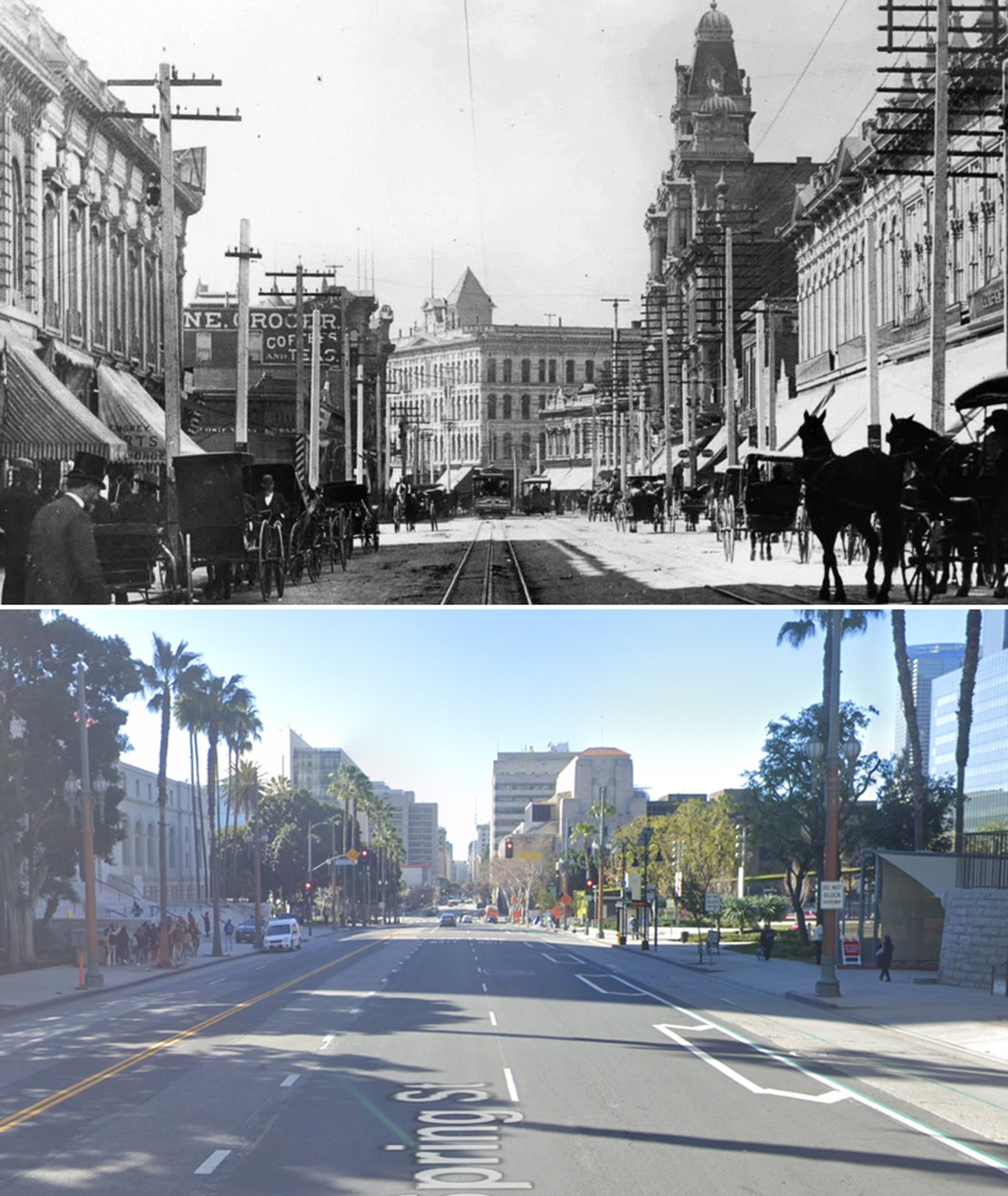 |
|
| (1896 vs 2023)* - Looking south on Spring Street from near Temple Street. Note: Spring Street was realigned in 1928 when LA City Hall was built. Photo comparison by Jack J. Feldman. |
* * * * * |
Broadway and Temple
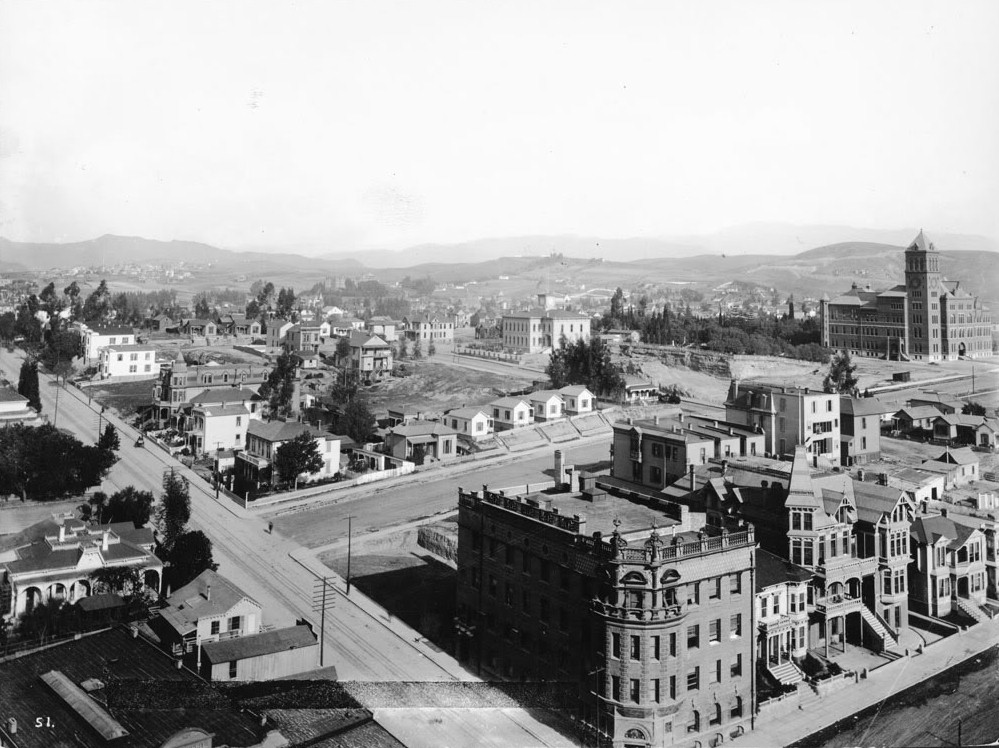 |
|
| (1890s)* - View looking NW from the top of LA County Courthouse located on the SE corner of Temple and Broadway. The original Los Angeles High School, which was moved in 1887, can be seen at center of photo. The New Los Angeles High School (built in 1891) is at right-center. In the foreground can be seen the Temperance Temple (WCTU), located on the northwest corner of Temple Street and Broadway. |
Historical Notes In the 1890s, the intersection of Broadway and Temple Street was a key focal point in downtown Los Angeles. The northwest corner was marked by the Women's Christian Temperance Union building, also known as the Temperance Temple, a three-story brick structure completed in 1888. This landmark reflected the city's growing social movements and was a testament to the influence of the temperance movement at the time. The intersection served as a hub for transportation and commerce, with Temple Street hosting cable cars from 1886 until their replacement by Pacific Electric streetcars in 1902. Broadway, renamed from Fort Street in 1890, was evolving into a major commercial corridor lined with boarding houses and small businesses. Over time, it would attract significant developments, including banks, department stores, and hotels, solidifying its role in the city's expansion. |
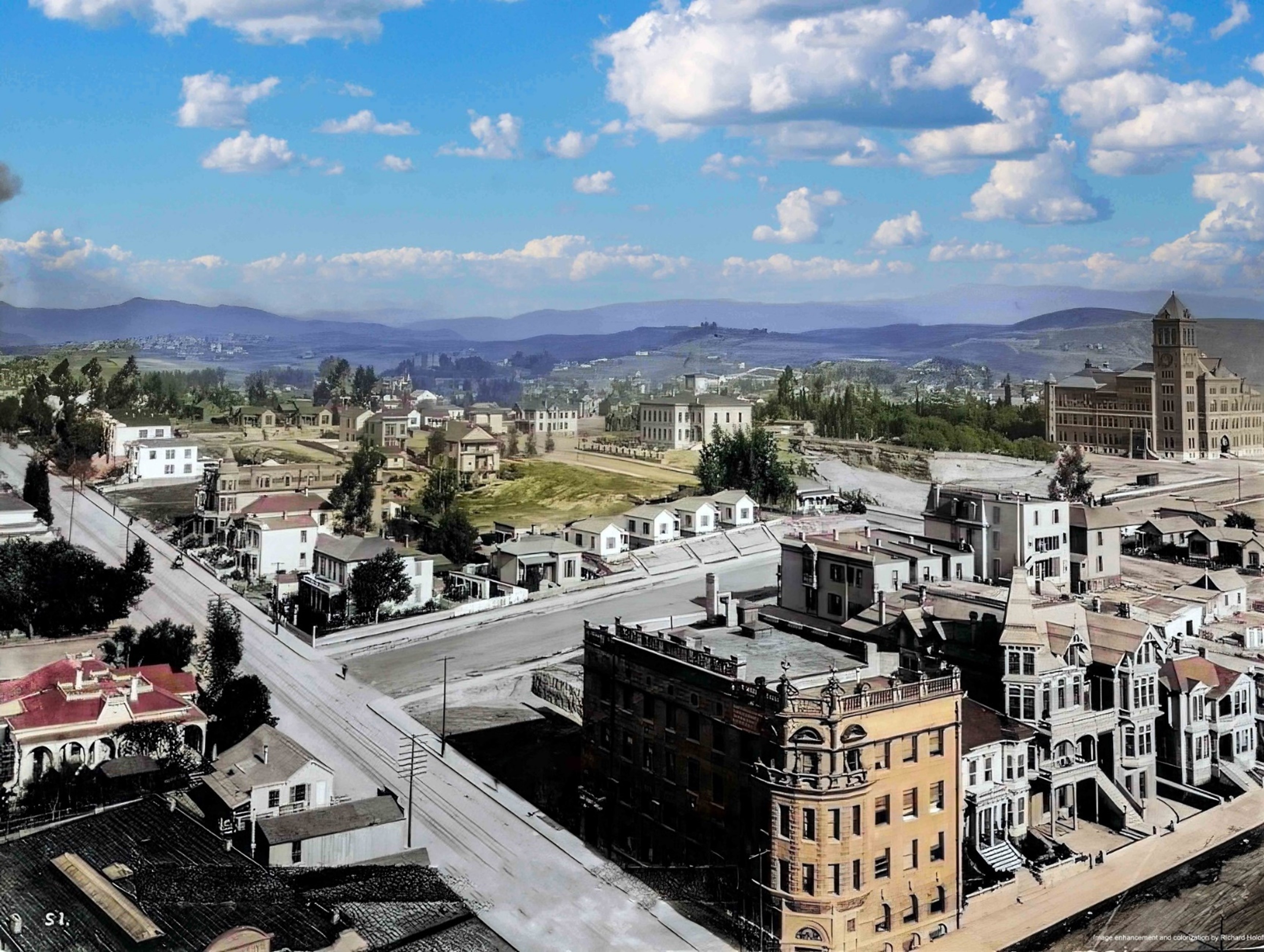 |
|
| (1890s)* - View looking NW from the top of LA County Courthouse located on the SE corner of Temple and Broadway. The original Los Angeles High School, which was moved in 1887, can be seen at center of photo. The New Los Angeles High School (built in 1891) is at right-center. In the foreground can be seen the Temperance Temple (WCTU), located on the NW corner of Temple and Broadway. Image enhancement and colorization by Richard Holoff. |
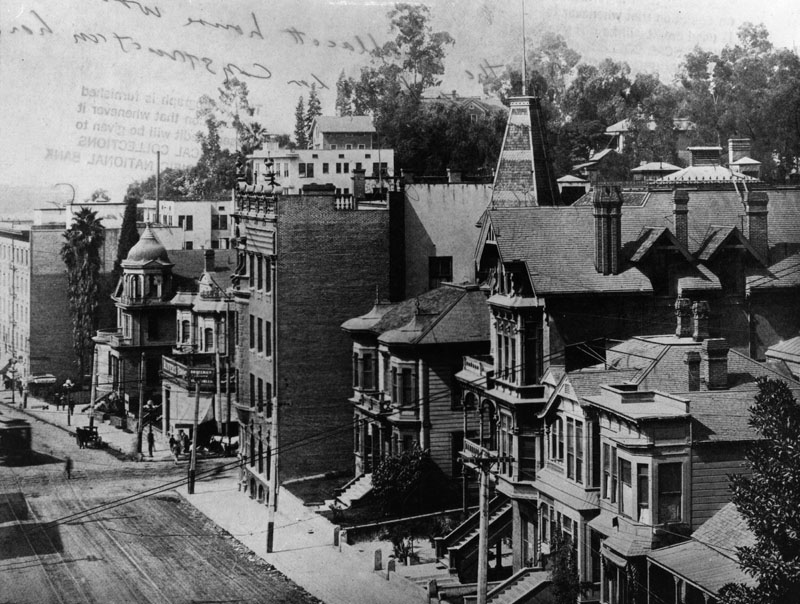 |
|
| (ca. 1890)^ - View looking south on Broadway toward Temple Street. The Temperance Temple stands on the N/W corner (center), surrounded mostly by boarding houses. |
Historical Notes In 1890, Broadway north of Temple Street in Los Angeles was still known as Fort Street, with the name change to Broadway applying only from 1st to 10th Street; the northern portion was later renamed North Broadway. The area featured the Women's Christian Temperance Union building (Temperance Temple) on the northwest corner, along with residential buildings and boarding houses. The Temple Street Cable Railway, operating since 1886, provided transportation, while Fort Moore Hill loomed just north, where the Broadway Tunnel would be built in 1901 to connect North Broadway with Buena Vista Street. Nearby, Sand Street (later California Street) intersected Fort Street just north of Temple. As Los Angeles grew from 11,200 residents in 1880 to over 50,000 by 1890, the neighborhood was poised for transformation from a primarily residential area into a major commercial corridor. |
 |
|
| (1890)* - The Temperance Temple of the Women's Christian Temperance Union (WCTU) is seen here on the northwest corner of Broadway and Temple Streets, 301 N. Broadway. A horse-drawn carriage passes a Temple Street Cable Railway 2-car trolley in the busy intersection. |
Historical Notes The Women's Christian Temperance Union (WCTU) Temple, located at the corner of Temple Street and Broadway in early Los Angeles, was a significant landmark in the city's history. Established after the Los Angeles WCTU chapter was founded in 1883, the Temple was built in 1888 as a $45,000 four-story brick structure. Despite financial challenges during its construction due to an economic downturn, the building was completed and served as the WCTU's headquarters for over five decades. Strategically positioned to overlook what was considered the "vilest dens in the city," the Temperance Temple symbolized the WCTU's mission to combat alcohol consumption and promote social reform. Its location was chosen to allow temperance sentiment to "crystallize" and influence the surrounding area. The Temple became a hub for philanthropic and feminist activities in Los Angeles, hosting meetings, educational programs, and advocacy work. For more than 50 years, the WCTU Temple played a crucial role in the organization's efforts to push for abstinence, prohibition laws, and various social reforms. It stood as a testament to the WCTU's influence in early Los Angeles until its demolition in the 1950s to make way for the Los Angeles Freeway. |
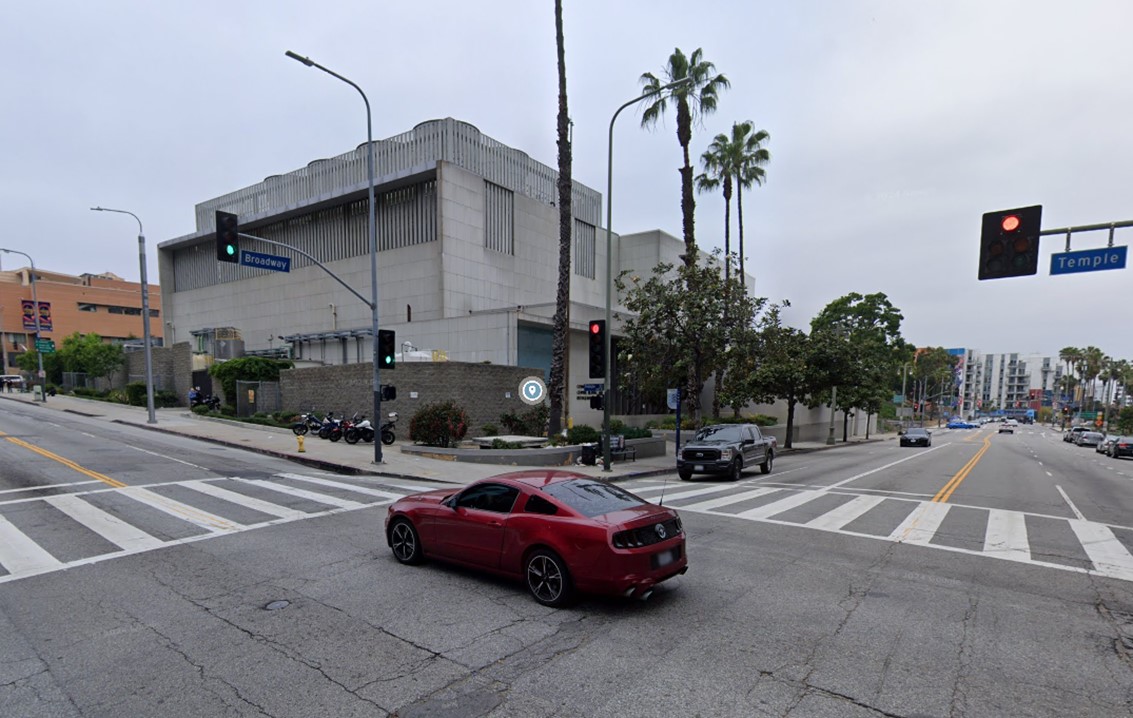 |
|
| (2024)* – Contemporary view of the northwest corner of Temple and Broadway showing the Los Angeles County Central Heating and Refrigeration Plant where the Temperance Temple once stood. |
Historical Notes The Los Angeles County Central Heating and Refrigeration Plant, built in 1958 at the northwest corner of Broadway and Temple Streets, replaced the Women's Christian Temperance Union Temple and serves as a key infrastructure hub for the Civic Center. It supplies chilled water and steam for heating and cooling to 14 major buildings, including the Cathedral of Our Lady of the Angels and Walt Disney Concert Hall. While it once generated electricity, this function is no longer economically viable. The plant’s original 1950s equipment is undergoing phased refurbishment to meet modern emissions and efficiency standards, with a total project cost of $46.1 million. Managed by the Los Angeles County Internal Services Department, it plays a vital role in maintaining county-owned facilities. The plant is primarily fueled by natural gas, which powers its boilers and chillers to produce steam and chilled water for heating and cooling. As part of ongoing modernization efforts, upgrades aim to improve efficiency and reduce emissions, ensuring compliance with current environmental regulations while maintaining reliable service to the Civic Center's critical buildings. |
Then and Now
 |
|
| (1890 vs 2024)* – A ‘Then and Now’ comparison of the northwest corner of Temple and Broadway showing the Temperance Temple, today’s site of the Los Angeles County Central Heating and Refrigeration Plant. Photo comparison by Jack Feldman. |
Historical Notes The WCTU Temple, also known as the Temperance Temple, was significantly damaged during the 1933 Long Beach Earthquake. As a result, the top two floors were removed due to the damage. The building remained in use until it was ultimately demolished in 1950 to make way for the Hollywood Freeway project. The Los Angeles County Central Heating and Refrigeration Plant was designed and engineered by M.A. Nishkian Company. It opened on August 21, 1958, and was the first of its kind in the nation. This plant supplies chilled water and steam for heating and cooling to various county buildings. |
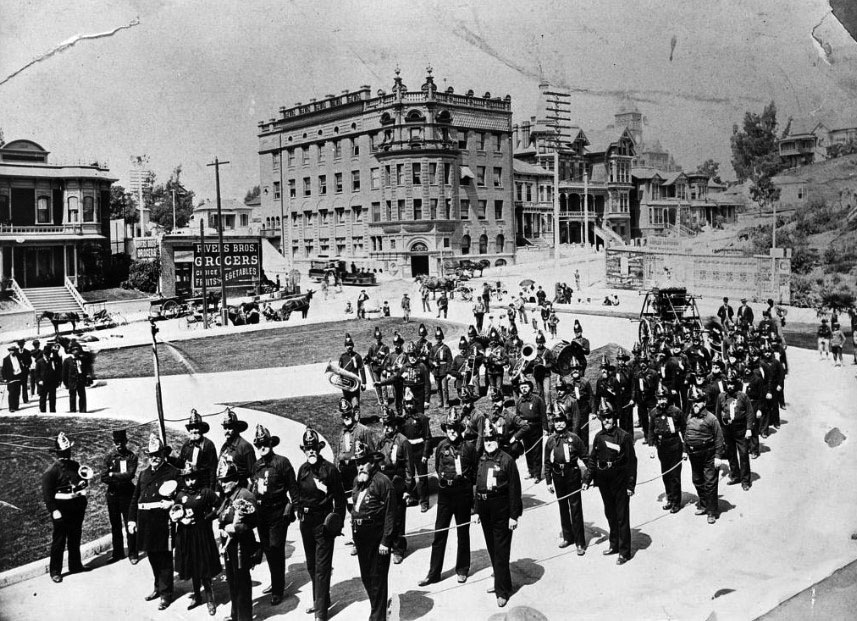 |
|
| (ca. 1900)* – View showing the San Francisco Fire Department brigade and band, in front of the Los Angeles County Courthouse (S/E corner of Temple Street and Broadway) with the Temperance Temple Building across the street. The tower of Los Angeles High School can be seen in the distance (top center-right). On the left is a clear shot of the Clifton (rooming) House (231-233 N Broadway) and the Rivers Bros. Grocery on the corner of Broadway and Temple Street (300 W Temple). The little house immediately above the Rivers Bros. sign is actually on N. Hill Street. |
Historical Notes In 1947, the County of Los Angeles took the site where the Temperance Temple once stood by eminent domain and constructed a power plant. The Temperance Temple was completely razed in 1950. |
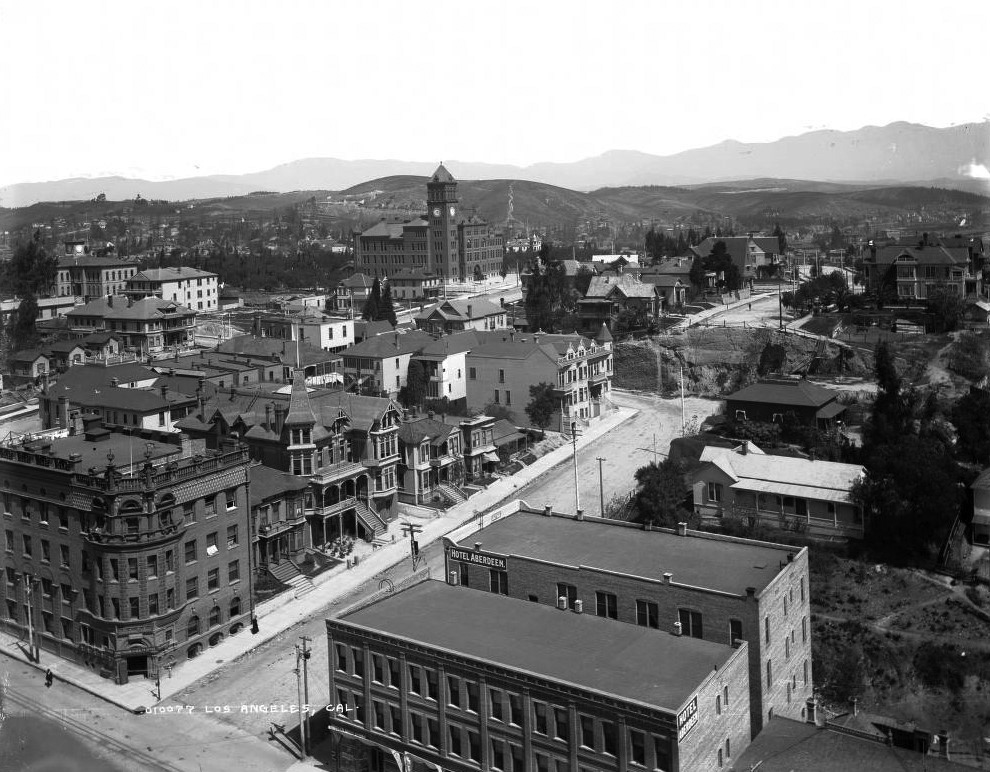 |
|
| (1900)* - View looking northwest from the top of the County Courthouse located on Temple Street and Broadway. The tall building with a clock tower is Los Angeles High School. The Broadway Tunnel would be bored through Fort Moore Hill, at the end Broadway (center-right), within a year of this photo. |
Historical Notes The Broadway Tunnel was a tunnel under Fort Moore Hill, built in 1901, extending North Broadway (formerly Fort Street), at Sand Street (later California Street), one block north of Temple Street, northeast to the intersection of Bellevue Avenue (later Sunset Boulevard, now Cesar Chavez Avenue), to Buena Vista Street (now North Broadway). Buildings seen include the Hotel Aberdeen and the Women's Christian Temperance Union building with a rounded corner and a balustrade on the cornice. Signs read: "Hotel Aberdeen" "W.C.T.U, Temperance Temple, Furnished Rooms" and "Sanitarium and Health Office." Multi-story Victorian houses have half-timbering, dormers, and turrets. |
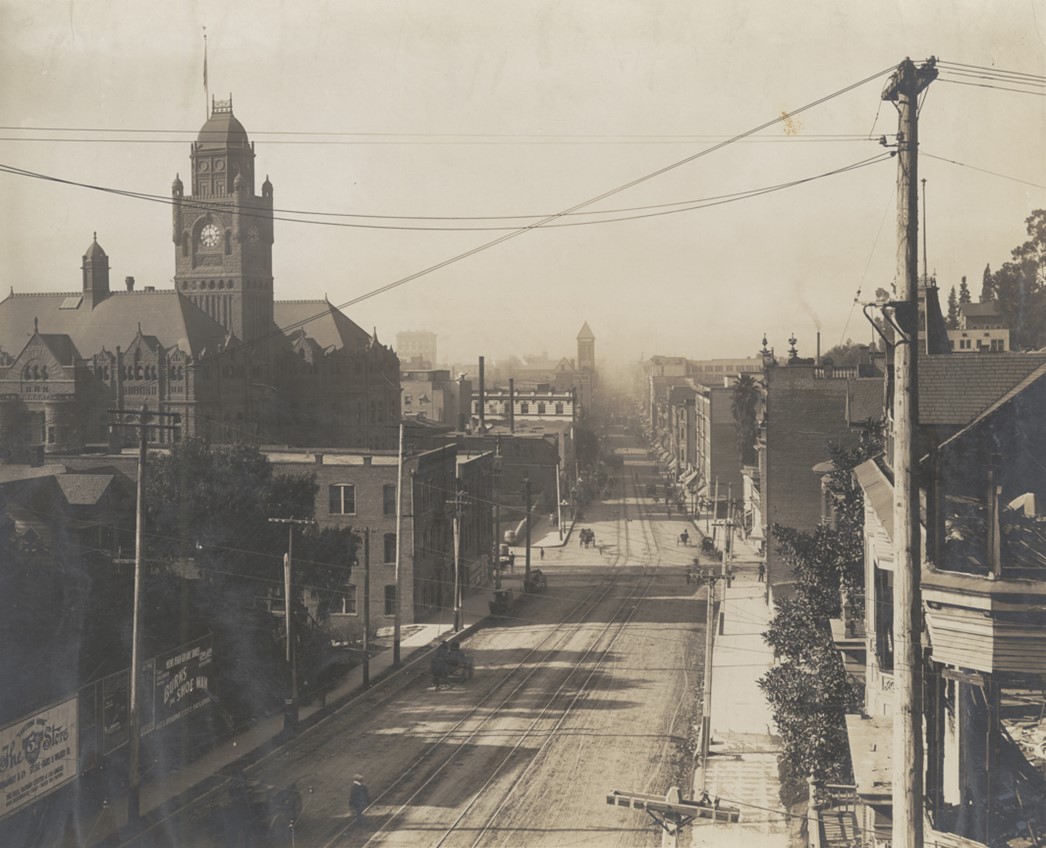 |
|
| (ca. 1905)* - Looking south on Broadway toward Temple Street showing the LA County Courthouse on the SE corner and also the tower of LA City Hall in the distance. |
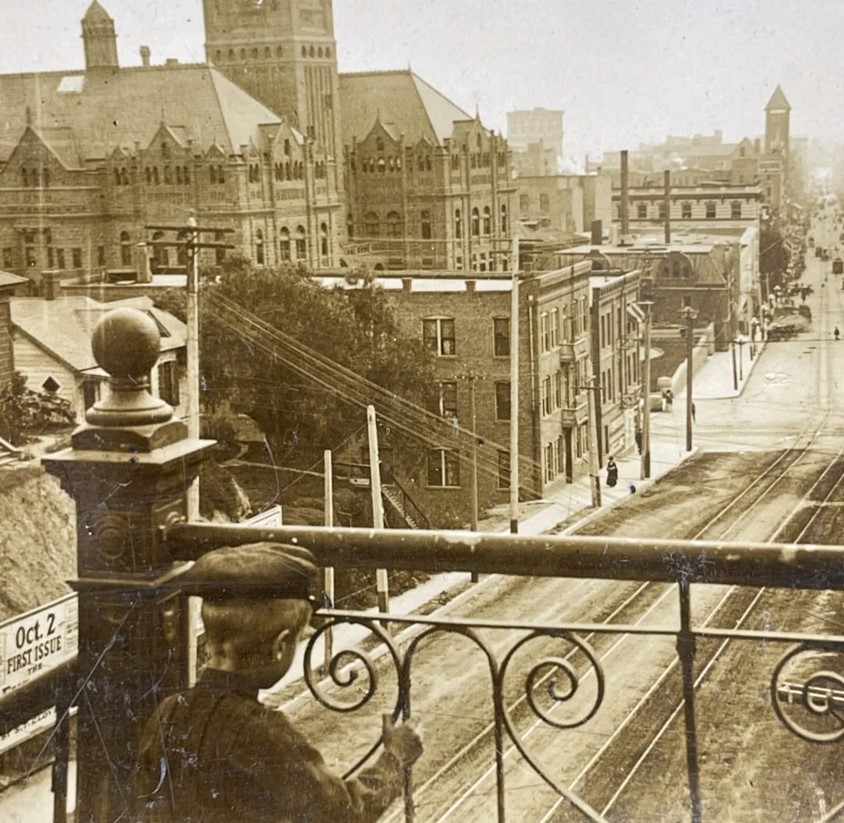 |
|
| (ca. 1905)* – A boy gazes out from the top staircase above the Broadway Tunnel toward the intersection of Broadway and Temple Street. |
 |
|
| (ca. 1890)* - View of the Los Angeles County Courthouse shortly after it was built. A 2-car trolley of the Temple Street Cable Railway can be seen on Temple Street heading west toward Broadway. New High (later Spring Street) is on the left. |
Historical Notes In 1891, the LA County Courthouse moved into it's new home, a beautiful new building constructed at the old site of Los Angeles High School.. Prior to its move, the courthouse was located in a large building on Temple Block sharing space with a theatre and marketplace (1861-1891). |
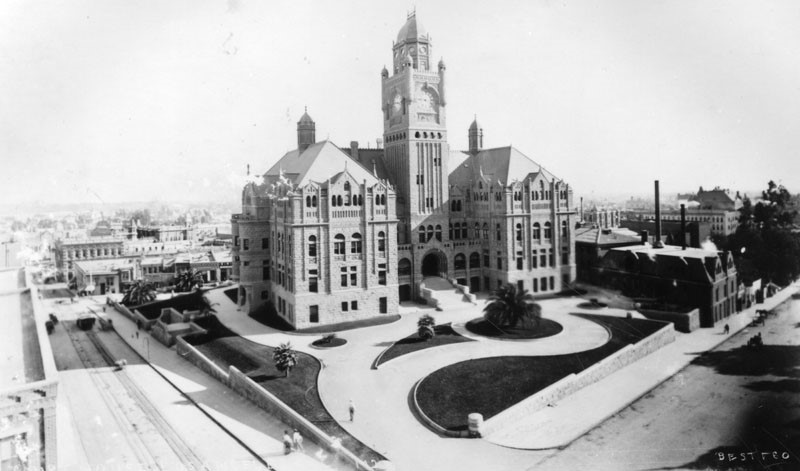 |
|
| (1890s)^ - View looking southeast at the corner of Temple Street (left) and Broadway showing the LA County Courthouse. Note the manicured lawn and the newly planted palm trees. This is actually the 6th location of the LA County Courthouse (see below). |
Historical Notes Through more than 150 years the county has used at least eight buildings as its county courthouse. All have been situated within a mile of each other in downtown Los Angeles south of the original plaza in what has for the past 80 years been called the Civic Center. ◆ The first county courthouse was in the adobe Bella Union Hotel, where court was held in rented rooms from 1850 to 1852. |
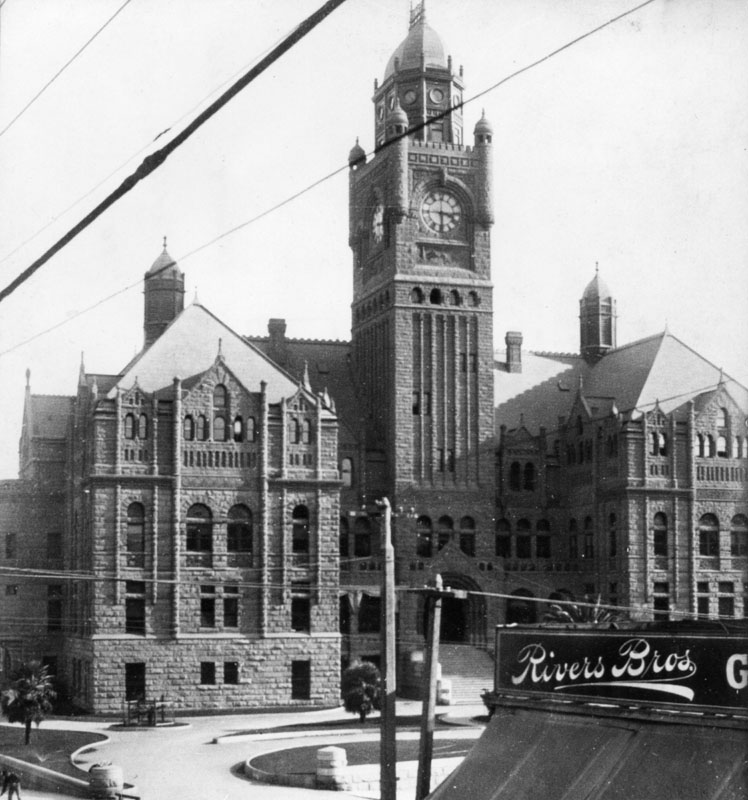 |
|
| (1900)^ - Close-up view of the LA County Courthouse located on the S/E corner of Temple Street and Broadway as seen from over the Rivers Bros. Grocery (S/W corner). |
Historical Notes The Red Sandstone Courthouse on Poundcake Hill, completed in 1891, was damaged beyond repair by the Long Beach earthquake of 1933 and demolished in 1936. It is now the site of the Foltz Criminal Justice Center, |
* * * * * |
Main and Winston Streets
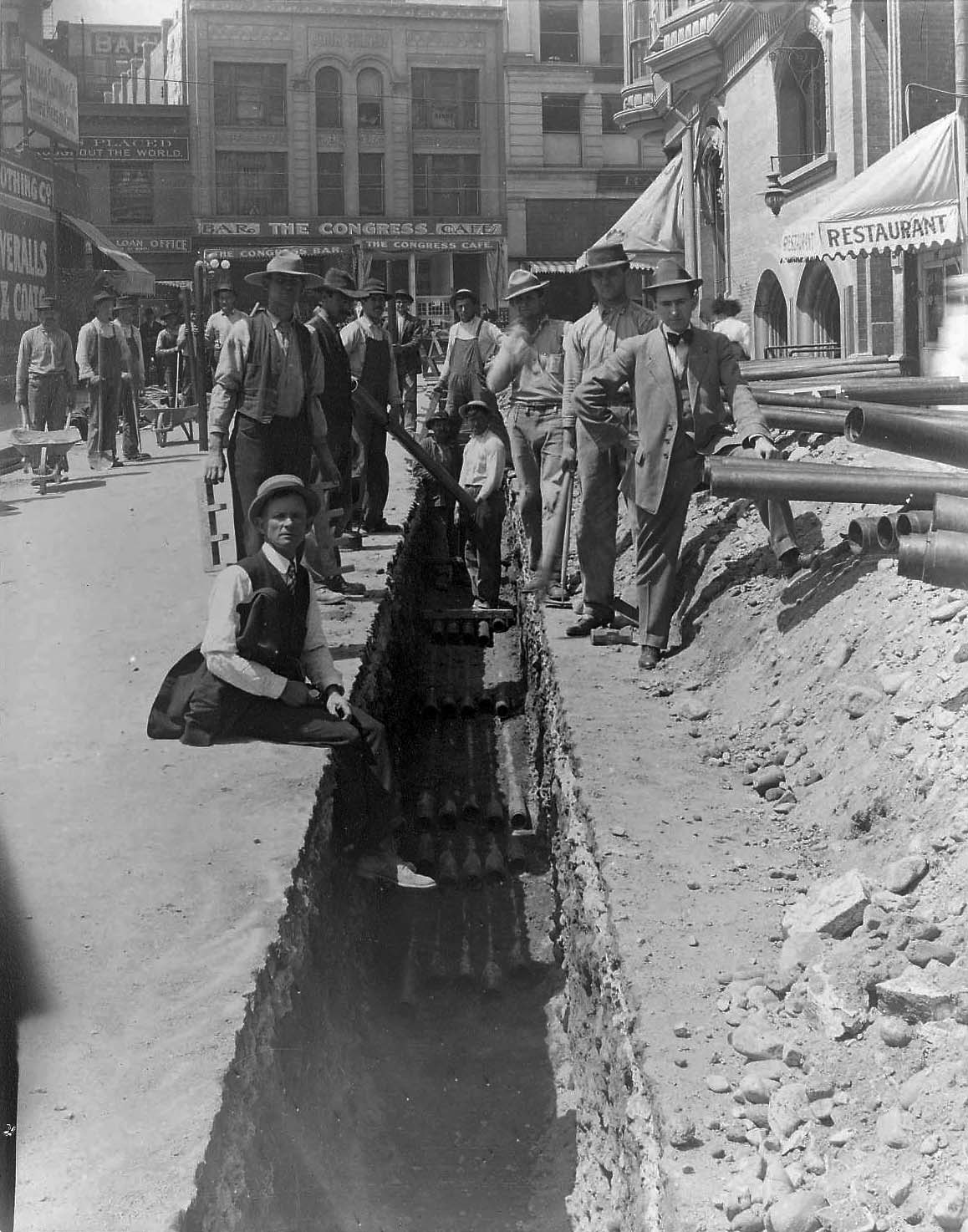 |
|
| (ca. 1897)^ – View looking northwest on Winston Street toward where it intersects with Main Street showing an Edison Electric crew laying conduit for one of LA’s earliest underground electric distribution systems. The building on the right with the two arched windows and a restaurant is the Main Street Savings Bank Building on the N/E corner of Main and Winston streets. Click HERE to see contemporary view. |
Historical Notes In 1896, West Side Lighting Company was organized by private investors to provide another source of electricity for the city of Los Angeles and fringe areas. In 1897, West Side Lighting merged with the newly established private company, Los Angeles Edison Electric, which owned the rights to the Edison name and patents, especially the underground DC-power rights. The merged company took on the Edison name. An underground system and technology was crucial at this time, since the city voted in a resolution limiting the installation of new overhead utility poles due to excessive overhead wire congestion. Los Angeles Edison Electric installed the first major DC-power underground conduits system in the Southwest. Until the 1930's, three separate electric utilities served Los Angeles. Click HERE to see more in First Electricity in Los Angeles. |
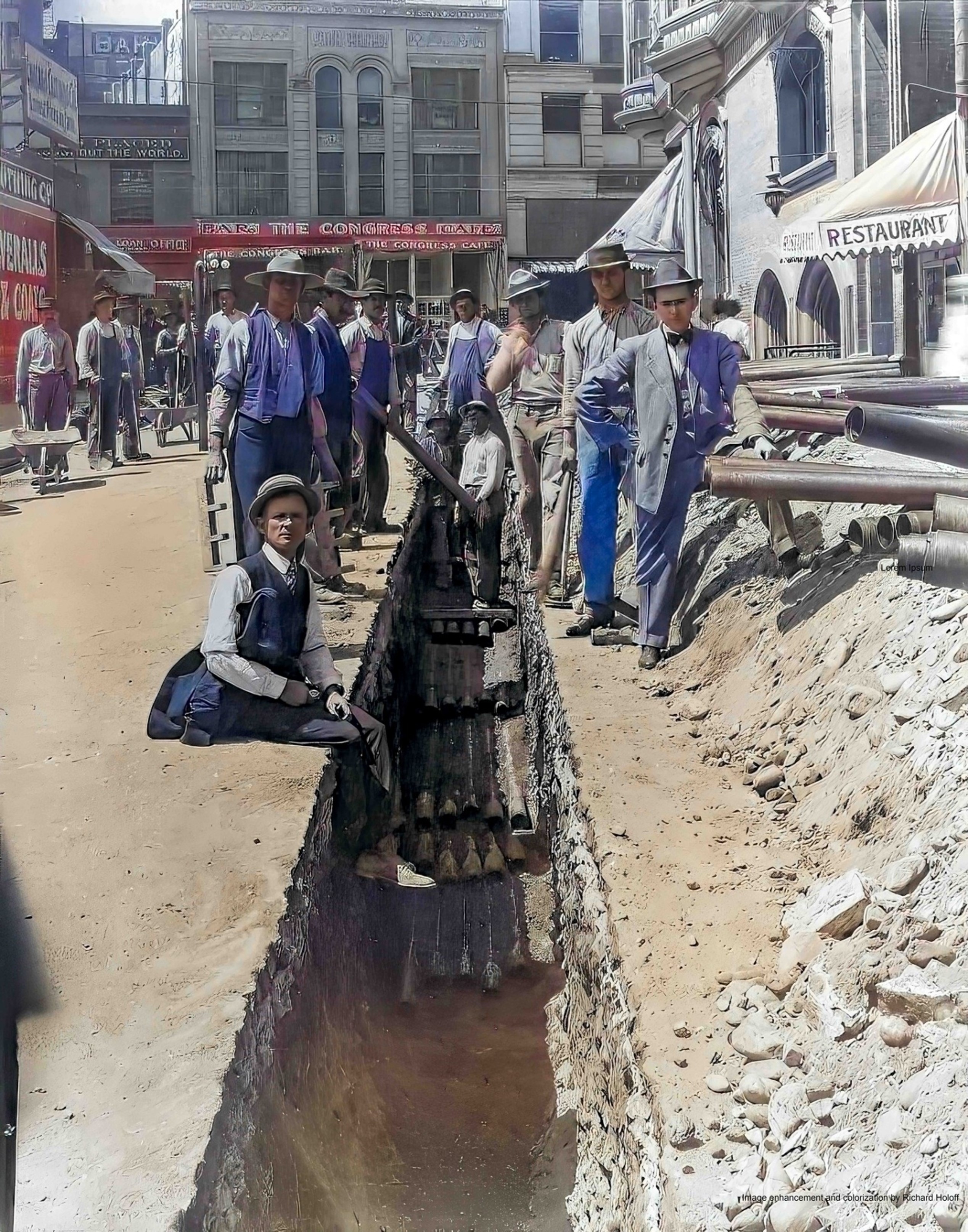 |
|
| (ca. 1897)^ – View looking northwest on Winston Street toward where it intersects with Main Street showing an Edison Electric crew laying conduit for one of LA’s earliest underground electric distribution systems. The building on the right with the two arched windows and a restaurant is the Main Street Savings Bank Building on the N/E corner of Main and Winston streets. Photo by G. Haven Bishop; Image enhancement and colorization by Richard Holoff. |
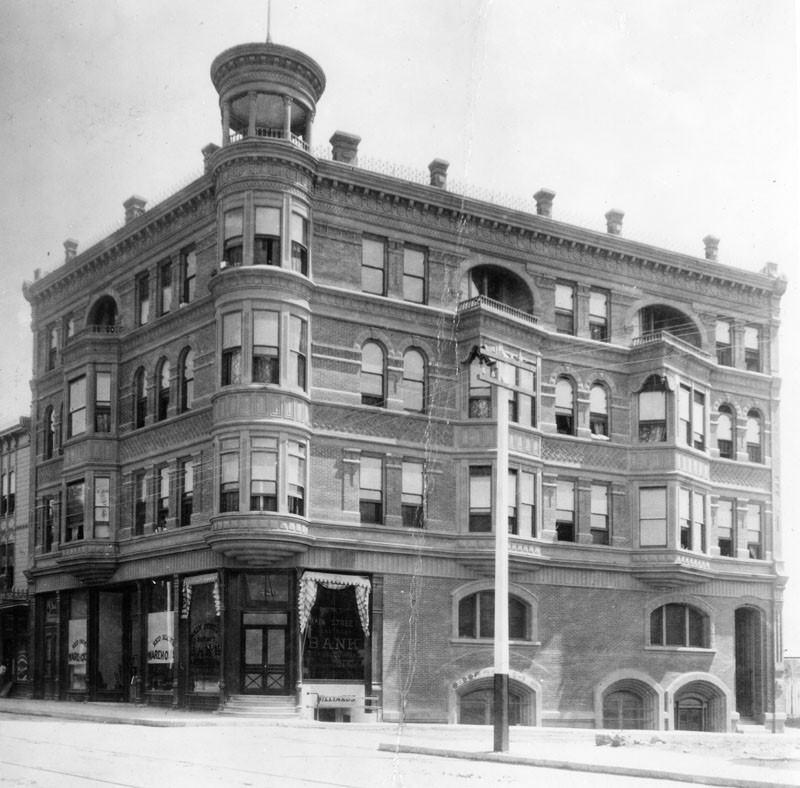 |
|
| (ca. 1880s)^ – View looking toward the northeast corner of Main and Winston streets showing the Main Street Savings Bank Building at 426 S. Main Street. |
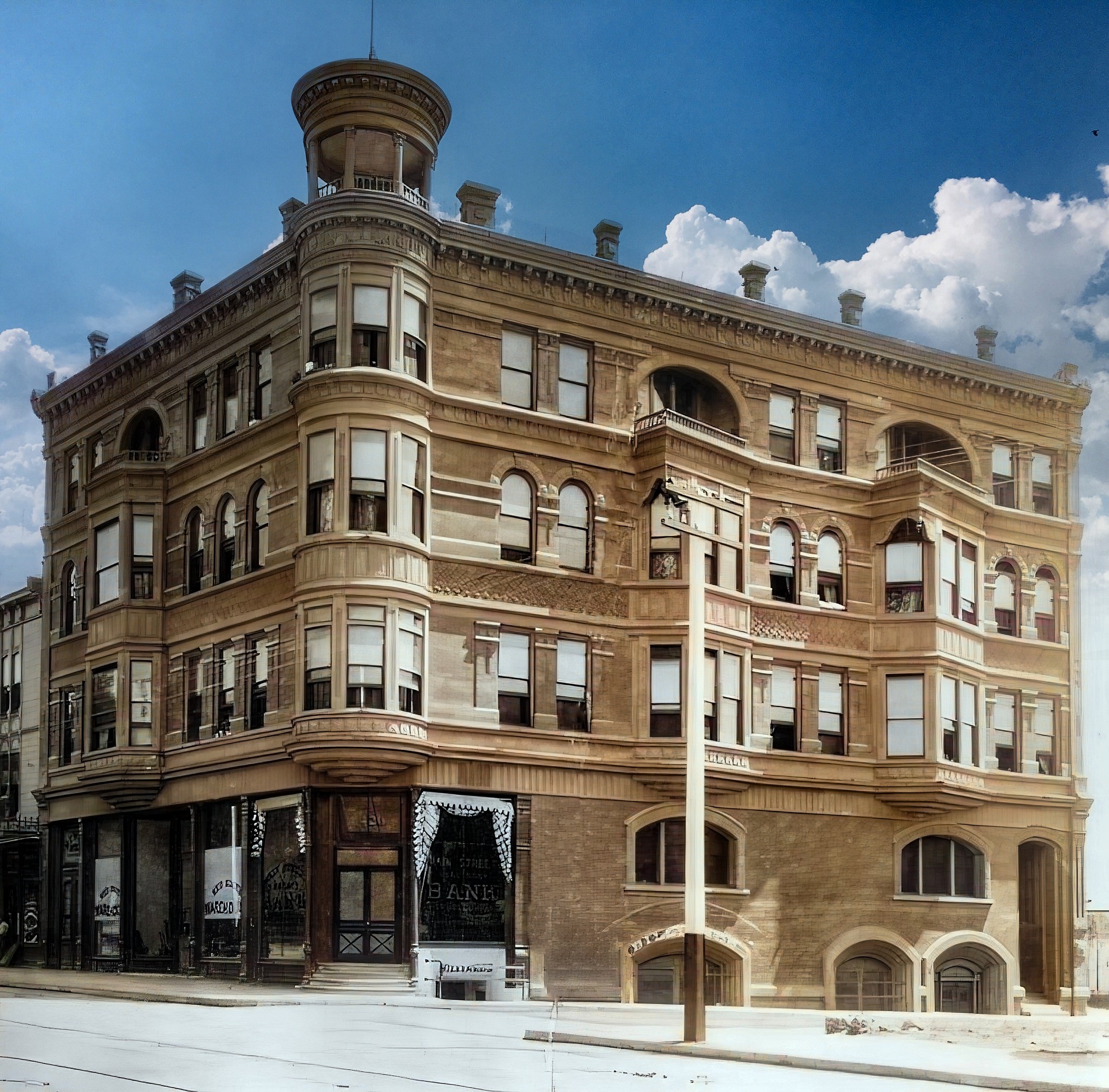 |
|
| (ca. 1880s)^ – The Main Street Savings Bank Building located on the NE corner of Main and Winston streets in DTLA, 426 S. Main Street. Image enhancement and colorization by Richard Holoff. |
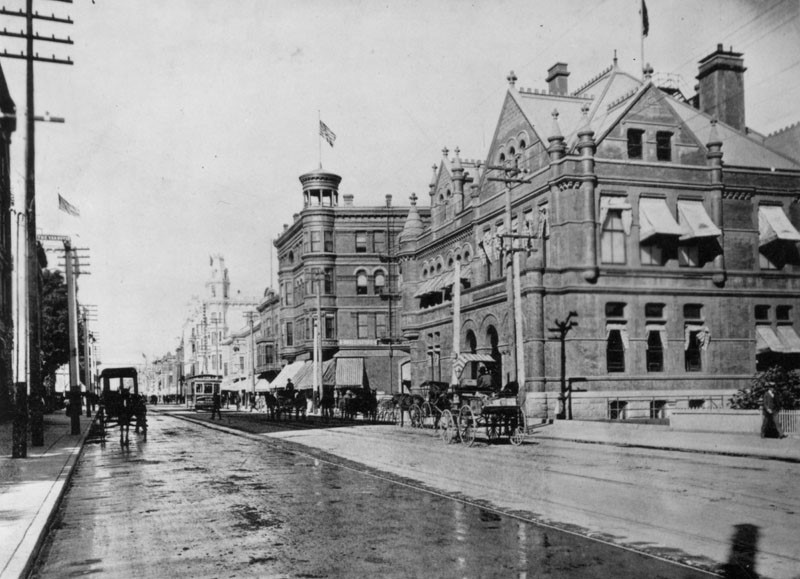 |
|
| (1890s)^ - View looking north on Main Street showing horse-drawn carriages, streetcar, and pedestrians all sharing the street. The large building with the awnings on the right is the Government Building, located on the southeast corner of Winston and Main Streets. Further north (N/E corner of Winston and Main) is the Main Street Savings Bank Building. Further in the distance is the Westminster Hotel with tower. |
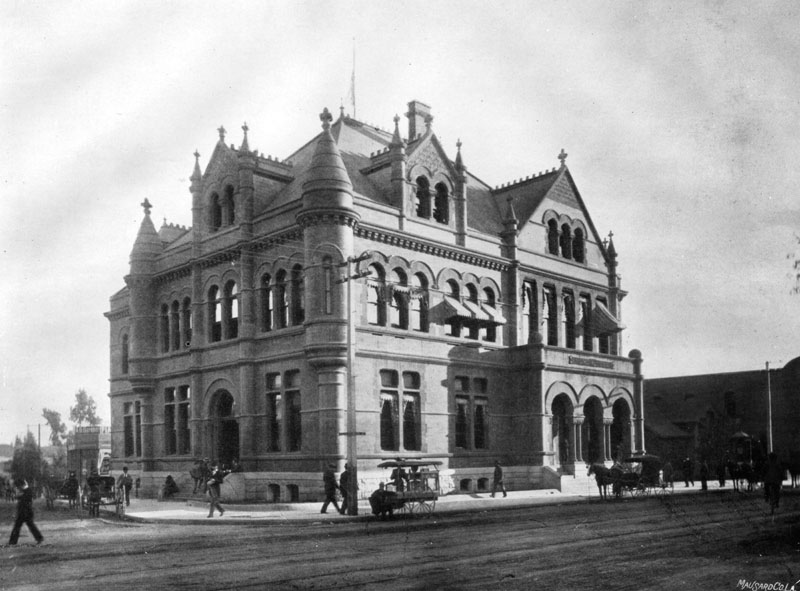 |
|
| (1893)^ - United States Government Building, southeast corner of Main Street and Winston Street. |
Historical Notes In June of 1893 the Los Angeles Post Office moved into this building from its location on Broadway near Sixth Street. |
* * * * * |
Main and 5th Street
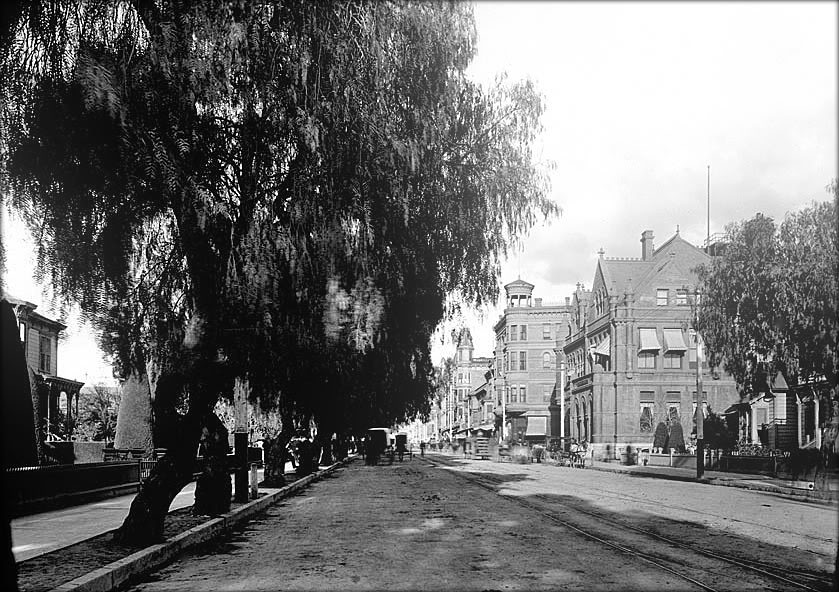 |
|
| (ca. 1895)^^ - View of Main Street looking north from 5th Street. The Westminster Hotel can be seen in the distance. The U.S. Government Building which housed the Los Angeles Post Office is the building on the right with the awnings. |
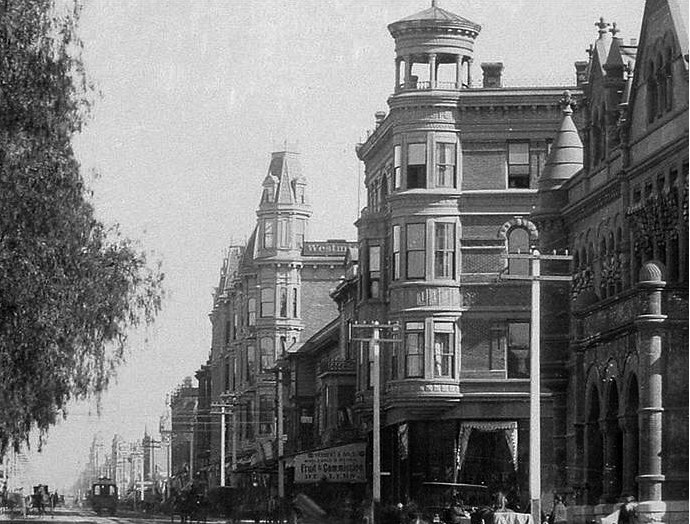 |
|
| (ca. 1890s)^*# - Close-up view looking north on Main Street from 5th Street. The Westminster Hotel is at center-left (sign on roof line). To its right is the Main Street Savings Bank Building. On far right is the U.S. Government Building |
* * * * * |
Main and 4th Street
Then and Now
Then and Now
City Hall View |
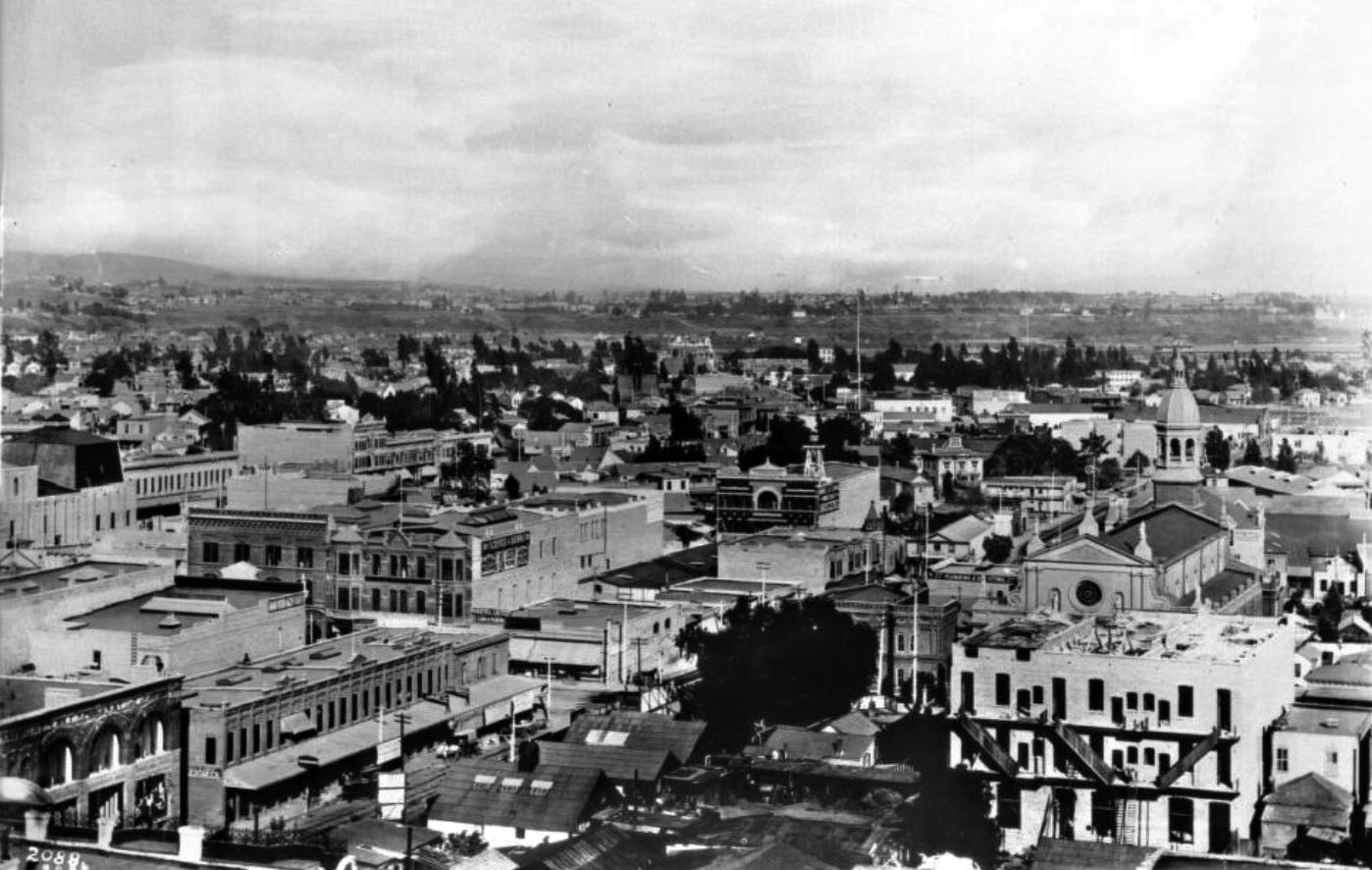 |
|
| (1890)* - Panoramic view of downtown Los Angeles as seen from the City Hall Tower (226 S. Broadway) looking east. St. Vibiana's Cathedral is seen at right. |
* * * * * |
Spring and 2nd Street
 |
|
| (ca. 1890)^ - Spring Street looking north from the roof of the Stowell Building at 2nd Street, circa 1890. The Hollenbeck Block/Hotel is the first building on the left, next the Bryson-Bonebrake Block (n/w corner of 2nd and Spring) center the County Courthouse, roof of Phillips Block, Temple Market Block and Baker Block. |
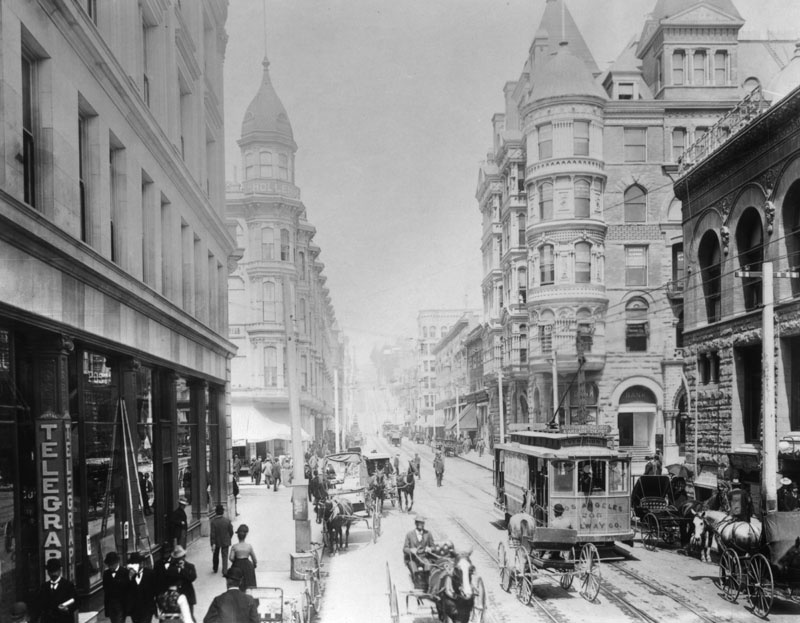 |
|
| (ca. 1895)^ - 2nd Street looking west toward Spring Street. The building at close left is the Wilcox Building, at the far left the Hollenbeck Hotel. At far right is the Bryson-Bonebrake Block. Horse-drawn vehicles and streetcars are seen. There is a telegraph office on the left. |
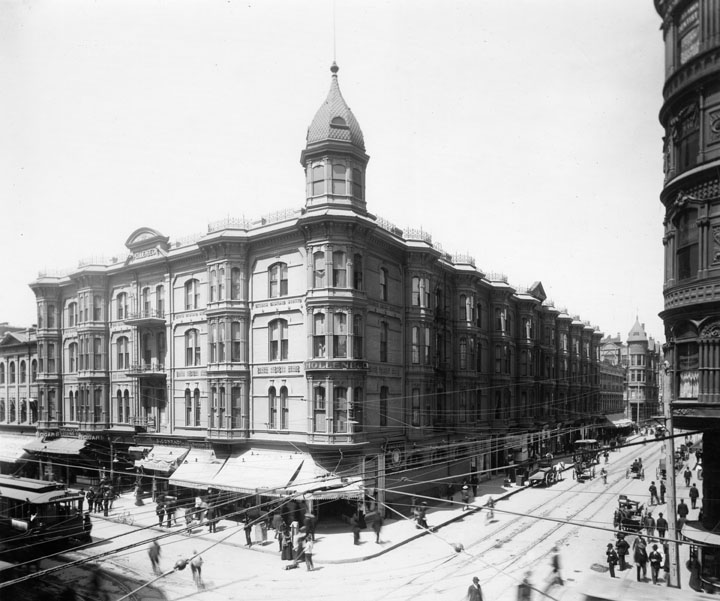 |
|
| (ca. 1890)^ - The Hollenbeck Hotel sits on the southwest corner of Spring and Second behind trolley lines extending up and down the streets on both sides. On the street are people, a trolley, horses and buggies. Architect, Robert B. Young. |
Historical Notes John Edward Hollenbeck (June 5, 1829 - September 2, 1885) was an American businessman and investor who was involved in the 19th century development of Nicaragua and the city of Los Angeles, California. Arriving in Los Angeles a wealthy man from his investments in Nicaragua in 1876, Hollenbeck purchased land on the east side of the Los Angeles River, and built a large residence with broad verandas and a tower on extensive grounds on Boyle Avenue. He made twenty-seven acquisitions of property by 1880. In 1884 he purchased and developed an urban business district, known as the Hollenbeck Block, within Los Angeles. In 1878 Hollenbeck became a stockholder in the Commercial Bank of Los Angeles, and was elected its president. In 1881, he and other investors organized and established the First National Bank. In 1880, Hollenbeck, with former California Governor John G. Downey, horticulturalist Ozro W. Childs and other associates, persuaded the State of California to purchase 160 acres in Los Angeles to foster agriculture in the southland. The property, then known as Agriculture Park, is now known as Exposition Park, home to the Los Angeles Coliseum and the Los Angeles County Museums. |
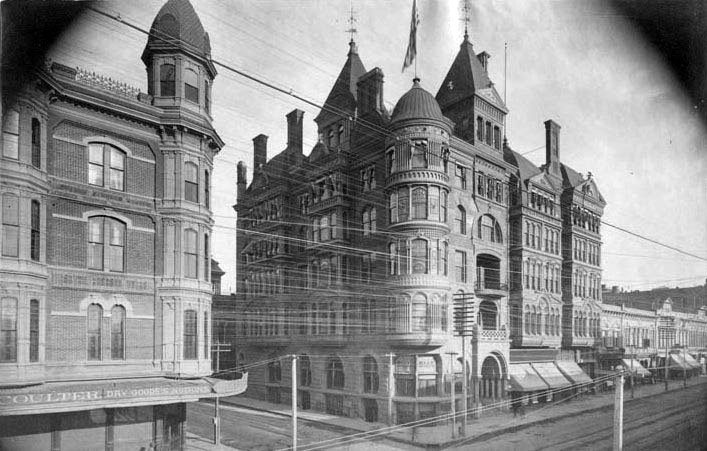 |
|
| (ca. 1888)^##* - View of the Bryson-Bonebrake Block located on the northwest corner of Spring and Second streets. Coulters Dry Goods is to the left, on the southwest corner. |
Historical Notes Two highly influential figures in 1880s Los Angeles, John Bryson, Sr., the 19th mayor, of LA and Major George H. Bonebrake, President of the Los Angeles National Bank and the State Loan and Trust Company, commissioned John Cather Newsom to erect this 126-room bank and office building. It's cost was projected to be $224,000, a staggering sum at the time. Bonebrake was one of the richest men in the city at the time, and he could afford making such an investment. He located the main headquarters of his bank in the Bryson-Bonebrake Block. |
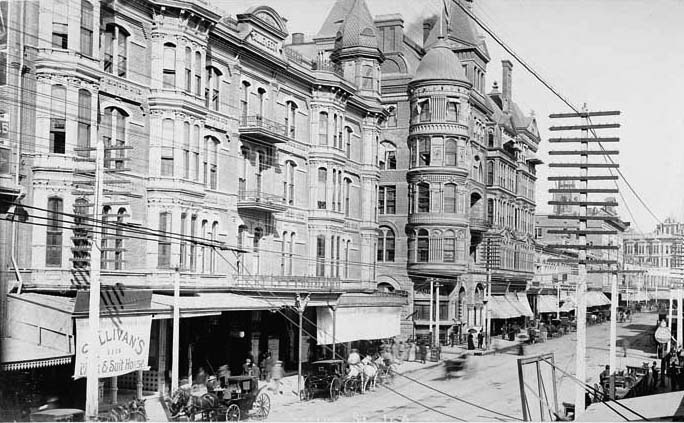 |
|
| (1890)^## - View of Spring at 2nd Street looking north. The Hollenbeck Hotel is seen on the left and the Bryson-Bonebrake Building is on the right. Horse-drawn carriages are parked in front of the hotel. |
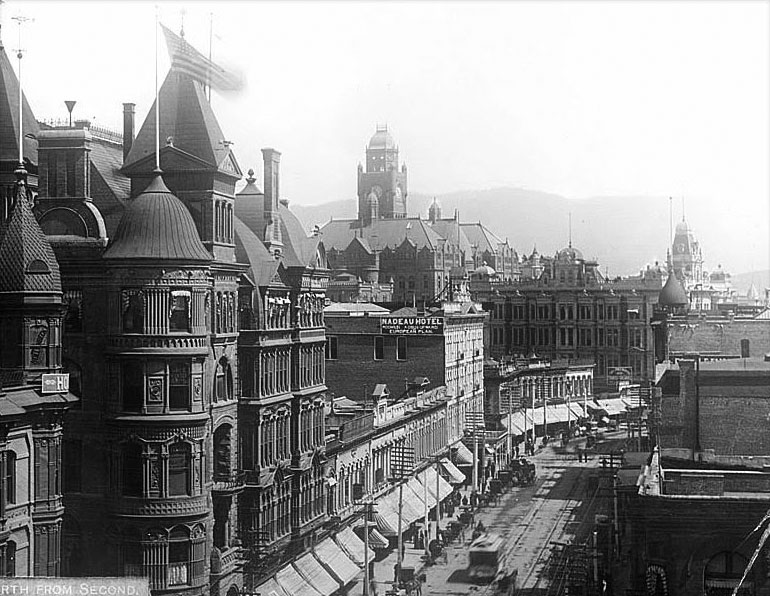 |
|
| (ca. 1895)^^ - View of Spring Street looking north from 2nd Street where both the Hollenbeck Building and Bryson-Bonebrake Block are seen on the left. The County Courthouse (built in 1891) can be seen at upper-center and the Nadeau Hotel in center of photo. At center-right is the Phillips Block. |
Historical Notes The Nadeau Hotel stood on the southwest corner of 1st and Spring Streets until 1932, when it was demolished to make room for the current Los Angeles Times Building. |
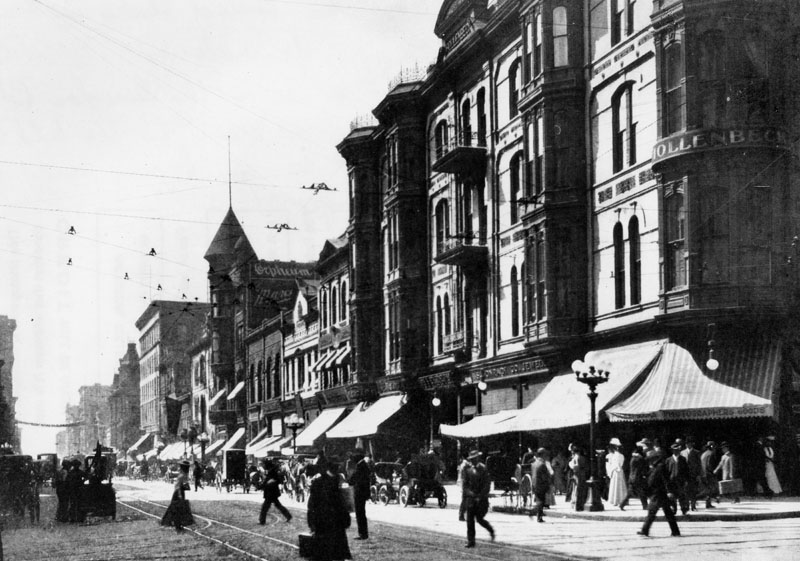 |
|
| (ca. 1898)^ - View of Spring Street looking south at 2nd Street, one of the busiest blocks in the city at the time. The Los Angeles Theatre (turreted building) can be seen at center-left. The Hollenbeck Building has been raised to four stories. The five-story block at the next corner is the Douglas Block. |
* * * * * |
Spring Street and 3rd Street
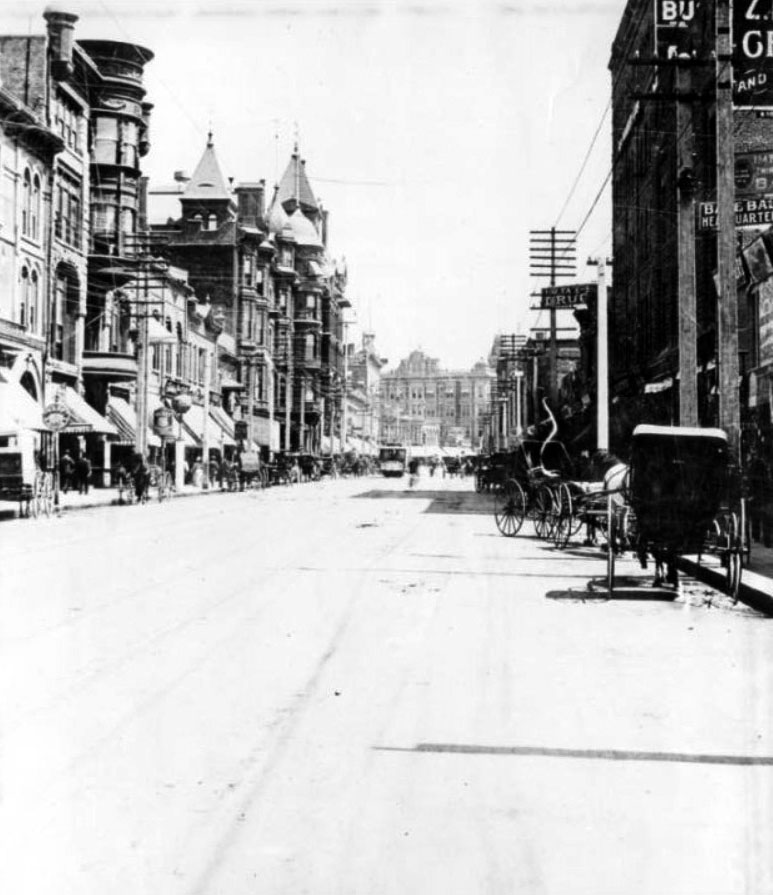 |
|
| (ca. 1888)^ – View looking north on Spring Street from near 3rd Street. Horse-drawn carriages are parked on both sides of the street while a streetcar can be seen in the distance. Both the Hollenbeck Building and Bryson-Bonebrake Block can be seen in the distance at Spring and 2nd streets. On the left is the recently built Los Angeles Theatre. Note the turret on its round tower has not been built yet.. |
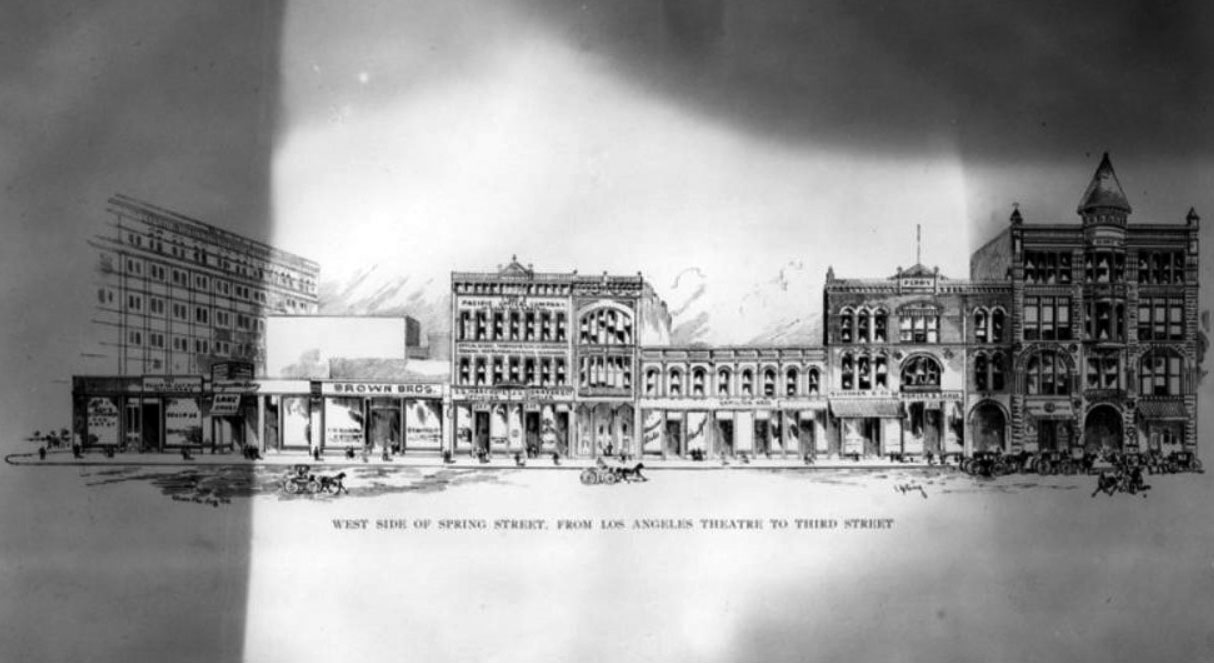 |
|
| (1896)^ – Sketch showing the west side of Spring Street from the Los Angeles Theatre (right) to 3rd Street (left). |
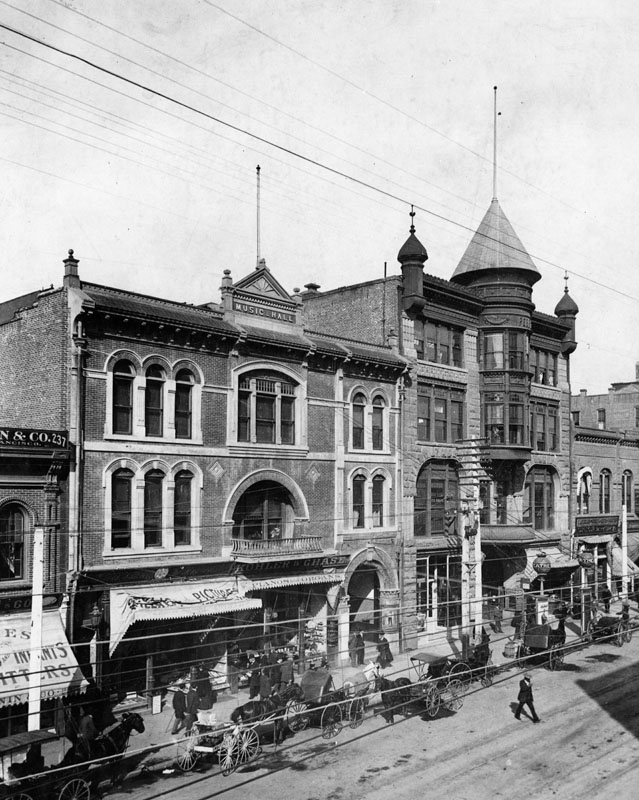 |
|
| (1895)^ - View of Spring Street looking northwest. The Los Angeles Theatre, located at 227 S. Spring Street, is on the right. The music hall, on the left, was the former home of Turnverein. Horse-drawn carriages are shown parked in front. |
Historical Notes The Los Angeles Theatre opened in 1888. It was built by William Hayes Perry and the building containing it was known as the Perry Building. |
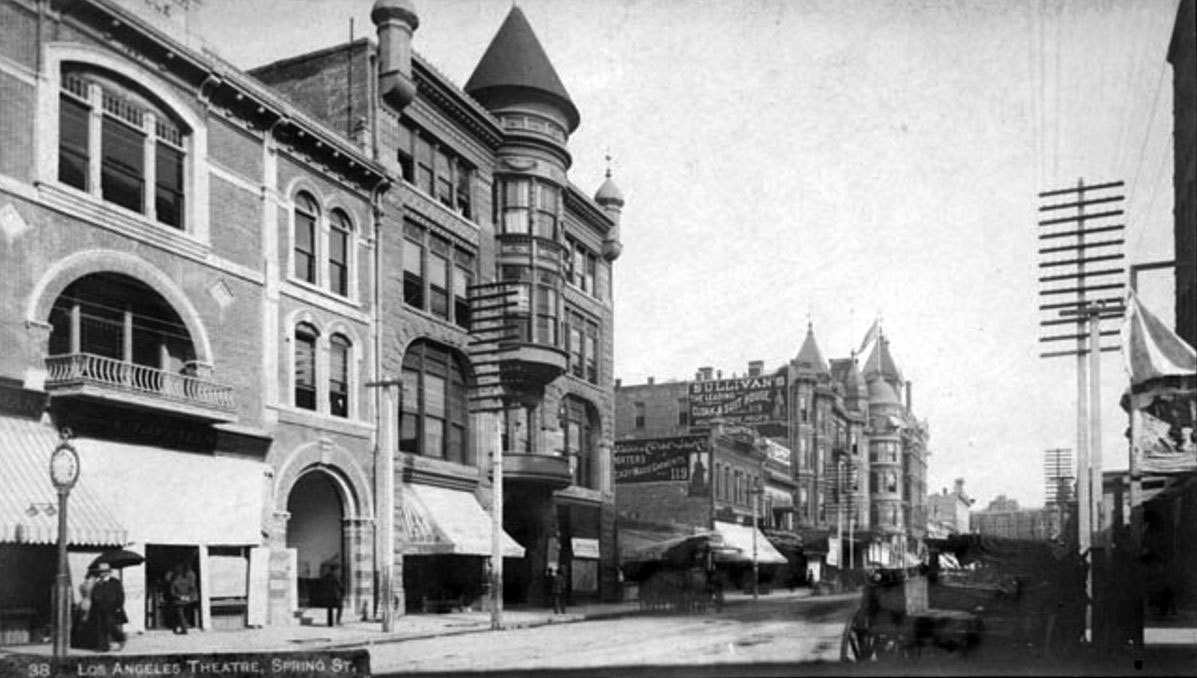 |
|
| (ca. 1897)^## – View looking north on Spring Street showing the Los Angeles Theatre (turreted building). The theatre would later be called Orpheum and Lyceum Theatre). The building on the left was later known as Lyceum Hall. In the distance can be seen both the Hollenbeck Building and Bryson-Bonebrake Block at Spring and 2nd streets. |
Historical Notes In 1903 this interesting Richardsonian Romanesque building became the Orpheum - the second home of Orpheum Circuit vaudeville in Los Angeles. Previously they'd been at the Grand Opera House. There were four Orpheum theatres in downtown Los Angeles: ◆ 110 S. Main St. -- Grand Opera House was the home of Orpheum vaudeville from 1894 to 1903. ◆ 227 S. Spring St. -- The Los Angeles Theatre, later called The Lyceum, was known as the Orpheum from 1903 to 1911. ◆ 630 S. Broadway -- Now the Palace Theatre -- this was the Orpheum between 1911 and 1926. ◆ 842 S. Broadway -- Orpheum Theatre from 1926 to Today |
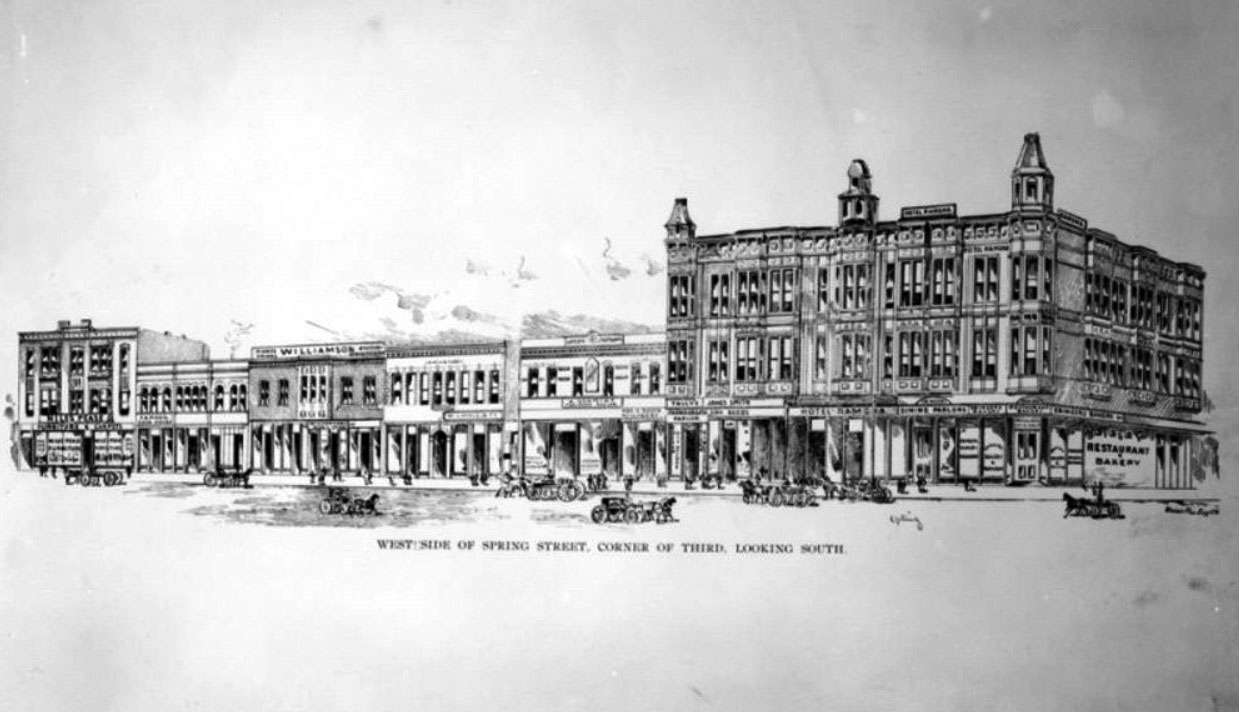 |
|
| (1896)^ - An architectural drawing of the west side of Spring St. looking south from the corner of 3rd St. |
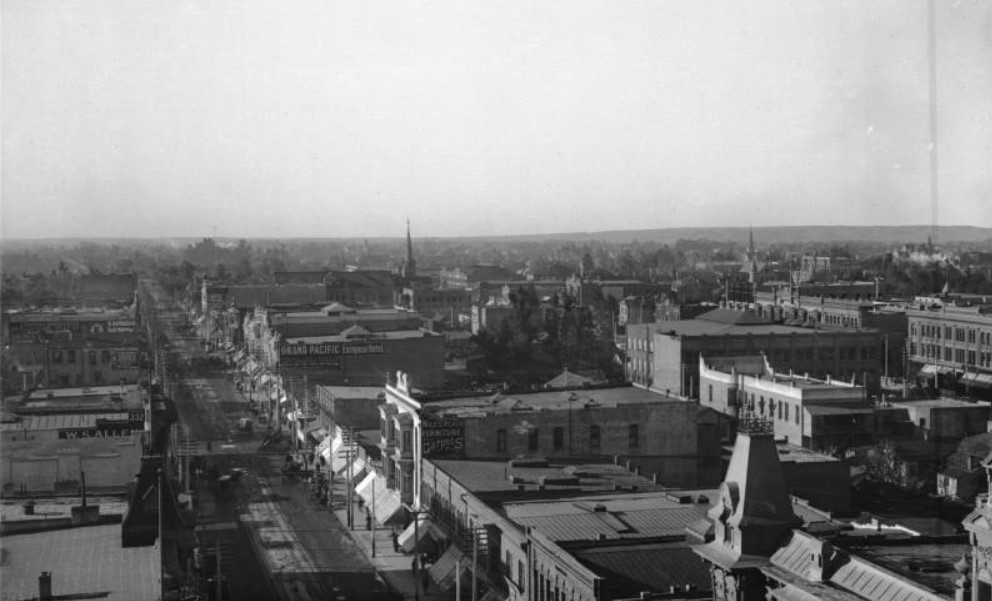 |
|
| (ca. 1898)^^ - View of Spring Street looking south from the Stimpson Building on the NE corner at Third Street, shortly after it was built. Awnings cover most store fronts looking down Spring Street. |
* * * * * |
Broadway and 4th Street
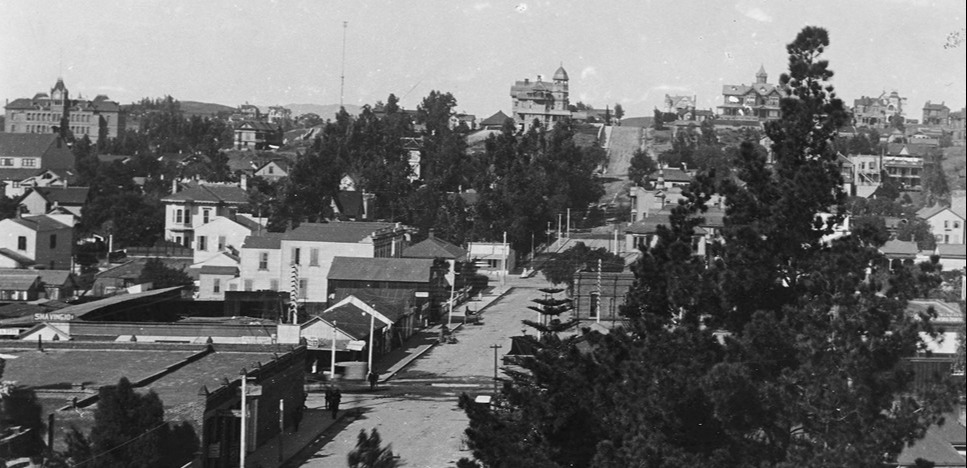 |
|
| (1890s)* - Looking west on 4th Street toward Fort Street (later Broadway) and Bunker Hill. The large building in the upper-left is the State Normal School located at Grand and 5th Street. |
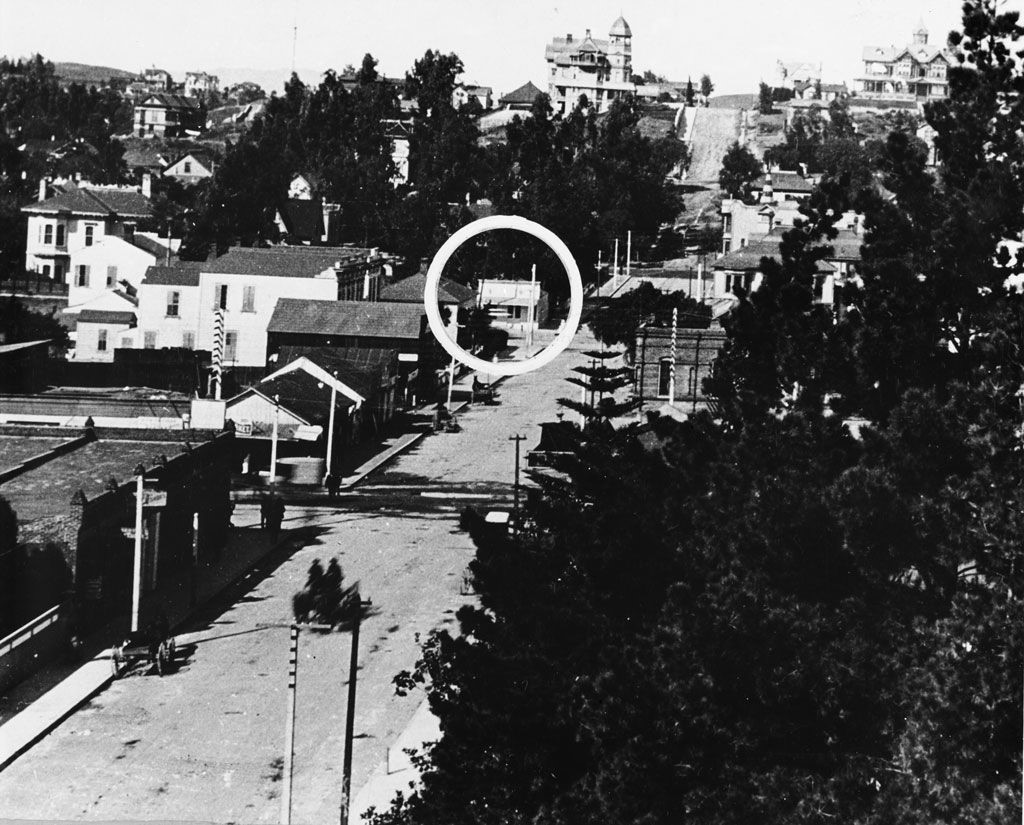 |
|
| (1890s)* - Looking west on Fourth Street toward Bunker Hill. The circle is the intersection of Fourth & Fort Street (now Broadway). |
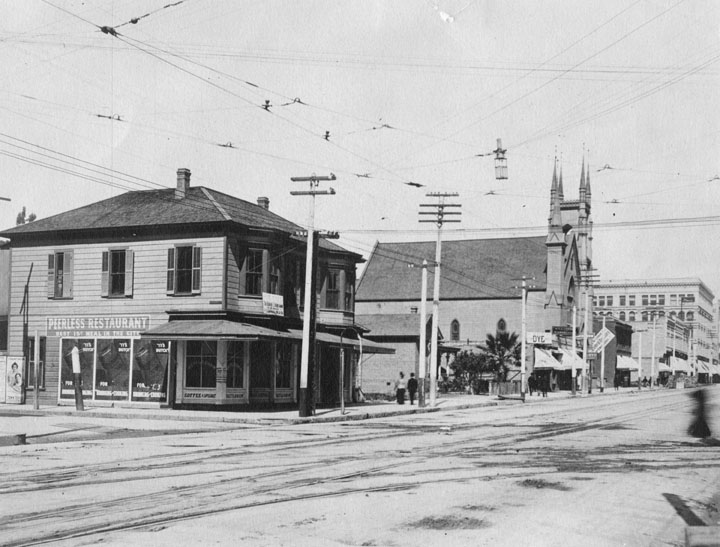 |
|
| (1890)^ - Fort Street (now South Broadway), showing the Fort Street Methodist Episcopal Church, replaced by the Homer Laughlin Building in 1916. Also includes the "Peerless" restaurant, featuring a sign that reads "Best 15 cent meal in the City"! |
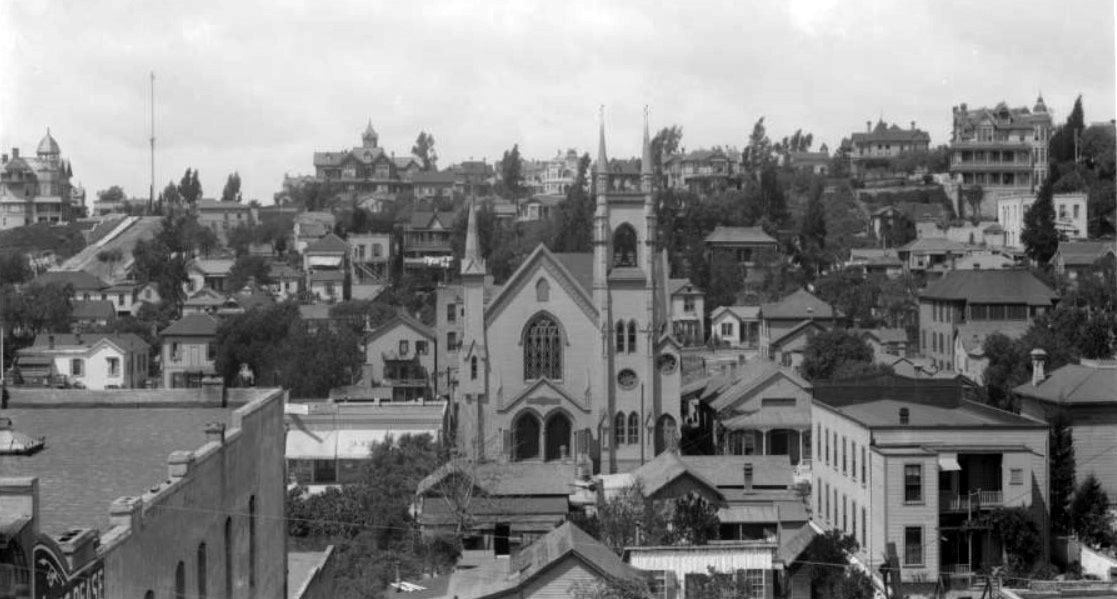 |
|
| (ca. 1890)^^ - Panoramic view of downtown Los Angeles looking west from Spring Street and Fourth Street toward Bunker Hill across Broadway between Third Street and Fourth Street. Fort Street Methodist Episcopal Church (later purchased by Homer Laughlin for $63,000 in 1899) stands in the center of the photograph which includes principally dwellings. The Crocker Mansion can be seen in the upper right. The tall pole at the top of Bunker Hill seen in the upper-left is one of Los Angeles’ earliest electric stretlights, standing 150-ft tall. Click HERE to see more in Early L.A. Streetlights. |
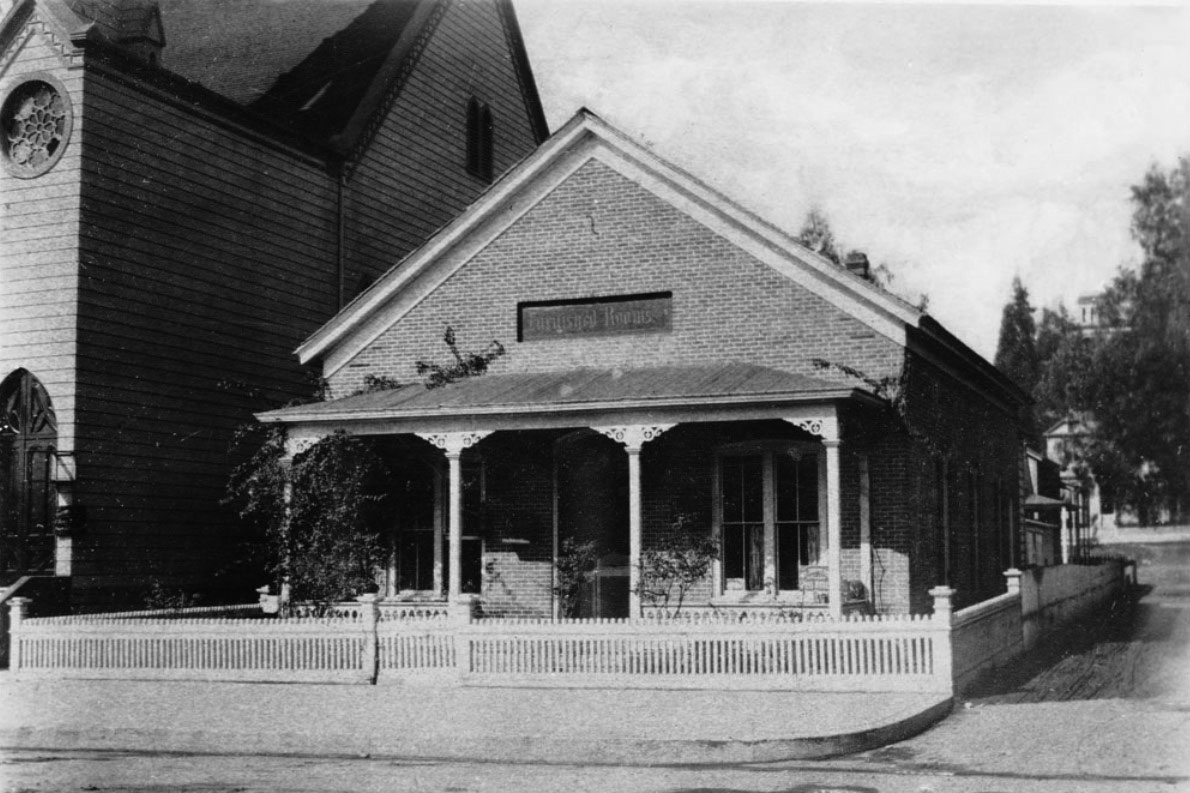 |
|
| (ca. 1890)^^ - View showing the Hunter Residence located on Fort Street (later Broadway) near Third Street. The single-story brick house has a small fence surrounding its perimeters. It features a covered porch, large rectangular windows and a symmetric, inclined roof. Above the covered porch is "furnished rooms" sign. The Fort Street Methodist Episcopal Church is to the left of the small house. |
* * * * * |
Bunker Hill
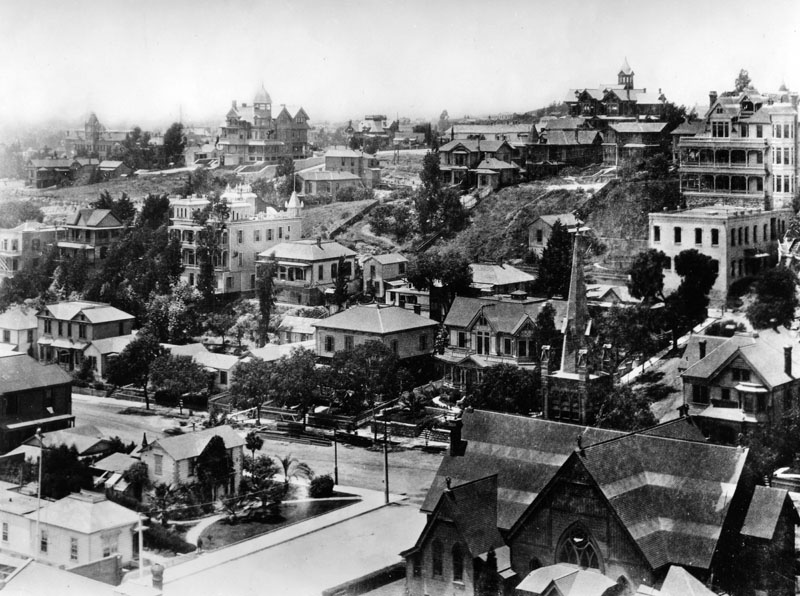 |
|
| (ca. 1890)^ - Bunker Hill neighborhood, as seen from east of Hill Street (foreground). 3rd Street (lower center) is to the left of the First Congregational Church (lower right), which later became the Central Baptist Church then lastly the Unitarian Church. The Crocker Mansion is seen in the upper right and the Leonard John Rose (with cupola) residence at Fourth Street and Grand Avenue is present in the upper left. |
Historical Notes In 1867, an enterprising French Canadian immigrant named Prudent Beaudry bought the land atop Bunker Hill -- at the reported cost of $51. Beaudry constructed a system of pipes and steam-powered pumps to deliver water to the hilltop from a reservoir below. He also built roads to connect the hill to the developed flatlands below and laid out streets atop the hill. One of them, which Beaudry named Bunker Hill Avenue in honor of the 100th anniversary of the Revolutionary War battle fought in Boston, eventually lent its name to the entire hilltop community.* In 1868, Prudent Beaudry and his two partners, John Griffen and Solomon Lazard, formed the private Los Angeles Water Company. They would go on and sign a 30 year lease franchise agreement with the City to run its water system (1868 - 1898). Prudent Beaudry also served as the 13th Mayor of Los Angeles from 1874 to 1876. Click HERE to read more in Water in Early Los Angeles. |
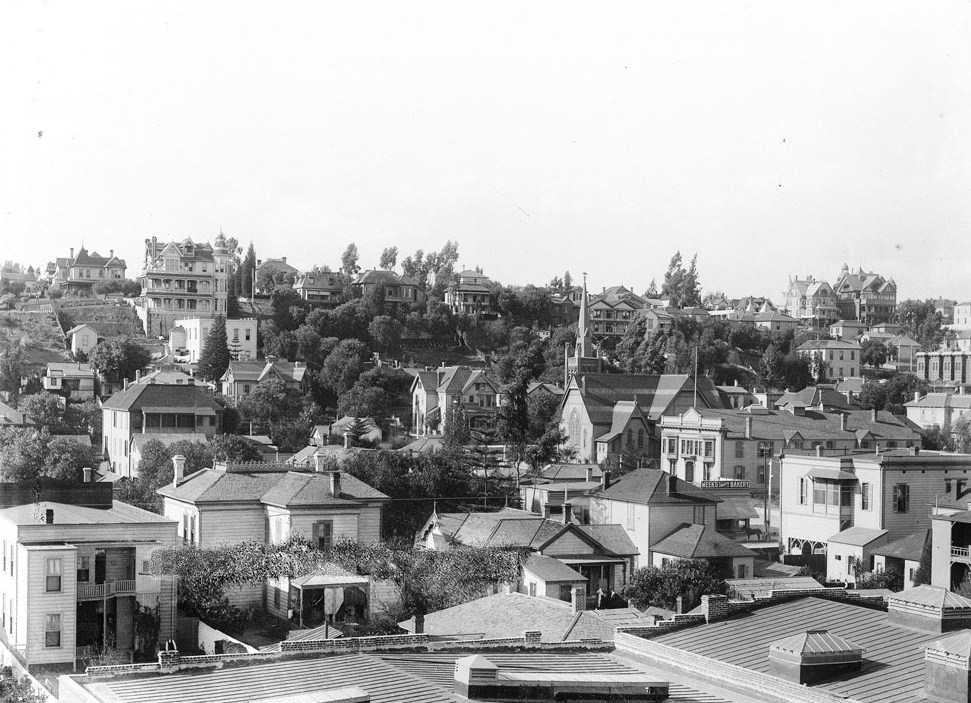 |
|
| (1898)^^ - View of Bunker Hill looking west from Spring Street near 3rd Street. First Congregational Church with its tall spire can be seen at center-right and the Crocker Mansion is at upper center-left. |
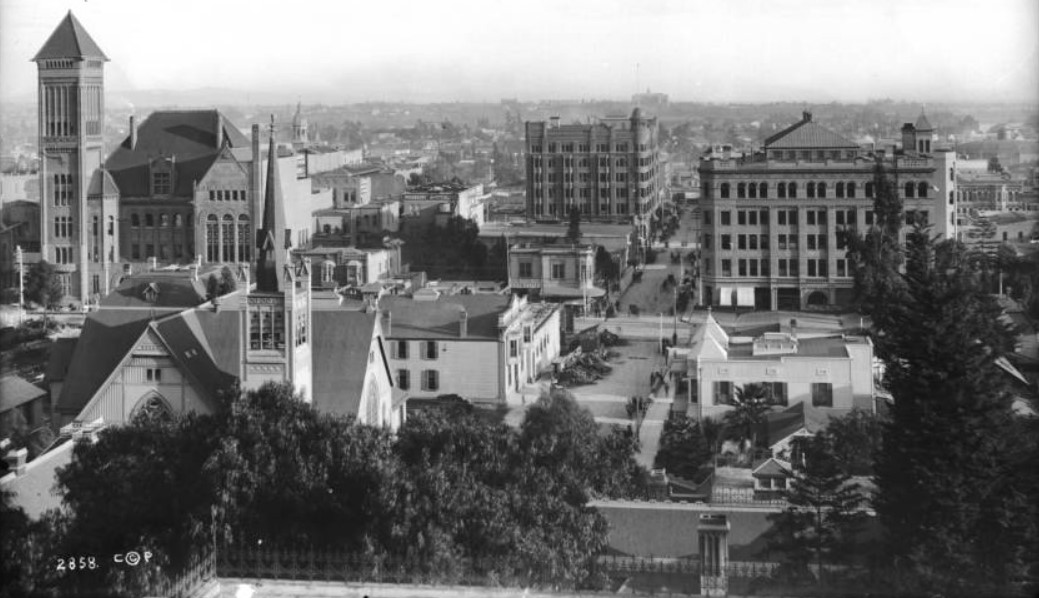 |
|
| (1894)^^ - Panoramic view of downtown Los Angeles, looking east, as seen from the rear deck of the Crocker Mansion . The view is looking toward the intersection of Broadway and Third Street where the Bradbury Building stands on the southeast corner. The streets are busy with horse-drawn vehicles and pedestrians. A pile of construction supplies and debris is visible near the intersection. City Hall is at left on Broadway and the First Congregational Church at lower-left (NE corner of 3rd and Hill). |
Historical Notes Built in 1893, the Bradbury Building was commissioned by LA mining millionaire Lewis L. Bradbury and designed by local draftsman George Wyman. It still stands today and is the oldest building in Downtown LA. Click HERE to see more Early Views of the Bradbury Building. |
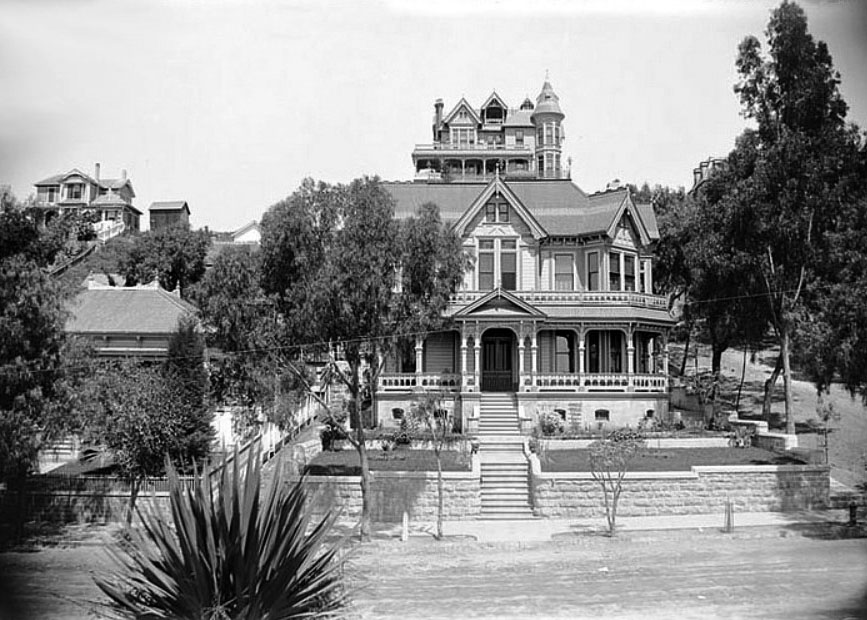 |
|
| (1895)#^* – View looking west at 3rd and Hill Streets with the Crocker Mansion seen at the top of Bunker Hill. The southwest corner of 3rd and Hill (lower-right) would become the lower station terminal of Angels Flight. |
Historical Notes At the turn of the 20th Century, no building dominated Bunker Hill like the Crocker Mansion. Perched high at the corner of Third and Olive, the imposing 3-story Victorian structure overlooked the emerging metropolis for more than 22 years.* |
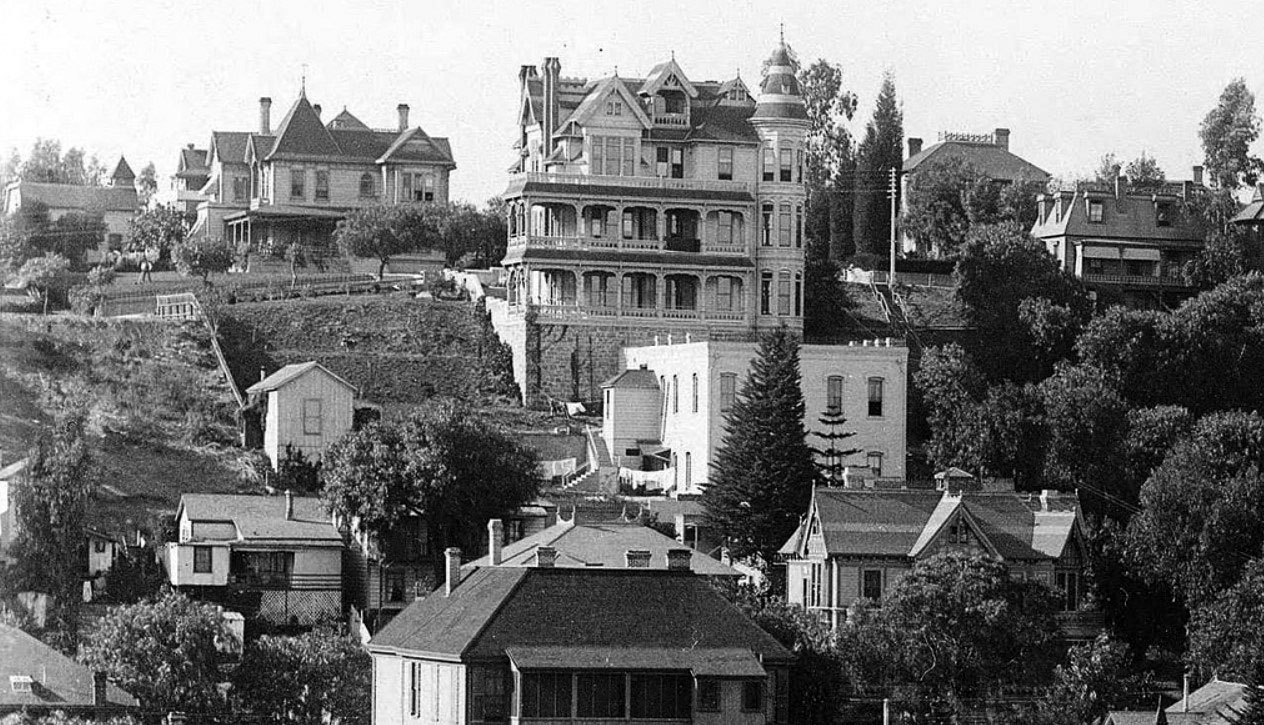 |
|
| (1898)^^ - Panorama view from 3rd and Spring streets showing the Crocker Mansion and neighbors on Bunker Hill. |
Historical Notes Construction on the Third Street Tunnel began in 1900, and Mrs. Crocker filed a petition claiming that the mansion was endangered by the street tunnel which was “unsafe, improperly constructed and a veritable death trap.” According to the Los Angeles Times, “the walls of her house are settling, the foundations giving way and the plaster is falling off…Unless something is done, the building is liable to topple into a hole.” The house never did topple and was alive and well in 1902 when Angels Flight began operating and dropping riders off practically on the Crocker doorstep.* |
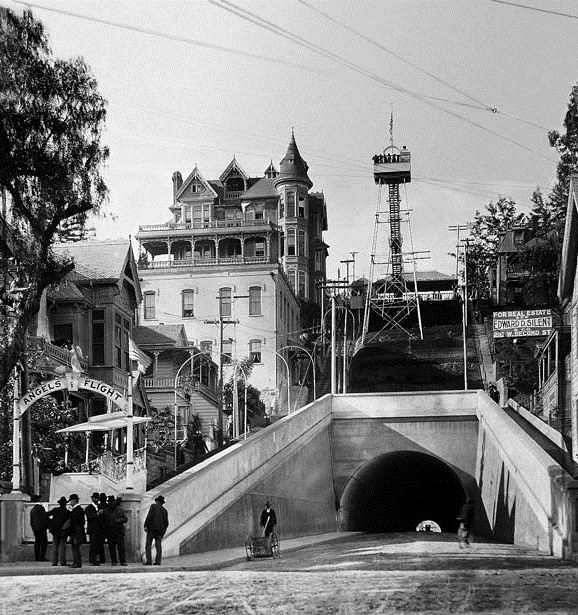 |
|
| (1901)^*# - Photo of Angels Flight at the grand opening of the railway, December 31st, 1901. An observation tower was also constructed on top of the hill adjacent to the Crocker Mansion. |
Historical Notes Built in 1901 with financing from Colonel J.W. Eddy, as the Los Angeles Incline Railway, Angels Flight began at the west corner of Hill Street at Third and ran for two blocks uphill (northwestward) to its Olive Street terminus.*^ Click HERE to see more Early Views of Angels Flight. |
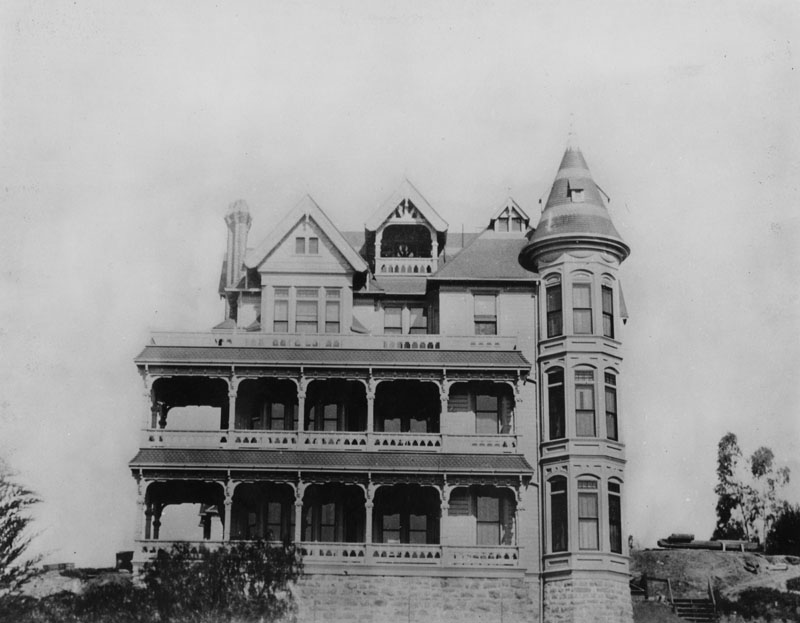 |
|
| (1890s)^ - Rear view of the Crocker Mansion showing the full extent of its wide balconies where you could get a great view of the emerging metropolis of Los Angeles. |
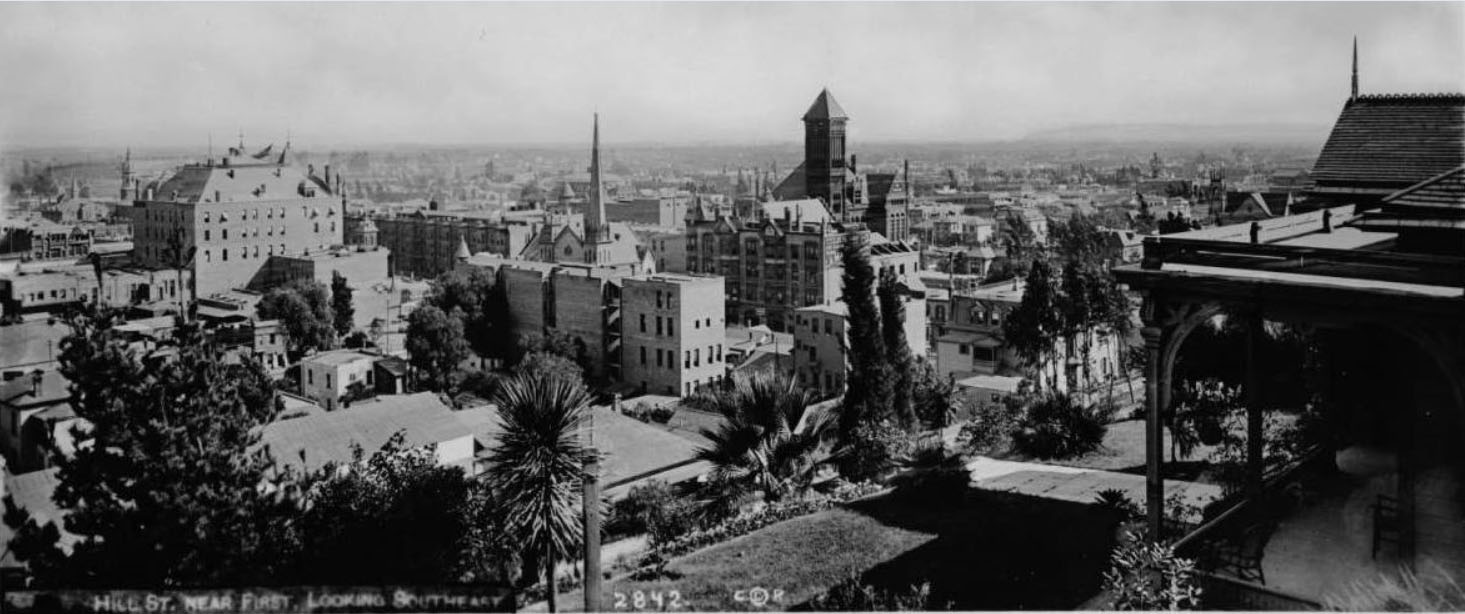 |
|
| (ca. 1890)^^ - Panoramic view of downtown Los Angeles looking southeast on First Street and Hill Street toward Broadway. City Hall, which is the tall tower with a flagpole, is at center-right. The First Presbyterian Church can be seen at center-left with a spire. |
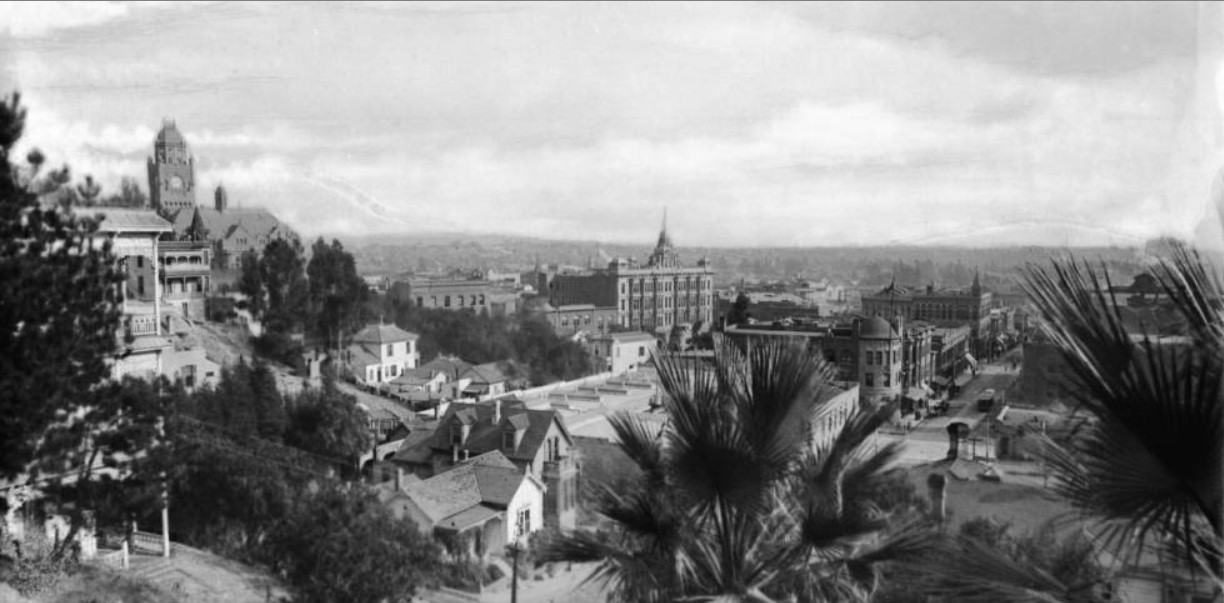 |
|
| (ca. 1891)^^ - Panoramic view of Los Angeles from 1st Street and Hill Street looking southeast. The 3-story Highland Villa (n/w corner of 1st and Hill) is on the far left. Also on the left, in the distance, stands Los Angeles County Courthouse with it’s distinctive clock tower. The LA Times Building, located on the northeast corner of 1st Street and Broadway, is seen at center-right between the palms. The large 4-story building at center with the cupola is the Phillips Block, located at 25-37 N. Spring Street. |
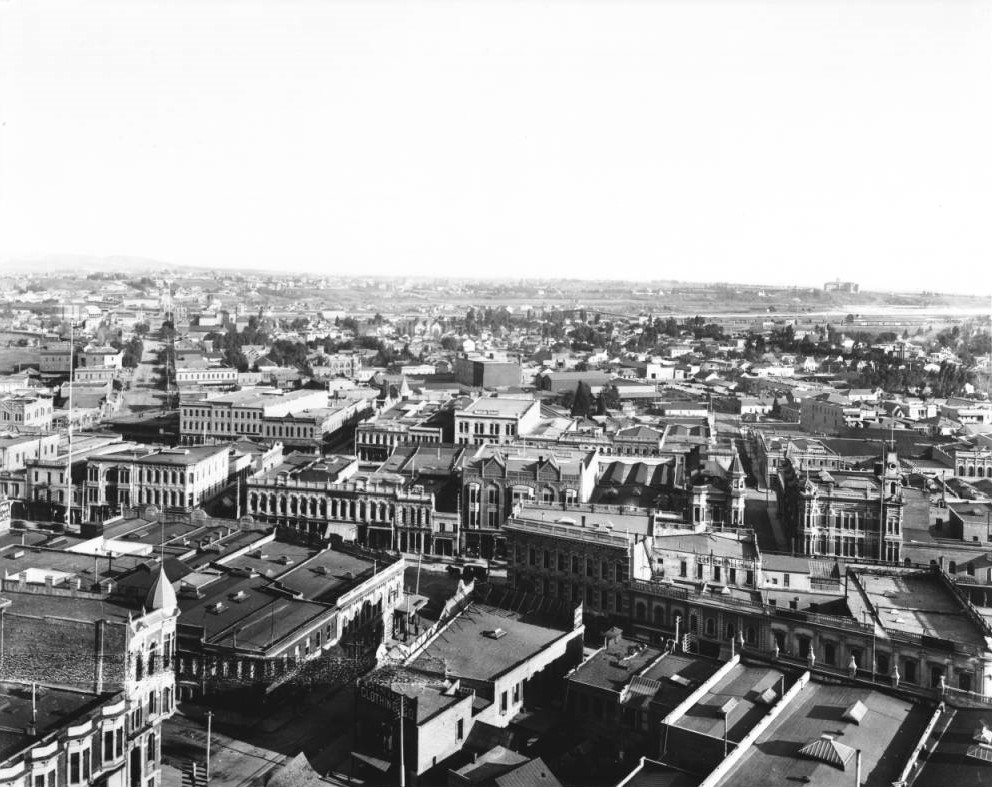 |
|
| (ca. 1890)^^ - Panoramic view of Los Angeles looking east as seen from the top of the Court House tower, showing the orphanage building in the distance. The area in the foreground is densely packed with commercial buildings and many of which boasts Greek or Italian-style architecture. Aliso Street can be seen at left running into the left background. The historic intersection of Main, Temple, and Spring Streets can be seen at lower-center. Trees are sparsely scattered throughout the city, and what appears to be the Los Angeles River can be seen across the background. |
* * * * * |
Hill and 5th Streets
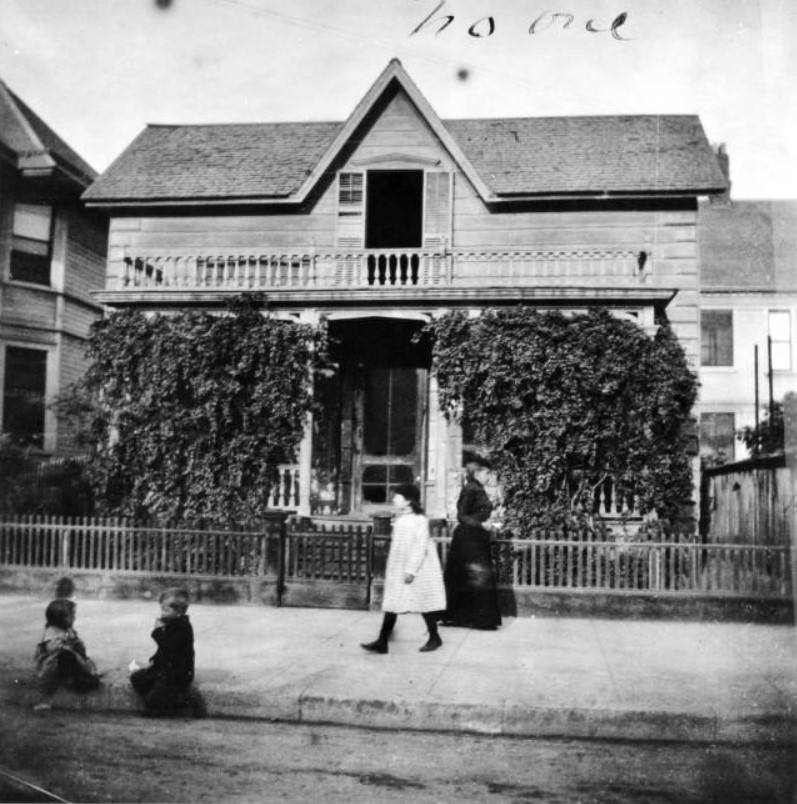 |
|
| (ca. 1890)^^ - View showing the first building erected on the corner of Fifth Street and Hill Street in Los Angeles. The small, two-story clapboard house is at center. It has a small balcony with an open doorway at center, as well as a covered porch on the first floor. Large vines have grown up the side of the porch, hiding much of the front of the house from view. Four people are on the sidewalk in the foreground, including two young children at left and a girl and a woman walking at center. |
Historical Notes The building, the home of Mary E. Taft, was moved to face Fifth Street. Later this block would become part of the center of Los Angeles' financial district.^^* |
* * * * * |
Grand and 2nd Street (S/W Corner)
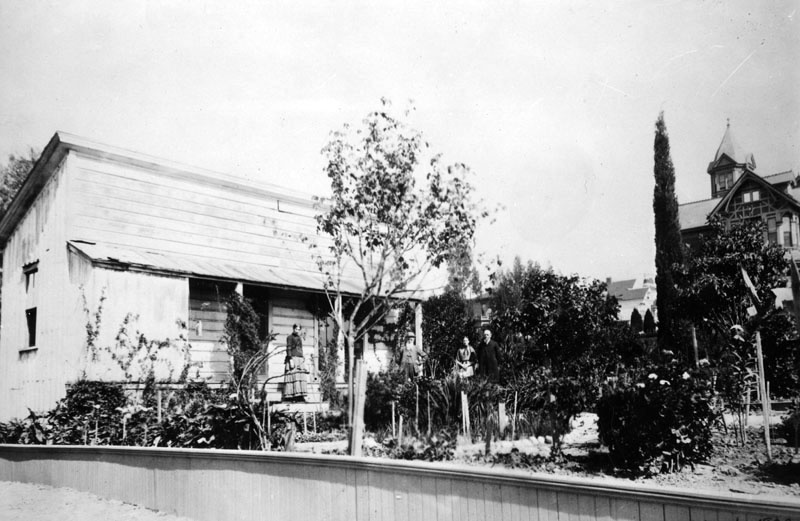 |
|
| (1890)^ - Photo taken from the southwest corner of 2nd Street and Grand Avenue, looking north on Grand. It shows a modest one-story home. A woman stands on the steps that lead to the entrance of the house and three other people are standing in the garden, all looking toward the photographer. Visible behind tall trees, a larger, more elaborate Victorian home can be seen. |
* * * * * |
Flower and 8th (S/E Corner)
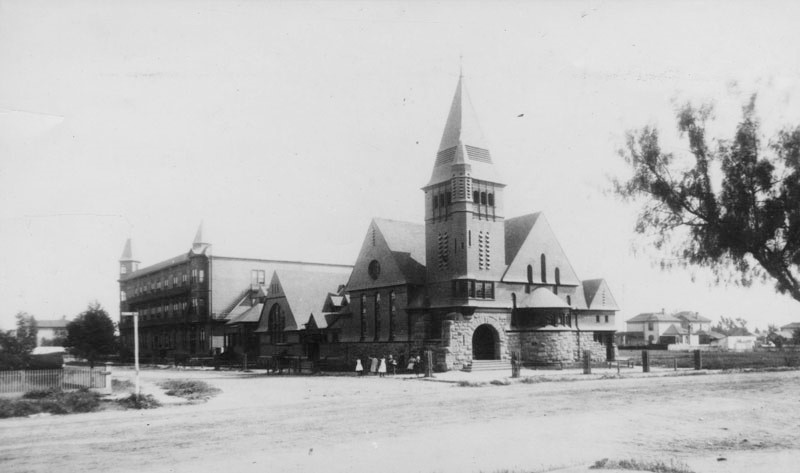 |
|
| (1890)^- View showing the First English Lutheran Church, located at the southeast corner of Flower and 8th Streets in Los Angeles, shown soon after its construction in 1890 before the streets were paved. The Abbotsford Inn is visible behind the church on the left side and a few residences are seen in the background on the right. |
Historical Notes Abbotsford Inn was converted into a hotel by Abbot Kinney, best known as the developer of Venice. The building, designed by Robert B. Young, was erected in 1887 by D. W. Hanna as Los Angeles College or Hanna College. After the college failed, Kinney took it over.^ |
* * * * * |
Broadway and 10th Street (now Olympic Blvd)
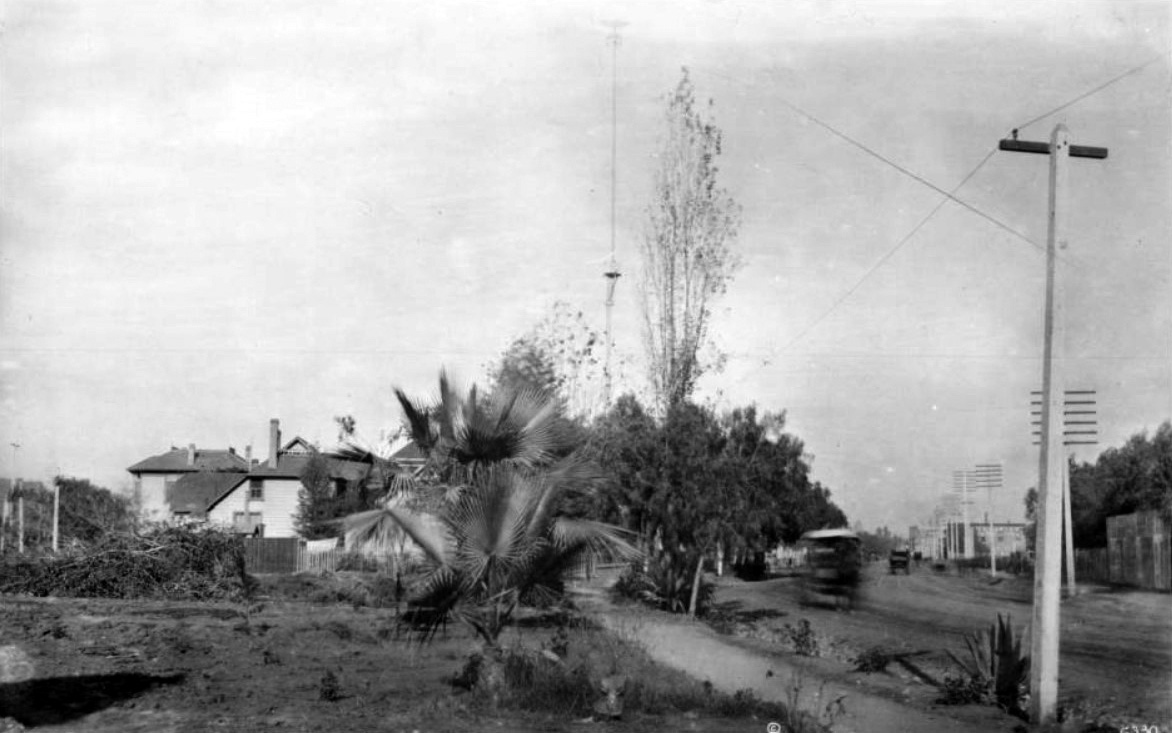 |
|
| (1890)^^ – View looking north on Broadway from 10th Street (Olympic Blvd. today). At least two craftsman-style buildings with chimneys are visible in the background left of the street, partially obscured by trees and other vegetation. The street is unpaved and what appear to be several horse-drawn carriages and/or trolleys are moving along it too quickly to be photographed with clarity. A telephone pole is visible to the right, and what appears to be a pile of cut tree branches is in the lot next to the buildings. Note the tall pole in the center of the photo. It is 150-ft tall and is one of Los Angeles' First Electric Streetlights. |
Historical Notes In 1932, the entire length of the 10th Street, from East L.A. to Santa Monica, was renamed Olympic Boulevard for the 10th Summer Olympics being held in Los Angeles that year. *^ Click HERE to see the same view in 1926. Click HERE to see the same view in 2015. |
* * * * * |
Broadway and 8th Street (N/E Corner)
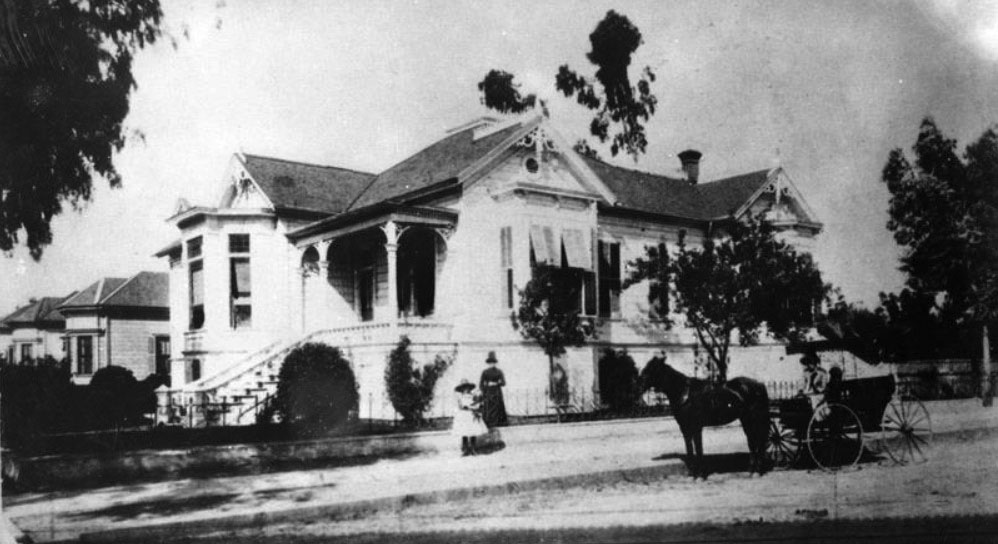 |
|
| (ca. 1897)+** – View showing the northeast corner of 8th Street and Broadway. A woman and young girl are seen standing in front of the Victorian house. Another woman is seated in a horse-drawn carriage. Click HERE to see contemporary view. |
Pasadena
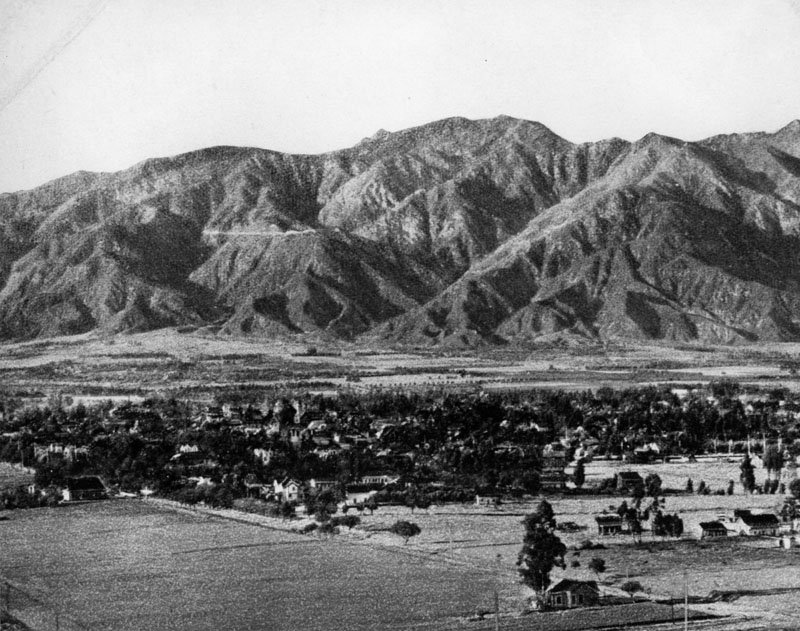 |
|
| (ca. 1890)^ - Postcard view showing Pasadena and Mount Lowe in the San Gabriel Mounains as seen from the Hotel Raymond. |
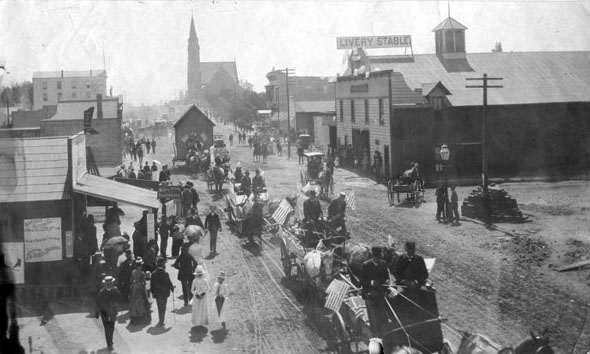 |
|
| (ca. 1890)*#* - View of Colorado Boulevard, then named Colorado Street, looking east to Marengo Avenue. Horse-drawn wagons with displaying america flags appear to be in a parade (possibly 4th of July). |
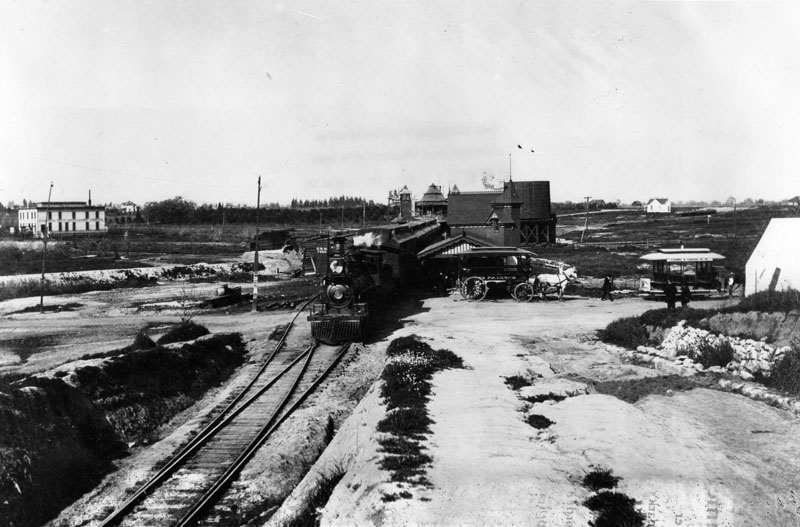 |
|
| (1890)^ - View showing the Raymond Station in South Pasadena. A locomotive with cars, stand ready, outside the station. A horse-drawn vehicle, parked alongside of the station, would shuttle guests to the Raymond Hotel. |
Historical Notes The Raymond Hotel guests invariably arrived by train, the mainline Santa Fe which stopped at Raymond Station at the bottom of the hill. Many had private cars that would park on the side spur near the station. All guests were ferried by a horse-drawn bus to the hotel at the top of the hill. Later, much to the dismay of many guests, the old station closed down in deference to a newer station built up the tracks closer to downtown Pasadena. Guests were then forced to take an auto bus the extra distance to the hotel. |
Click HERE to see more in Early Views of Pasadena. |
* * * * * |
Alhambra
 |
|
| (ca. 1890)^ - Photograph of Alhambra, Garfield and Main Street ca. 1890. A horse drawn street car is in front of the elaborate Alhambra Hotrel. The building on the opposite corner is named the Jones Building and was erected in 1887. |
Historical Notes Alhambra was founded as a suburb of Los Angeles in 1903. It existed as an unincorporated area during the mid-19th century. The first school in Alhambra was Ramona Convent Secondary School built on hillside property donated by the prominent James de Barth Shorb family. Thirteen years before the city was incorporated, several prominent San Gabriel Valley families interested in the Catholic education of their daughters established the school in 1890. The city's first public high school, Alhambra High School, was established in 1898, five years before the city's incorporation. The Alhambra Fire Department was established in 1906. On July 11, 1903, the City of Alhambra was incorporated. Alhambra is named after Washington Irving's book Tales of the Alhambra, not after the Alhambra palace itself.*^ |
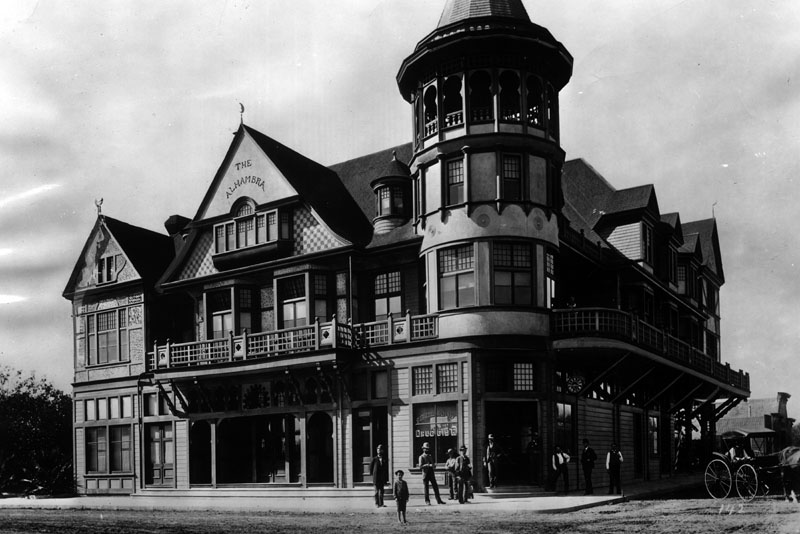 |
|
| (1898)^- This was one of the big hotels in Alhambra in 1898. Early settlers made their homes in Alhambra, gateway to the San Gabriel Valley, because of the water works. |
Historical Notes The elegant Alhambra Hotel stood at the northwest corner of Garfield and Main. This ornate structure was one of the earliest commercial buildings having been built in 1888 and which featured a billiards hall, barbershop, and restaurant. Unfortunately, the building burned down in 1908.*##* |
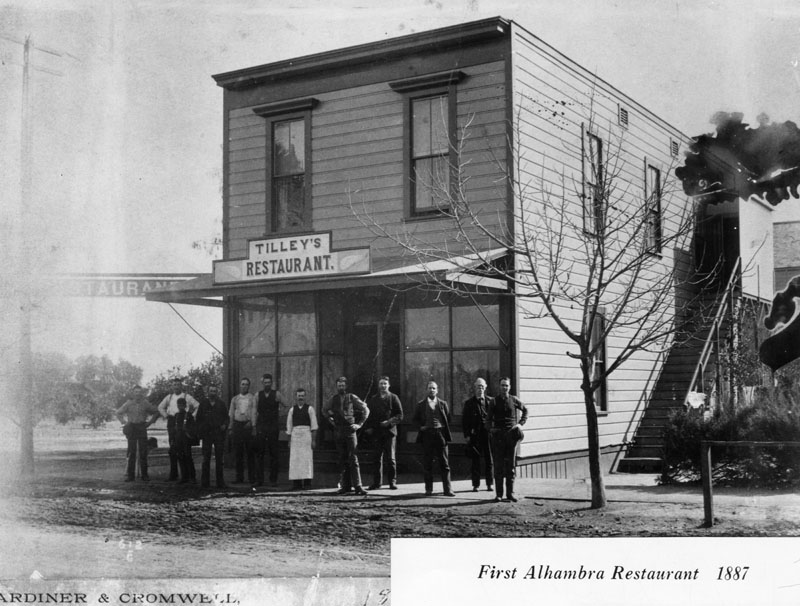 |
|
| (1887)^ - Alhambra's first restaurant was named "Tilley's" and was located in this two story wood frame building with a sidewalk and unpaved street. |
Historical Notes Tilley's Restaurant opened in 1885. It was built by H. W. Stanton at the corner of Main and Garfield, the building was first used as a post office and grocery. The upstairs hall was used as a church, school, community meetings, and entertainment gathering place. H. W. Stanton was the first storekeeper, postmaster, teacher, telephone agent, land subdivider and promoter. After subdividing several ranches he became wealthy and retired. He took a trip around the world, but upon his return to Alhambra found that the boom had gone bust, and he too was broke.^#*# |
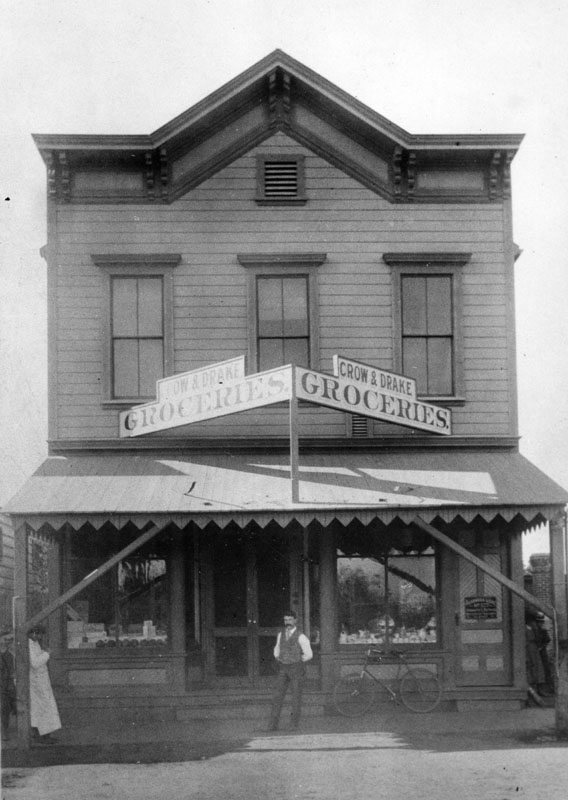 |
||
| (1898)^ - An unidentified man (possibly one of the owners) stands at the front door of the Crow & Drake Groceries, two-story building located on So. Garfield Ave. It was the first general merchandise store in Alhambra in 1898. |
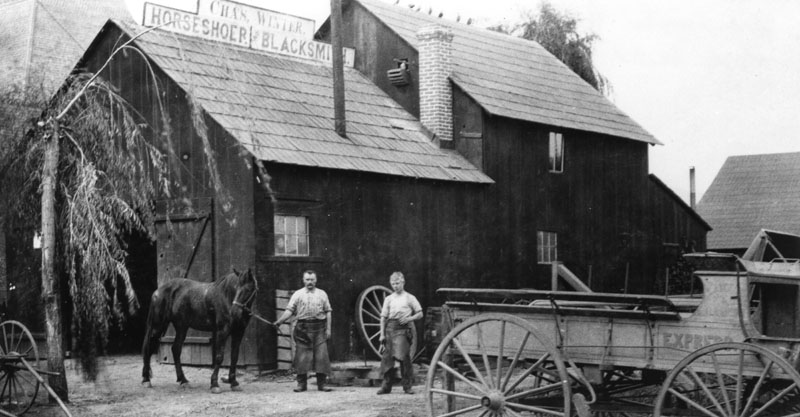 |
|
| (1890)^ - Two men and a horse stand outside a building in Alhambra with a sign on the roof identifying the owner as Charles Winter, horseshoer and blacksmith. The shop opened in 1885 and was located at 4 W. Main Street. |
* * * * * |
Wolfskill Ranch - Arcade Station - Arcade Palm
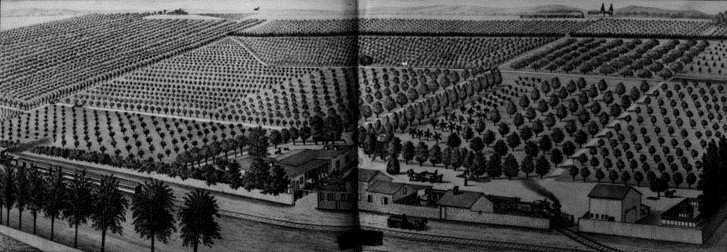 |
|
| (ca. 1880)^ - Full frame lithograph photo of the orange and lemon groves on the Wolfskill Ranch, residence of William Wolfskill. The Los Angeles and Independence Railroad Station can be seen in the background. The Southern Pacific Arcade Station would later be built on the Wolfskill Ranch. |
Historical Notes William Wolfskill, a native of Kentucky, came to California in 1831 and settled in Los Angeles in 1836. In March 1838, Wolfskill purchased a 100-acre lot bounded by 3rd to 9th streets and San Pedro to Alameda streets, which he named Wolfskill Ranch, and built a large adobe (known as "Wolfskill Adobe") located at 239 Alameda, between 3rd and 4th streets. In 1839 Wolfskill became a major grape producer when he planted the first vineyard of table grapes in California. Two years later, in 1841, he planted his first 2-acre plot of citrus behind his adobe, between 4th and 6th streets east of Alameda. In a short period of time, Wolfskill's farm had increased to 28-acres of planted citrus with over 2,500 orange trees. By 1862 he owned 3/4 of all the orange trees in California and was the biggest orange grower in the United States - for which he is considered the father of early California citrus industry.^ |
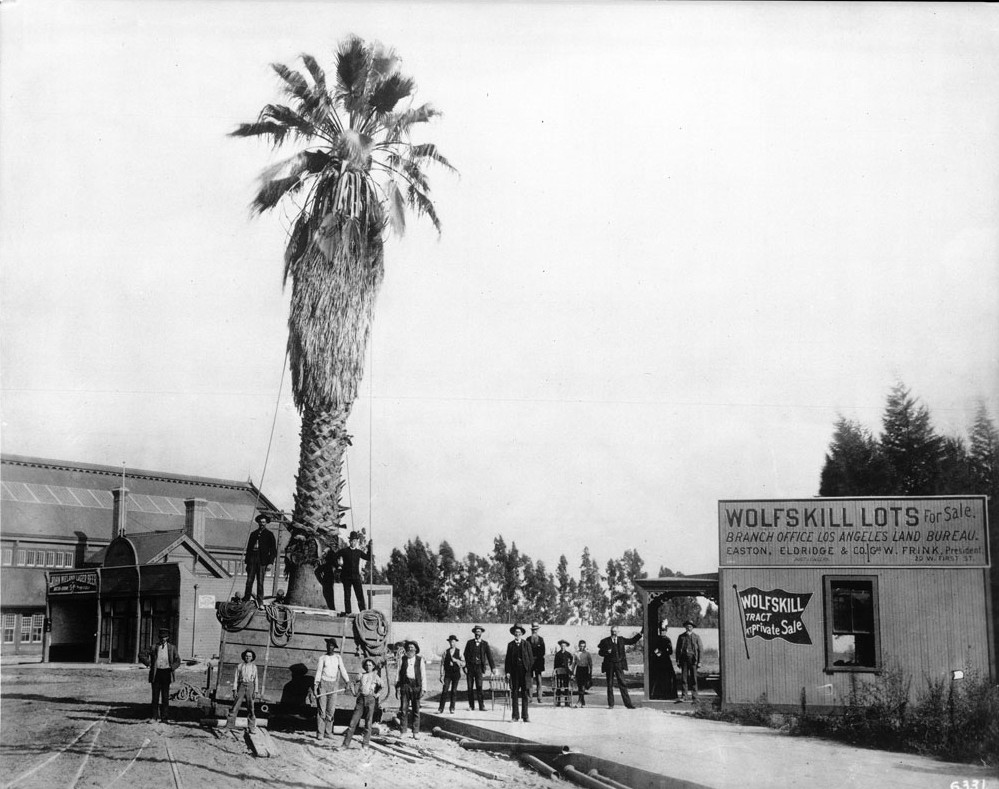 |
|
| (1889)^^ - View of a palm tree being moved to the front of the Arcade Depot on Fifth Street and Central Avenue on land that was once occupied by the Wolfskill Adobe. |
Historical Notes In 1888, the Southern Pacific Railroad built the Arcade Depot in competition with the Santa Fe Railroad. Santa Fe R.R. would open the La Grande Station at 2nd Street and Santa Fe Avenue just five years later, in 1893. The Arcade Depot replaced the adobe house of William Wolfskill and its surrounding orange grove, the largest in Southern California.^ |
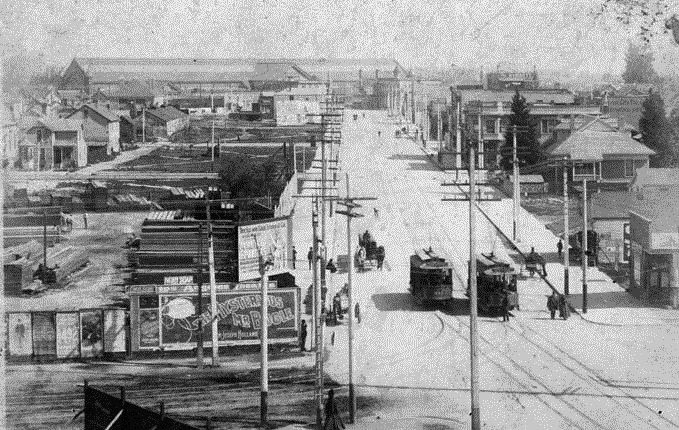 |
|
| (ca. 1890s)^ - View looking east along a street leading to the Southern Pacific Railroad Arcade Station in the background. This turn-of-the-century view shows street railway cars, horse-drawn vehicles, and what appears to be an early automobile behind the pole in the center foreground. |
Historical Notes The first automobile in Southern California appeared in 1897. It was built in a shop on Fifth Street in Los Angeles by S.D. Sturgis for J. Philip Erie. Erie became the first to drive an automobile on Los Angeles roads. By 1904, 1,600 cars were cruising the streets of Los Angeles. The maximum speed limit was 8 mph in residential areas and 6 mph in business districts.^#* |
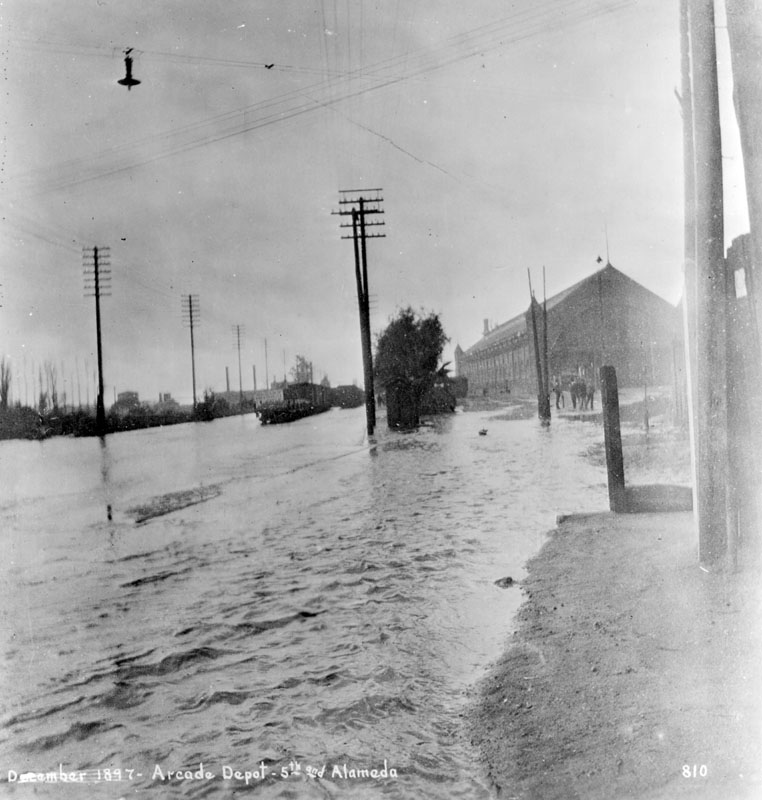 |
|
| (1897)^ - A river of water on Alameda Street looking south from 4th Street in December, 1897, when rain measured 6.53 inches. Seen is the Southern Pacific Railroad Arcade Station. |
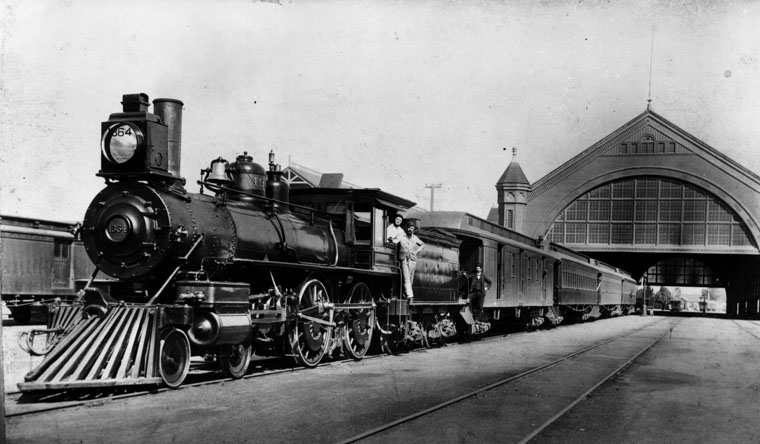 |
|
| (1891)^ - Southern Pacific steam engine no. 1364 heads the train at the Arcade Station at Alameda between 4th and 5th St. |
Historical Notes The Arcade Station was the second station built by Southern Pacific in Los Angeles (and first one built primarily for passenger service). Built in 1889 and used until 1914 when it was replaced by larger SP Central Station. It was demolished shortly thereafter. |
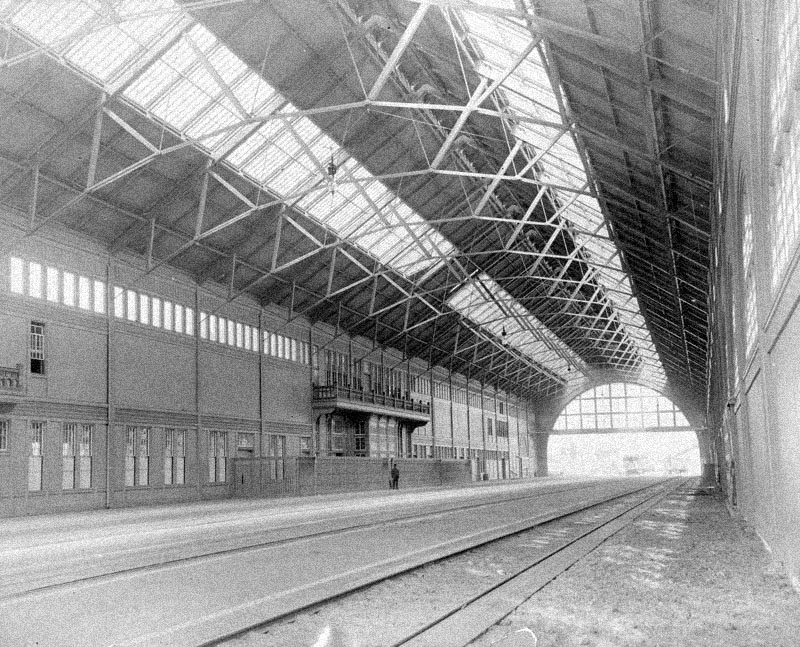 |
|
| (n.d.)^ - Interior view of an empty Arcade Depot. The trains appear to be sitting outside the building. |
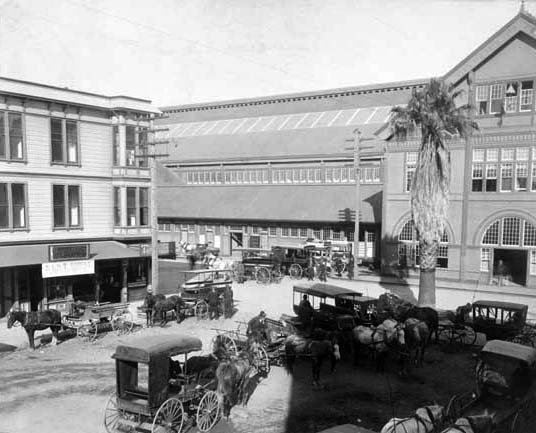 |
|
| (ca. 1890)^## - View showing over a dozen horse-drawn wagons waiting for the next train to arrive at the Southern Pacific Arcade Depot. |
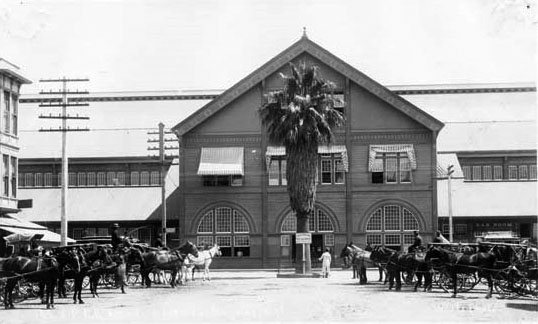 |
|
| (1896)^## – Close-up view of the large palm tree standing in front of the Arcade Depot. Horse-drawn wagons are parked in front of the station. |
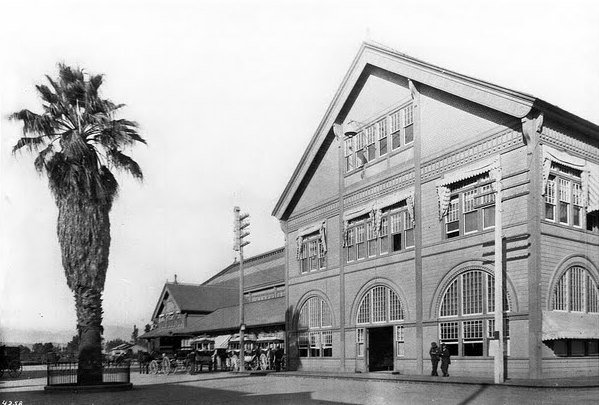 |
|
| (1908)^^ - Close-up view of the Arcade Depot with it's now-famous palm tree standing tall in front of the main entrance. Horse-drawn carriages can be seen waiting for the arrival of passengers. |
Historical Notes In 1914, the Southern Pacific Railroad replaced the Arcade Station with the Central Station, a larger and more modern railroad passenger depot. The Union Pacific Railroad moved its Downtown Los Angeles passenger terminal to Central Station in 1924 after its original passenger depot just south of First Street on the east side of the Los Angeles River was destroyed by fire.*^ |
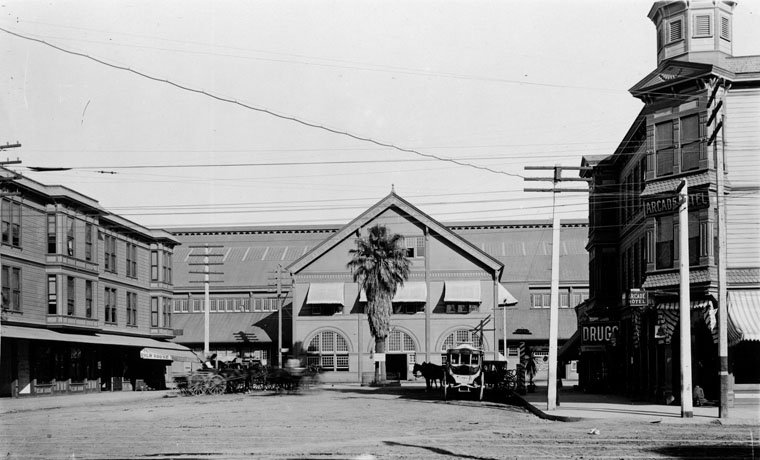 |
|
| (1914)^ - Horse and buggies are parked outside the Arcade Station in its last year of operations at Alameda between 4th and 5th St. The singular Arcade palm tree can be seen in front of the station, the same tree seen being planted in the earlier 1889 photo. |
Historical Notes Amazingly, the original Arcade Depot palm is still alive. It was replanted at a location in front of the Los Angeles Coliseum where it stands today. It along with the Longstreet Palms are considered to be the oldest trees in the City of Los Angeles.^*# |
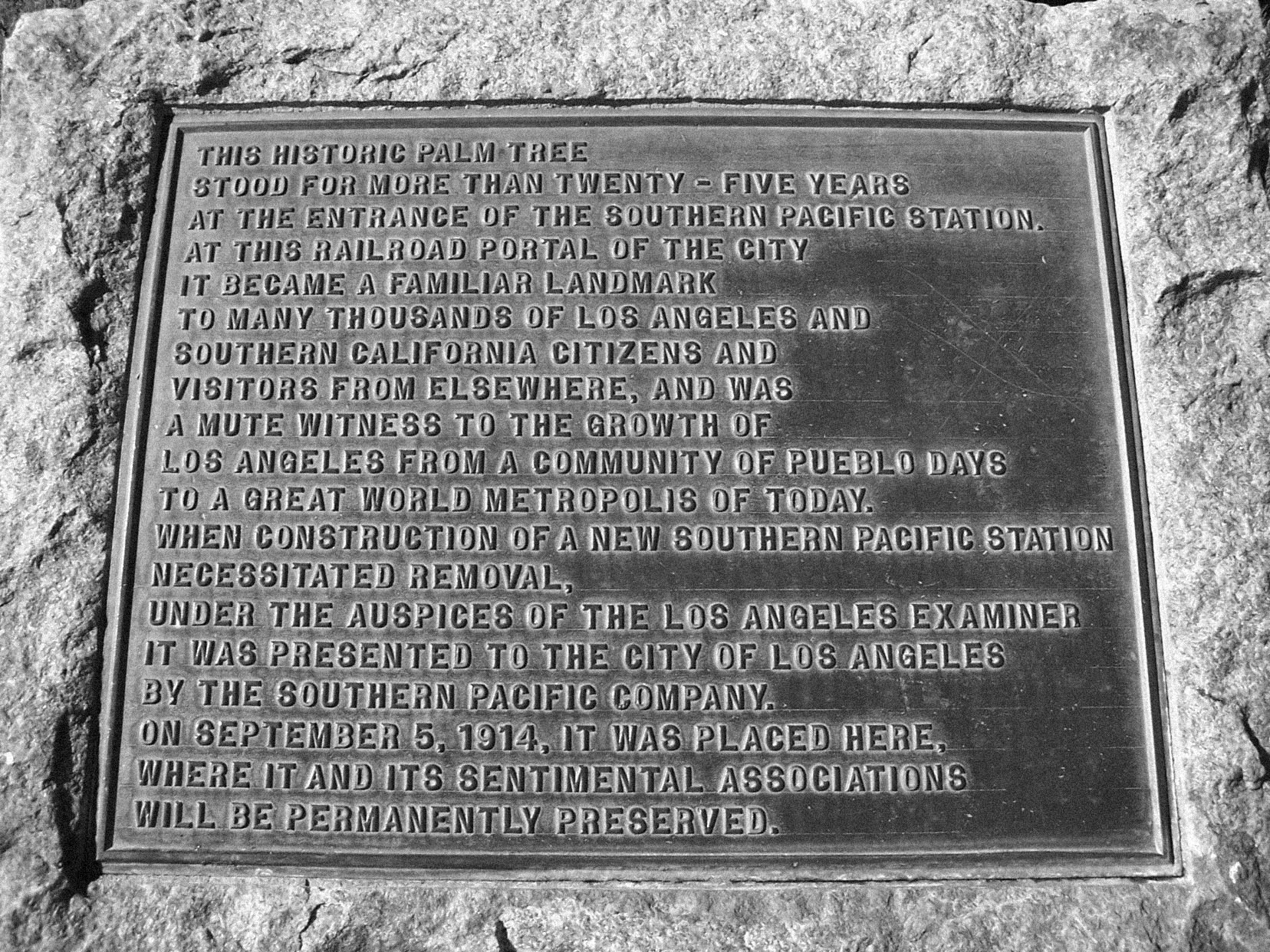 |
|
| (n.d.)#*#* - Plaque commemorating the Arcade Depot Palm as the "Mute witness to the growth of Los Angeles". Both plaque and Arcade Palm are situated in front of the LA Memorial Coliseum. |
Historical Notes The plaque sits in front of the Exposition Park entrance leading to the coliseum. It reads: “This historic palm tree stood for more than twenty-five years at the entrance of the Southern Pacific Station. At this railroad portal of the City it became a familiar landmark to many thousands of Los Angeles and Southern California citizens and visitors from elsewhere, and was a mute witness to the growth of Los Angeles from a community of Pueblo days to a great world metropolis of today. When construction of a new Southern Pacific Station necessitated removal, under the auspices of the Los Angeles Examiner it was presented to te City of Los Angeles by the Southern Pacific Company. On September 5, 1914, it was placed here, where it and its sentimental associations will be prmanently preserved.” |
* * * * * |
La Grande Santa Fe Station
_1893.jpg) |
|
| (1893)^ - View looking eastward from Santa Fe Avenue at 2nd Street. La Grande Santa Fe Depot is at right, located on the corner of 2nd and Santa Fe. |
Historical Notes Santa Fe opened La Grande Station on July 29, 1893 and it was unique for Southern California in its Moorish-inspired architecture. The station was located at 2nd Street and Santa Fe Ave, just south of the First Street viaduct built in 1929 and on the west bank of the LA River.*^ |
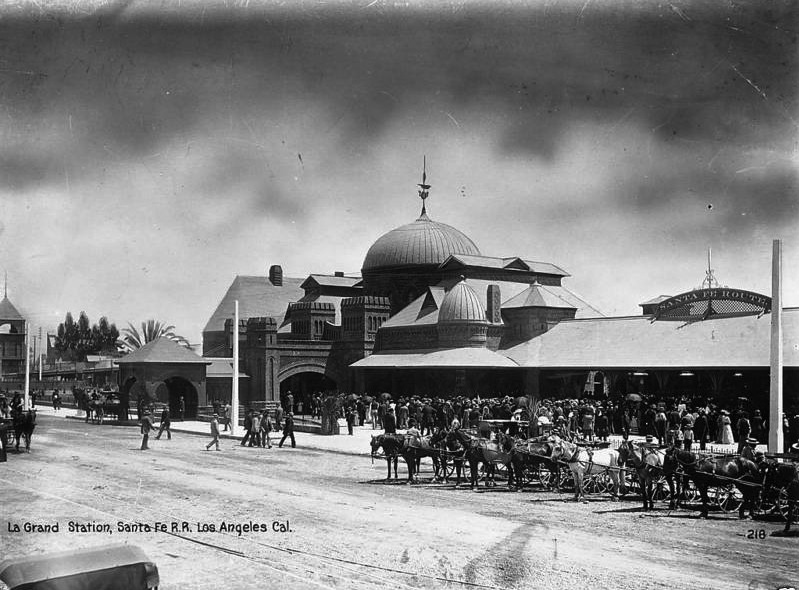 |
|
| (1890s)^^ - External view of the La Grande Santa Fe Station. Horse-drawn carriages are parked at the curb waiting for passengers. |
Historical Notes The Moorish-inspired La Grande railroad station was used as a passenger terminal for Atchison, Topeka and Santa Fe Railway.^ |
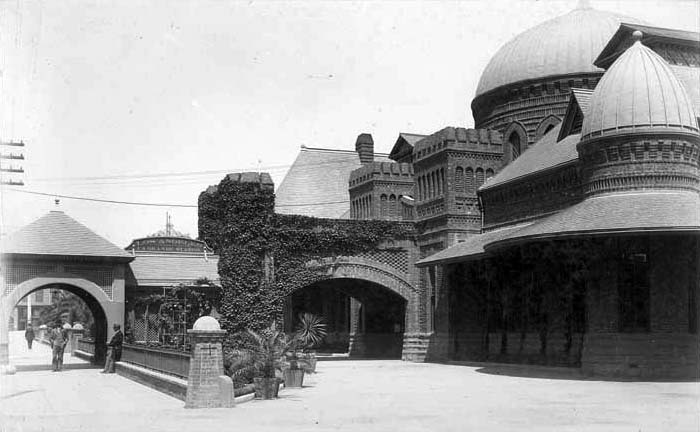 |
|
| (ca. 1894)^## - View of the front entrance to the La GrandeSanta Fe Depot showig the detail of its Moorish-style domes. |
Historical Notes Many Hollywood movies were filmed at the stylish station. Laurel and Hardy's film Berth Marks (1929) was one of the first sound movies shot on location. Other movies that used Santa Fe's La Grande Station included Choo Choo 1931 (Our Gang - Little Rascals), Lady Killer, 1933 with James Cagney, Swing Time 1936 (Fred Astaire) and Something to Sing About 1937 (James Cagney).*^ |
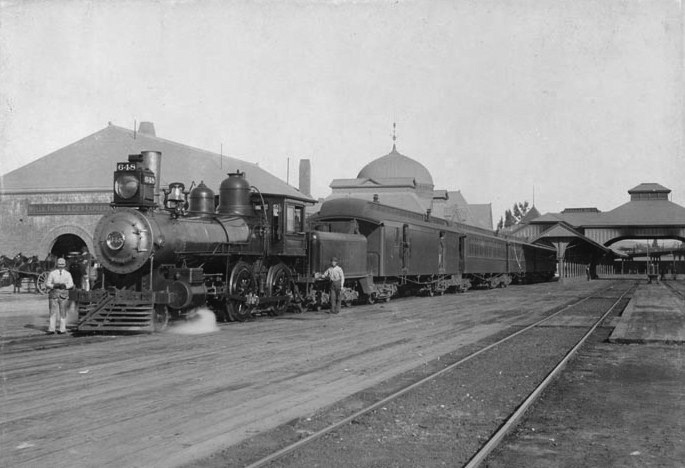 |
|
| (1890s)*^ - A passenger train is stopped at the La Grande Station as two men are seen posing for the camera. |
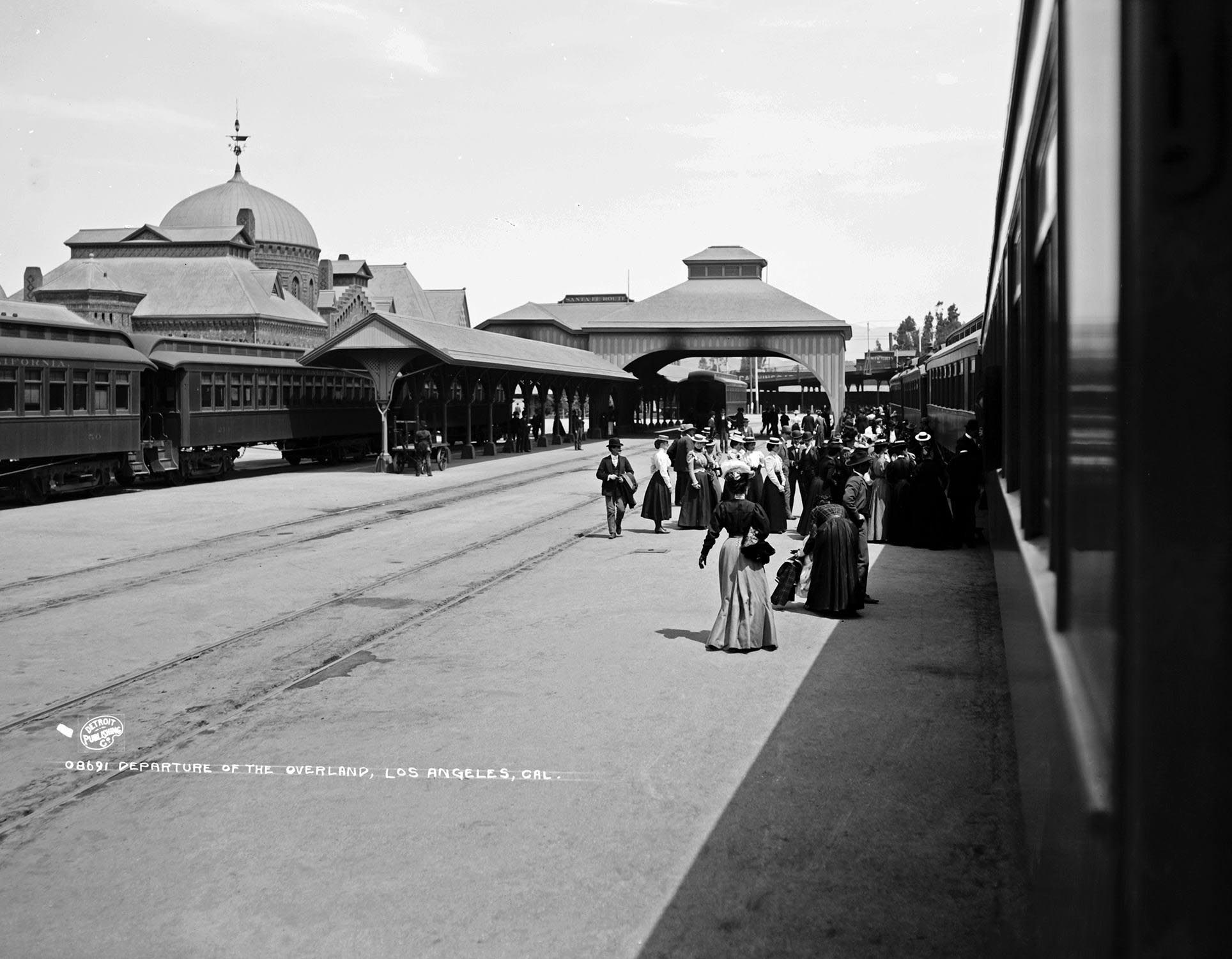 |
|
| (1893)^*^# – View showing passengers lining up to board the Overland Train at Los Angeles' La Grande Station. |
.jpg) |
|
| (1899)^*^# – Panoramic view showing a train leaving the La Grande Station. Note the tall poll in the background (center-left). It was one of Los Angeles’ first streetlights and was 150 ft. tall. Click HERE to see more in Early LA Streetlights. |
* * * * * |
Spring Street
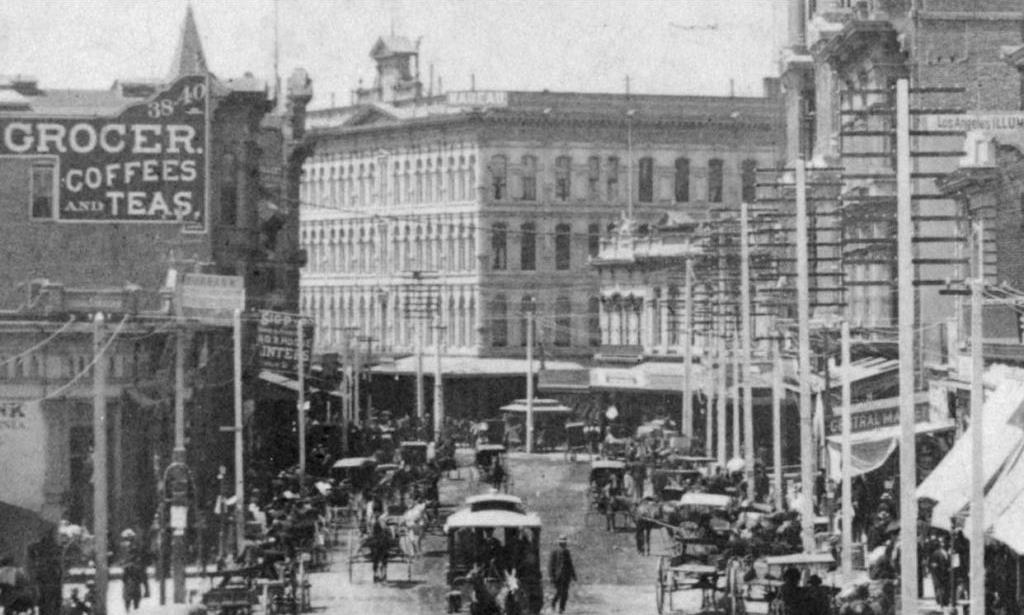 |
|
| (1880s)^*# - View looking south on a congested Spring Street towards 1st Street with the Nadeau Hotel standing on theSW corner. Horse-drawn wagons and trolleys share the road. Pedestrians are seen walking on sidewalks along numerous telegraph poles. To the left is a large sign that reads: CROCER, COFFEES AND TEAS. To the lower right a smaller sign reads: CENTRAL MARKET. |
Historical Notes The Central Market was a retail meat makret located at 149-51 Spring Street. It was owned by Simon Maier, brother of Joseph Maier of the Maier and Zobelin Brewery. Interesting Fact: The Central Market was located next door to the undertakers (per the 1894 Sanborn Map).^*# |
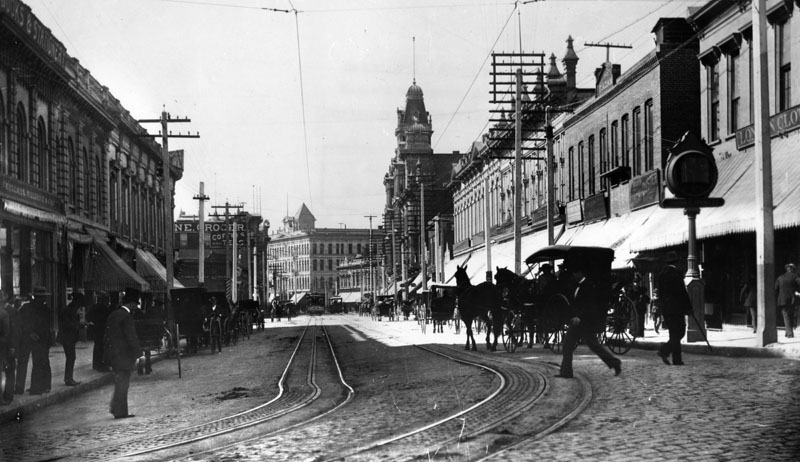 |
|
| (ca. 1890s)^ - North Spring Street looking south from Temple in the 1890s approximately 10 years after the previous photo was taken. Horse-drawn vehicles are seen mainly parked along the curbs while pedestrians cross the cable car tracks. The two largest building seen in the distance are the Nadeau Hotel (SW corner of Spring and 1st) and the more ornate Phillips Block (25-37 N. Spring Street). |
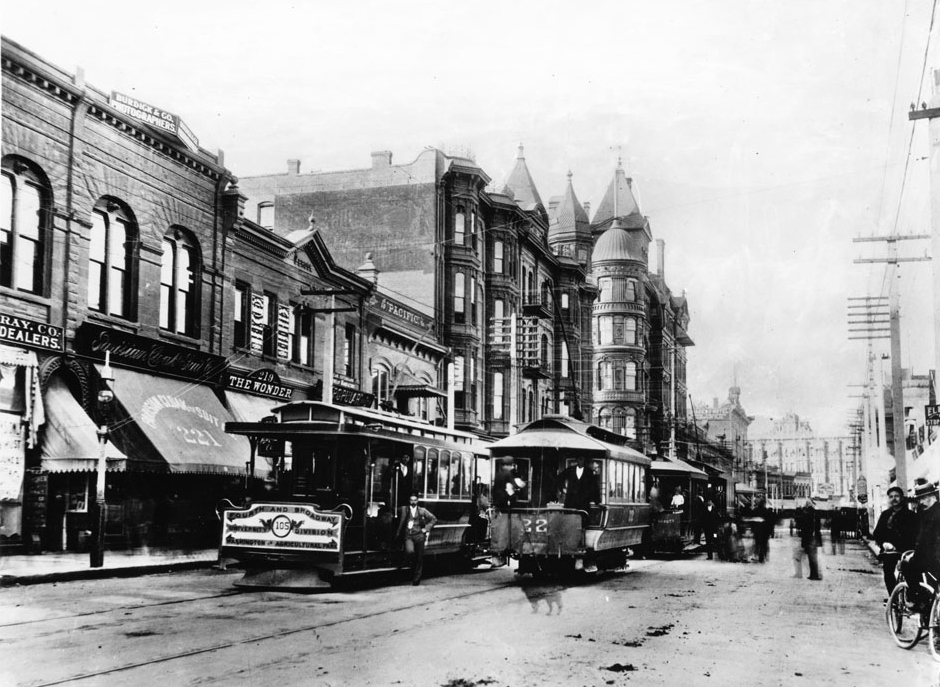 |
|
| (ca. 1891)^^ - View looking north on Spring Street from Third Street showing The Fourth Street & Broadway streetcar standing idle with its driver looking on at center as two other streetcars pass by. The Bryson Block with its multiple spires can be seen in the distance on the NW corner of Second and Spring streets. Businesses seen include the Wonder (219 South Spring Street), Burdick & Company, and the Parisian Cloak and Suit Company at 221 South Spring. |
* * * * * |
Spring and 8th Street
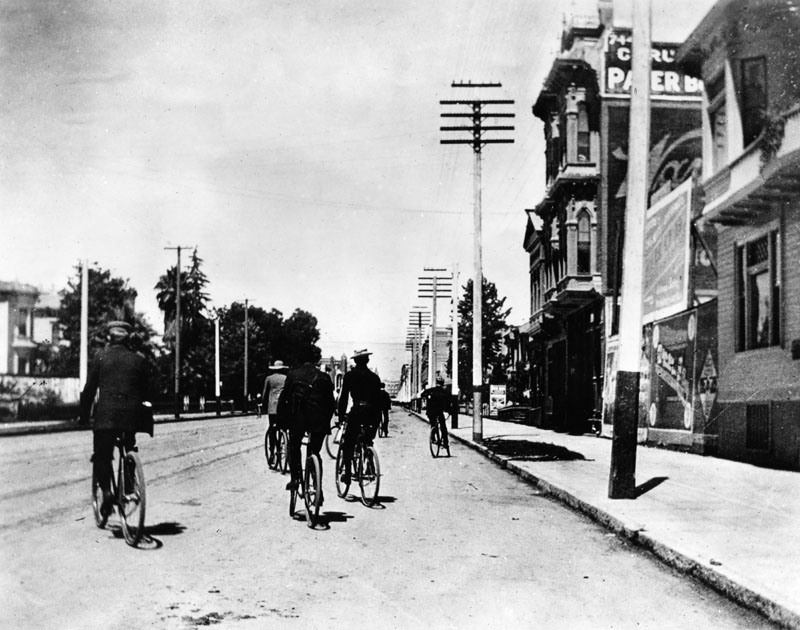 |
|
| (1899)^ - A view of bicycle riders on Spring Street riding north near 8th St. On the right side (east side of Spring) a sign for the Corum Paper Box Factory is visible on the side of a building. |
* * * * * |
San Fernando Valley
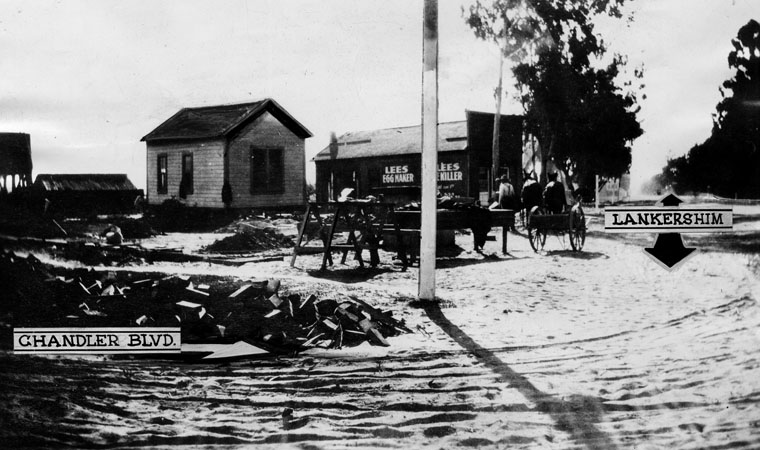 |
|
| (ca. 1891)^ - This was the intersection of Lankershim and Chandler as it appeared in the late 19th Century. Click HERE to see more in Early Views of the San Fernando Valley. |
Historical Notes Lankershim Boulevard was named for the town of Lankershim (first called Toluca, now North Hollywood) and its founding family, the Lankershims. Isaac B. Lankershim grew wheat on a wide swath of the Valley floor on his Lankershim Ranch. North Hollywood was established by the Lankershim Ranch Land and Water Company in 1887. It was first named Toluca before being renamed Lankershim in 1896 and finally North Hollywood in 1927. Chandler Boulevard was originally a leg of Sherman Way, it was renamed for land developer and Los Angeles Times publisher Harry Chandler.^* |
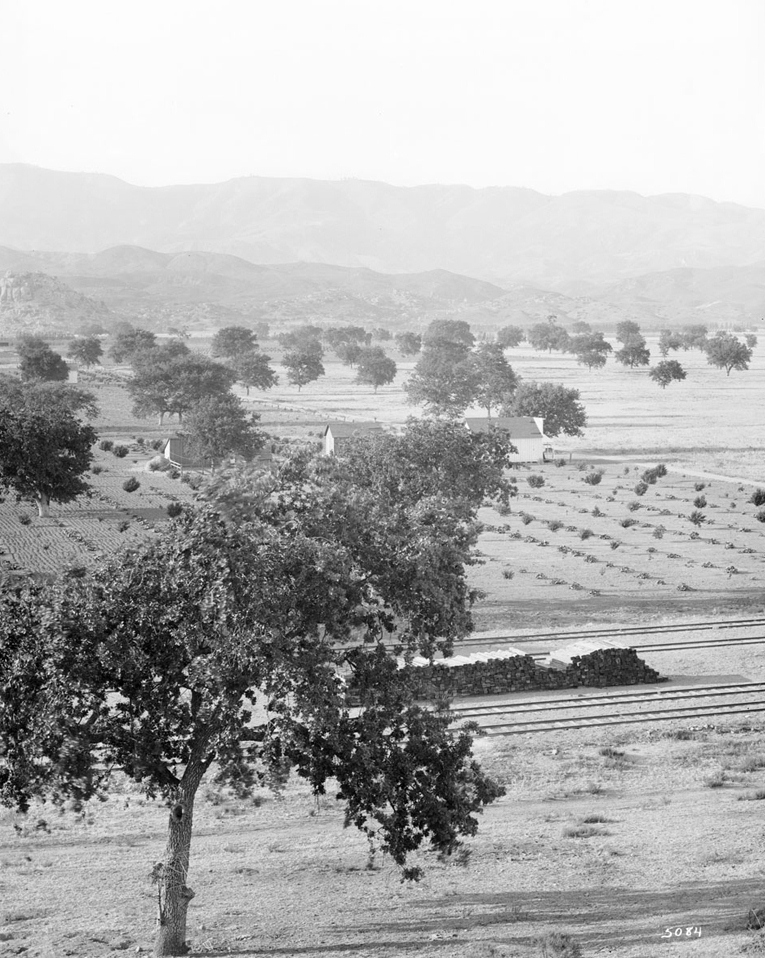 |
|
| (ca. 1890s)^^ - Photograph of Chatsworth Park and its live oak trees, San Fernando Valley. Beyond a lone oak tree in the foreground, piles of wood are stacked between two pairs of railroad tracks. Four buildings are visible in the center of the field. Grids of newly planted and some mature oak trees border the buildings. Mountains are visible beyond the distant rocky hills. |
Historical Notes In the late 1800s the San Fernando Valley was divided into thirteen ranches, seven of which were located in the southern half of the valley and six in the northern half. The Granger Ranch, owned by Benjamin F. Porter, became Chatsworth Park. Click HERE to see more in Early Views of the San Fernando Valley |
* * * * * |
National Soldiers' Home (aka Sawtelle Veterans Home, later VA Medical Center)
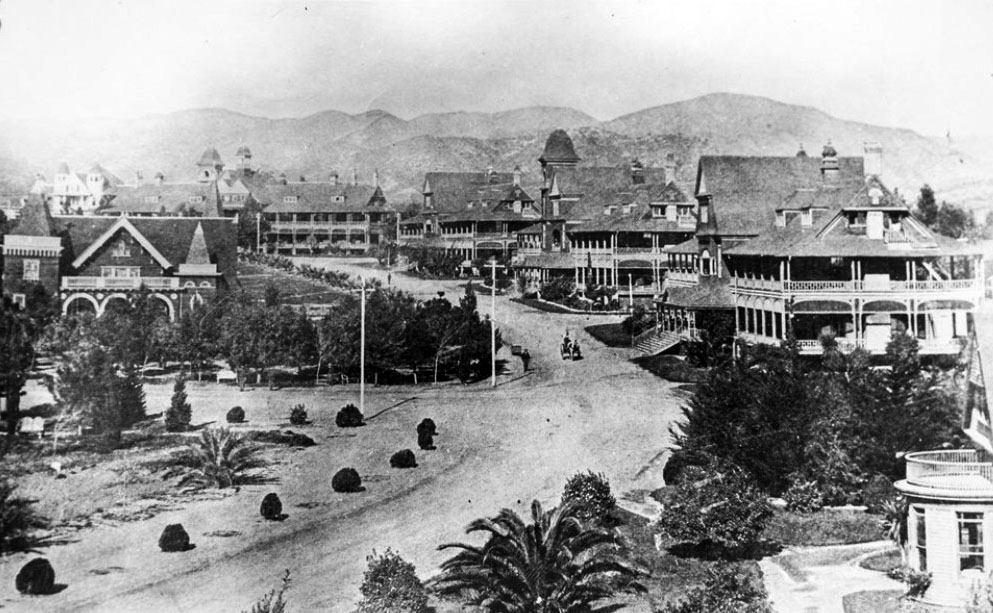 |
|
| (ca. 1892)* - View showing the old National Soldiers' Home (now Veterans Administration Hospital) in the city of Sawtelle (now Los Angeles), and nearby grounds. The Chapel is seen to the left. |
Historical Notes The Old Soldiers Home was built on land donated to the U.S. Government by landholder Arcadia Bandini de Baker in 1887, who specified that it should be used to house wounded veterans. The following year, the site grew by an additional 200 acres; in 1890, 20 acres more were appended for use as a veterans' cemetery. With more than 1,000 veterans in residence, a new hospital was erected in 1900. This hospital was replaced in 1927 by the Wadsworth Hospital. |
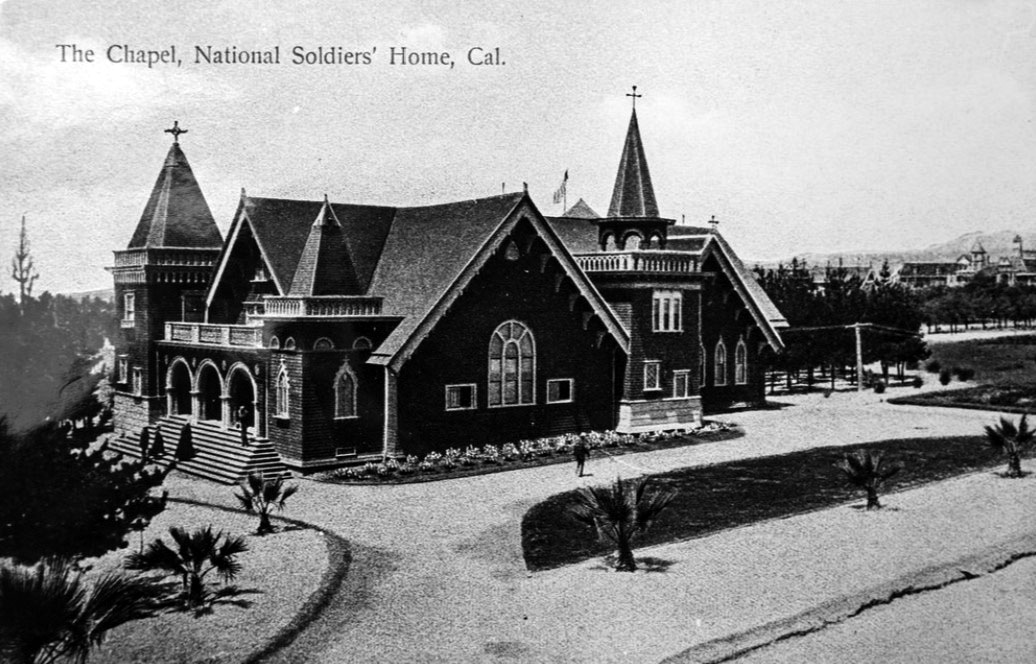 |
|
| (ca. 1900)* - Postcard view showing the Chapel at the Old National Soldiers' Home. |
Historical Notes The chapel seen above was used for religious services, weddings, substance abuse counseling and funeral rites by both veterans and members of the local community until the 1971 earthquake made the building unsafe for use. It is currently deteriorating, although the VA hopes to save it. |
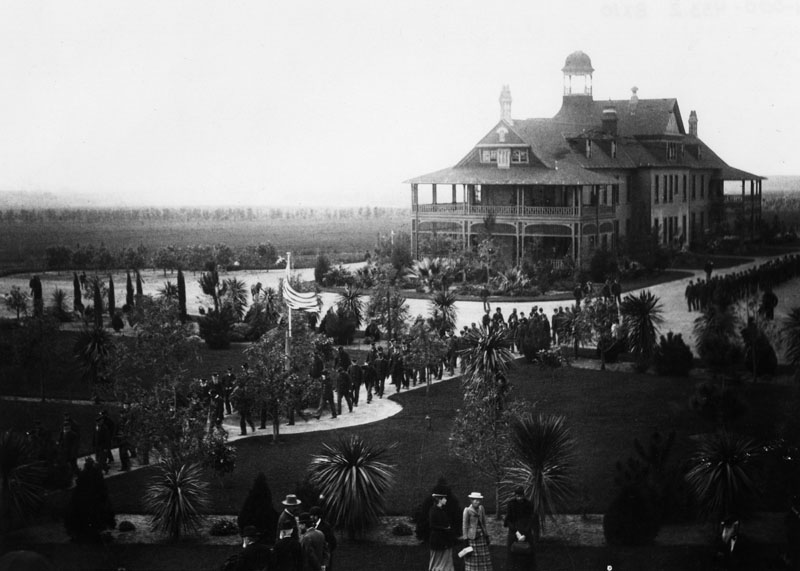 |
|
| (1892)^ - Veterans are seen walking single file in two lines down a pathway next to a flagpole at the Old National Soldiers' Home. |
Historical Notes The National Asylum for Disabled Volunteer Soldiers was established on March 3, 1865, in the United States by Congress to provide care for volunteer soldiers who had been disabled through loss of limb, wounds, disease, or injury during service in the Union forces in the Civil War. Initially, the Asylum, later called the Home, was planned to have three branches: in the northeast, in the central area north of the Ohio River and in what was then still considered the northwest, the present upper Midwest. The Board of Managers, charged with governance of the Home, added seven more branches between 1870 and 1907 as broader eligibility requirements allowed more veterans to apply for admission. |
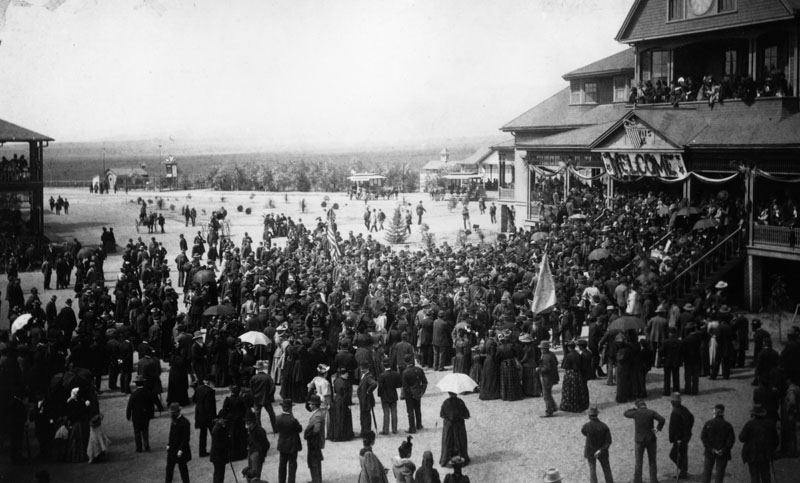 |
|
| (1892)^ - A large crowd gathers to welcome a person or group (?) to the National Soldiers' Home (now Veterans Administration Hospital). |
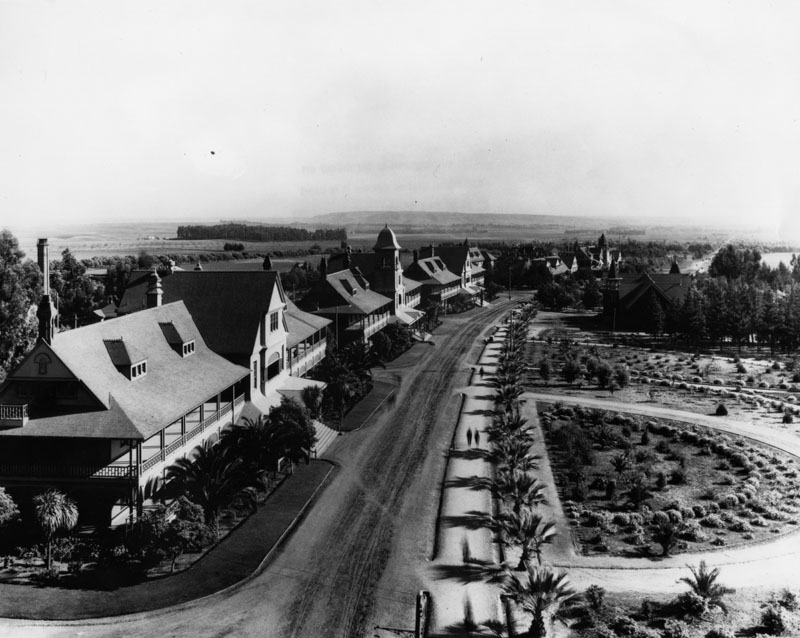 |
|
| (ca. 1890s)^ - View of a street on the grounds of the National Soldiers' Home in Sawtelle (later Los Angeles). In the background can be seen wide open, and still undeveloped land as far as the eye can see. |
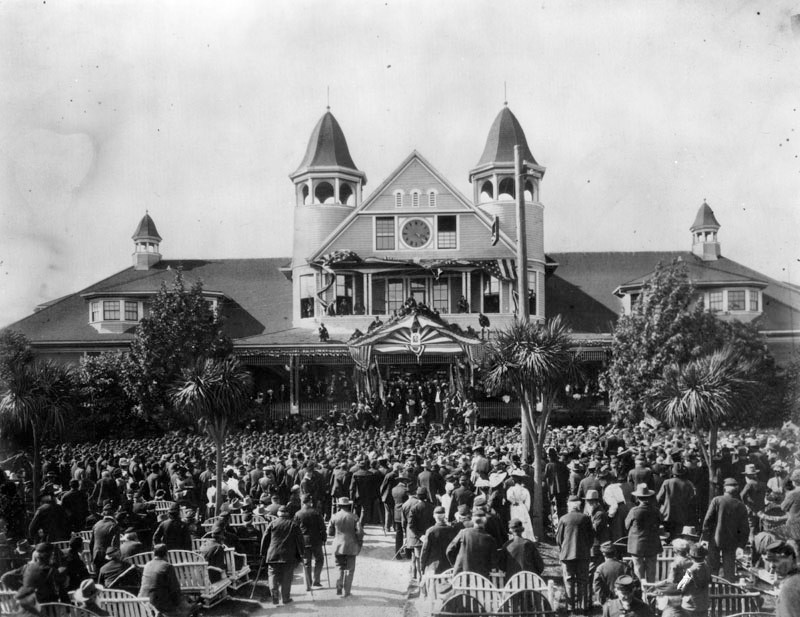 |
|
| (1901)* - President William McKinley can be seen near the entrance of the National Soldiers' Home (now Veterans Administration Hospital) in Sawtelle (Los Angeles). This event marks the Dedication by President McKinley on May 9, 1901. |
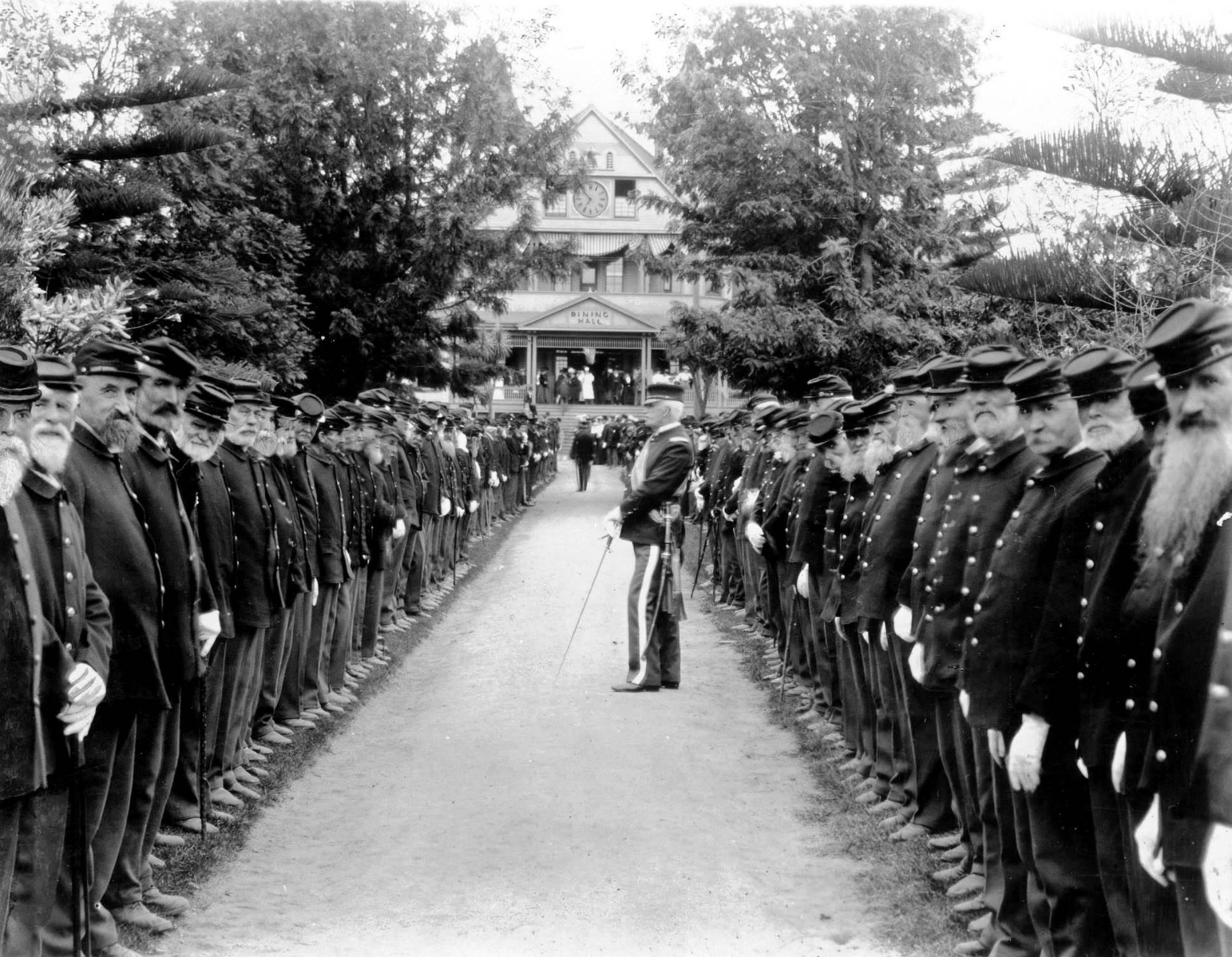 |
|
| (1905)* - Memorial Day Review, Soldiers' Home, Sawtelle. All of them look like veterans of the Civil War. Photo by C. C. Pierce. |
Historical Notes Memorial Day and Veterans Day both honor U.S. military service, but with distinct purposes. Memorial Day, observed in May, commemorates those who died in military service, especially in battle. Veterans Day, celebrated on November 11, honors all who served, both living and deceased, whether during war or peace. While Memorial Day often involves visiting cemeteries, Veterans Day features parades and community events to thank living veterans. Together, these holidays reflect national gratitude for the sacrifices made by military personnel. The National Home and the Veterans Bureau, were combined into the United States Veterans Administration by President Hoover in 1930. Planning began for a major building campaign, including Mission/Spanish Colonial style hospital buildings and a group of Romanesque-inspired research buildings. The present Wadsworth hospital was constructed in the late 1930s. A new theater replaced the former Ward Theater in 1940. Most of the 1890s era buildings were demolished in the 1960s. The Veterans Affairs (VA) hospital building (VA Wadsworth Medical Center) was opened in 1977. |
* * * * * |
Downtown Los Angeles
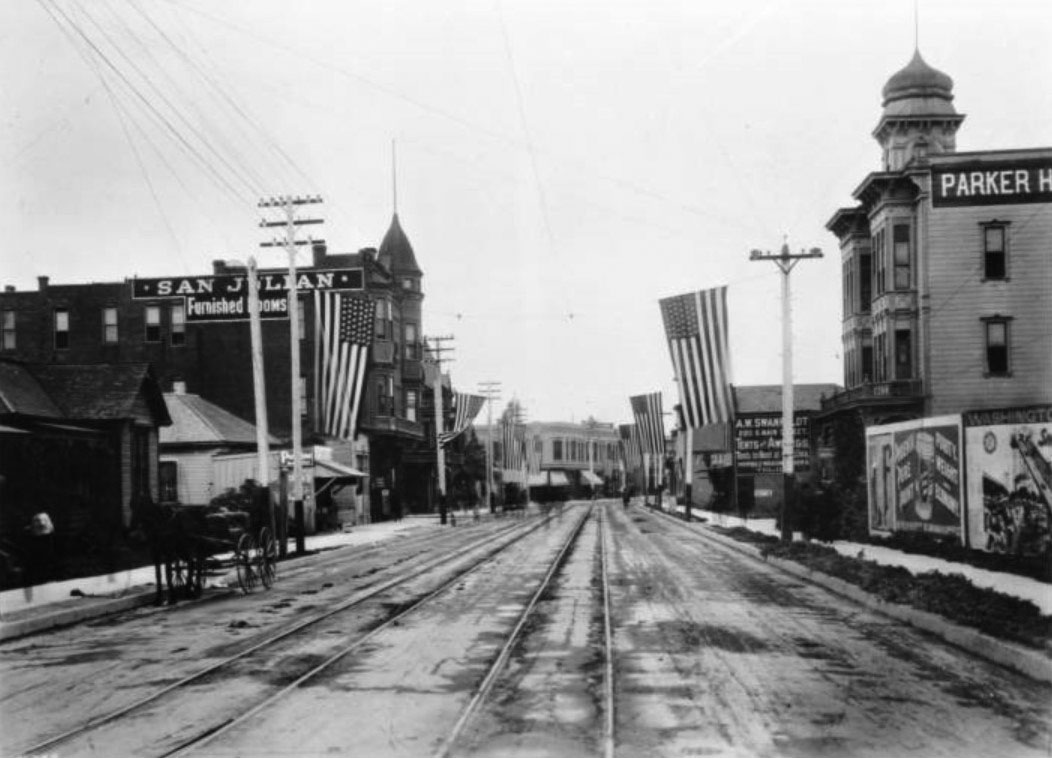 |
|
| (1891)* – View looking west on Fifth Street from Towne Avenue with several large American flags hanging from wires strung across the street. |
Spring and 5th Street
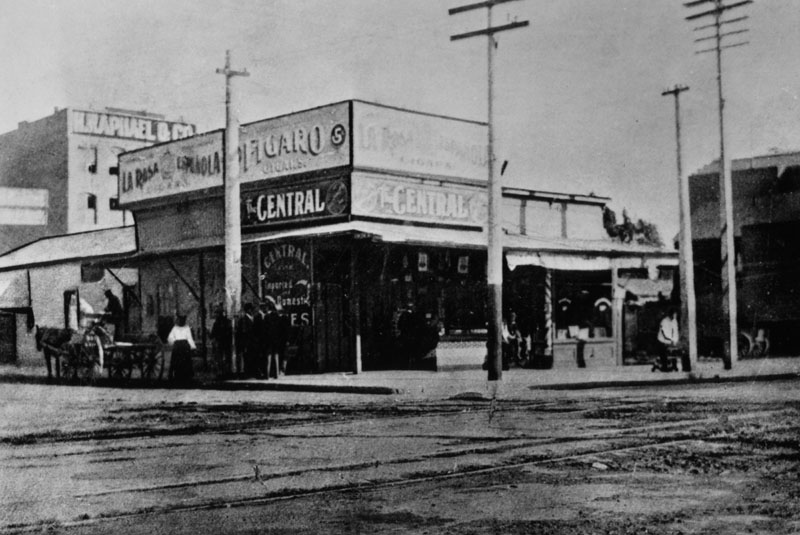 |
|
| (1886)^ - An early picture of the southeast corner of Spring and 5th St. when the building was occupied by Central Saloon. It later became the location of the Security Building. |
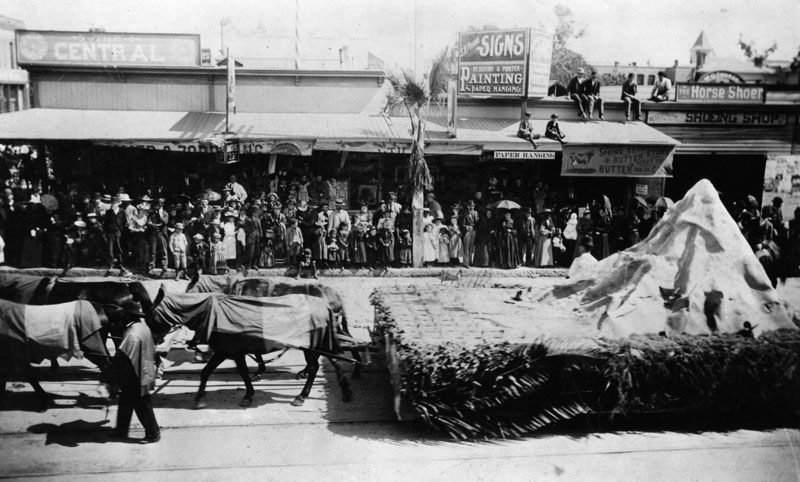 |
|
| (1892)^ - Several mules or horses pull a flatbed past the crowds watching at the southeast corner of Spring and 5th Street. |
Then and Now
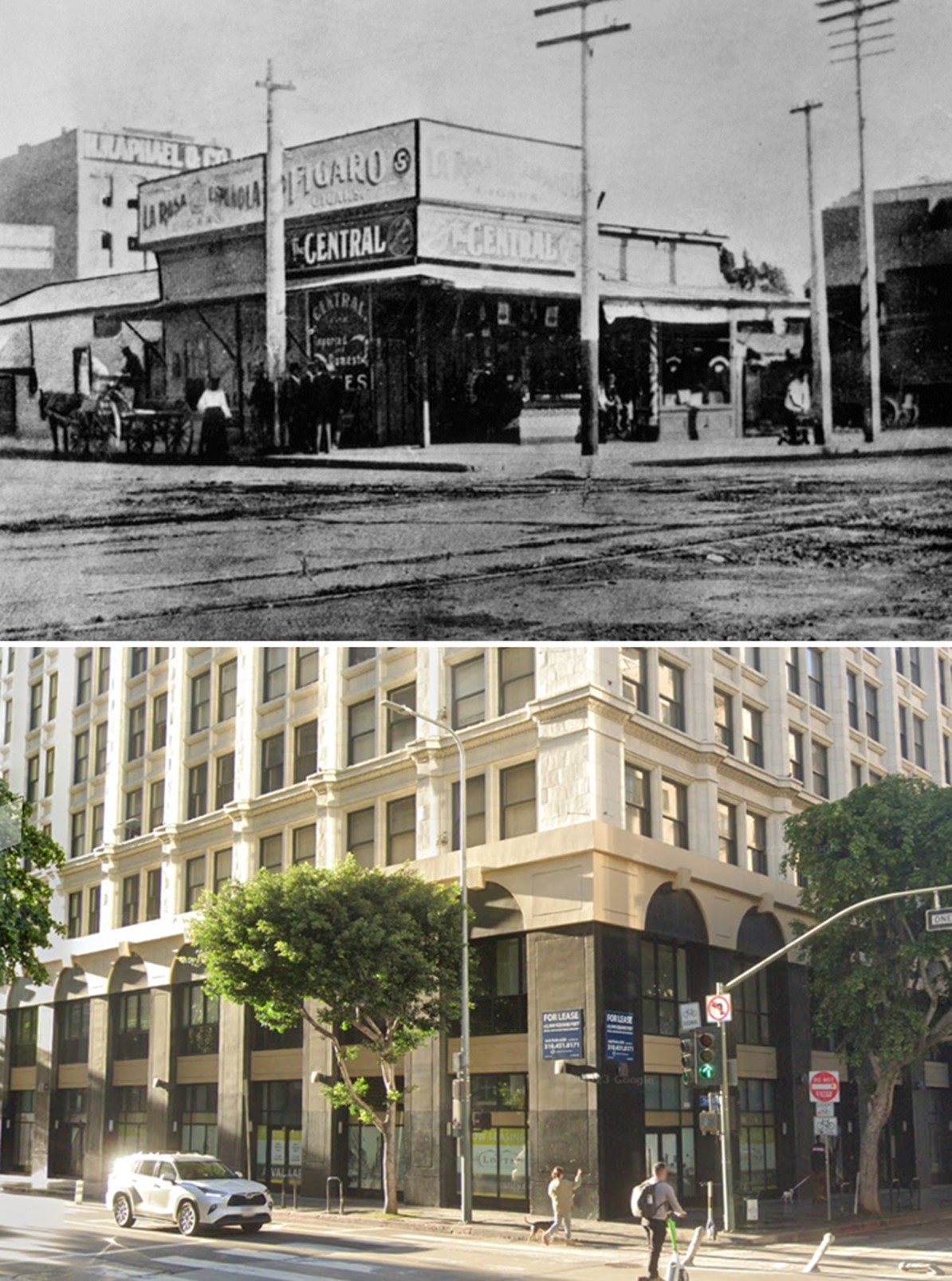 |
|
| (1886 vs 2023)* – Looking at the SE corner of Spring and 5th streets in DTLA showing the Central Saloon, today the site of a mixed-use commerical/residential building. Photo comparison by Jack J. Feldman. |
* * * * * |
Broadway and 5th Street
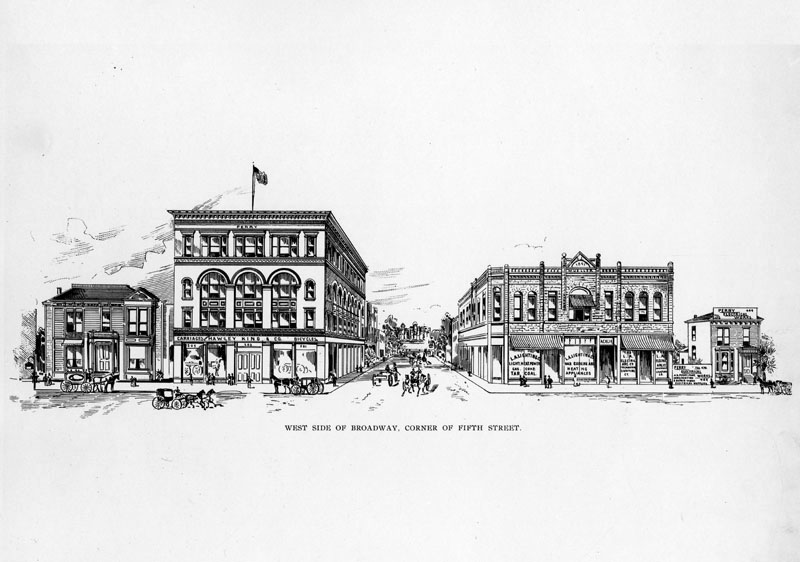 |
|
| (ca. 1880s)^ - A sketch of the west side of Broadway, at 5th Street. Building signs read "Hawley King & Co.", "L.A. Lighting", and "Perry Electrical Works." |
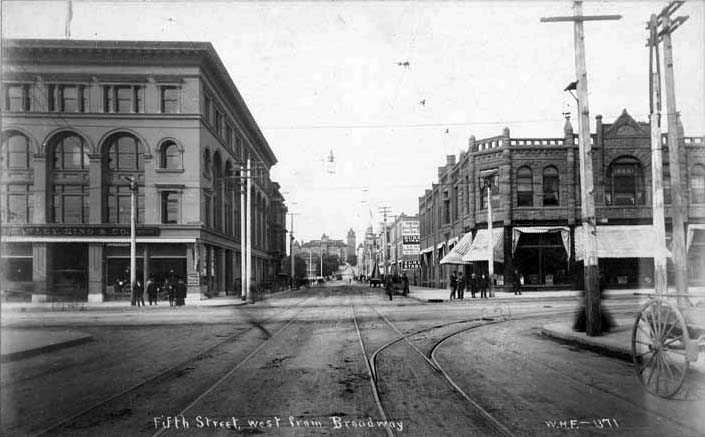 |
|
| (1891)* - View looking west on 5th Street at Broadway. In the distance can be seen the State Normal School located at 5th and Grand. |
Then and Now
.jpg) |
|
| (1891 vs 2021)* - Looking west on 5th Street at Broadway. Photo comparison by Jack J. Feldman. |
Grand and 5th Street
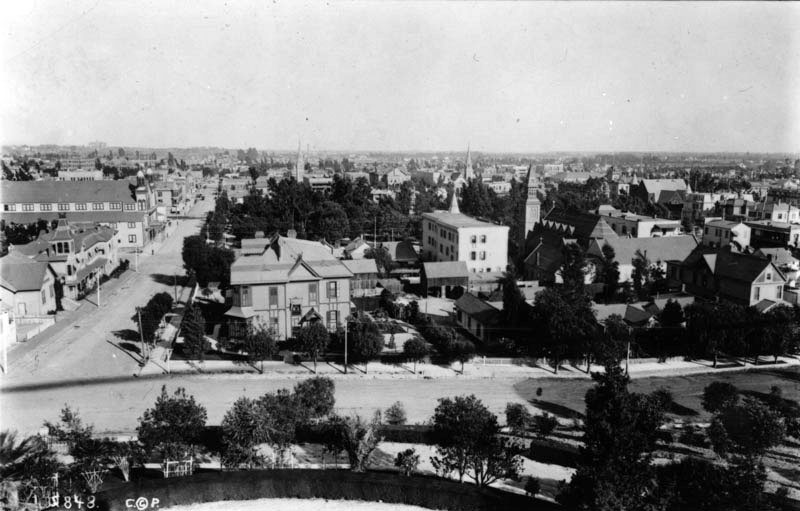 |
|
| (1890)^ - View is seen from the east side of the Normal School. 5th Street is on the left; Grand Avenue is in the foreground. St. Paul's Pro-Cathedra (Episcopal) is on the right-center. Hazard's Pavilion is on the left-center. 6th Street park (later Pershing Square) is in the center. |
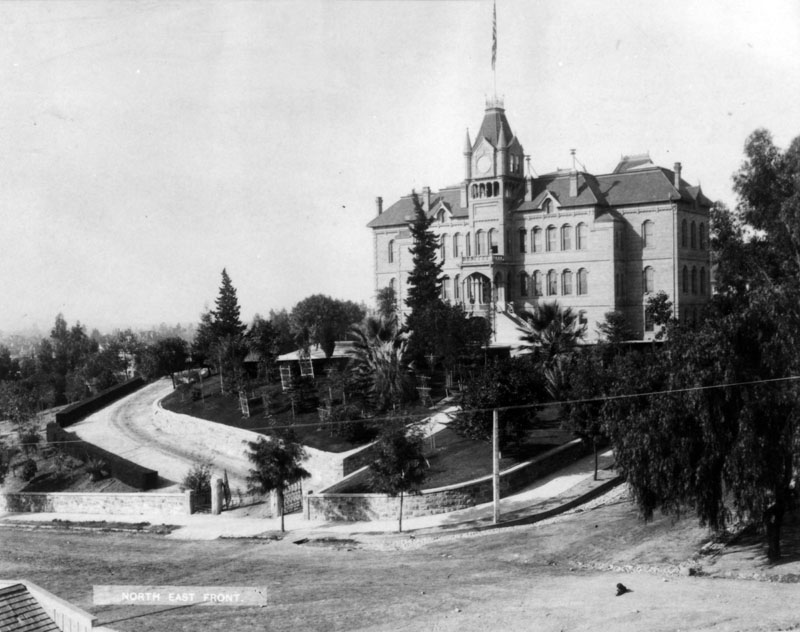 |
|
| (ca. 1893)^ - Southwest corner view of the State Normal School, located at Grand and 5th Street. A long and winding driveway is located on the left side of the entrance, and a long flight of stairs (barely visible) is on the right; the school sits impressively on the last knoll of Bunker Hill, aptly dubbed "Normal Hill". |
Historical Notes In 1880, with a population of 11,000, Los Angeles was a gas-lit pueblo trying to convince the state to establish in Southern California a second State Normal School, like the one already existing in San Jose, some 300 miles to the north. In March of the following year, the State Assembly approved the establishment of such a school. A group of enthusiastic citizens, over 200 of whom contributed between $2 and $500, purchased a site less than a mile from the business section. Soon the towering Victorian form of the school rose from an orange grove that, today, is the site of the Central Los Angeles Public Library.^ UCLA's roots are intertwined with that of the State Normal School. Click HERE to see the connection in Early Views of UCLA. |
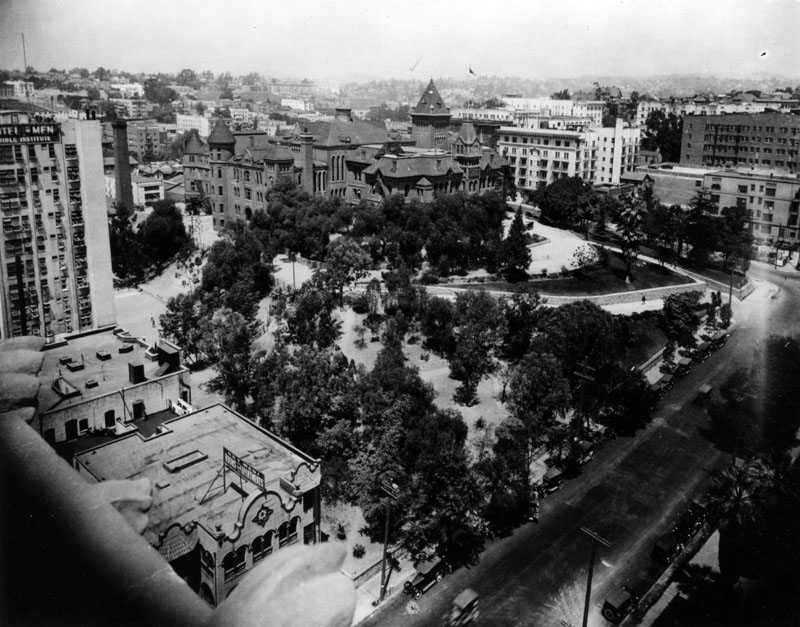 |
|
| (ca. 1913)^ - Aerial view of the State Normal School, located at Grand Avenue and 5th Street. Because the school sat impressively on the last knoll of Bunker Hill, aptly dubbed "Normal Hill", there were two ways to get to the main entrance: either taking the long and winding driveway located on the left side, or a long flight of stairs on the right (partially covered by the trees), which was parallel to 5th Street. The large white building on the middle left is the Bible Institute, later to become the Church of the Open Door/Biola Institute, that was located on Hope Street; the Key West Rooms and Apartments is visible on the lower left. |
Historical Notes After the demolition of this structure (1924), 5th Street was straightened and the remainder of the site was eventually occupied by the L.A. Public Library. Click HERE to see Construction of the Central Libary. |
* * * * * |
Hill and 2nd Street
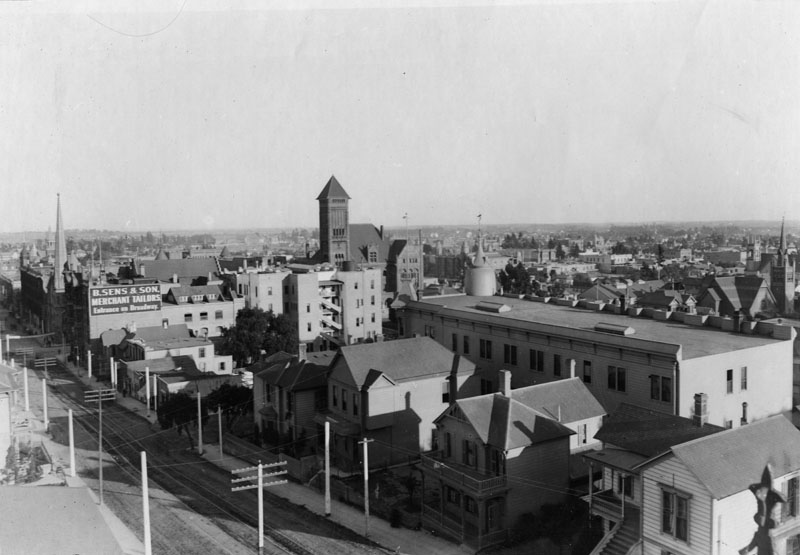 |
|
| (ca. 1892)^ - View showing 2nd and Hill Streets (at lower-left) looking east from near Olive Street. Mostly a residential area, there are a few commercial buildings, including one housing O.C. Sens, merchant tailors, entrance on Broadway. The 1888 City Hall at 226 So. Broadway is seen at center. The First Presbyterian Church with its impressively tall spire stands at left on the southeast corner of 2nd Street and Broadway. |
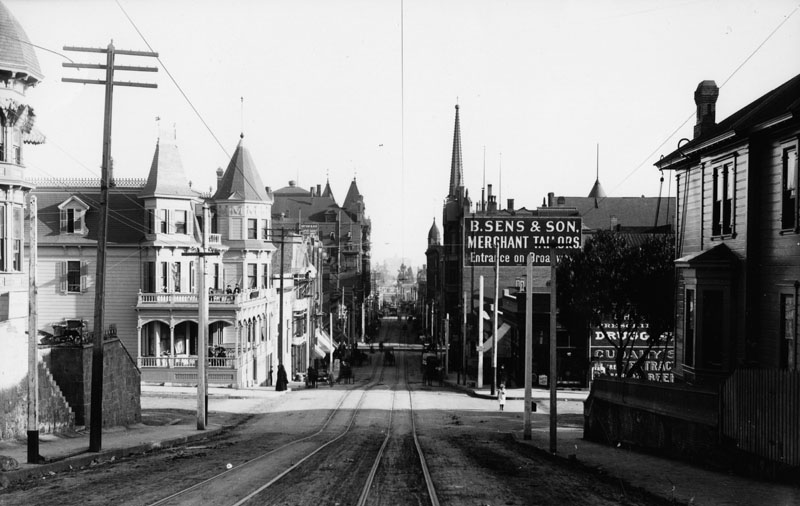 |
|
| (1894)^ - View showing an unpaved 2nd Street looking east from Hill Street. Utility poles and streetcar tracks face a mix of residential and commercial buildings. People relax on wide verandas in the Queen Anne Revival building on the northeast corner across from B. Sens & Son, merchant tailors, who advertise their "Entrance on Broadway." Pedestrians, deliveries and horse and buggy traffic make for a busy street. The First Presbyterian Church with its tall spire can be seen in the distance on the SE corner of Broadway and 2nd Street. |
Then and Now
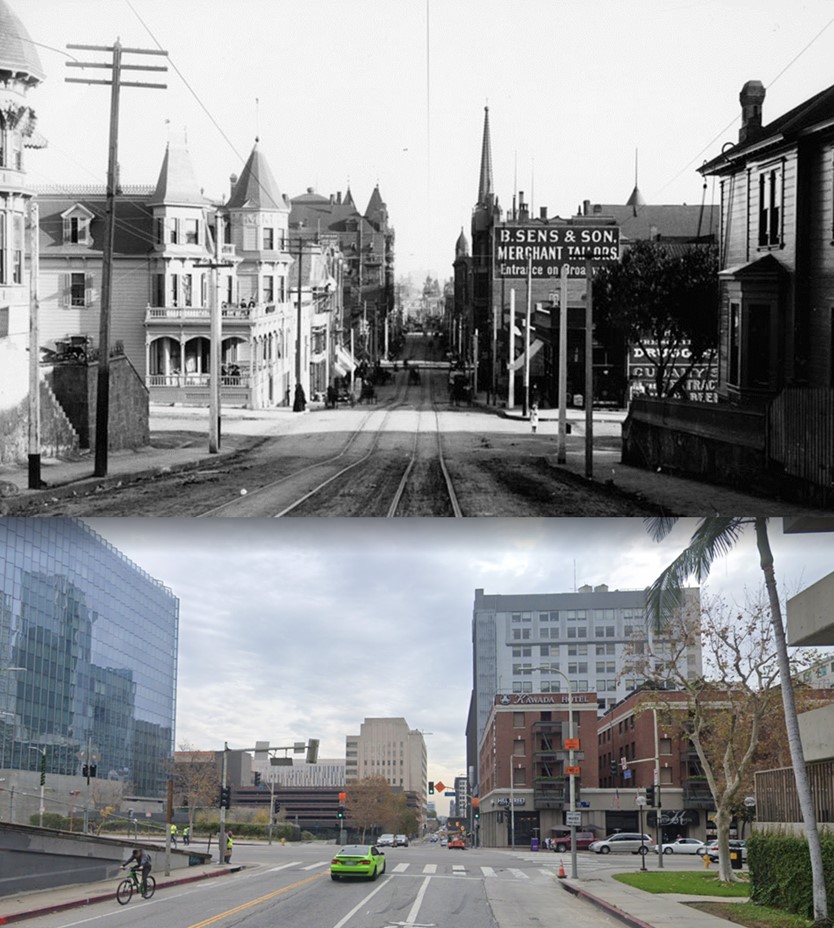 |
|
| (1894 vs 2021)* - Looking east on 2nd Street toward Hill Street. Photo comparison by Jack J. Feldman. |
 |
|
| (ca. 1910)* – Looking at Los Angeles Fire Department's Engine Co. No. 3 on the west side of Hill Street, just south of 2nd Street. A three-horse-drawn steam pumper stands in front of the station. In the background, the Victorian-style Locke Hotel & Annex sits atop the hill at the northwest corner of 2nd and Hill Streets. Note the beautiful A 5-globe streetlight in front of the station. It was called a 'Winslow' Llewellyn Electrolier. |
Historical Notes The file card for the above photo reads: Photo of Joaquin "Louis" Constantine seated on Los Angeles Fire Department's Engine Co. No.3, a 1907 Metropolitan 1,000 GPM Steam Pumper and the largest of its day. Photo circa 1910. The Los Angeles Fire Department's Engine Company No. 3 has a rich history dating back to its establishment in 1887. Initially located at Main and First Streets, the company moved several times, reflecting the city's rapid growth and evolving firefighting needs. By 1910, Engine Company No. 3 operated out of a station on South Hill Street and was equipped with advanced apparatus for the time, including a 1907 Metropolitan 1,000 GPM steam pumper, one of the largest of its era. In 1910, the LAFD was transitioning into a modernized force. The department had recently annexed areas like San Pedro and Hollywood, incorporating volunteer firefighters and motorized equipment. Engine Company No. 3 played a critical role during notable incidents that year, including responding to the devastating Los Angeles Times bombing on October 1, which caused significant casualties and destruction. |
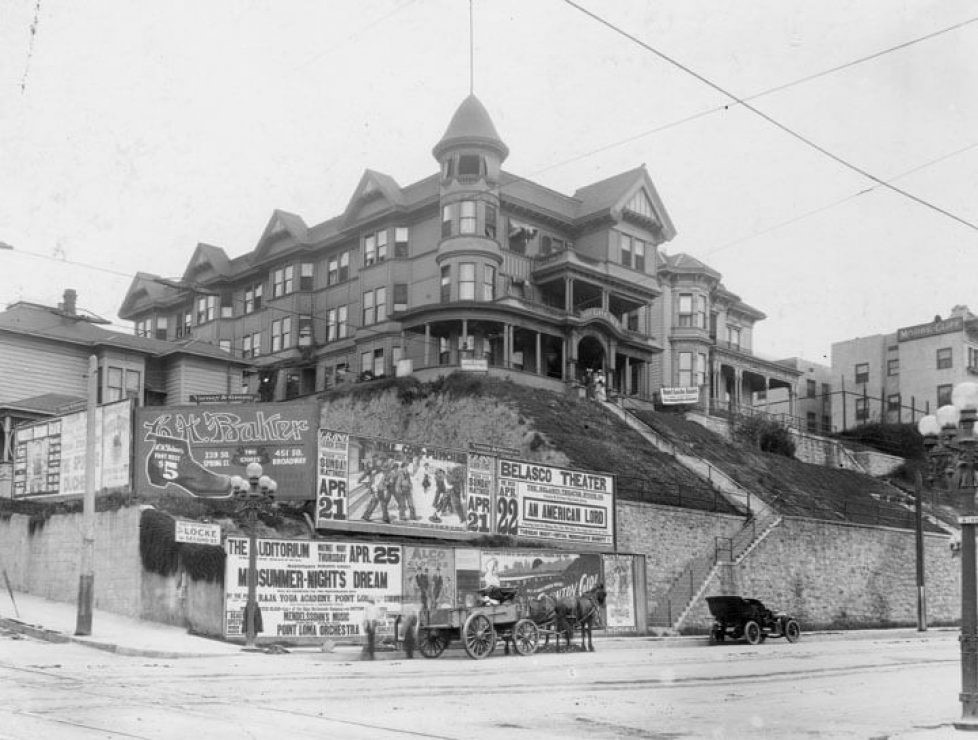 |
|
| (1906)* - The Locke Hotel & Annex sit up on the hill on the NW corner of 2nd and Hill streets while advertising placards are pasted all over the wall at street level. Adds for "Midsummer nights dream" at the Auditorium, "An American lord" at the Belasco Theater, "G.H. Baker" shoes stories, etc. |
Historical Notes In the early 1900s, the Locke Hotel and Annex stood prominently on the northwest corner of Hill and 2nd Streets in downtown Los Angeles, atop Bunker Hill. Located at 139 S. Hill Street, the hotel overlooked 2nd Street as it climbed Bunker Hill, with Hill Street extending toward the 1st Street tunnels. This bustling area was a vibrant part of the city's Victorian-era development, featuring horse-drawn wagons, electric streetcars, and pedestrians navigating the steep streets, with the Locke Hotel and its annex representing the architectural and cultural growth of Los Angeles during its transition into a major urban center. |
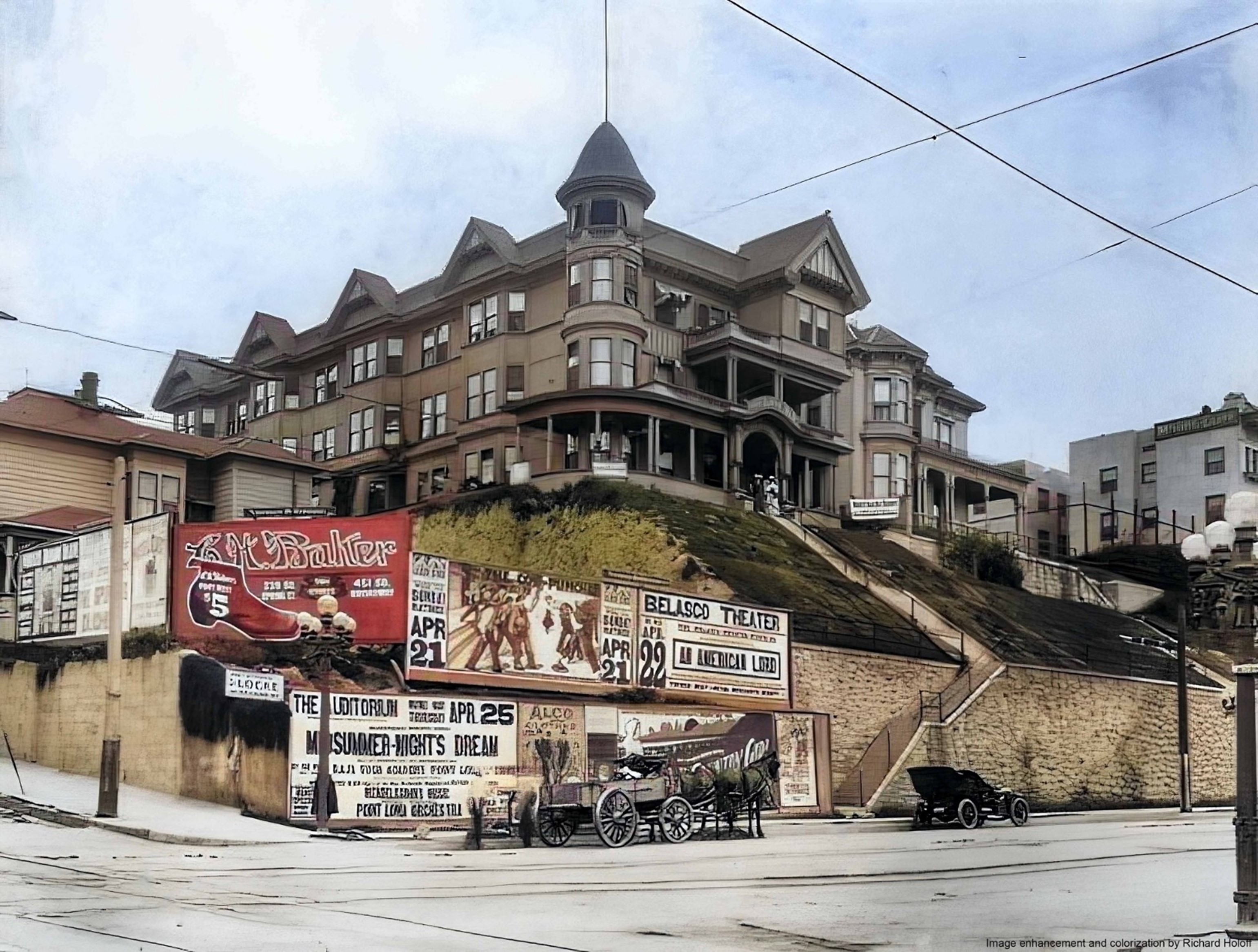 |
|
| (1906)* - The Locke Hotel & Annex sit up on the hill on the NW corner of 2nd and Hill streets while advertising placards are pasted all over the wall at street level. Adds for "Midsummer nights dream" at the Auditorium, "An American lord" at the Belasco Theater, "G.H. Baker" shoes stories, etc. Image enhancement and colorization by Richard Holoff. |
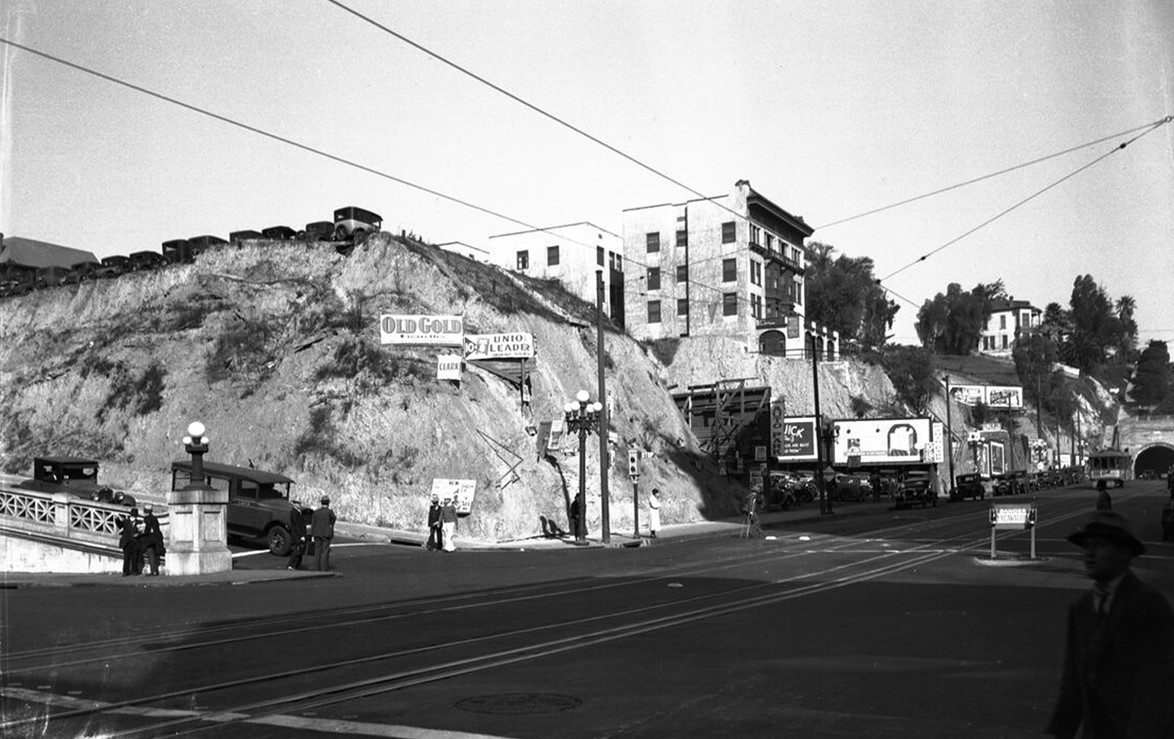 |
|
| (1932)* – Looking north on Hill Street at 2nd Street showing cars parked on the hill where the Locke Hotel once stood. The 4-story building in the center of the photo is the Moore Cliff Apartments. In the distance on the right is the Hill Street Tunnel. |
Historical Notes The Locke Hotel and Annex had its time and place but has been gone for over 100 years—I believe since 1924. The site was a parking lot both before and after the hill seen above was removed." |
 |
|
| (2023)* – Contemporary view of the northwest corner of Hill and 2nd Streets, now a parking lot where the Locke Hotel and Annex once stood. |
Historical Notes As of early 2025, construction has begun at the above site on an expansion of the Colburn School of Music & Dance, designed by architect Frank Gehry. Gehry, known for the Disney Concert Hall and The Grand LA, continues to shape Bunker Hill’s skyline, further cementing its status as an architectural landmark in Los Angeles. The Locke Hotel and Annex had its time and place but has been gone for over 100 years—I believe since 1924. |
Then and Now
 |
|
| (1906 vs. 2023)* – A ‘Then and Now’ comparison of the Locke Hotel and Annex at the northwest corner of Hill and 2nd Streets in Downtown Los Angeles, now the site of a parking lot. Photo comparison by Jack J. Feldman. |
Then and Now
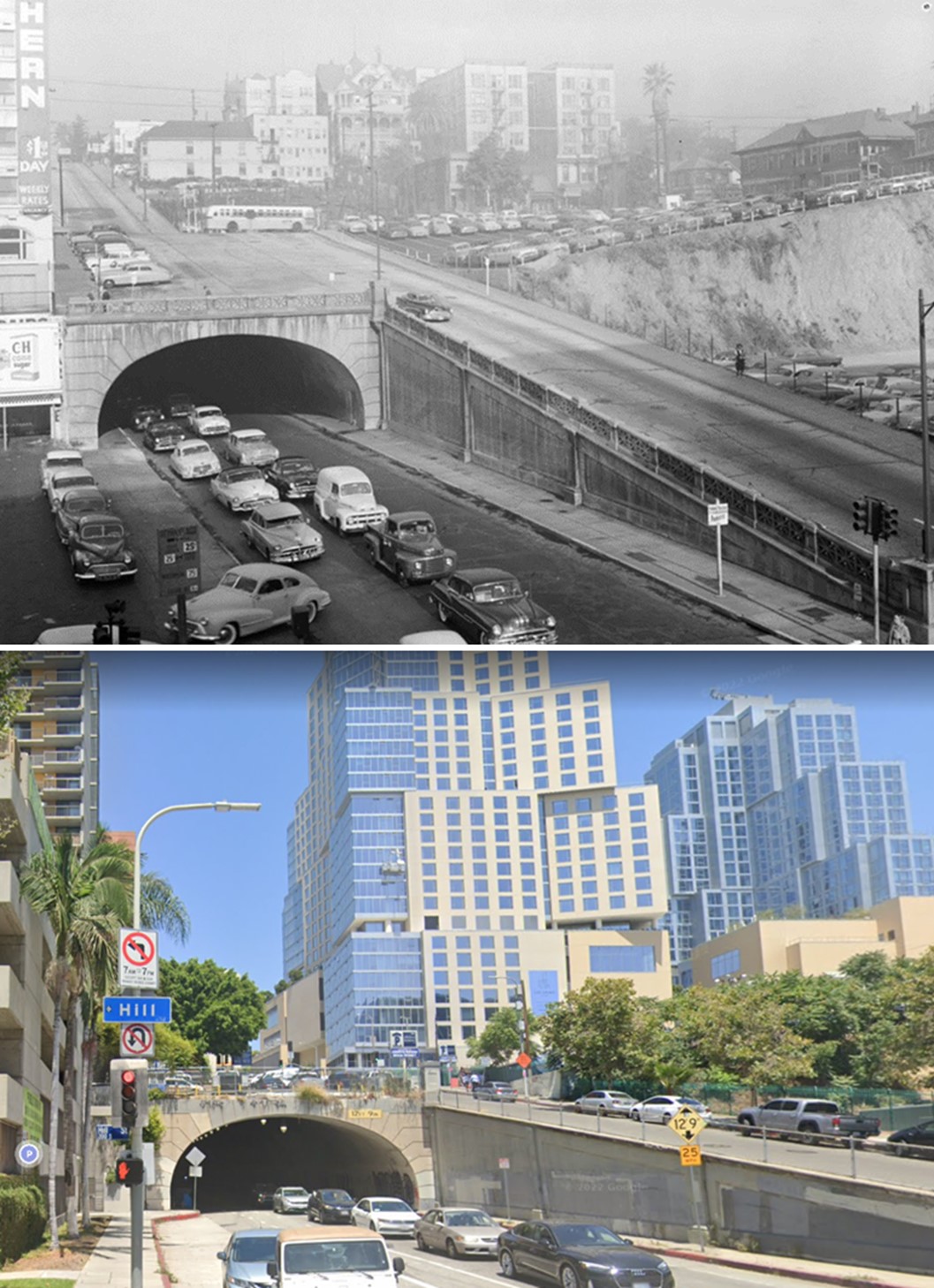 |
|
| (1950s vs 2022)* - Looking west on 2nd Street from Hill Street towards the Second Street Tunnel and Bunker Hill. Photo comparison by Jack J. Feldman. |
* * * * * |
Broadway (Downtown LA)
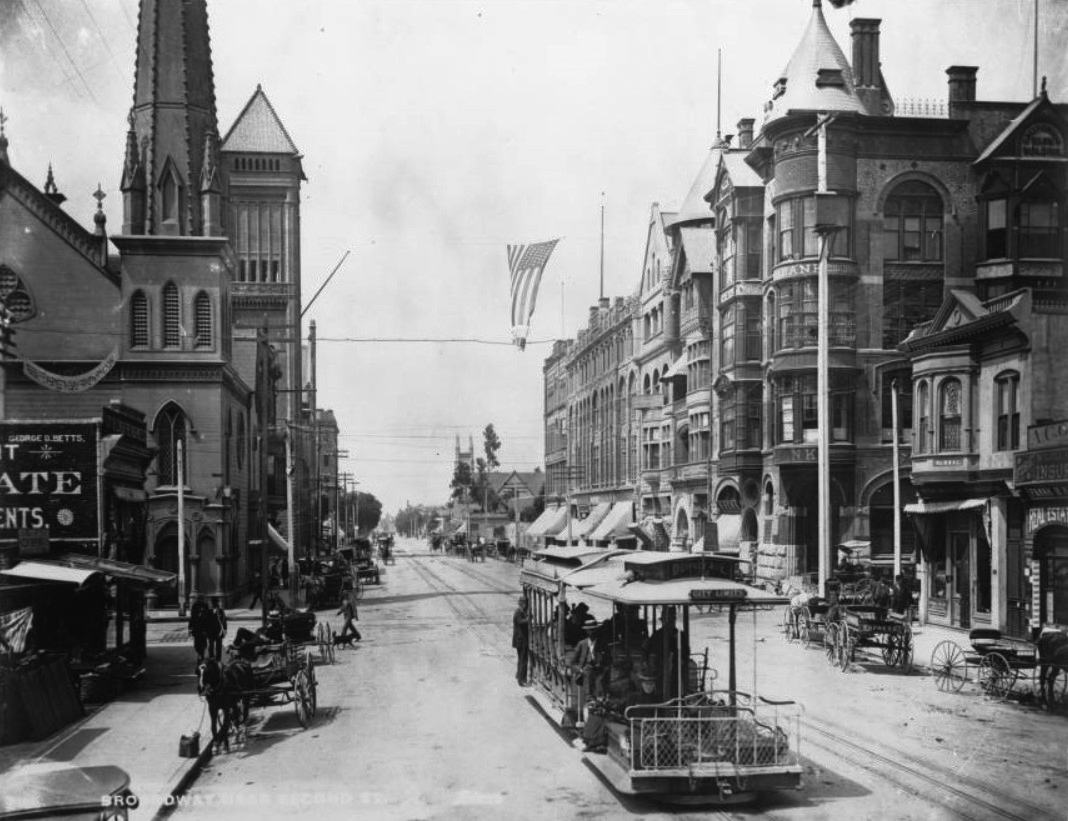 |
|
| (ca. 1893)* – View looking south on Broadway showing the First Presbyterian Church on the southeast corner of Second Street and Broadway (left) with City Hall several lots behind it. The California Bank Building stands on the southwest corner on the right. |
Historical Notes Three main cable car companies operated in Los Angeles between 1885 and 1902: a) Second Street Cable Railroad (1885-1889): It ran along Second Street, up Bunker Hill, to Second and Texas (now Belmont) Street. b) Temple Street Cable Railway (1886-1902): This line extended 8,725 feet between Spring Street and Belmont Avenue. c) Los Angeles Cable Railway (1889-1902): The most ambitious system, it operated about 25 miles of routes, connecting downtown Los Angeles to areas now known as Lincoln Heights, Echo Park/Filipinotown, and the Pico-Union district. The cable car seen in the above image belonged to the Los Angeles cable Railway. The Downey Avenue line, now known as North Broadway, was a key route that connected various parts of Los Angeles. It extended from Ninth and Grand View, through Ninth, Figueroa, Sixth, Hill, Fourth, Broadway, First, Spring, Marchessault, Main, San Fernando, Olympia, Downey (N. Broadway), Chestnut (now Avenue 20), Pasadena, Daily, to Avenue 33. |
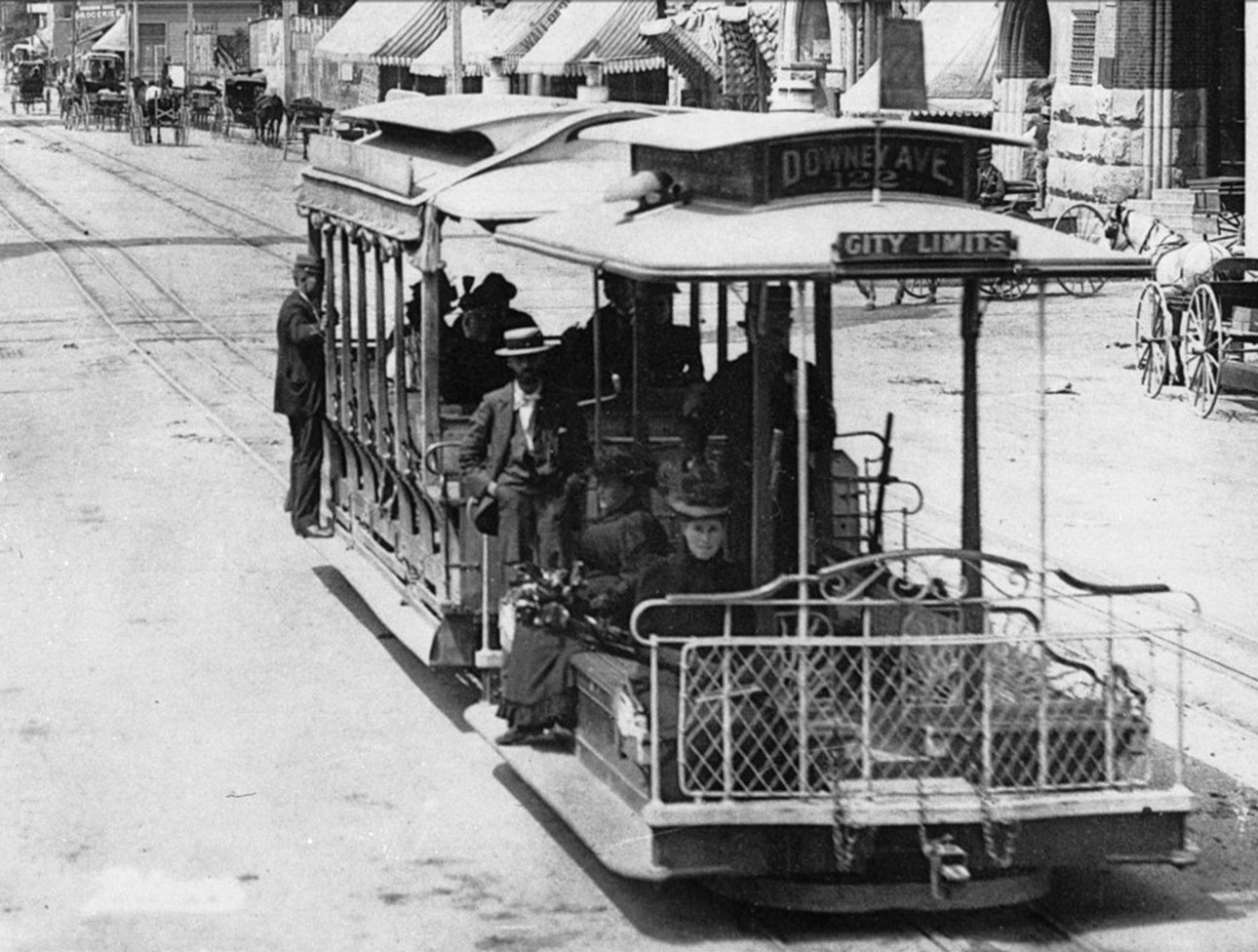 |
|
| (1889)* – Close-up view of previous photo showing a cable car heading north on Broadway at 2nd Street. |
Historical Notes Cable cars soon became obsolete after engineers perfected an newer streetcar technology: the electric railway. Whereas cable railways constantly ran their engines at full power—regardless of how many cars were active on the line—to pull the heavy steel cables, the newer railways delivered electricity directly to motors located on the streetcars themselves. Cables lasted only a few years before needing replacement and were costly to bury; overhead catenary wires were inexpensive by comparison. By 1896, much of the city's cable car trackage had been converted to electricity and incorporated into a growing electric railway network. In 1902, a mere 16 years after the city hailed its first cable railway as a technological wonder, the last of L.A.'s cable cars rolled down Temple Street and into obscurity.* |
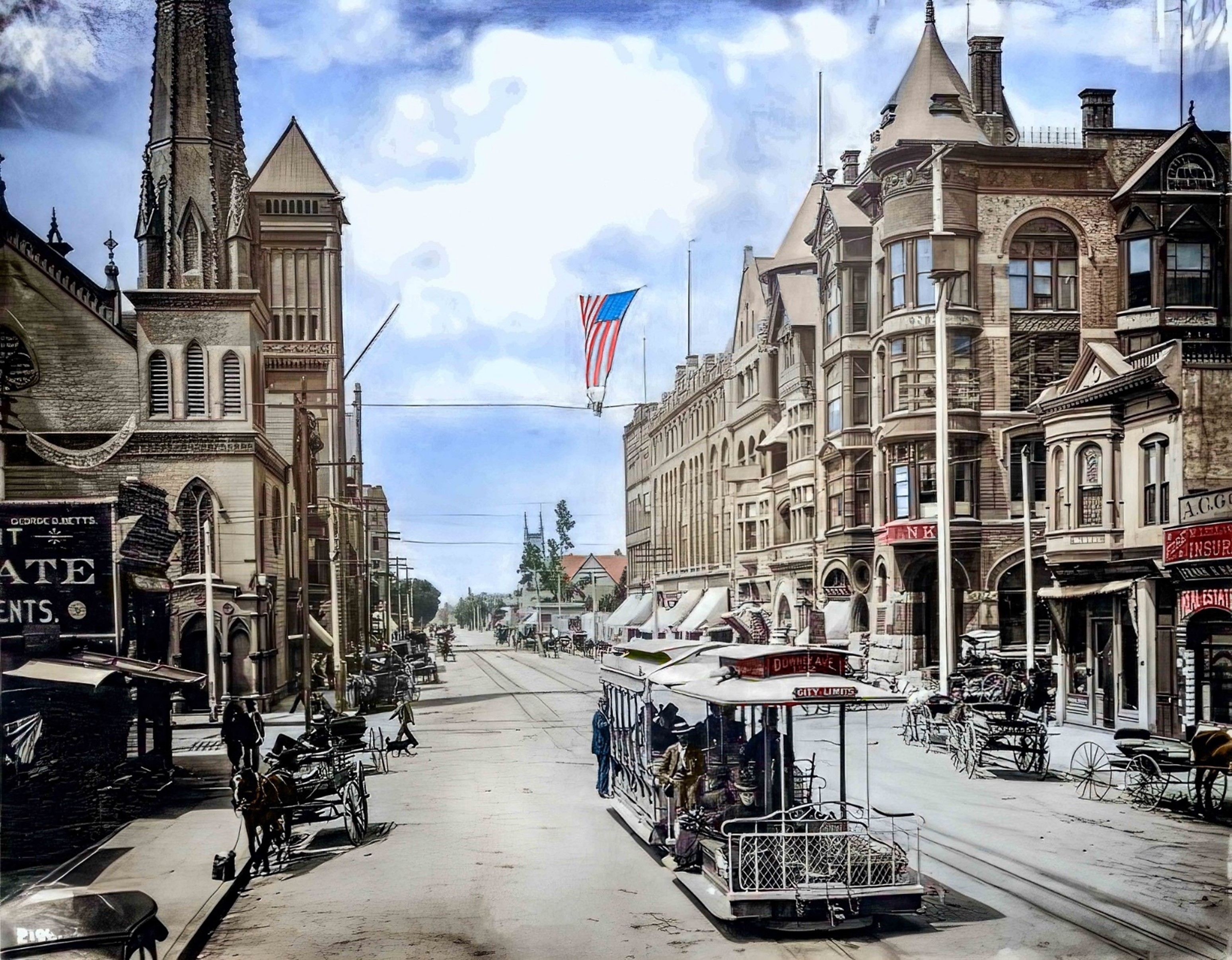 |
|
| (1889)* – View looking south toward the intersection of Broadway and 2nd Street showing a cable car full of passengers in the foreground. Horse-drawn vehicles are parked along the curb on both sides of the street. On the SE corner (left) stands the First Presbyterian Church with the 1888-built City Hall situated further south at 226 S. Broadway. To the right, on the SW corner, is the California Bank Building. In the distance can be seen Fort Street Methodist Episcopal Church, located on the west side of Broadway between 3rd and 4th streets. Note: Broadway was known as 'Fort Street' until 1890. Photo by Charles C. Pierce; Image enhancement and colorization by Richard Holoff. |
Then and Now
.jpg) |
|
| (1889 vs 2022)* - Looking south on Broadway at 2nd Street. Photo comparison by Jack J. Feldman. |
Historical Notes Click HERE to see more Early Views of the intersection of Broadway and 2nd Street in the 1880s. |
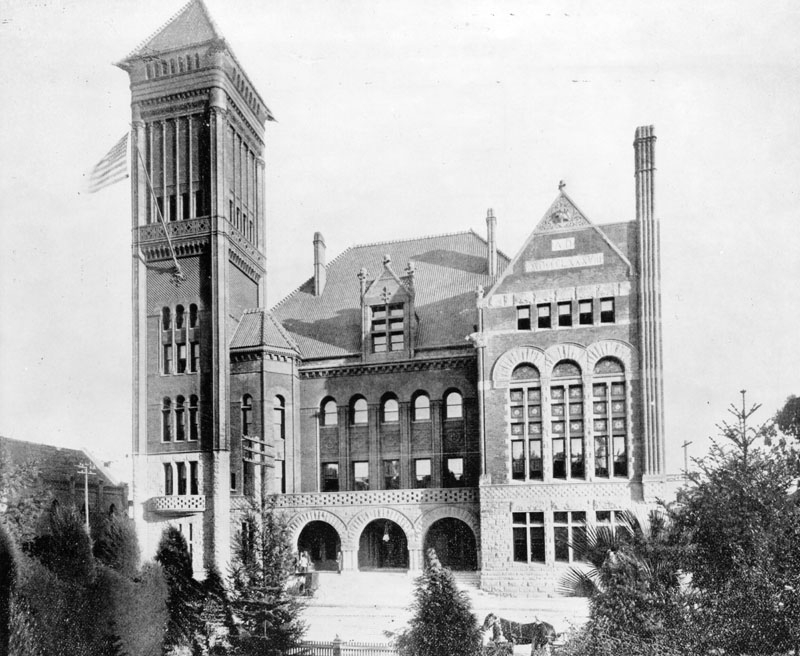 |
|
| (ca. 1889)^ - Exterior view of the Old City Hall, located at 226 Broadway. This was Los Angeles' third City Hall. |
Historical Notes Los Angeles’ third City Hall was erected in 1888 at 226-238 South Broadway. This grand Romanesque edifice of marble and red sandstone building stood for 40 years until 1928 when the present day City Hall was completed. |
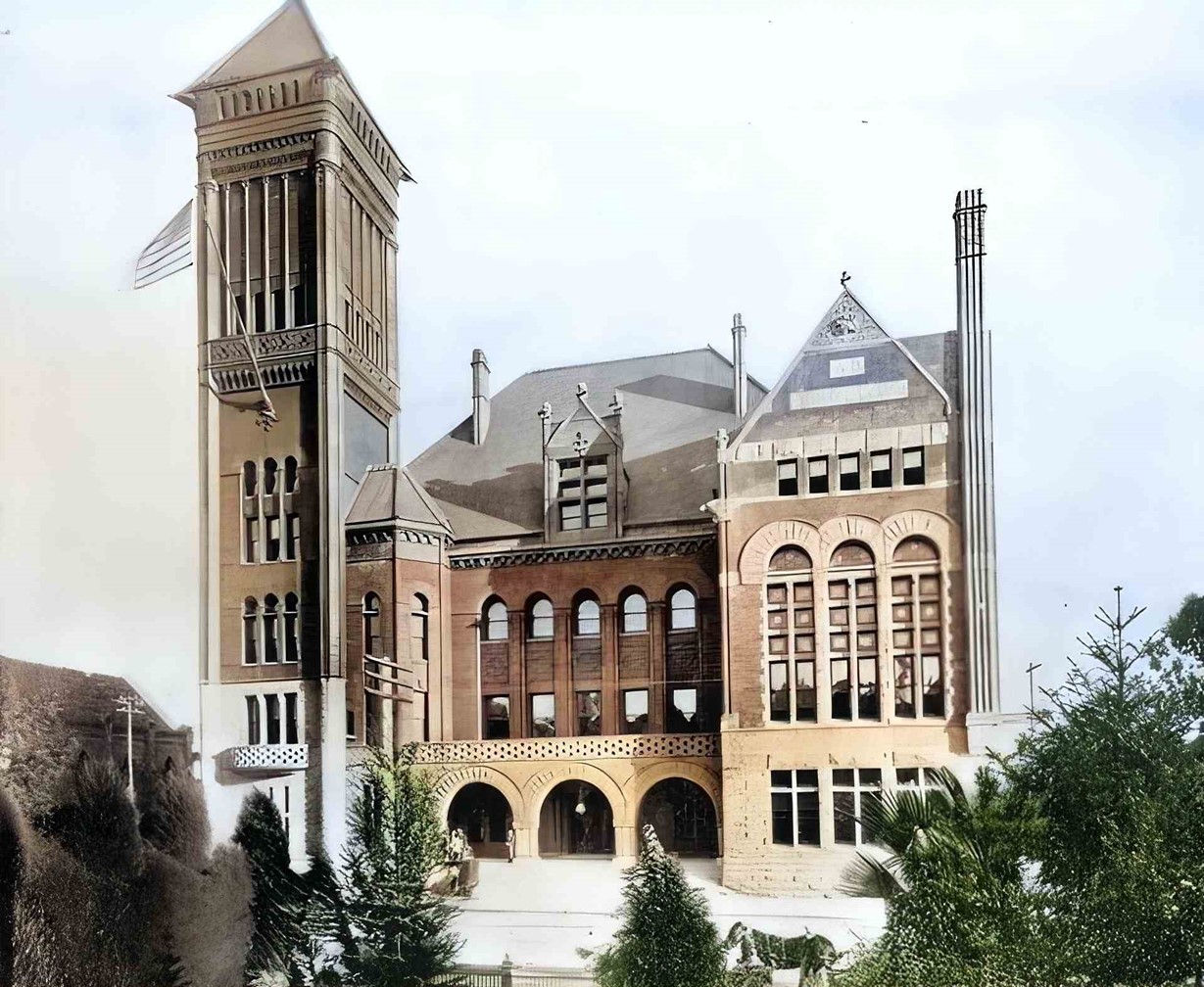 |
|
| (ca. 1889)* - Los Angeles City Hall from 1888 until 1928, located at 226 Broadway. AI image enhancement and colorization by Richard Holoff |
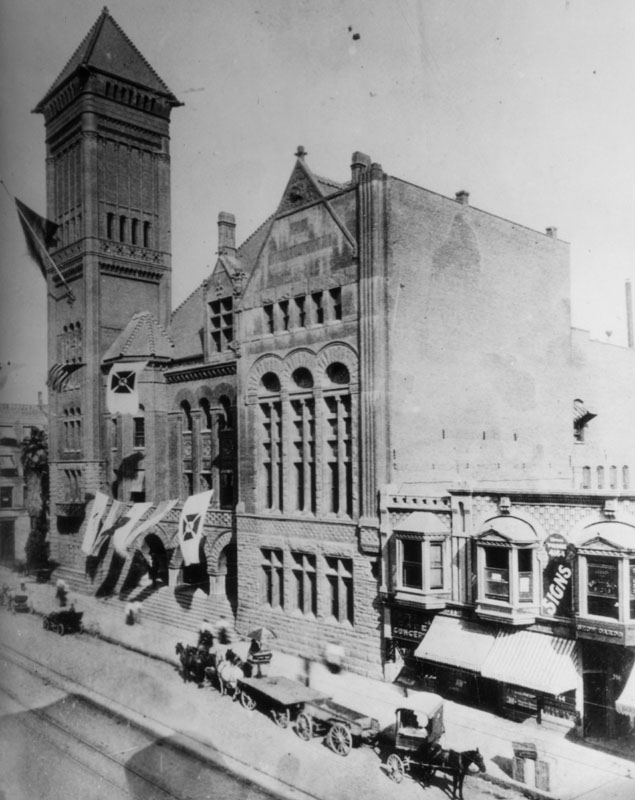 |
|
| (1895)^ - Exterior view of the third City Hall, built in 1888, adorned with banners. Horse-drawn wagons are parked in front. |
Historical Notes The following historical timeline lists the buildings used by City Council, also known as City Hall, since 1850, when Los Angeles was incorporated as a municipality: ◆ 1850 - 1853 - used rented hotel and other buildings for City meetings ◆ 1853 - rented adobe house (aka Rocha Adobe) on Spring Street - across from current City Hall (now parking lot for Clara Shortridge Foltz Criminal Justice Center). The buliding was shared with the County who used it as a Court House. ◆ 1861 - moved into John Temple's Clocktower Market Building, but only stayed for less than a year before the County Court House moved-in ◆ 1861 - 1884 - relocated back to the Rocha Adobe and stayed for over 20 years ◆ 1884 - 1888 - moved to new City Hall Building at South Spring Street and West 2nd Street (site of current Los Angeles Times Building) ◆ 1888 - 1928 - moved to new Romanesque Revival Building on 226-238 South Broadway between 2nd Street and 3rd Street; demolished in 1928 and now site of parking lot between LA Times Parking structure and 240 Broadway. ◆ 1928 - moved to current City Hall Building |
.jpg) |
|
| (1895)^ - The view looking south on Broadway from 2nd Street. City Hall tower can be seen on the left. The California Bank Building is at right on the SW corner. |
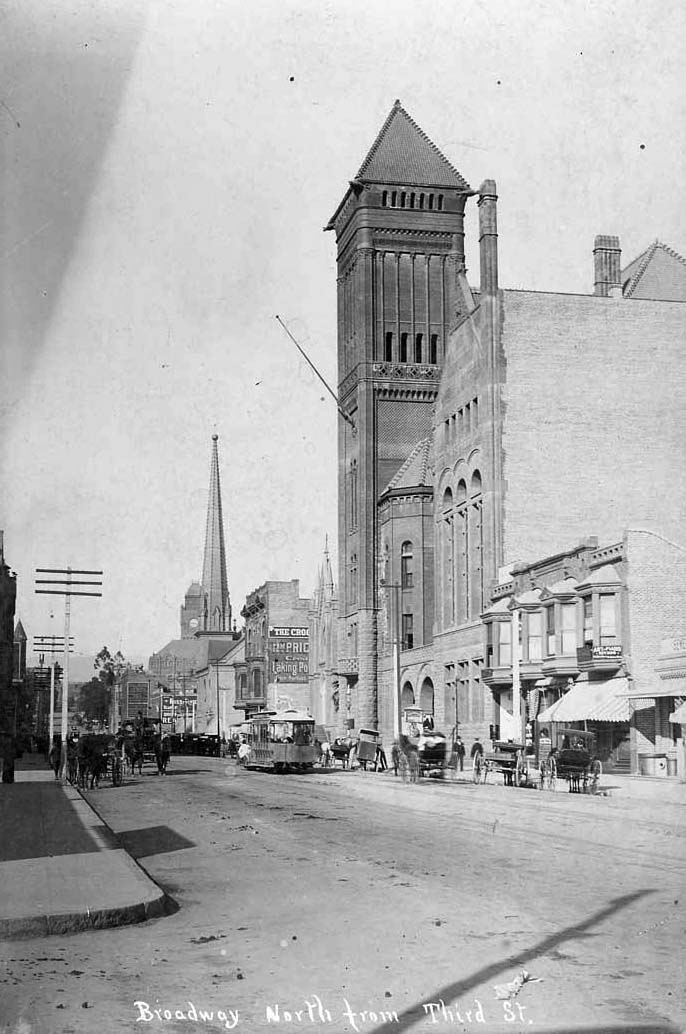 |
|
| (ca. 1895)^ - View of Broadway looking north from Third Street. |
Historical Notes City Hall (1888-1928) dominates the right of the picture. Several other landmarks of the day can also be seen here. The tower of Los Angeles High School is partially visible to the left of the power poles. The clock tower in the distance is that of the Los Angeles County Court House. The tall spire next to that belongs to the First Presbyterian Church at the SE corner of Broadway and Second Street. And, the gothic structure just barely visible between City Hall and the Crocker Building (with the two bay windows) is Los Angeles' first Jewish synagogue (B'nai B'rith Temple). |
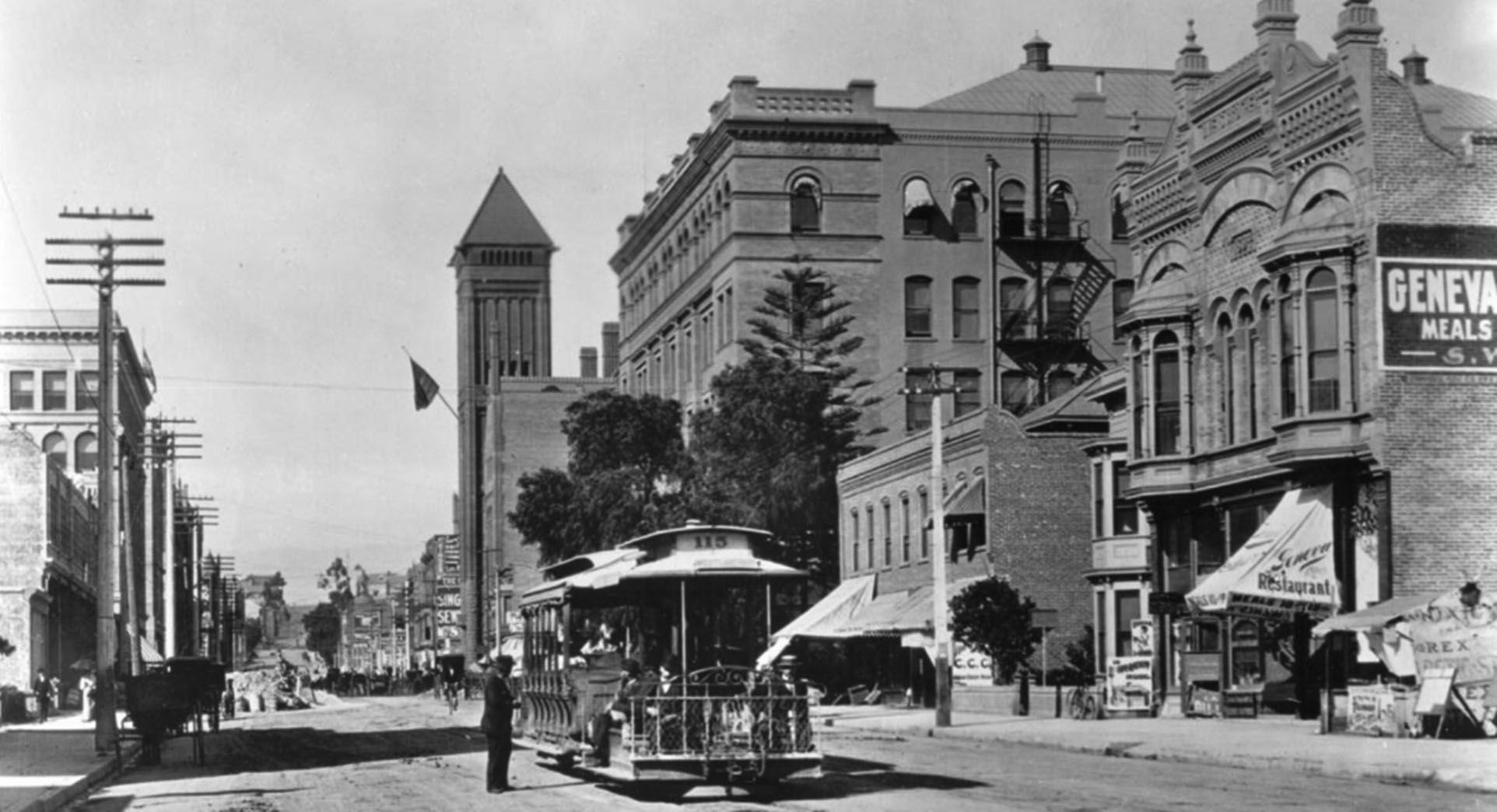 |
|
| (1898)* - View of Broadway looking north from mid-block between 3rd and 4th Streets Street. A man in a hat stands to the left of a stopped streetcar at center which advertised "West Lake Park" on its marquee. Horse-drawn carriages are parked along the sidewalk to the left. To the right, commercial buildings line the street displaying signs, while the tower of the old City Hall can be seen farther down, an American flag extending from its front. |
Historical Notes This photo was taken mid-block, between 3rd and 4th Streets, approximately where the present-day Grand Central Market is located (in the 1896 Homer Laughlin Building). The large building in the upper middle-right is the Bradbury Building. The multi-story structure in the upper left (north-west corner Broadway and 3rd Street) is the 1895-built Byrne Building, the second oldest building in downtown Los Angeles, right behind the Bradbury Building (1893). |
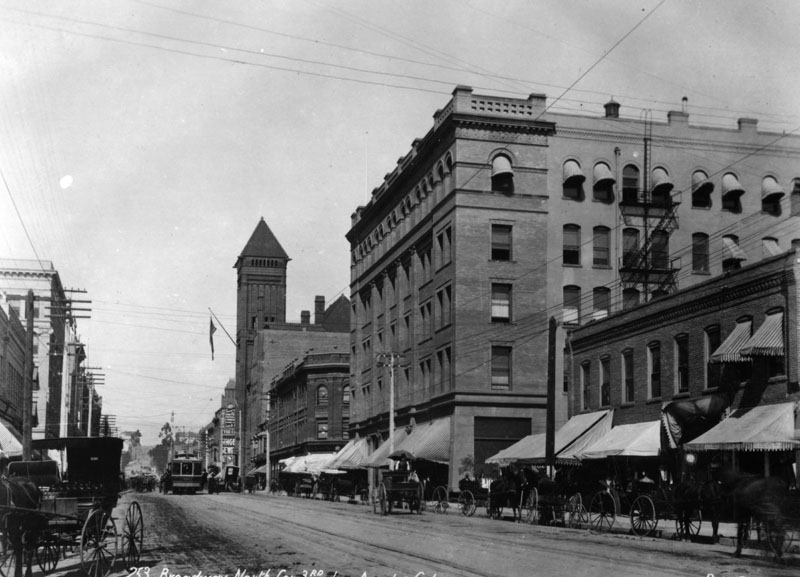 |
|
| (ca. 1900)^ - A view of Broadway looking north toward 3rd Street. Trolleys as well as horses and carriages are seen on the street. City Hall can be seen down the street on the right (tall tower and flag). The Bradbury Building is the large building on the right located on the NE corner of 3rd and Broadway. |
 |
|
| (ca. 1900)* - Looking north on Broadway past 3rd Street. The Rindge Block stands on the northeast corner of Broadway and 3rd, while a portion of the Bradbury Building is visible on the right at the southeast corner. In the background, the building with the flagpole is Los Angeles City Hall. |
Historical Notes The Rindge Block, also known as the Rindge Building, was constructed in 1898 and is located at 248-260 S. Broadway, at the northeast corner of Broadway and 3rd Street. In 1899, it was sold to Frederick H. Rindge, often referred to as the "King of Malibu." Over time, the upper floors were removed, leaving only the ground floor, which is currently occupied by an El Pollo Loco restaurant. |
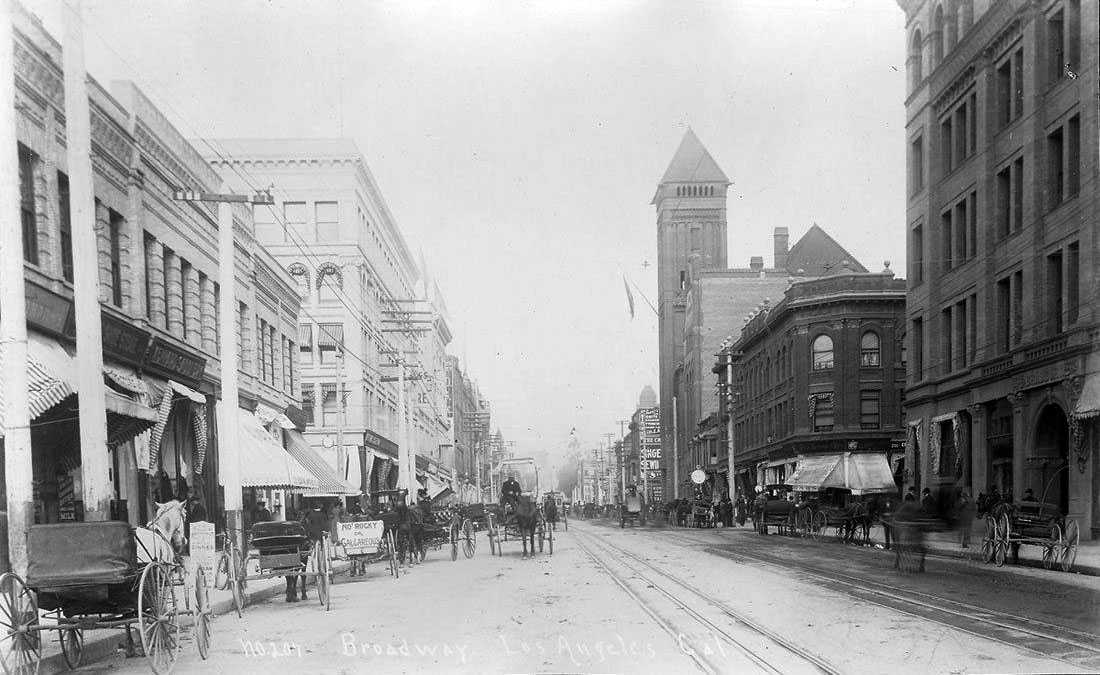 |
|
| (ca. 1900)* - Looking north on Broadway toward 3rd Street. In the distance, the tall tower of Los Angeles City Hall (1888–1928) rises above the streetscape. On the right, at the southeast corner, stands the Bradbury Building. Horse-drawn wagons fill the street, while streetcar tracks run down the center. |
 |
|
| (2024)* – Looking north on Broadway toward 3rd Street. On the right, at the southeast corner, stands the 1893-built Bradbury Building, the oldest commercial building in downtown Los Angeles. |
Historical Notes Two of the oldest buildings in downtown Los Angeles stand at the intersection of Broadway and 3rd Street. On the right, the famous Bradbury Building, completed in 1893, occupies the southeast corner. At center-left is the Byrne Building, built in 1895, making it the second-oldest surviving commercial building in downtown. On the far left is the ornate Million Dollar Theater Building, constructed in 1918. |
Then and Now
 |
|
| (1900 vs. 2024)* – A ‘Then and Now’ comparison of Broadway looking north toward 3rd Street. Two of downtown Los Angeles' oldest buildings stand at this intersection. On the right, at the southeast corner, is the iconic Bradbury Building, completed in 1893. At center-left stands the Byrne Building, built in 1895, the second-oldest surviving commercial building in downtown. Photo comparison by Jack J. Feldman. |
* * * * * |
Broadway Panoramic as seen from LA County Courthouse
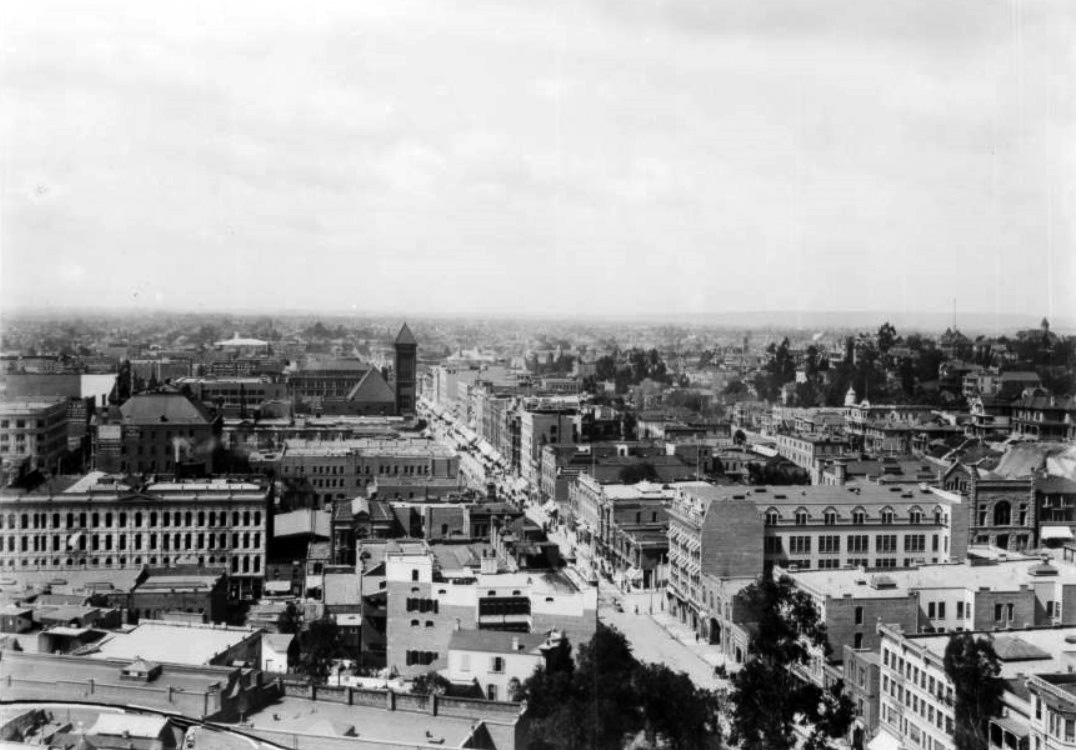 |
|
| (ca. 1900)* - Panoramic view looking south on Broadway from the LA County Courthouse. City Hall is the tallest structure in the distance. |
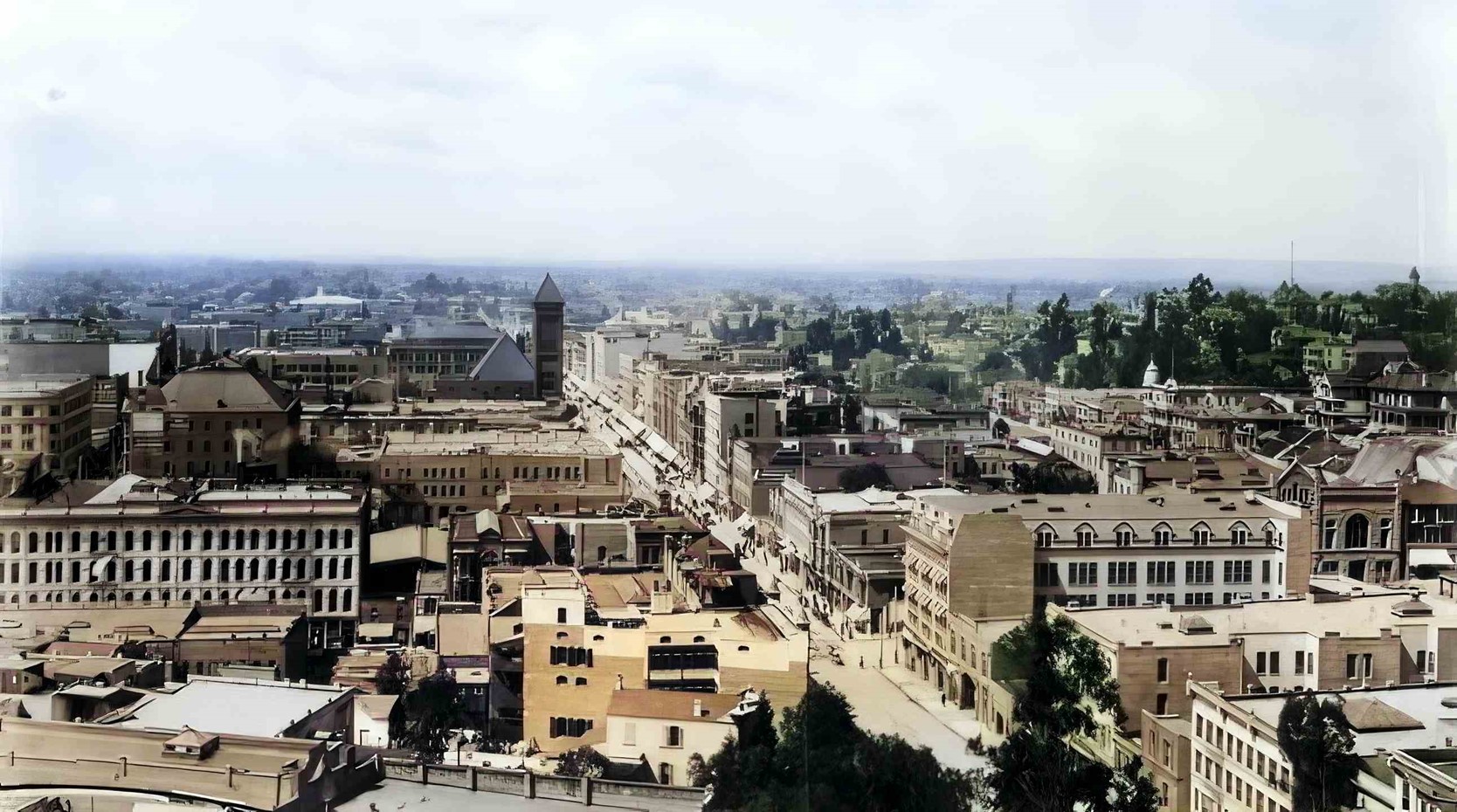 |
|
| (ca. 1900)* - Panoramic view looking south on Broadway from top of LA County Courthouse with City Hall seen as the tallest structure in the distance. AI enhancement and colorization by Richard Holoff |
* * * * * |
Westlake Park
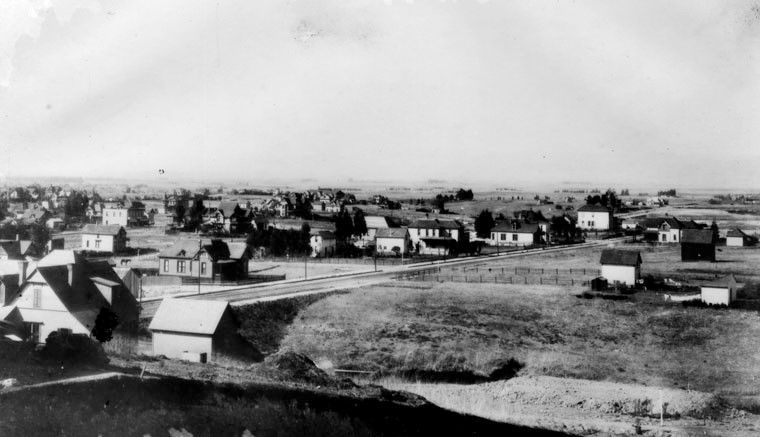 |
|
| (1880s)^ - View looking southwest showing 6th Street (dirt road) as it heads west towards Westlake Park (now MacArthur Park). As seen, this was the edge of the City at the time, around where Alvarado Street is today. |
Historical NotesCInitially, the area where Westlake Park was developed was a swampland and had been used as a city dump. However, by the 1890s, it had been transformed into a desirable vacation destination, surrounded by luxury hotels. The park was named after Henricus Wallace Westlake, a Canadian physician who had moved to Los Angeles and donated part of his land for the creation of the park. |
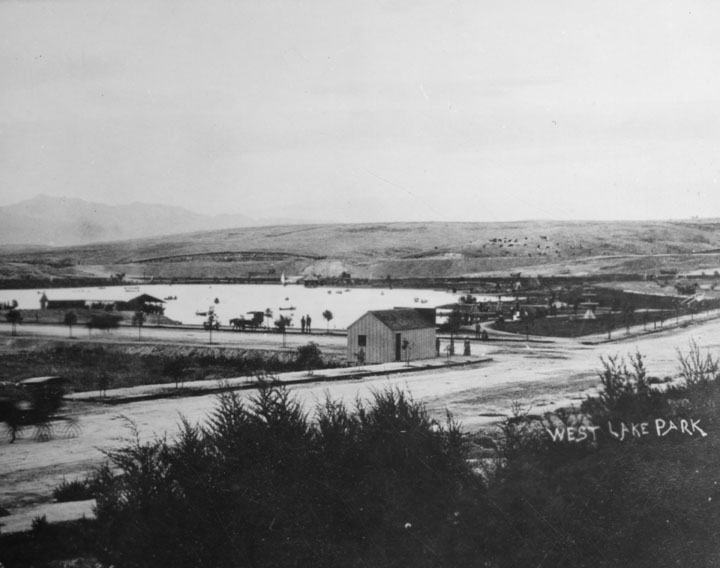 |
|
| (ca. 1880s)^ - Panoramic view looking northwest showing Westlake Park (now MacArthur Park) at the intersection of 7th and Alvarado streets. Alvarado runs diagonally from lower-left to center-right. The surrounding hills are devoid of homes and trees. The building on the far left is the boathouse. |
Historical Notes The park, originally named Westlake Park, was built in the 1880s, along with a similar Eastlake Park, whose lake is artificial. Westlake Park was renamed MacArthur Park on May 7, 1942; Eastlake Park was renamed Lincoln Park. Both Westlake Park and Eastlake Park (as well as Echo Park) were built as drinking water reservoirs connected to the city's systems of zanjas (small conveyance channels/trenches). When the city abandoned the non-pressurized zanja system for a pressurized pipe system, these smaller, shallow reservoirs located at low points no longer provided much benefit. They were then converted into parks. |
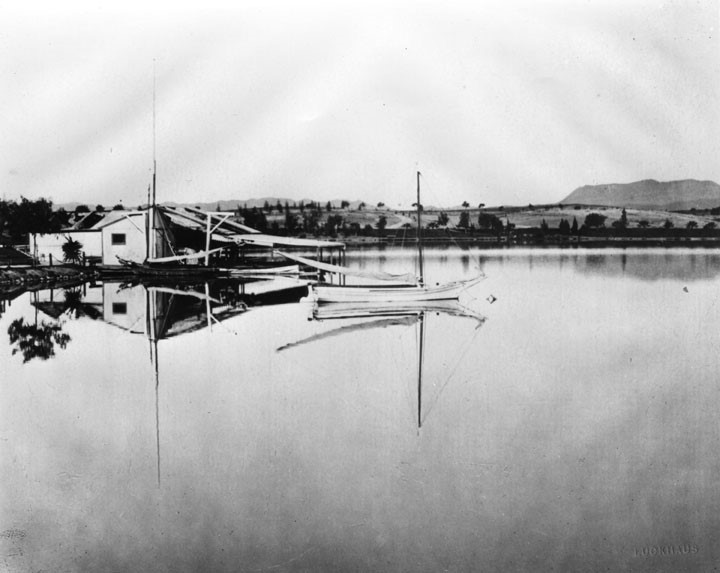 |
|
| (1880s)^ - View looking northwest of Westlake Park and its boathouse. The Hollywood Hills stand in the background (top-right). |
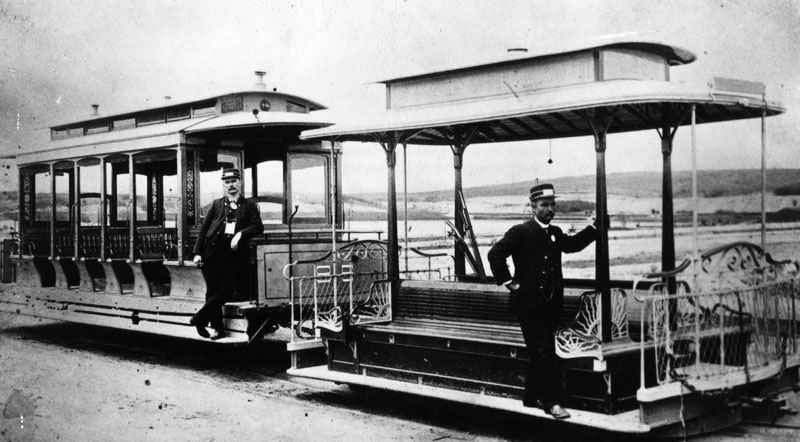 |
|
| (ca. 1880s)^ - Cable cars parked in front of Westlake Park with two conductors posing for the camera. This was the last stop on the cable railway route that started in downtown Los Angeles. |
Historical Notes In the late 1880s, the Los Angeles Cable Railway ran a line from downton Los Angeles along 7th Street to Westlake Park. The lake was becoming a popular destination for a quick get-away vacation. |
jpg.jpg) |
|
| (ca. 1890)^ - View of Westlake Park looking north with the Holywood HIlls in the background. A lone sailboat is in the center of the lake. The City's new park's landscape is begining to take form. On the right can be seen a tropical tree and a palm. |
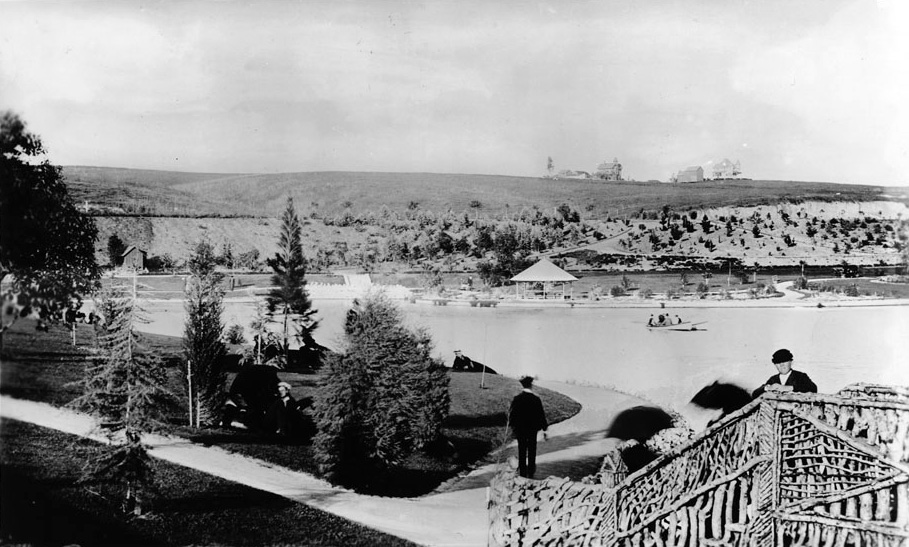 |
|
| (ca. 1892)^^ - View of Westlake with two very large homes seen top of the hill in the background. |
Historical Notes In the mid-19th century the area was a swampland; by the 1890s, it was a vacation destination, surrounded by luxury hotels. |
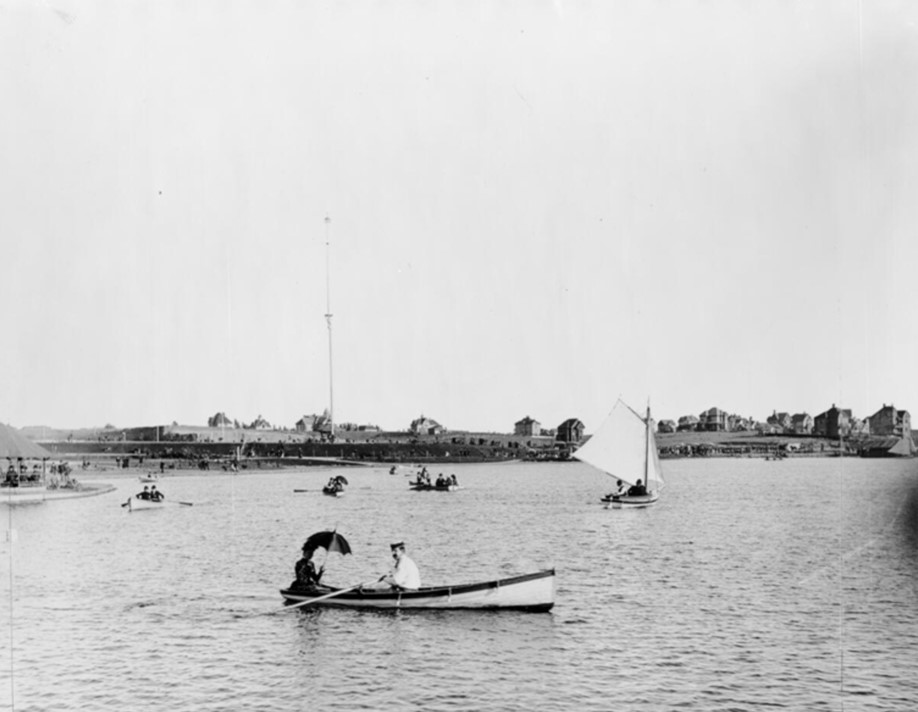 |
|
| (1890s)* - A sailboat and several row boats are seen on the lake at Westlake Park. The hillside is beginning to be filled with new homes. The very tall pole in the background is one of the city’s new streetlights (150-ft tall). Click HERE to see more in Early Los Angeles Street Lights. |
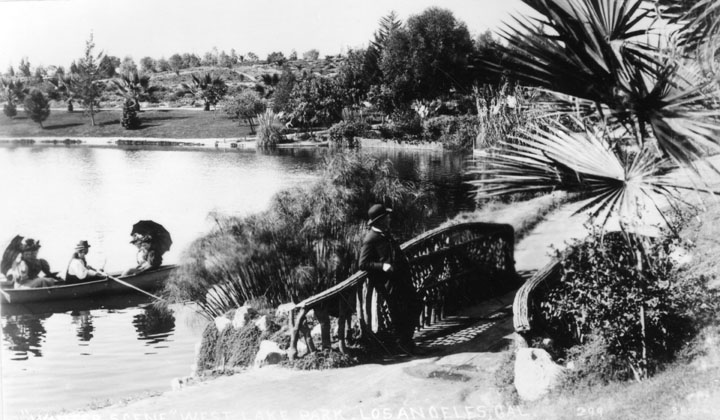 |
|
| (1890s)^ - View of Westlake Park (later MacArthur Park). In this scene we see, on the left, a small group in a row boat, while on shore a man lounges on the rustic foot bridge nearby. |
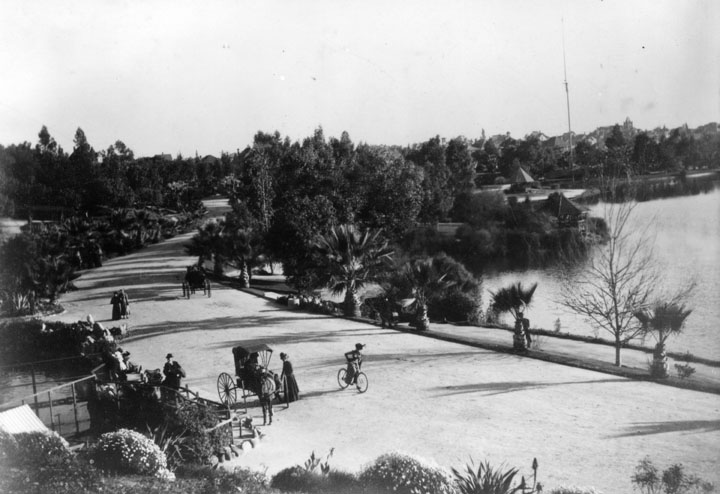 |
|
| (ca. 1890s)^ - Early view of Westlake Park showing horse and carriages and bicycles on the dirt road that surrounded the lake. A 150-foot tall streetlight can be seen in te upper right of photo. |
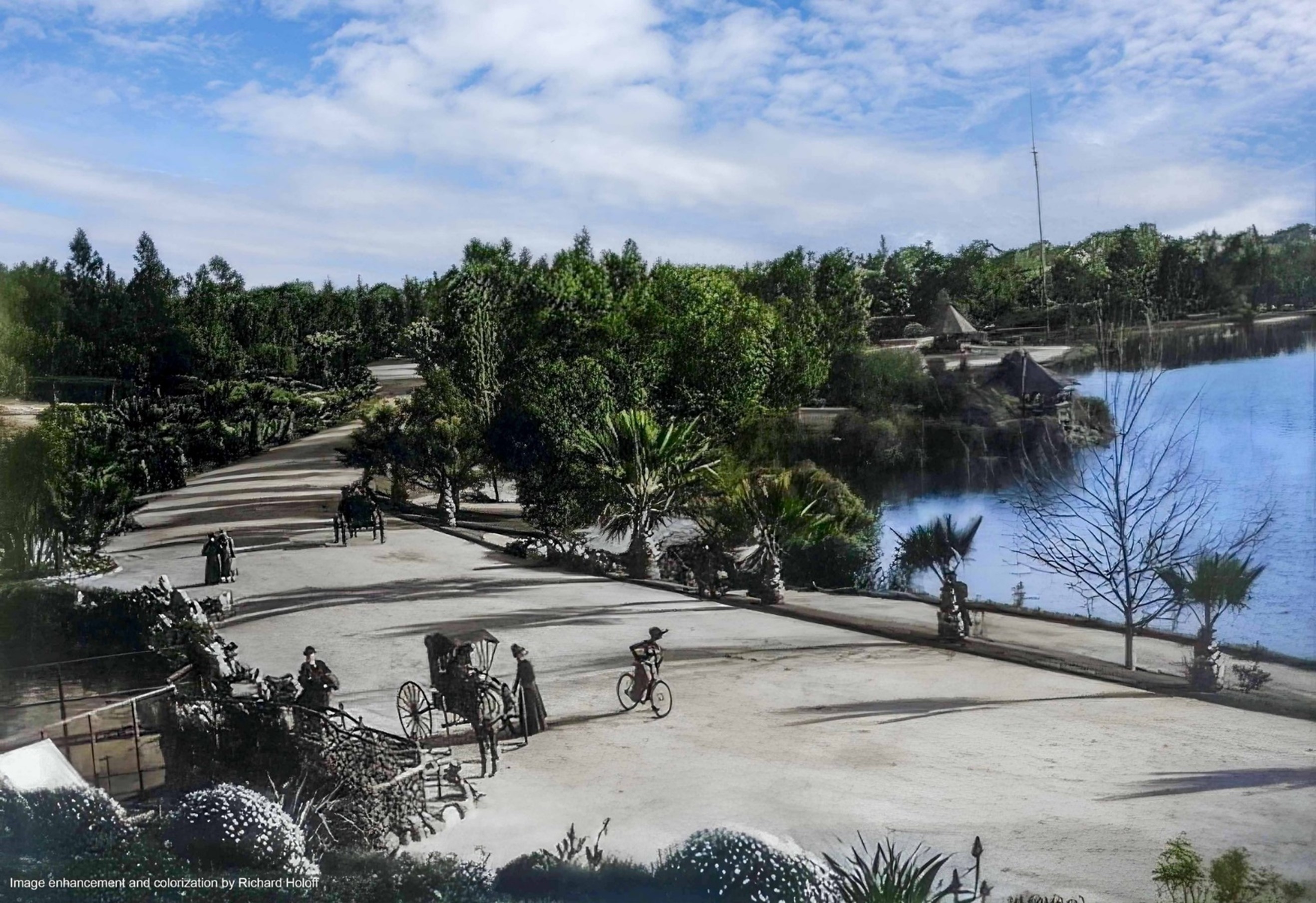 |
|
| (ca. 1890s)^ - Early view of Westlake Park showing horse and carriages and bicycles on the dirt road that surrounded the lake. A 150-foot tall streetlight can be seen in te upper right of photo. Image enhancement and colorization by Richard Holoff |
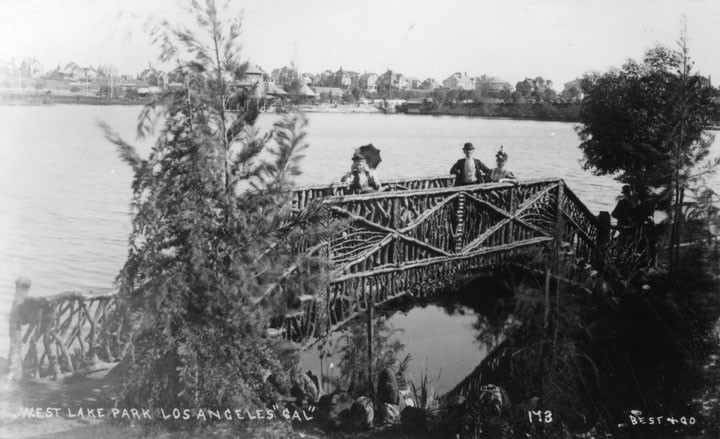 |
|
| (1890s)^ - View of three people on a foot bridge at Westlake Park. The woman at center is holding a parasol. |
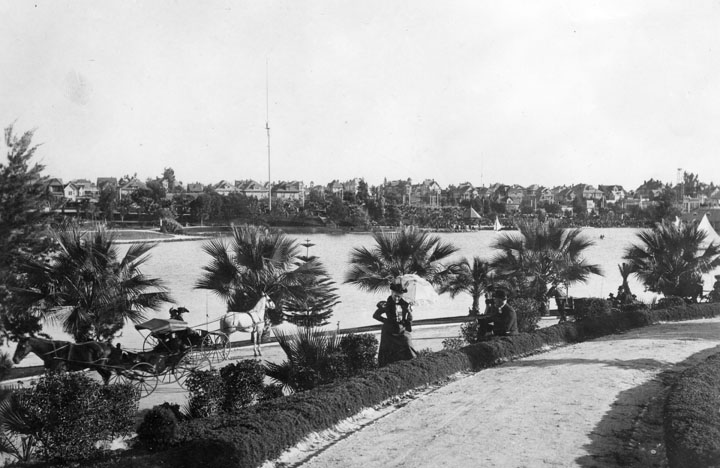 |
|
| (ca. 1895)^ - View of Westlake Park (now MacArthur Park) circa 1895. Transportation was still mostly by horse and carriage (lower left of picture) and ladies carried parasols to shade themselves from the sun. Multi-story homes fill the hill on the other side of the lake. A 150-foot tall streetlight stands in front of the row of homes. |
Historical Notes Wilshire Boulevard formerly ended at the lake on its west side, but in 1934 a berm was built for it to cross and link up with the existing Orange Street (which ran from Alvarado to Figueroa) into downtown Los Angeles. Orange Street was renamed Wilshire and extended east of Figueroa to Grand Ave. This divided the lake into two halves; the northern one was subsequently drained. |
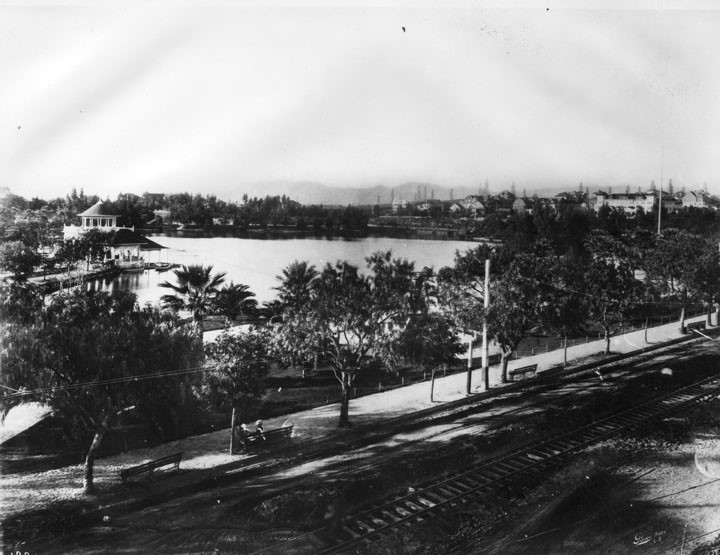 |
|
| (1907)^ - View looking northeast of Westlake Park (later McArthur Park) from 7th Street. A tree-lined walkway with benches is seen on the edge of the park. Trolley tracks run down an unpaved 7th Street. Oil derricks+ are seen in the hills across the lake. In the far background stand the Hollywood Hills. |
Historical Notes In 1890, Edward Doheny struck oil south of Angelino Heights and Echo Park, triggering the city’s first oil boom. Soon, hundreds of wells were pumping away in a wide belt stretching roughly south of Temple Street. For decades the wells would change the landscape of the City. Click HERE to see more in 1890s Oil Boom. |
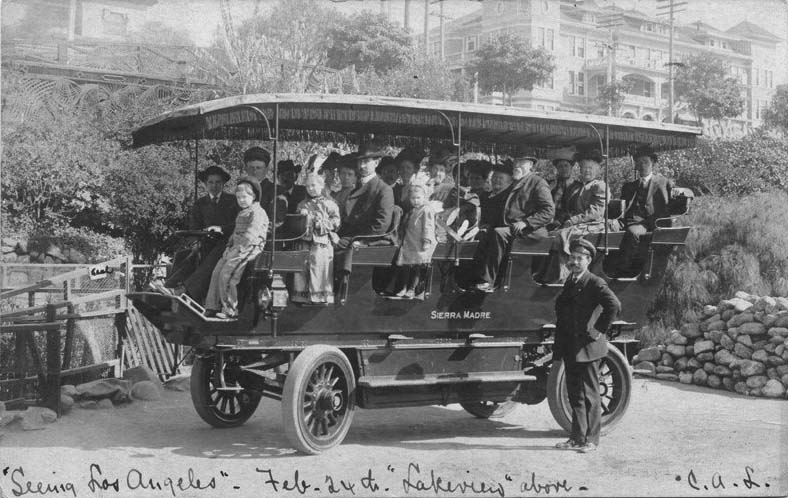 |
|
| (1908)^*# - Postcard view showing a tour bus filled with people including young children on the bank of Westlake Park. Writing at bottom reads: "Seeing Los Angeles" - Feb. 24th - "Lakeview" above (referring to the Lake View Hotel, seen in upper-right). |
Historical Notes Westlake Park was renamed MacArthur Park on May 7, 1942. |
Click HERE to see more Views of Westlake Park (MacArthur Park) in the 1920s + |
* * * * * |
Orange St (later Wilshire) and Lucas Ave
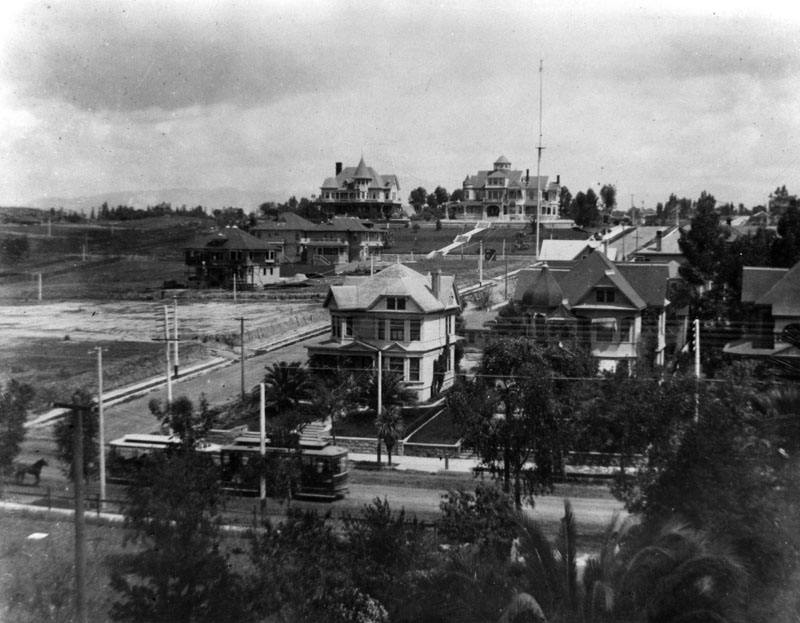 |
|
| (ca. 1892)^ - Residences on Orange Street (later Wilshire Boulevard) at Lucas Avenue showing the Shatto Residence on the northwest corner (top of the photo) of Orange Street; next to it is the Johnson residence. The tall pole seen on Lucas Avenue is another one of Los Angeles’ earliest electric stretlights, standing 150-ft tall. Click HERE to see more in Early L.A. Streetlights. The streetcars in the foreground are on 7th Street, carrying passengers from Downtown to Westlake |
Historical Notes The corner house, at 1213 Orange Street, was the residence of George R. and Clara Shatto, and later became the site of Good Samaritan Hospital in Los Angeles. George Shatto, a real estate speculator from Michigan, purchased Santa Catalina Island in 1887 for $200,000 and created the settlement that would become Avalon. He was the first owner to try to develop the island into a resort destination at the height of the real estate boom, and can be credited with building Avalon's first hotel and pier.^ Next to the Shatto house is the Orson Thomas (O.T.) Johnson house at 1221 Orange Street. O.T. Johnson became a very successful businessman in Los Angeles, known for building the Westminster Hotel. Occidental College has the Johnson Hall that was constructed in 1914 and was a gift of the Johnsons. O.T. was also a big supporter of the LA YMCA, donating a reported $35,000 to construct a YMCA building. Johnson built the Florence Crittenden Home and established a clinic in Los Angeles for the aid of poor children. He also built a seventy-five suite apartment building named Anna Craven Johnson Home, after his wife, that was established for the use of widowed mothers with dependent children.* The Good Samaritan Hospital was built on the NW corner of Orange (later Wilshire) and Lucas in 1925. Orange Street was renamed Wilshire Bouelevard in 1934. |
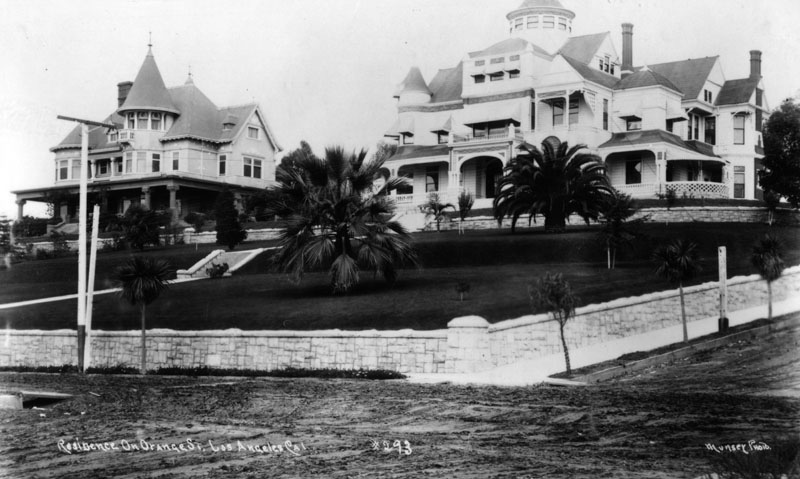 |
|
| (1892)^- View looking at the NW corner of Lucas Avenue and Orange Street (later Wilshire Boulevard) showing two Queen Anne style houses, one belongoing to George R. and Clara Shatto (right) and Orson Thomas (O.T.) Johnson (left). Both houses were built ca. 1892). |
Historical Notes What is now the easternmost portion of Wilshire Boulevard was originally a residential avenue called Orange Street, developed as part of the Orange Heights Tract by George Rufus Shatto. Shatto made his fortune in mining and purchased Catalina Island in 1887. In 1890, he began construction of a massive Victorian residence at the intersection of Orange Street and Lucas Avenue, close to his business headquarters in downtown Los Angeles. Designed by Curlett & Eisen, the residence included a four-story tower from which one could see Catalina. Shatto only occupied the residence for a short time, as he was killed in a railroad accident in 1893. Eventually, Good Samaritan Hospital would replace all of the residences along this stretch of Orange Street (later Wilshire Boulevard). Today, two remnants of the original rusticated stone wall are all that remain of this elaborate residence; the other remnant is situated on 6th Street between Lucas Avenue and Bixel Street.* |
* * * * * |
Elysian Heights Area
.png) |
|
| (ca. 1887)^*# - Birdseye view of Bella Vue Avenue (now Bellevue, this section of which would later become part of Sunset Boulevard) and the Robinson residence shortly after it was built, looking north from Fort Hill. |
Historical Notes The J.W. Robinson mansion can be seen on the hilltop. It was located on Teed Street near Bella Vue Avenue (now Bellevue, this section of which would later become part of Sunset Boulevard). Teed Street was named after Freeman G. Teed who, in the 1880s and 90s, was LA City Clerk and President of the City Council. He was also a real estate speculator.^*# |
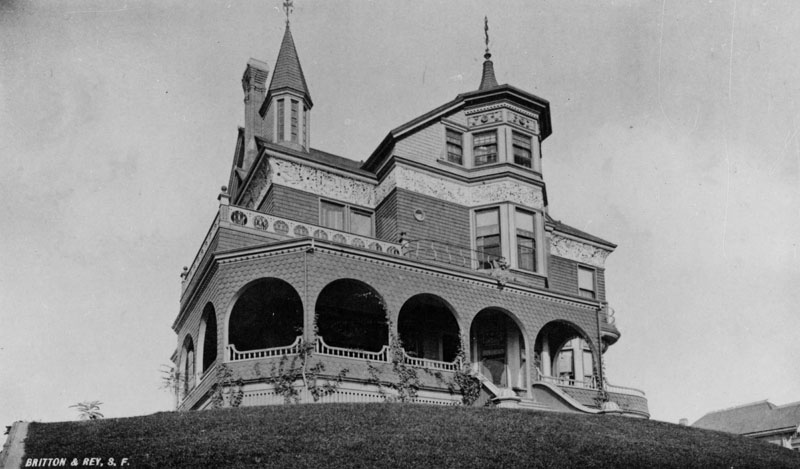 |
|
| (ca. 1890)^ - Close-up view of the two-story Victorian style home of Joseph Winchester Robinson, located on Teed Street near Bella Vue Avenue (later Sunset Boulevard). A winged gargoyle watches over the entrance. |
Historical Notes Samuel and Joseph Carter Newsom were the architects. The house was built in 1887 at a cost of $10,000. Joseph Winchester Robinson was the owner of Boston Dry Goods which later became the J. W. Robinson Department Stores.^ |
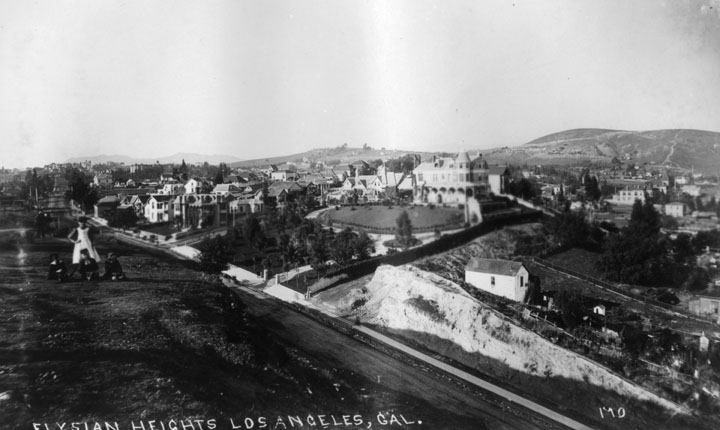 |
|
| (ca. 1890s)^ - Panoramic view of Elysian Heights. At left, a woman is visible standing, with three children seated before her on a grassy hill. Bellevue (later Sunset) runs from lower right to middle left. The Robinson Mansion sits high on the hill in the distance fronted by Teed Street. North Hill Street runs away from Bellevue on the other side of the Robinson Mansion. |
Historical Notes J. W. Robinson's “Boston Dry Goods Store” began business in of 1883 at the corner of N. Spring and Temple Streets. Joseph Winchester Robinson advertised that his establishment was characterized by “fine stocks and refined ‘Boston’ service.” The arrival of railroads spurred the enormous and long-lived growth of Southern California, and Robinson’s store brought eastern goods and their attendant sophistication to a willing (and growing) public; in 1887 the store was forced to move to larger quarters at 69-73 N. Spring Street. After returning from a trip back east in 1891, Robinson became ill and passed away in his home at the age of 45. His father, H.W. Robinson came to Los Angeles for the funeral and to look after the business founded by his late son. #*^^ |
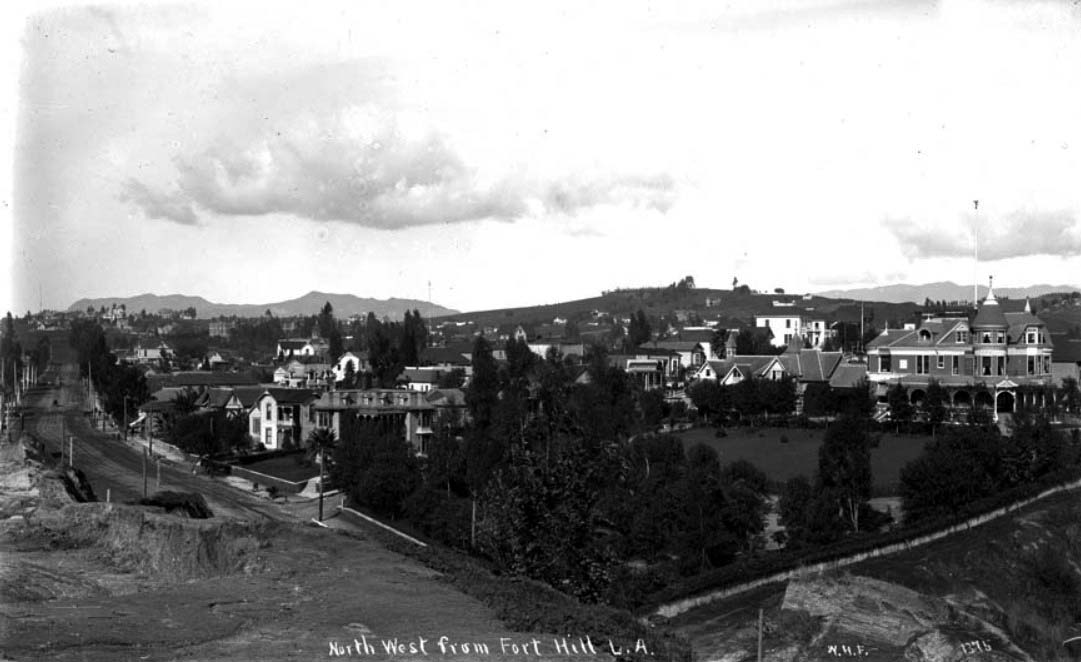 |
|
| (ca. 1895)^## - View looking northwest from Fort Moore Hill. The beautiful Victorian mansion (on the right) was purchased by Mrs. Julia S. Ford after the sudden death of J. W. Robinson in 1891. |
Historical Notes The prominent roadway running from center-left to center-bottom, where it is partially obscured by the brow of Fort Moore Hill, is Bellevue (sometimes called Bella View) which would become Sunset Boulevard and then, ultimately West Cesar E. Chavez Avenue. #^* |
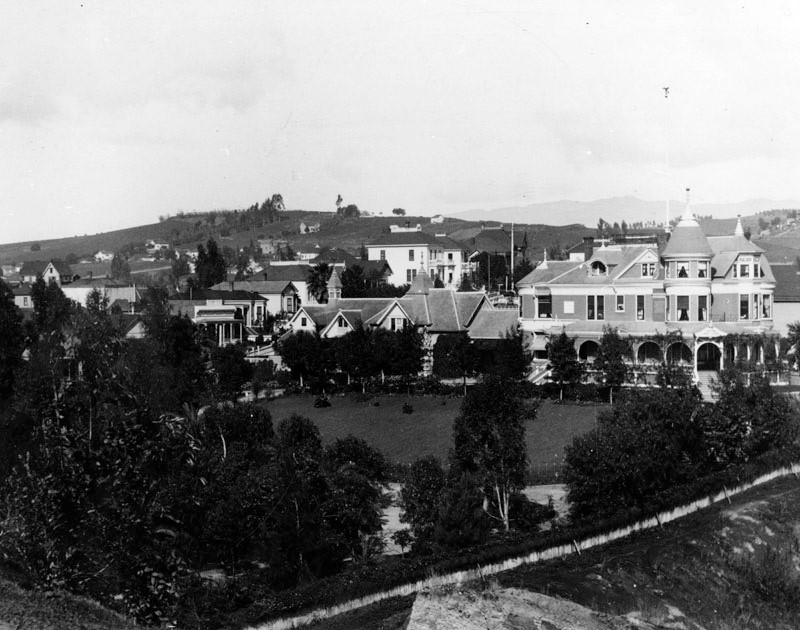 |
|
| (ca. 1897)^ - Panoramic view of the two-story Victorian style home of Mrs. Julia S. Ford, who purchased the residence from J.W. Robinson Estate and then remodeled it. |
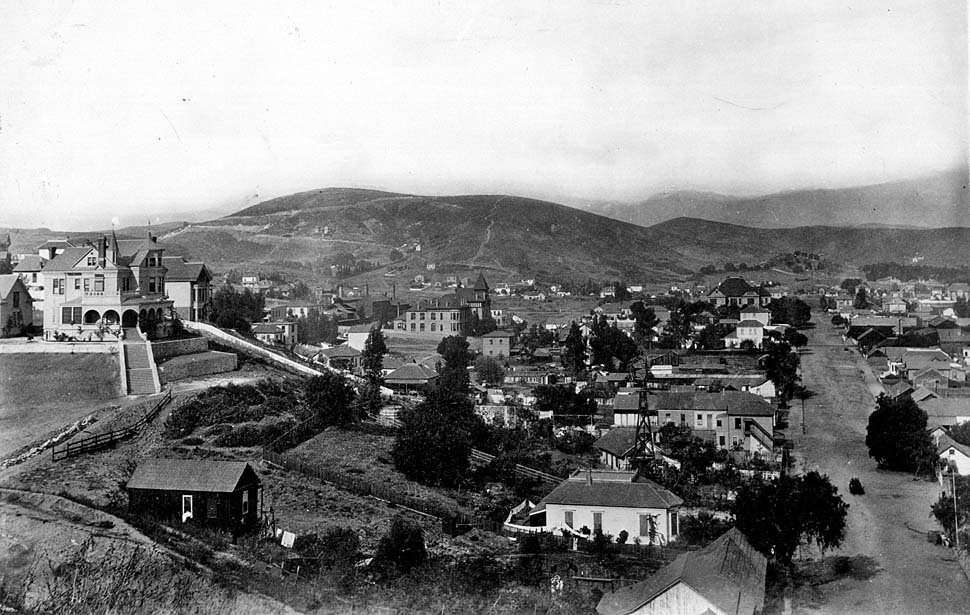 |
|
| (ca. 1900)* - View of Sonora Town from Fort Moore Hill looking north along Castelar Street (now Hill Street). |
Historical Notes The Julia S. Ford mansion (previously J.W. Robinson mansion) can be seen on the hilltop, left, overlooking Castelar Street (on the right, running directly away from the camera). Bella Vue (now Bellevue, this section of which would later become part of Sunset Boulevard) is below the frame running right to left. The two-story Victorian style home is located on Teed Street near Bella Vue Avenue. |
* * * * * |
Sonora Town
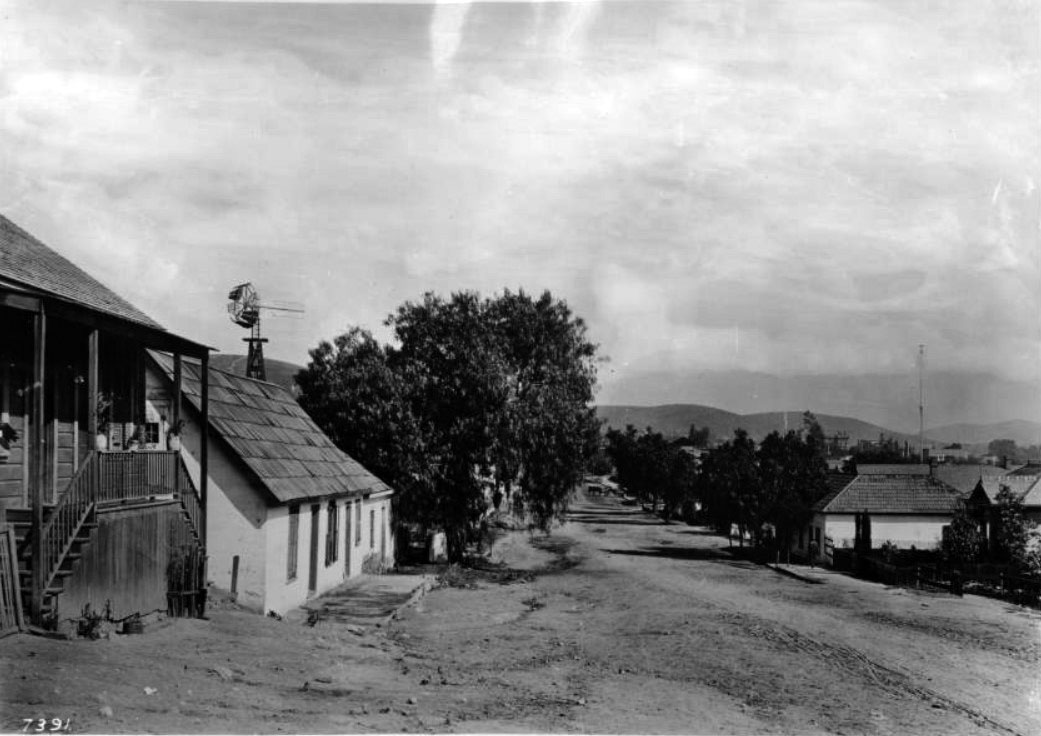 |
|
| (1890)* – View of homes along an unpaved Castelar Street (now Hill Street) looking north from Sunset Boulevard in Sonora Town. On the left side of the road, a squat one-story adobe and an elevated Craftsman-style house are visible, along with a windmill and a cluster of trees. To the right, a partially obscured one-story house can be seen through the foliage. In the distance, a tall antenna-like tower appears at center-right—one of Los Angeles' first electric streetlights, standing 150 feet tall. |
Historical Notes The part of the city called Sonora Town was an old adobe village north of the Plaza and Church of Our Lady, Queen of the Angels. It was Los Angeles' first Mexican quarters, or barrio. The area was named for the numerous miners and families who came from Sonora, Mexico, and may have still been around in the 1930s. Now it is Los Angeles' Chinatown District. |
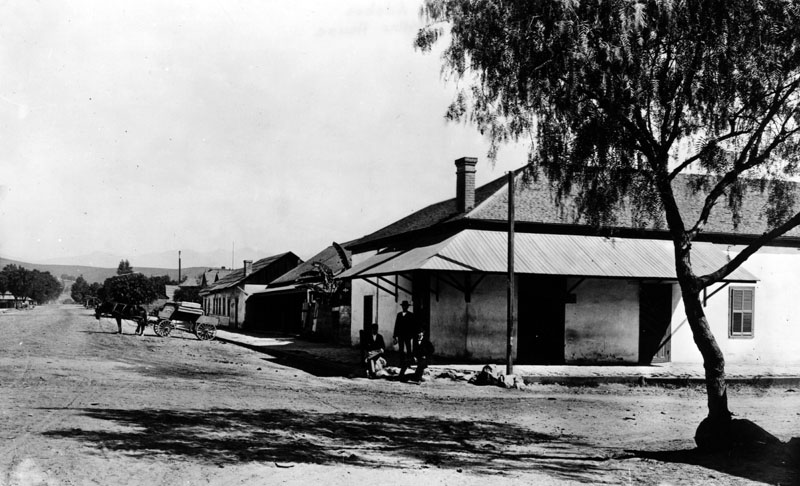 |
|
| (ca. 1899)^ - Three men are seen relaxing in front of an adobe house with a low hanging roof, at the corner of Castelar Street (now Hill Street) in Sonora Town. Several more homes are visible along Castelar, which has a very wide dirt road as far as the eye can see. A horse-drawn carriage is parked along the right side of the street. |
Historical Notes Hill Street was originally laid out in 1849 by Edward Ord. At that time, the street's northern end was near 4th Street, the roadway being obstructed by its namesake, Bunker Hill. The northern section of the street was originally named Castelar Street, and several institutions along this end of the street still bear that name. |
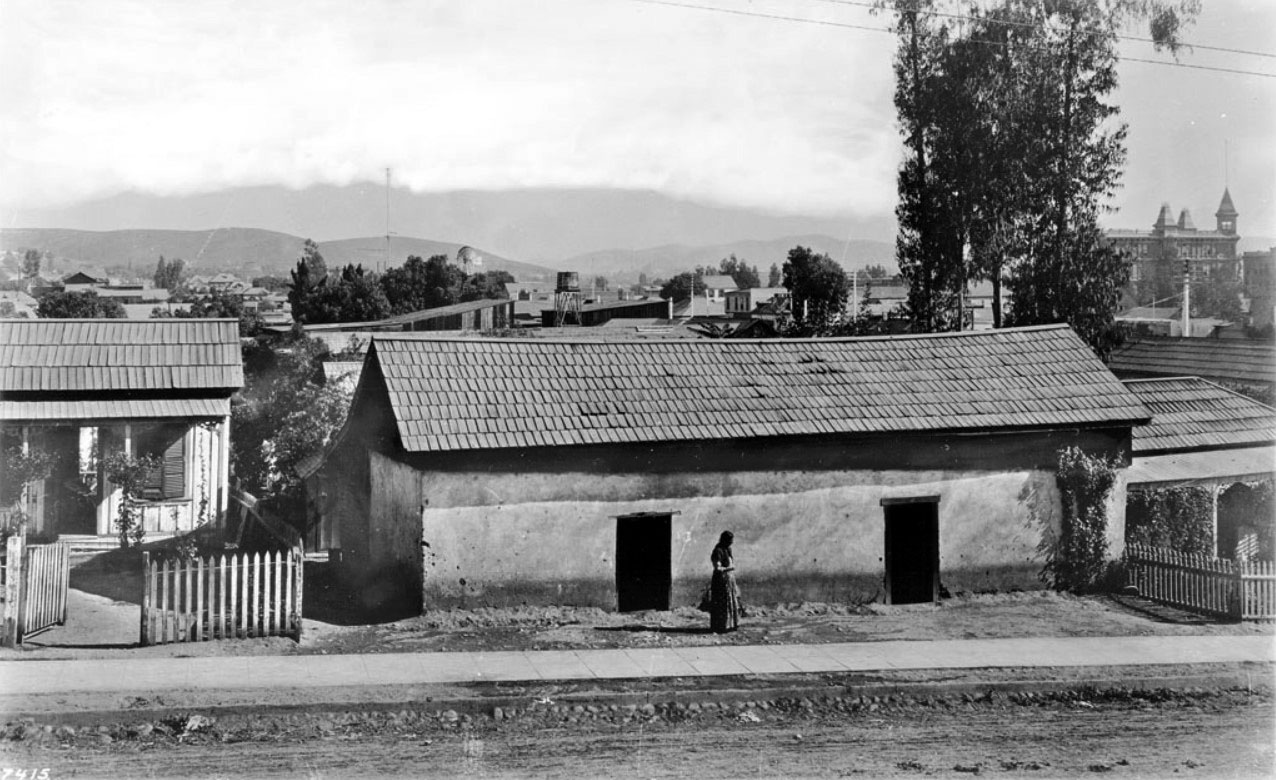 |
|
| (1890s)* - View of the east side of Castelar Street near Sunset Boulevard. A woman stands in front of a long adobe which has two door-less doorways. Non-adobe houses cordoned-off by picket fences stand to either side. A water tower and windmill are visible in the center background. The tall building in the upper-right (with three turrets) is the 4-story Sunset Hotel at 703 San Fernando Street (later North Spring Street). The residential area of the city is visible in front of the mountains in the left distance. |
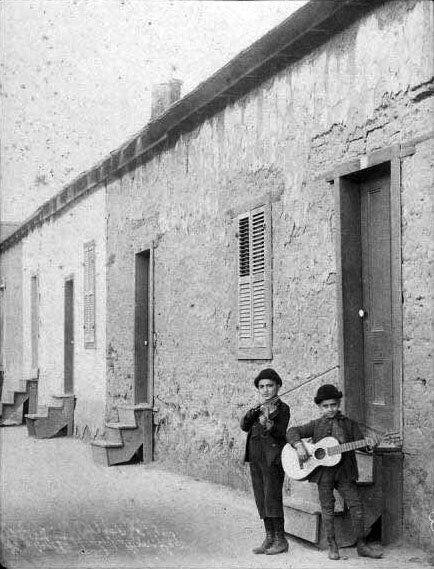 |
|
| (1880s)* - View showing two boys posing for the camera with their instruments on North Broadway in Sonora Town. |
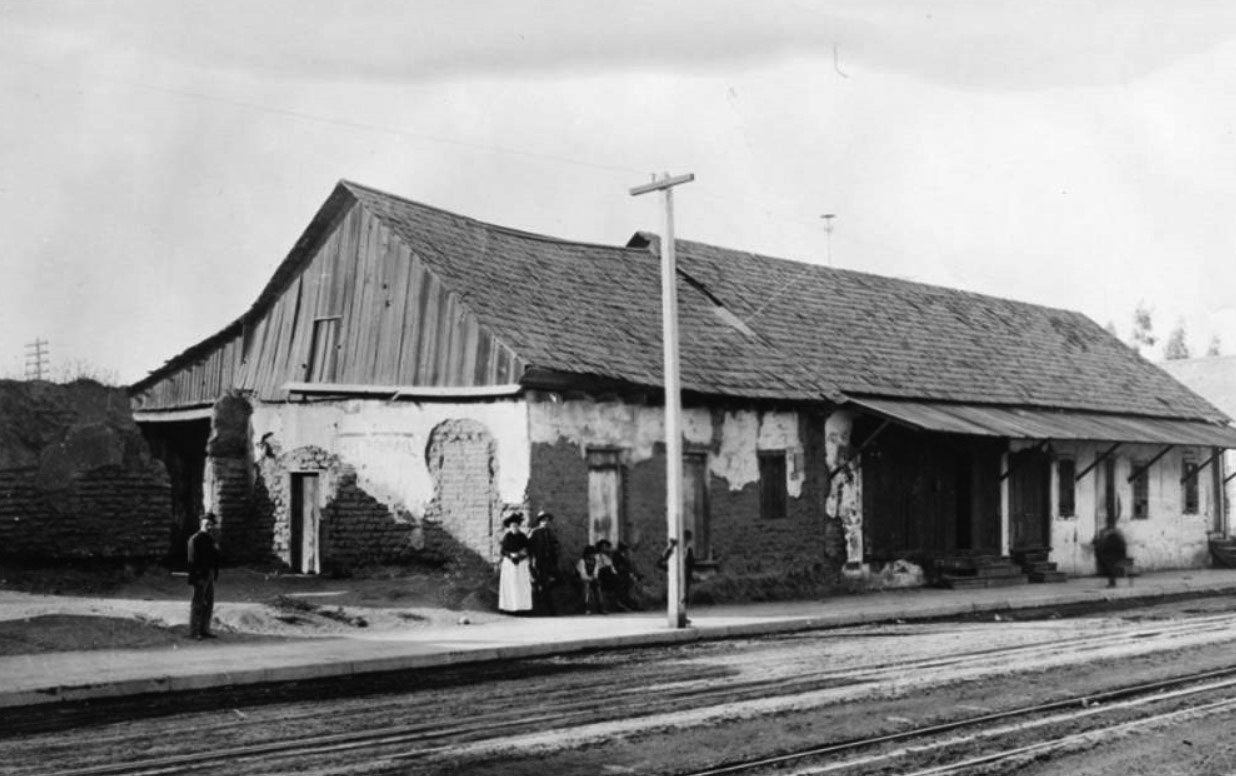 |
|
| (ca. 1890s)* - People outside an adobe house on Buena Vista Street (later renamed North Broadway) in Sonora Town. Trolley car tracks can be seen in the street. |
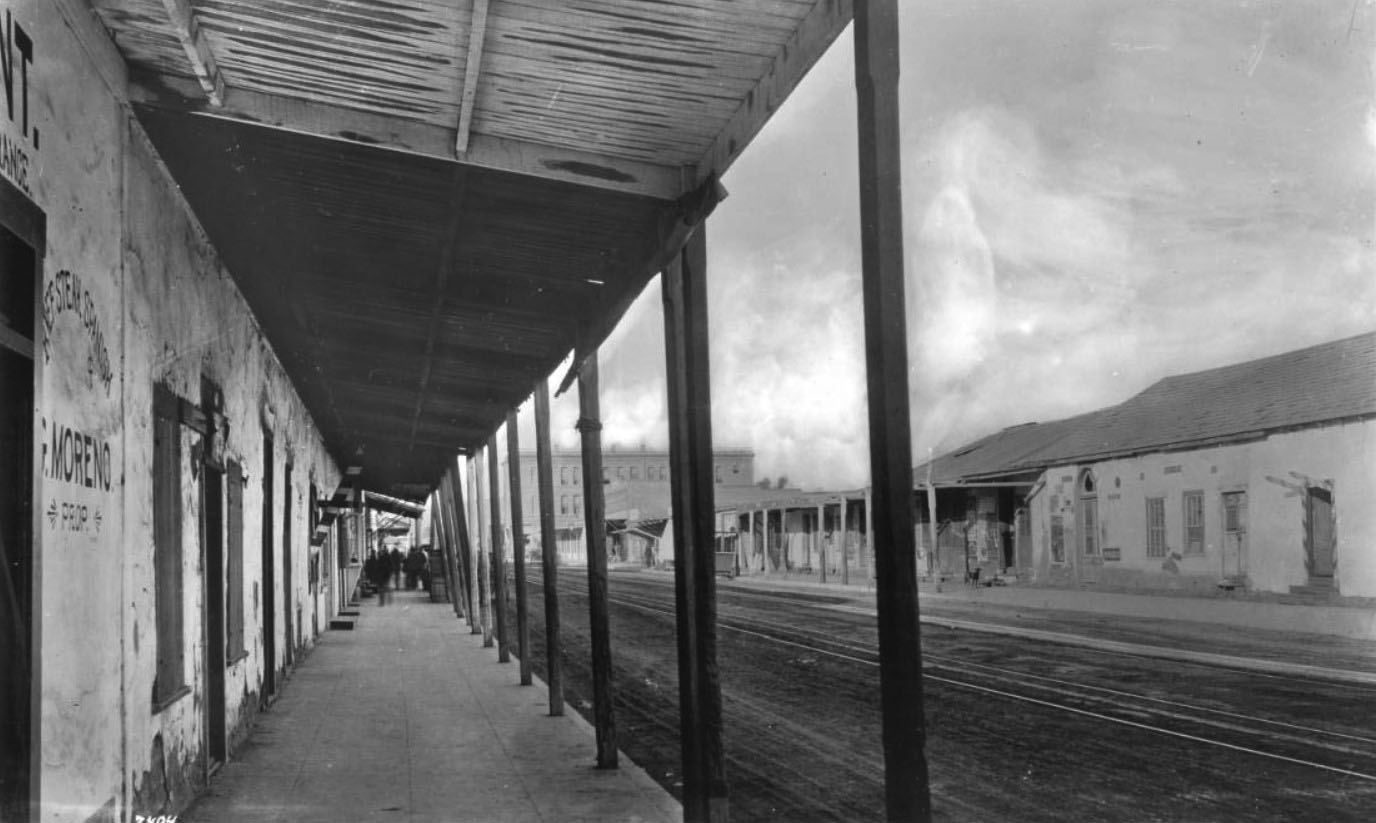 |
|
| (1890s)* - A view of the paved patio and walkway of an adobe restaurant owned by G. Moreno, which is located on the 600 block of N. Spring Street in Sonora Town. More adobe buildings can be seen across the street, possibly stores and/or homes. The 3-story building seen in the distance is the San Fernando Hotel, located at 700 N. Spring Street. |
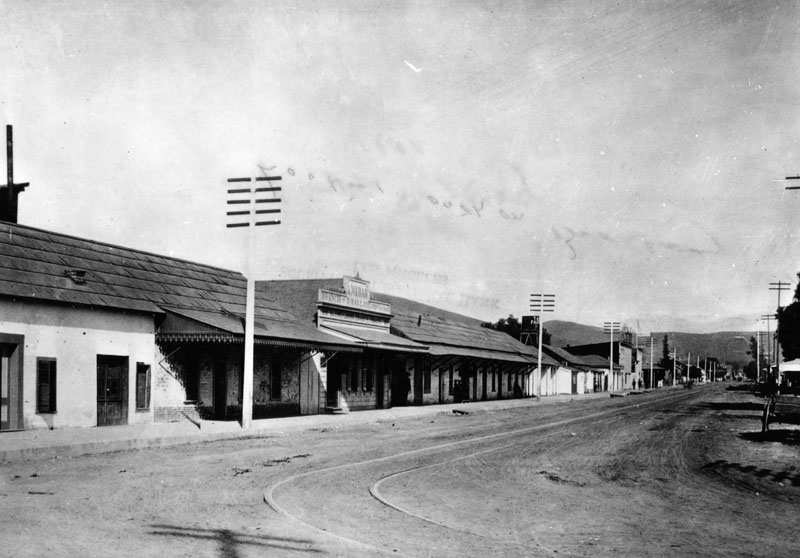 |
|
| (1895)* - North Broadway (formerly named Buena Vista Street), looking north from Sunset Boulevard in the area known as "Sonora Town". Adobe buildings can be seen along the street; among them is "Branch of P. Ballade House", a saloon that was located at 207 N. Buena Vista Street. |
Historical Notes Click HERE to see more Early Views of Sonora Town |
* * * * * |
Los Angeles Plaza
.jpg) |
|
| (1890s)^ - On the left is the Pico House, the Plaza Church in the center. Fort Hill appears in the background, with residences of William Wills, and Mrs. Phineas Banning, and the tower of Los Angeles High School. |
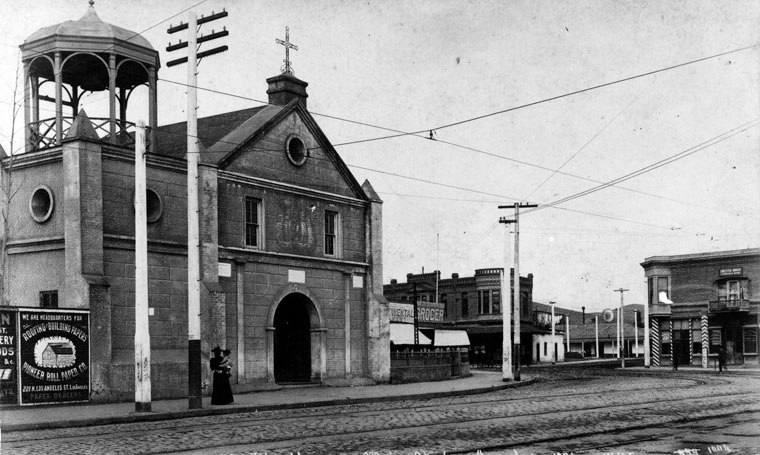 |
|
| (1894)^- Plaza Church as seen by looking north from Pico House on Main Street. This was the parish church for Los Angeles and was never a mission. A woman is seen holding a small child in front of the church. |
Historical Notes The surrounding area was named El Pueblo de Nuestra Señora la Reina de los Angeles del Río de Porciúncula ("The Town of Our Lady the Queen of the Angels on the River Porciúncula", which is the present-day City of Los Angeles). A chapel, La Iglesia de Nuestra Señora Reina de los Angeles, was later erected and dedicated on December 8, 1822, and for years served as the sole Roman Catholic church in the Pueblo. It is the oldest church in the city of Los Angeles. |
| (ca. 1895)*### - Men and women gather around the Plaza Church. The church is a stone block building with an arched doorway, ocular window, and a gazebo-like structure mounted on the roof. Shows the faint impressions of paintings on the exterior of the building. Signs on nearby commercial buildings read: "Saloon and Restaurant, Home Brewery" and "F.W. Braun and Co., Druggist." |
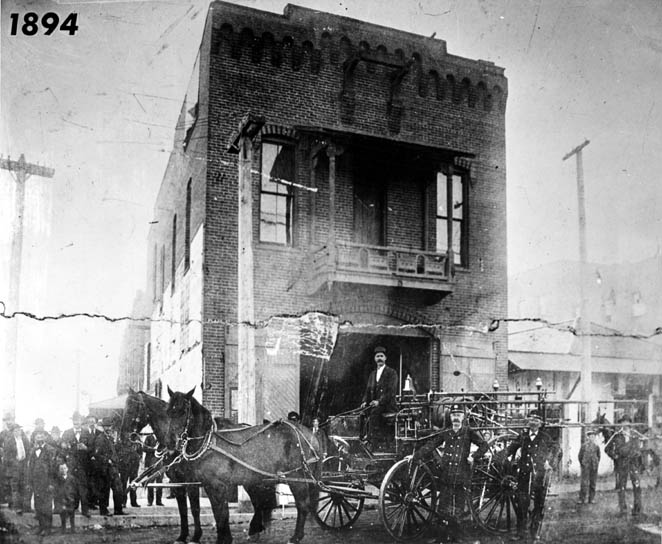 |
|
| (1894)#*#^ - Firetruck, men and horses in front of the Plaza Firehouse. To the right stands Governor Pio Pico's Office. |
Historical Notes The Old Plaza Firehouse is the oldest firehouse in Los Angeles. Built in 1884, it operated as a firehouse until 1897. The building was thereafter used as a saloon, cigar store, poolroom, "seedy hotel", Chinese market, "flop house", and drugstore. The building was restored in the 1950s and opened as a firefighting museum in 1960.*^ The Old Plaza Firehouse was dedicated as California Historical Landmark No. 730 (Click HERE to see more in California Historical Landmarks in L.A.) |
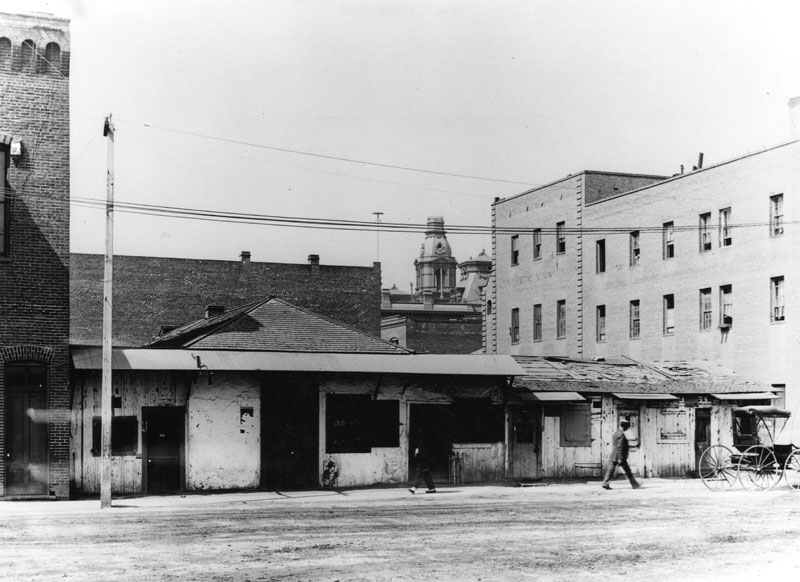 |
|
| (1895)^ - View of Governor Pio Pico's Office located between the Old Plaza Firehouse (left) and the Pico House (right), across from the Plaza. The prominent towers of the Baker Block can be seen in the background. |
Hisorical Notes Pío de Jesús Pico (May 5, 1801 – September 11, 1894) was the last Governor of Alta California (now the State of California) under Mexican rule. In 1821 Pico set up a tanning hut and dram shop in Los Angeles, selling drinks for two Spanish bits (US 25 cents). His businesses soon became a significant source of his income. |
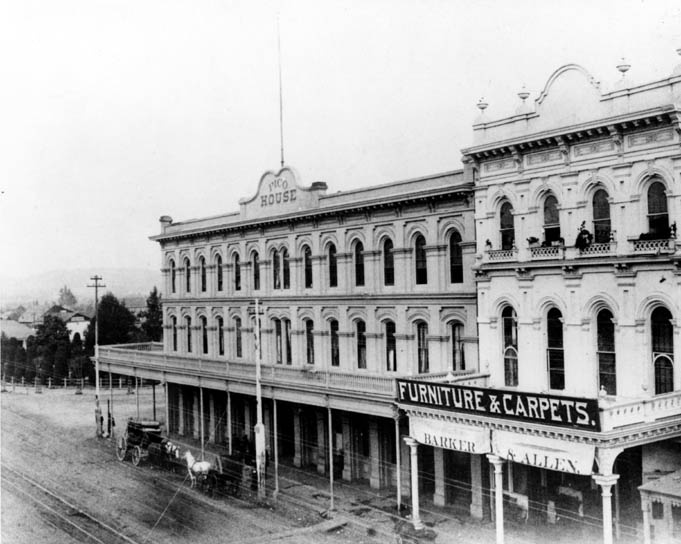 |
|
| (1890s)#*#^ - View of Main Street looking northeast. The Plaza, Pico House, and Merced Theater are visible. A sign above the theater reads “Barker & Allen, Furniture & Carpets.” A stagecoach and horse-drawn wagon are parked in front of the Pico House. |
Click HERE to see more in Early Plaza of L.A. |
* * * * * |
Arroyo Seco
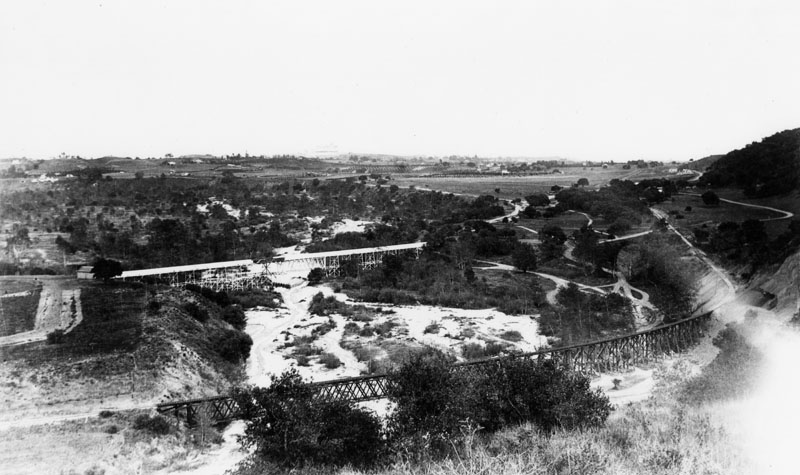 |
|
| (1890s)^ - Panoramic view of two railroad bridges in Arroyo Seco, in Pasadena. |
Historical Notes The Arroyo Seco, meaning "dry stream" in Spanish, is a 24.9-mile-long seasonal river, canyon, watershed, and cultural area in Los Angeles County. It was one of the Los Angeles River tributaries explored by Gaspar de Portola in the late summer and fall of 1770. He named the stream Arroyo Seco, for of all the canyons he had seen, this one had the least water. By 1895 a railroad line had been established from Downtown Los Angeles with a grand wooden trestle that cut a straight line crossing from the west side to the east. Eventually this line would hook up with rail lines built from the east to create the cross-country course of the Santa Fe Railroad. For local commutes, an electric traction trolley was put in and operated by the Pacific Electric Railway, a Henry E. Huntington enterprise, which ran the "Red Cars" from the upper Arroyo and Pasadena through the San Gabriel Valley into Los Angeles and many points beyond. The lower Arroyo Seco was served by the Los Angeles Railway "Yellow Car" lines.*^ |
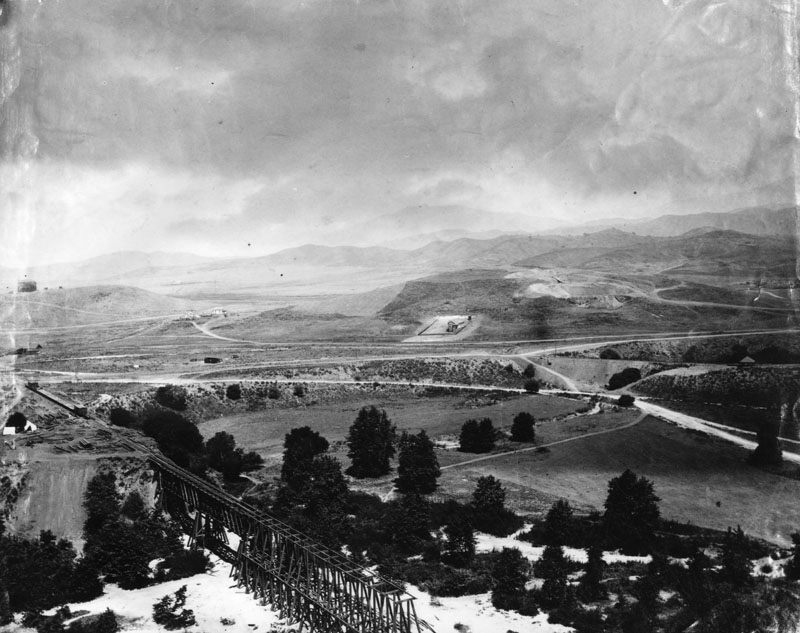 |
|
| (1895)^ - Panoramic view of a sparsely-populated Garvanza, with trees and a partly constructed bridge in the foreground across the Arroyo from Highland Park. |
Historical Notes One of the oldest settled areas of Los Angeles, Highland Park is also one of the most scenic due to its location along the Arroyo Seco, between the Mt. Washington hills, the San Rafael hills and the Monterey Hills.*^ Garvanza is considered a sub-district of Highland Park. The area was named for the garbanzo beans that once flourished there. In 1899, Garvanza was annexed by the City of Los Angeles.*^ |
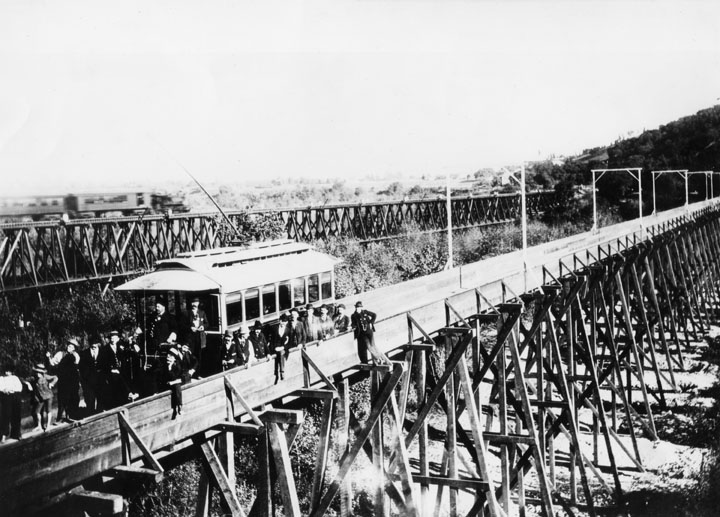 |
|
| (1895)^ - View of the first electric car over Arroyo Seco near the Cawston Ostrich Farm on March 7, 1895. Pasadena and Los Angeles Railway Co. (Click HERE to see more in Early Views of Pasadena). |
Historical Notes Cawston Ostrich Farm, located in South Pasadena was opened in 1886 by Edwin Cawston. It was America's first ostrich farm and was located in the Arroyo Seco Valley just three miles north of downtown Los Angeles and occupied nine acres. In 1885 Edwin Cawston charted a ship to take fifty of some of the best obtainable ostriches in the world from South Africa to Galveston, Texas. From there, the ostriches endured a treacherous train journey to South Pasadena. Out of the original fifty, only eighteen survived. Cawston bounced back from the loss of over half of his stock and the Ostrich Farm eventually boasted over 100 ostriches from the original batch.*^ |
* * * * * |
Hollenbeck Park
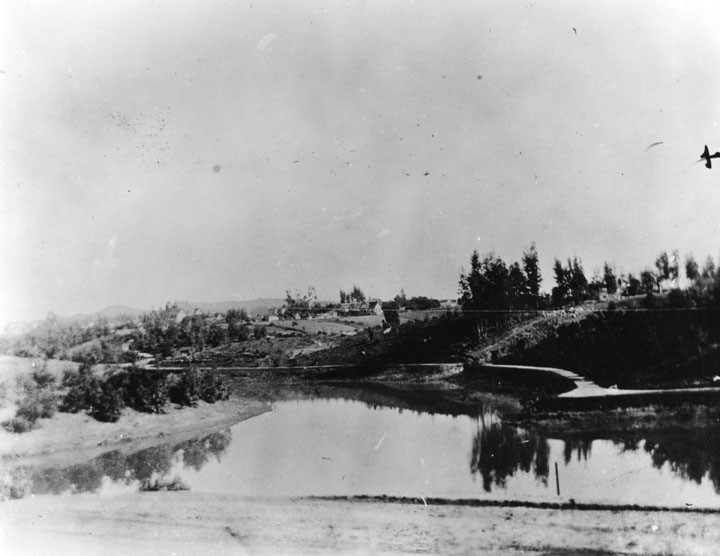 |
|
| (ca. 1896)^ – Early view of Hollenbeck Park and lake in Boyle Heights, just after it was created. |
Historical Notes Hollenbeck Park was a reflection of a citywide effort to establish "pleasure grounds" as part of a national "city beautiful" movement that encouraged healthful and attractive oases in urban environments. Consequently, several parks sprung up in the city during the late 1880s and early 1890s including Westlake Park, Elysian Park, Griffith Park and others. The location of the park was a natural arroyo that existed across Boyle Avenue from Mrs. Elizabeth Hollenbeck's estate and a key component of the creation of the facility was the establishment of a dam and reservoir that served as a lake for the new park.* |
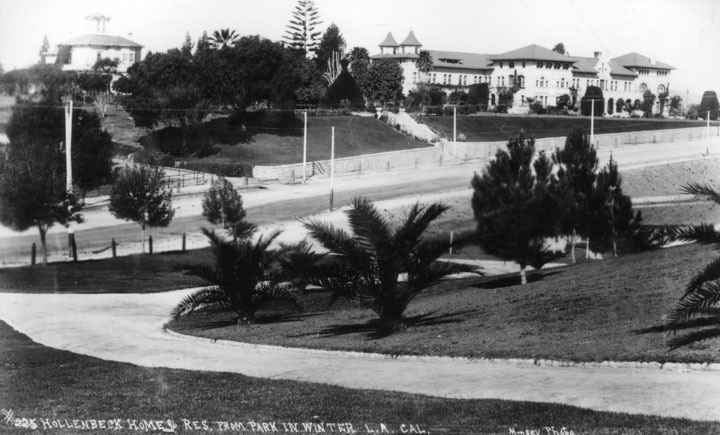 |
|
| (ca.1896)^ – View showing Hollenbeck Park in the foreground with the original J.E. Hollenbeck Residence in the upper-left and the Hollenbeck Home for the Aged in the upper-right. |
Historical Notes William Workman and Elizabeth Hollenbeck, whose late husband John invested heavily in Los Angeles-area real estate and banking before his 1885 death, agreed to donate fifteen and ten acres, respectively, to the city for a new Boyle Heights park to be dedicated to John Hollenbeck. The main condition was that the city commit to spending $10,000 over two years for improvements and the council approved the proposal by early 1892.* |
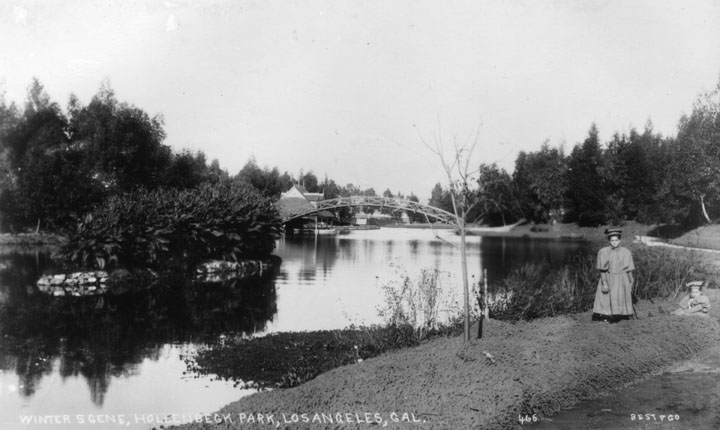 |
|
| (ca. 1890s)^ - In a photo entitled "Winter Scene, Hollenbeck Park, Los Angeles, Cal.," a woman and child are shown near the lake. |
Historical Notes The effort to plant trees, bushes and shrubs and grass and lay out walkways, benches and other amenities took some time and the park was dedicated in the middle of 1893. Within a couple of years, a boathouse was established and a franchise awarded for the operation of pleasure boats on the lake.* |
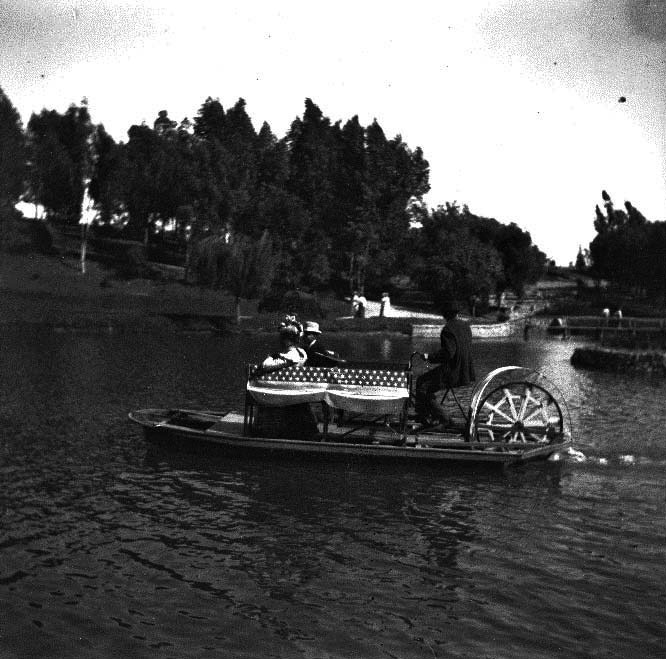 |
|
| (ca. 1898)^*# – View showing a man steering a bicycle boat with passengers on the lake at Hollenbeck Park. |
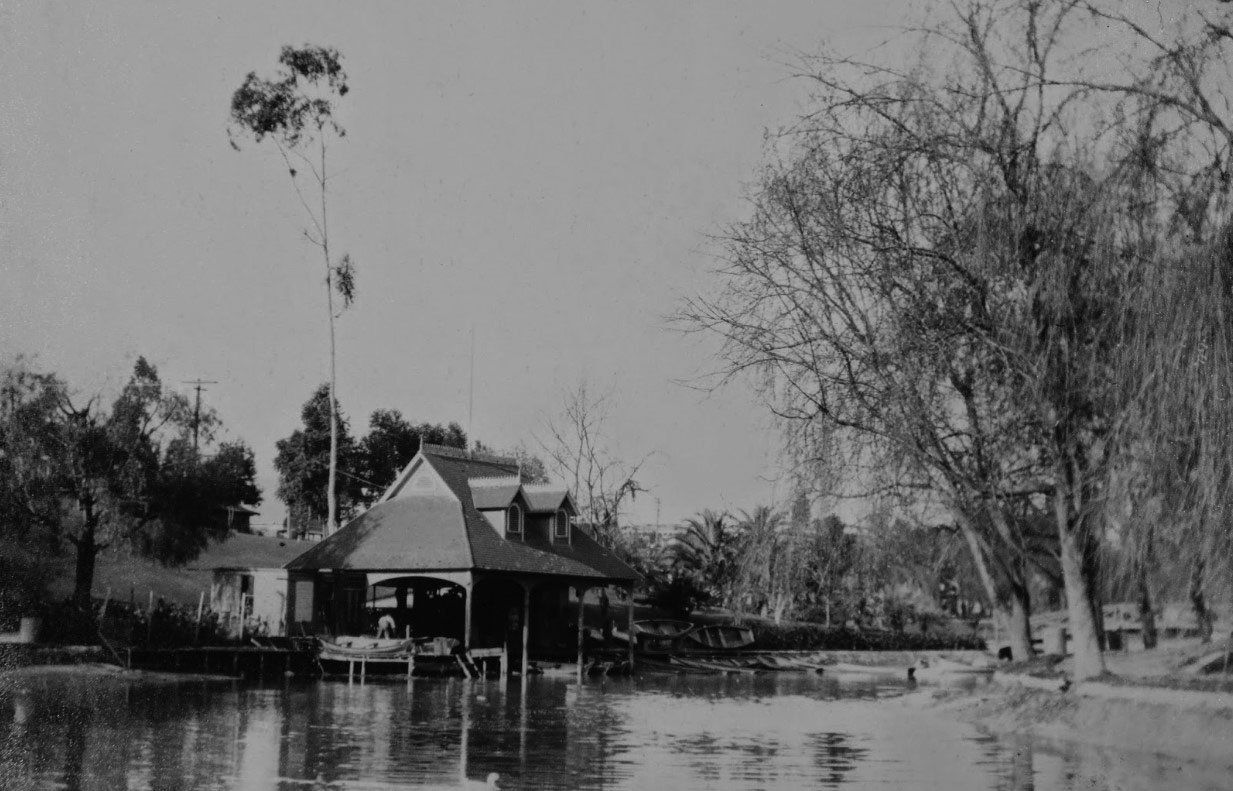 |
|
| (1914)* - A view of the original boathouse, built in the 1890s. From the collection of the Workman and Temple Family Homestead Museum, City of Industry, California. |
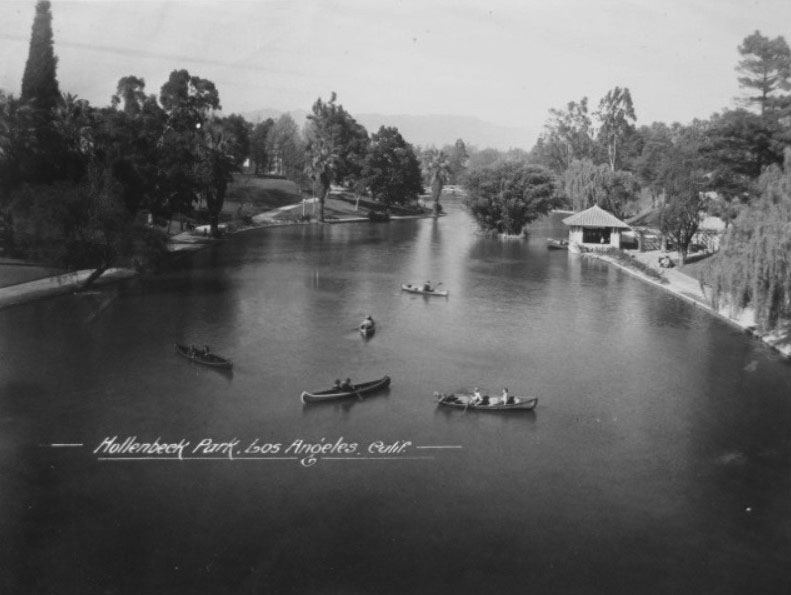 |
|
| (n.d.)^ - View showing several people in canoes enjoying the placid waters of the lake in Hollenbeck Park. The boathouse is visible to the right along the lake's edge; a small island, Bamboo Island, sits in the middle of the lake; beyond that, an arched bridge can be partially seen behind still more tree foliage. |
Historical Notes Hollenbeck Park was easily the most visible aspect of Boyle Heights, with many postcards, including real photo cards, professionally published in the first few decades of the 20th century demonstrating its importance. * |
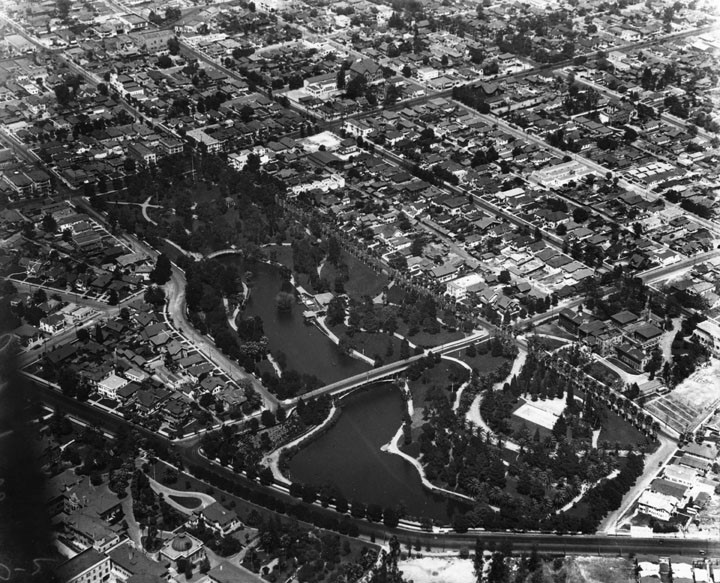 |
|
| (1924)^ - Aerial view of Hollenbeck Park and surrounding area. Hollenbeck Home for the Aged can be seen at center-right. |
Historical Notes Over time, development continued to accelerate near the park and elsewhere in Boyle Heights, although development trends in west Los Angeles and the emerging industrial core of the east part of downtown brought about a transformation of Boyle Heights from a middle and upper class residential suburb to a working and middle class enclave.* |
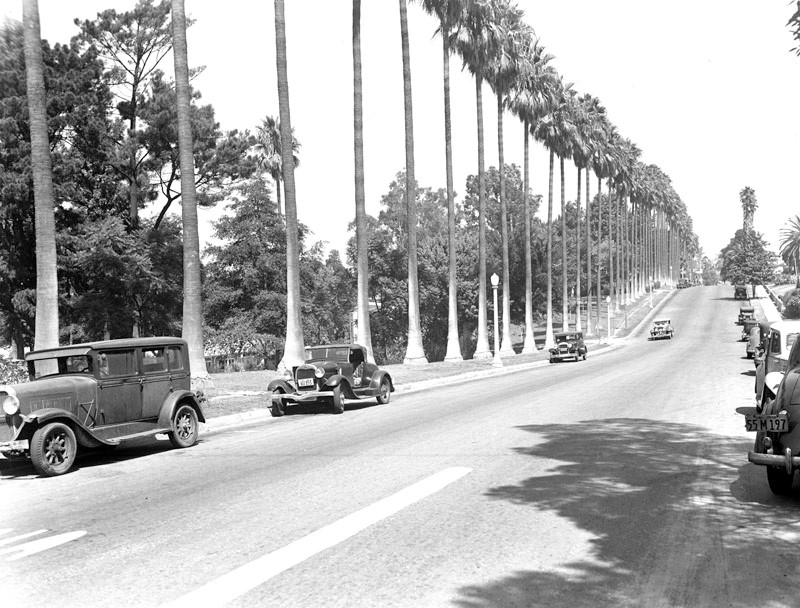 |
|
| (ca. 1935)^ - Tall palms along the street skirting Hollenbeck Park. |
Historical Notes In the 1950s, the Golden State Freeway was built against the western boundary of Hollenbeck Park.*^ |
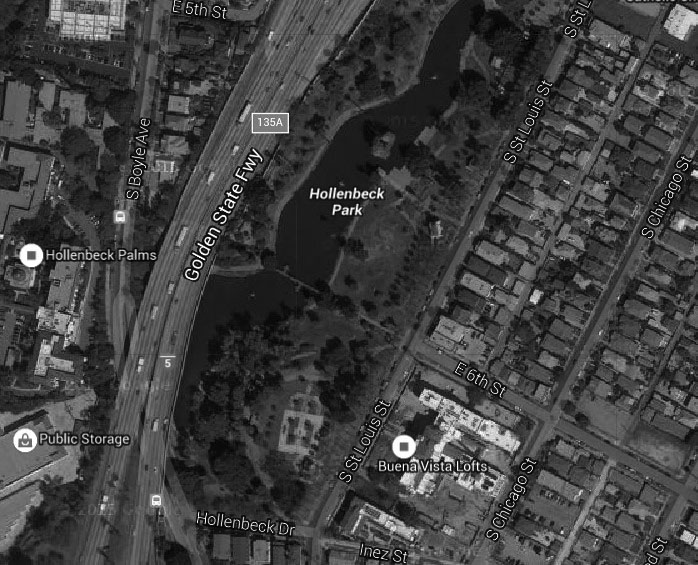 |
|
| (2015)#*^# - Google satellite view showing Hollenbeck Park and surrounding area. |
Historical Notes Some of the Park's features include a man-made lake, rolling hills, towering palms, picnic areas, and even a skateboard park. Hollenbeck Park is located at 415 South Saint Louis Street and the corner of Fourth Street in the Boyle Heights area of Los Angeles.^ |
* * * * * |
Los Angeles Athletic Club
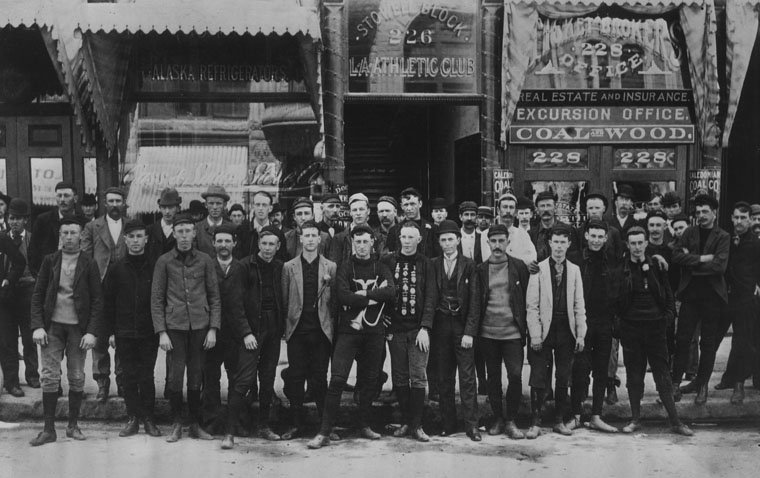 |
|
| (1893)^ - Members of the Los Angeles Athletic Club pose in front of the building for a group portrait. The club was located at 226 South Spring Street in the Stowell Block. A young man in front (center) is covered in medals. |
Historical Notes It was on the night of September 8, 1880, in the old Arcadia building located on North Spring Street, that the Los Angeles Athletic Club was born. Forty prominent Angelinos - sons of pioneers, adventurers and athletes - gathered in Frank Gibson's law office to create an American Style Club. During the late 1800's, The Club became a haven for up and coming members of the Los Angeles community. Health, recreation, grace and vigor became the motto of this distinguished club.*#^ The Los Angeles Athletic Club used several locations before settling into its own twelve story building in downtown Los Angeles in 1912. The LAAC building was notable at the time for being the first building in Southern California to have a swimming pool on an upper floor.*^ |
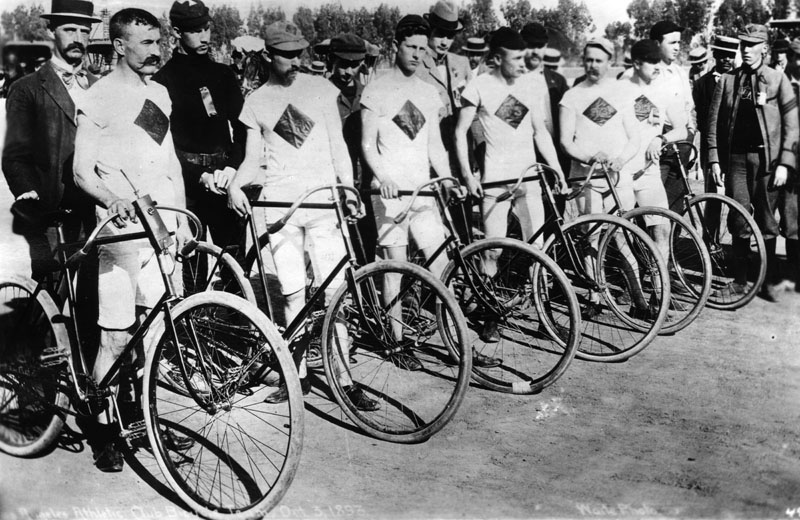 |
|
| (1893)^ - Photo of the Athletic Club bicycle team taken before the 2T mile race at Agriculture Park, October 3, 1893. |
Historical Notes Athletes from the Los Angeles Athletic Club have earned numerous medals in the Summer Olympics, with a particularly high number during the 1932 Los Angeles Olympiad. The total medal tally for the LAAC is 97 medals, including 47 gold.*^ |
* * * * * |
Agricultural Park (later Exposition Park)
.jpg) |
|
| (1893)^^ - Agricultural Park (later renamed Exposition Park) Start of 25 mile bicycle race, October 3, 1893. |
Historical Notes In 1880, John Hollenbeck, with former California Governor John G. Downey, horticulturalist Ozro W. Childs and other associates, persuaded the State of California to purchase 160 acres in Los Angeles to foster agriculture in the southland. The property, then known as Agricultural Park, is now known as Exposition Park, home to the Los Angeles Coliseum and the Los Angeles County Museums.*^ |
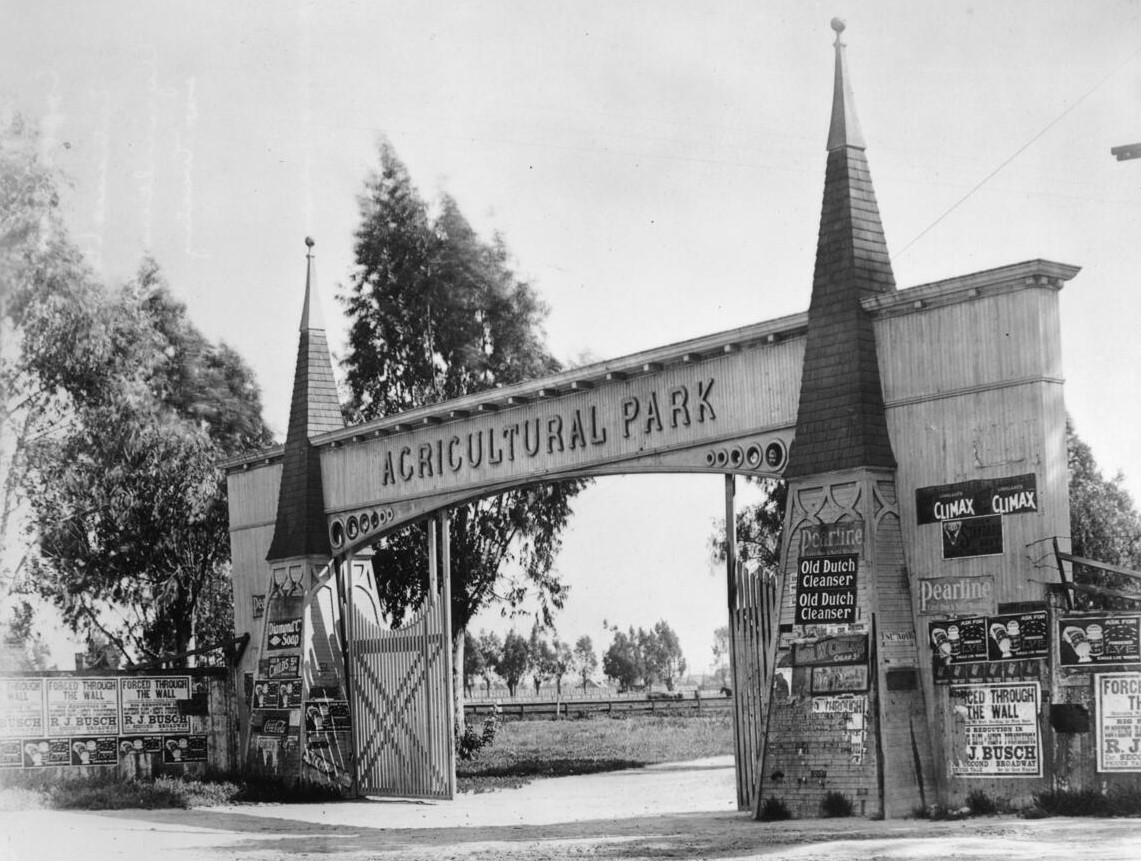 |
|
| (ca. 1910)^ - Before Exposition Park, Los Angeles had Agricultural Park, at the same spot. Right here. Seen here is the Wesley Avenue entrance. |
Historical Notes Exposition Park was originally created as an agricultural park, and 160 acres were set aside for the Southern District Agricultural Society. In 1913, it was renamed Exposition Park according to the “City Beautiful” movement with 4 anchor tenants: California Museum of Science and Industry (Exposition Building), National Armory, Domed National History Museum and the Sunken Garden (which in 1928 was later renamed the Rose Garden).^### |
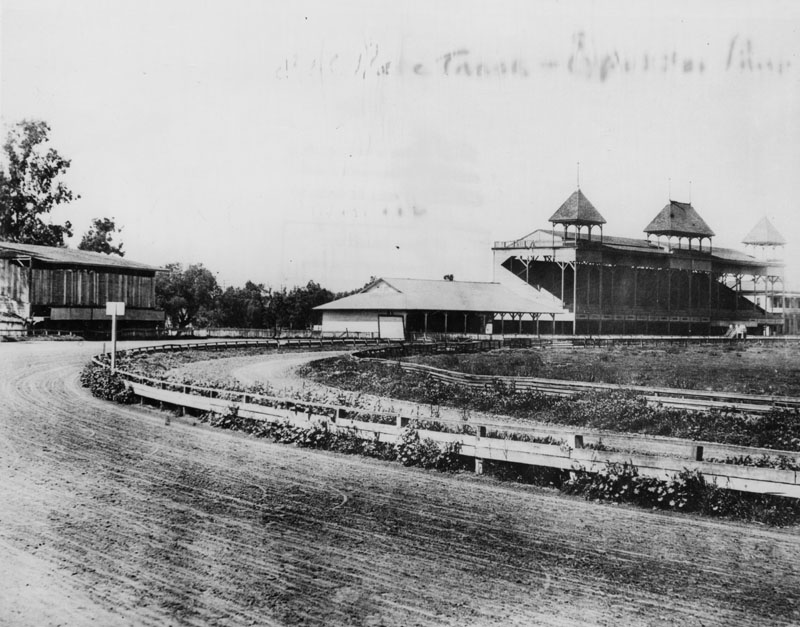 |
|
| (ca. 1900)^ - Partial view of the racetrack at Agricultural Park (later Exposition Park) in the early 1900s. Photograph shows the grandstand with three open towers, an adjacent smaller structure, possibly a concession stand, and another unidentified structure on the extreme left. |
Historical Notes Originally, this piece of land served as an agricultural fairground from 1871 to 1911. Farmers sold their harvests on the grounds, while horses, dogs, camels, and later automobiles, competed along the racetrack (seen).^ |
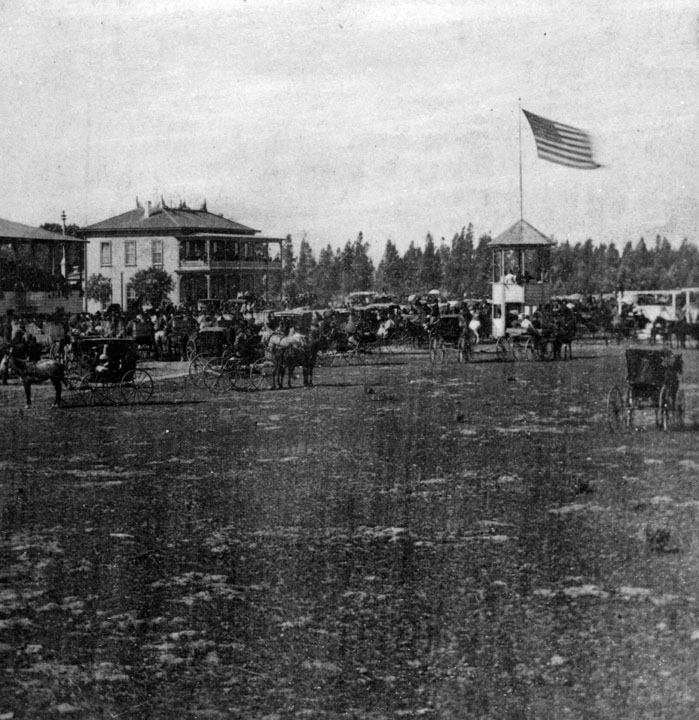 |
|
| (ca. 1890s)^ - Race day at Agricultural Park, taken sometime before 1900. The Club House is in the background. |
Historical Notes In the late 1800s and early 1900s, the city's most influential families moved into the neighborhood but did not appreciate the racing and gambling that came with it. As a result, this racetrack was transformed into the now-famous Exposition Park Rose Garden.^ |
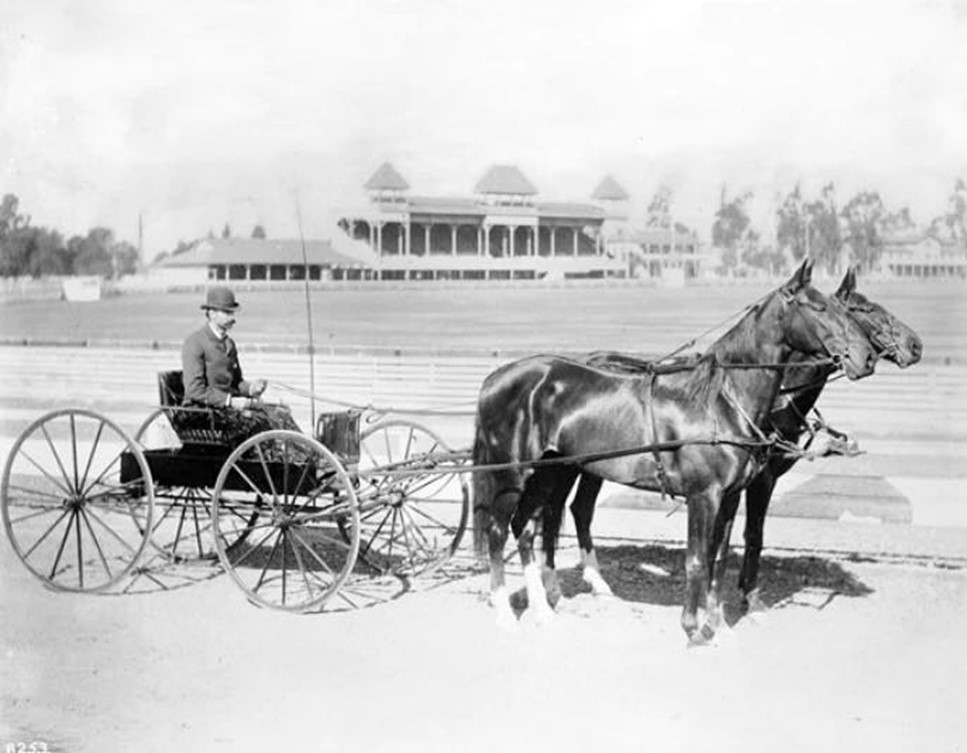 |
|
| (1895)* - Photograph of Captain Pierce of the Los Angeles Police Department on carriage with race horse team at the Agricultural Park Horse Show. Behind the Captain and his horse team are the race tracks. In the distances are the buildings and seating to accommodate the audiences that attend the races. |
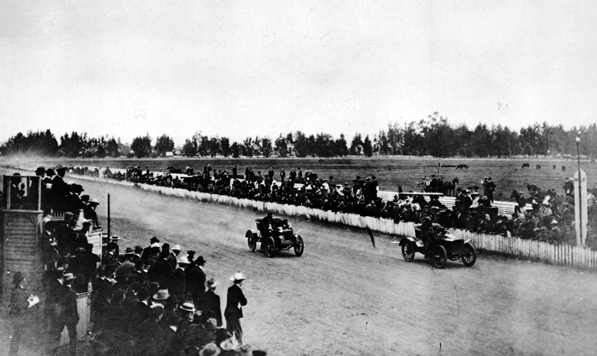 |
|
| (1903)*^#* - View showing a large crowd watching an automobile race in Agricultural Park. |
Historical Notes In 1909, plans were nearly complete for the building of the Natural History Museum (only then it was the Museum of History, Science, and Art) and a state armory. Bids were solicited. The next year, the site changed its name from Agricultural to Exposition park.^ |
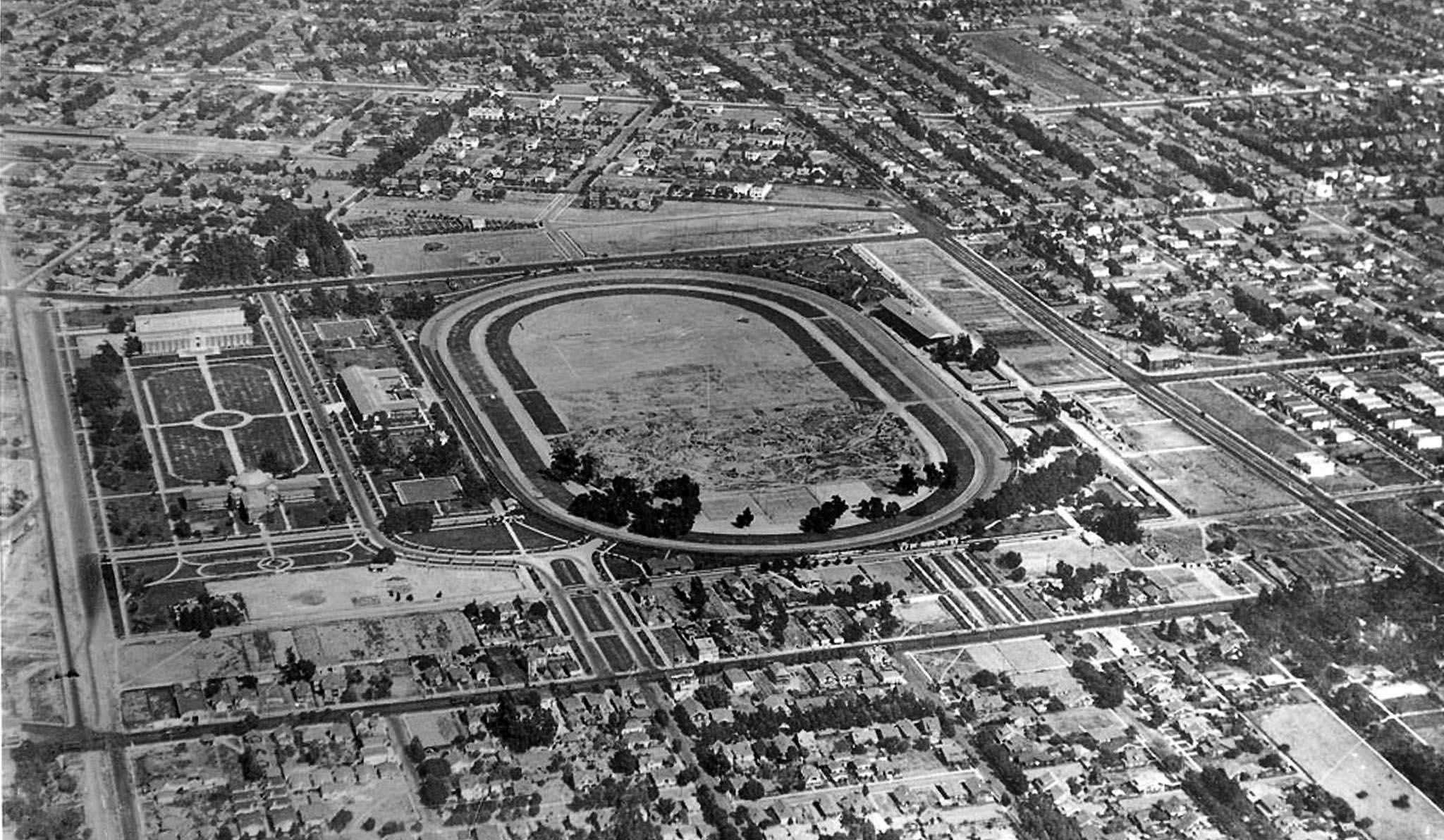 |
|
| (1918)*#^* - This aerial photo was taken five years after Exposition Park first opened (Nov. 6, 1913). Note the mile-long auto track, a feature that disappeared after the Coliseum was built in 1923. Click HERE to see more of the Coliseum at Early City Views (1900 - 1925). |
* * * * * |
Mt. Lowe Railway
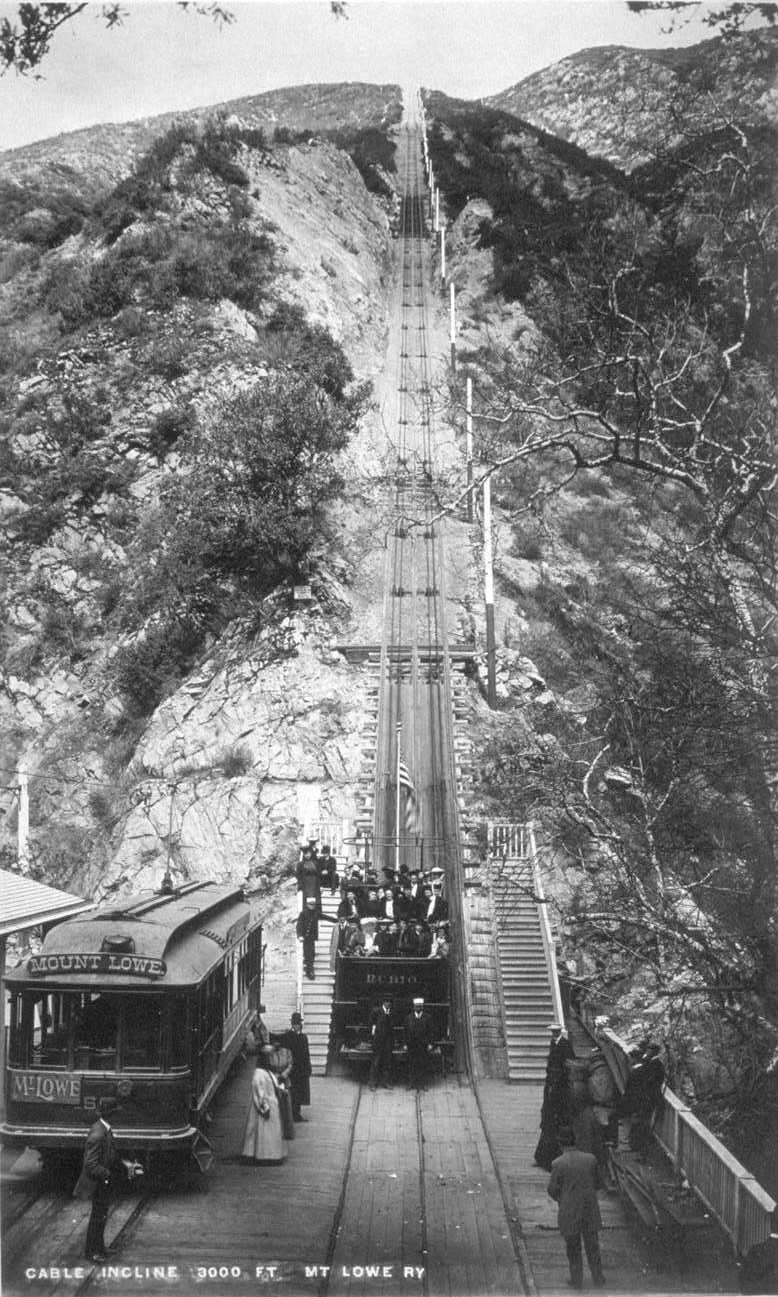 |
|
| (1893)^^ - The great Cable Incline (seen above) went from Rubio Pavilion (the bottom) to Echo Mountain (at the top). In this picture one of the black cable cars, named "Rubio" sits at the bottom with some passengers aboard and others waiting nearby. Also on the left is the electric car which brought customers to the station from Mountain Junction. |
Historical Notes At the turn of the century (1893 - 1938) one of the most famous excursion in Southern California was the Mt. Lowe trip. Sightseers from all around the Los Angeles area took a Pasadena car to Altadena and Rubio Canyon. They then transferred to a cable car on the Incline Railway that went up a 62% grade to Echo Mountain. From there they would take a narrow-gauge trolley car winding its way up the rugged San Gabriel Mtns. and finally would arrive at Alpine Tavern on Mt. Lowe, a nearly 7 mile railway ride from the base of the mountain. The views of the valley floor and beyond were spectacular.^ |
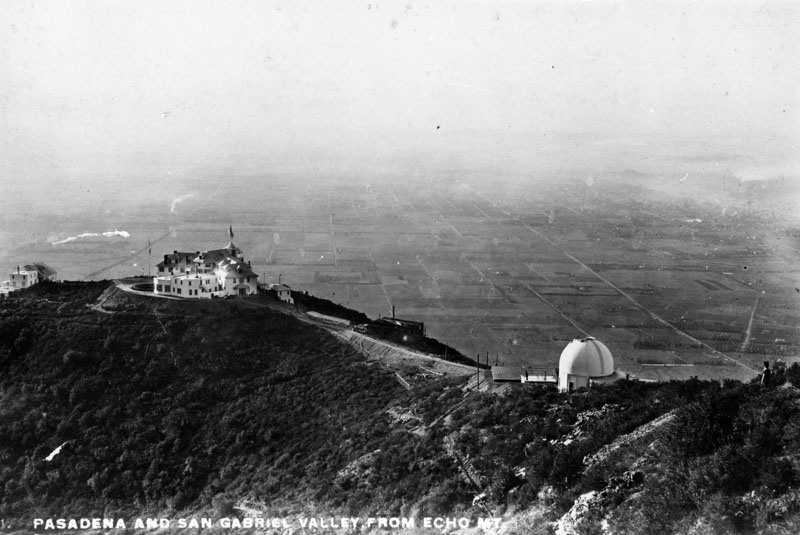 |
|
| (ca. 1890s)^ - View overlooking Echo Mountain with Pasadena and the San Gabriel Valley in the background below. |
Historical Notes Buildings at Echo Mountain, reached by the Mount Lowe Railway, included the Echo Mountain House, a 70-room hotel at an elevation of approximately 3500 ft., the 40-room Echo Chalet, the observatory, car barns, dormitories, repair facilities, and a casino/dance hall.^ Click HERE to see more in Early Views of Mt. Lowe Railway. |
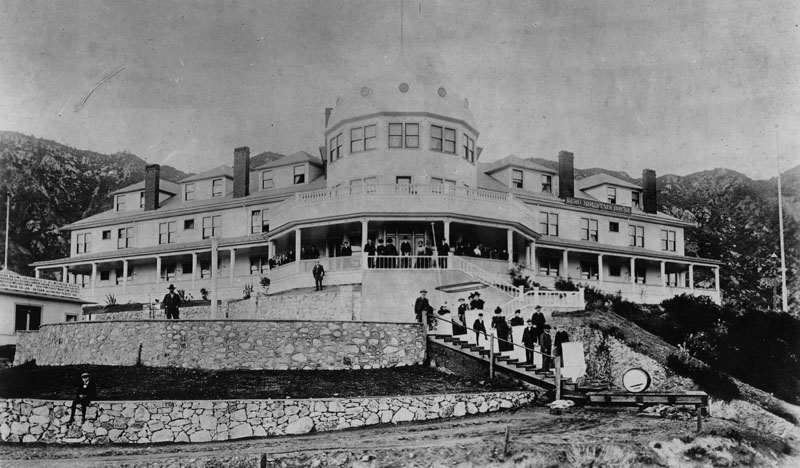 |
|
| (ca. 1890s)^ - View of some of the hotel guest standing on the veranda and stairways at the front of Echo Mountain House. |
Historical Notes Completed in the fall of 1894, the Echo Mountain House was a marvel. The four-story Victorian building was marked by a tall, cylindrical tower and capped by a metal dome and a huge American flag. The bright white exterior was marked by a long row of windows on each floor. At the building’s entrance, two sweeping verandas looked off across the canyons and the valley. The interior of the hotel was extravagant, with detailed wood inlay, the finest floral-patterned carpet and handmade furniture throughout. There were seventy guest rooms, large areas for office space, a massive social hall and dining room, a souvenir shop, a Western Union office, a bowling alley, a billiard room, a barbershop and a shoeshine stand.^^## |
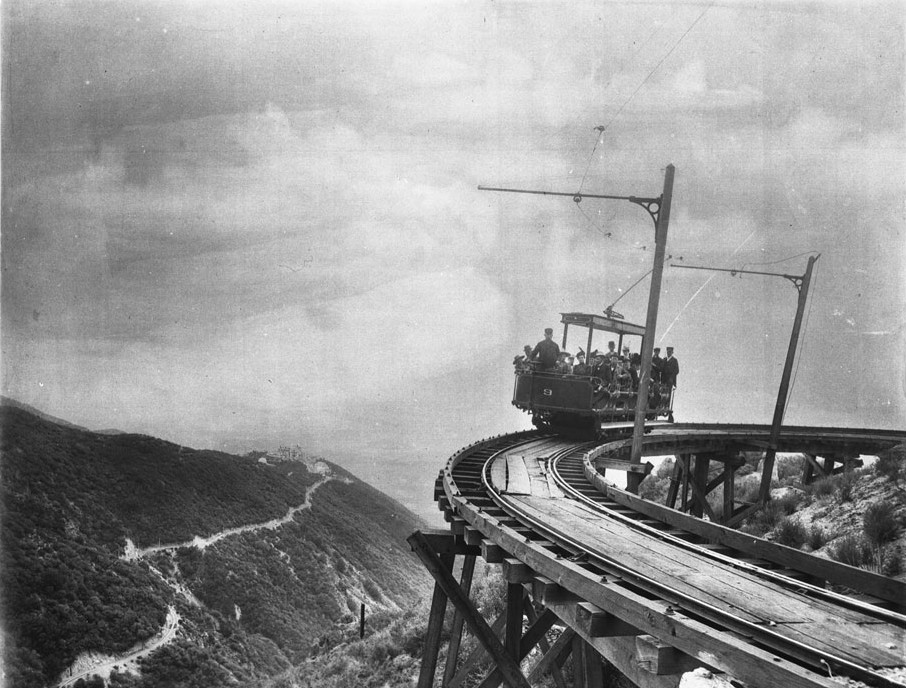 |
|
| (1893)^^ - Photograph of the first passengers of Professor S.C. Lowe's dramatic Mount Lowe Railway, July 4, 1893. There are a couple of dozen people in the rail car (number "9") which is headed toward the camera on the circular bridge. The trestle structure is visible below the rails. The hotel on the mountaintop is visible at left as is the rail approach to the hotel. |
Historical Notes From the top of Echo Mtn, passengers could transfer to another trolley line, the Alpine Division, which would take them to the upper terminus at Crystal Springs and Ye Alpine Tavern, a 22-room Swiss Chalet hospice with a complement of amenities from tennis courts, to wading pools, to mule rides. This phase of tracks cut through the broad Las Flores Canyon which gave a tremendous panorama of the valley floor below. At one point a tall trestle was required to bridge a broad and deep chasm with a bridge so named High Bridge.*^ |
Click HERE to see more in Early Views of Mt. Lowe Railway |
* * * * * |
Long Wharf (Pacific Palisades)
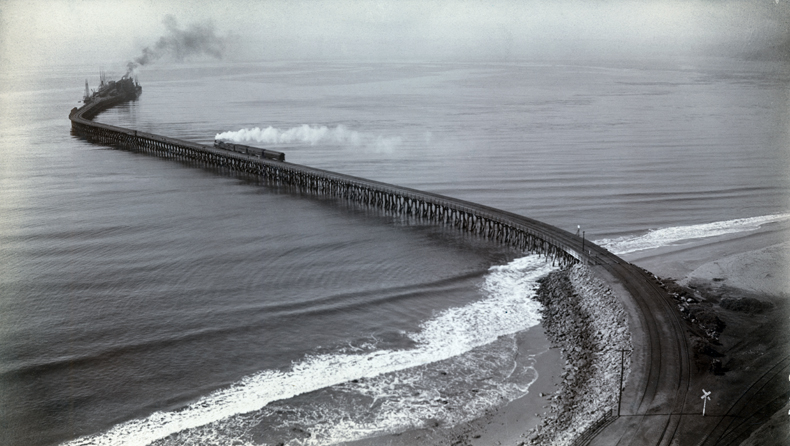 |
|
| (ca. 1893) - Aerial view of the Southern Pacific Mammoth Wharf, Port Los Angeles, Calif. The wharf was also known as the old Santa Monica Long Wharf, north of Canyon. A white cloud of smoke can be seen from a train travelling on the tracks to the business end, at the end of the wharf. |
Historical Notes When the Southern Pacific Railroad arrived at Los Angeles, a controversy erupted over where to locate the city's main seaport. The SPRR preferred Santa Monica, while others advocated for San Pedro Bay. The Long Wharf was built in 1893 at the north end of Santa Monica to accommodate large ships and was dubbed Port Los Angeles. At the time it was constructed, it was the longest pier in the world at 4700 feet, and accommodated a train.*^ Also known as the Los Angeles Long Wharf the site was designated as California Historical Landmark No. 881 (Click HERE to see California Historical Landmarks in LA). |
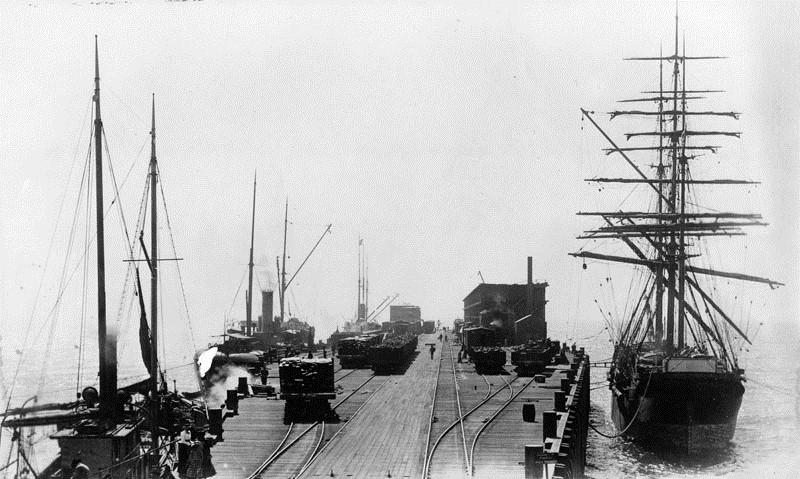 |
|
| (1898)^ - Photo shows the business end of the mammoth wharf (Long Wharf) in Santa Monica. Several fully loaded railcars can be seen. |
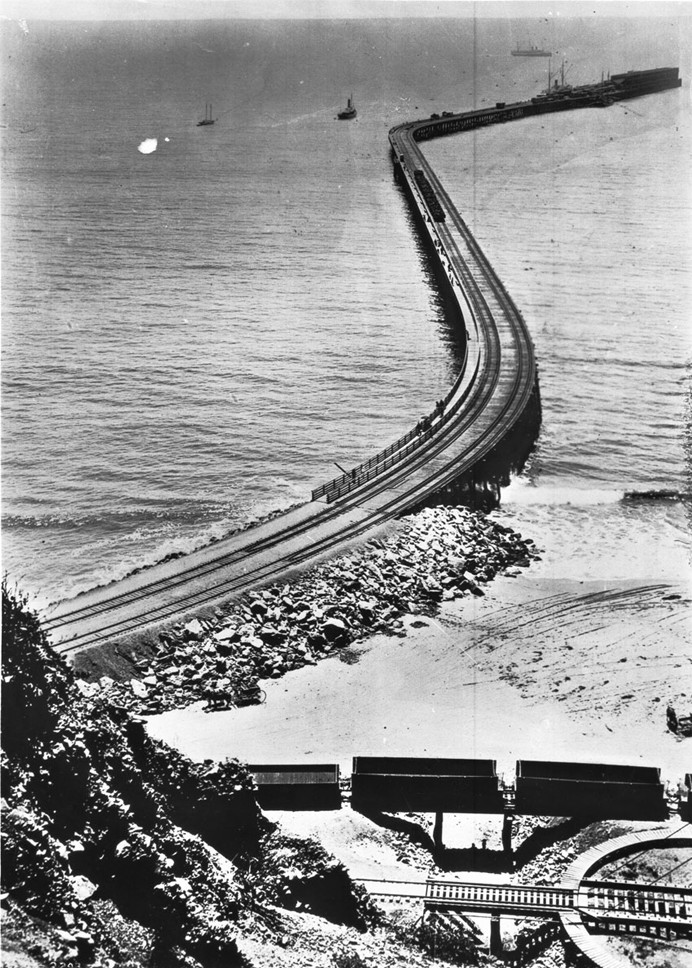 |
|
| (1893)^^ - View of the entire length of the Long Wharf from the beach all the way to its extremity almost a mile away. Note the RR turntable in the lower right corner. A horse-drawn carriage can be seen on the beach between the rail cars and the wharf. Empty railcars sit on a bridge over a gully. |
Historical Notes In 1897, San Pedro Bay, now known as the Port of Los Angeles, was selected by the United States Congress to be the official port of Los Angeles (Port of Los Angeles) over Santa Monica. Still, the Long Wharf acted as the major port of call for Los Angeles until 1903. Though the final decision disappointed the city's residents, the selection allowed Santa Monica to maintain its scenic charm. The rail line down to Santa Monica Canyon was sold to the Pacific Electric Railway, and was in use from 1891 to 1933.*^ Click HERE to see more in Early Views of San Pedro and Wilmington. |
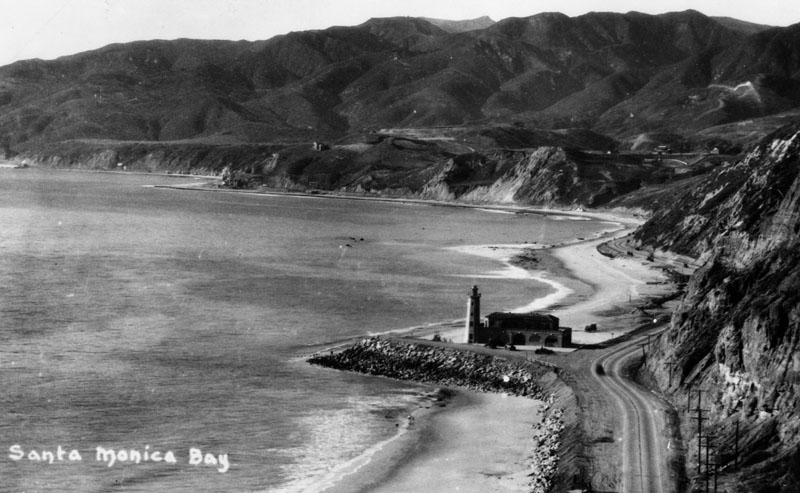 |
|
| (ca. 1927)^ - View of the Santa Monica Bay coastline, showing a lighthouse and bathhouse near the Pacific Palisades. The lighthouse stands at the spot where the Long Wharf used to extend out into the ocean. |
Historical Notes The Pacific Palisades lighthouse was built as a bathhouse with a working light in 1927. In the early 1930s the structure along with the beach was sold to Will Rogers and later the beach was given to the state of California and renamed the Will Rogers State Beach.^ |
Click HERE to see more in Early Views of the Long Wharf |
* * * * * |
Santa Monica
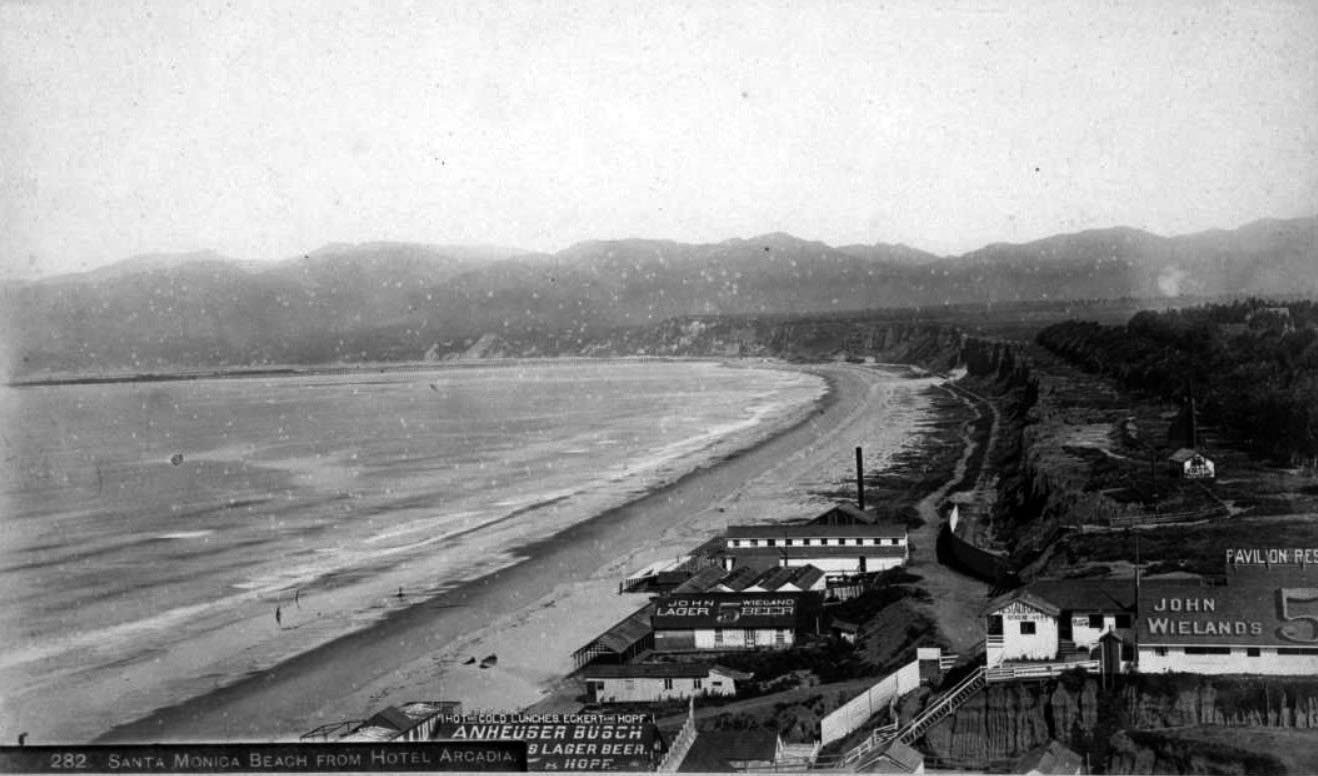 |
|
| (1893)#^^ - View showing restaurants on the North Beach, as seen from the Arcadia Hotel. Signs on the restaurants read "Hot and cold lunches, Eckert and Hopf, Anheuser Busch Lager Beer" "Pavilion Restaurant" and "John Wieland lager beer." The Santa Monica Bath House is seen beyond the "John Wieland" sign, with a bandstand shell on the bluffs above (in present-day Palisades Park) and the Long Wharf visible in the distance. |
 |
|
| (ca. 1895)* - A panoramic view of one of the ocean piers and parks along the ocean before 1900. Huge cowds are on the pier and on the beach next to it. |
Historical Notes In 1895, Abbot Kinney acquired the deed to the coastal strip previously purchased by W.D. Vawter and named the area Ocean Park. It became his first amusement park and residential project. A race track and golf course were built on the Ocean Park Casino. After a falling out with his partners he focused on the south end of the property, which he made into Venice of America.*^ Click HERE to see more in Early Southern California Amusement Parks. |
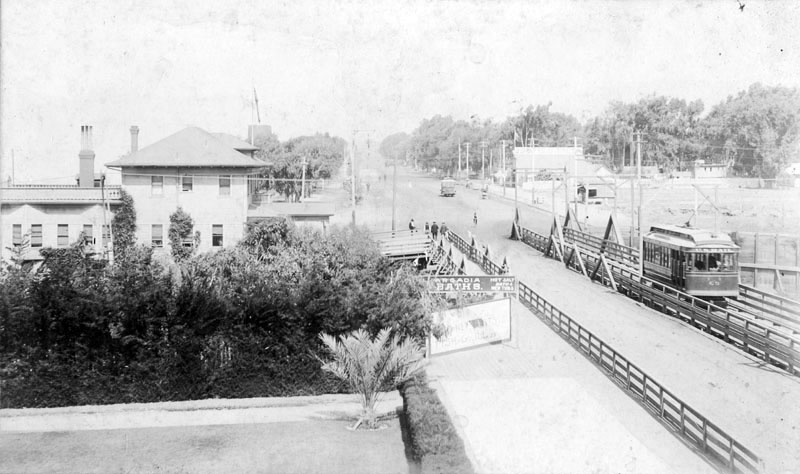 |
|
| (1896)^ - View is looking north across the bridge on Ocean Avenue, from the Arcadia Hotel. A trolley can be seen on the right. In the middle of the photograph, a sign reads "Arcadia Baths, hot salt baths, new tubs." |
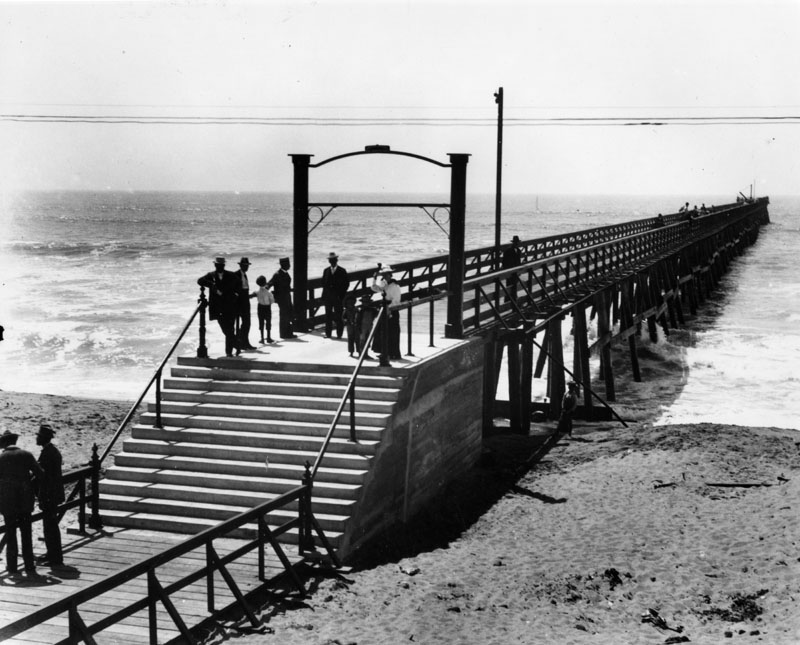 |
|
| (ca. 1897)^ - A view of the 500 ft. long Ocean Park pier, built by the Santa Fe Railroad in 1895, and located about 300 feet south of Hill St. This view shows several people standing on the pier as we look towards the ocean. |
Click HERE to see more in Early Views of Santa Monica. |
* * * * * |
Marina del Rey
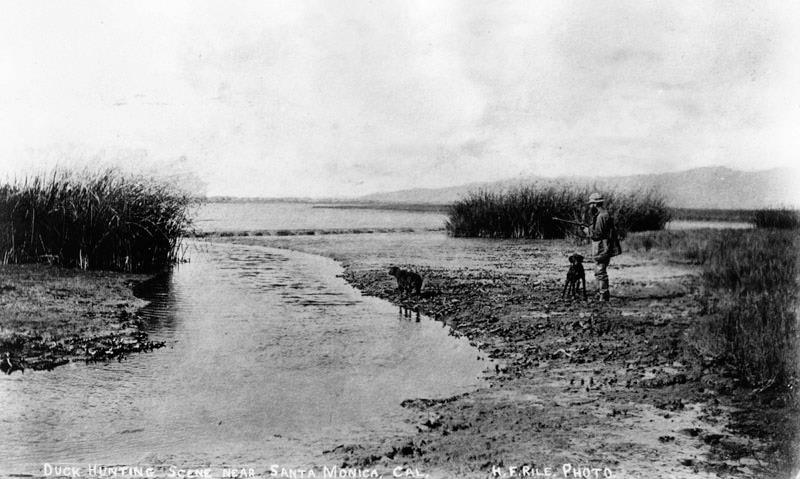 |
|
| (1890)*#*^ - Duck hunting in what is now known as the Marina del Rey. |
Historical Notes Prior to its development as a small craft harbor, the land occupied by Marina del Rey was a salt-marsh fed by fresh water from Ballona Creek, frequented by duck hunters and few others. Burton W. Chace, a member of the Los Angeles County Board of Supervisors, referred to the area as mud flats, though today the area would more properly be referred to as wetlands.*^ Click HERE to see more Early Views of Marina del Rey. |
* * * * * |
Playa del Rey
.jpg) |
|
| (ca. 1902)^^ – View looking east showing a well-dressed man holding his shoes while standing knee deep in the Playa del Rey lagoon. |
Historical Notes The Playa del Rey area, located about two miles south of Kinney's Venice of America resort, was once, centuries ago, the mouth of the Los Angeles River. But after the river shifted course to begin emptying in Los Alamitos Bay in Long Beach, it left behind a sleepy lagoon more than two miles wide and one fifth of a mile wide with a trickle of fresh water flowing to sea along La Ballona Creek. Click HERE to see more Early Views of Playa del Rey. |
* * * * * |
Pico Boulevard
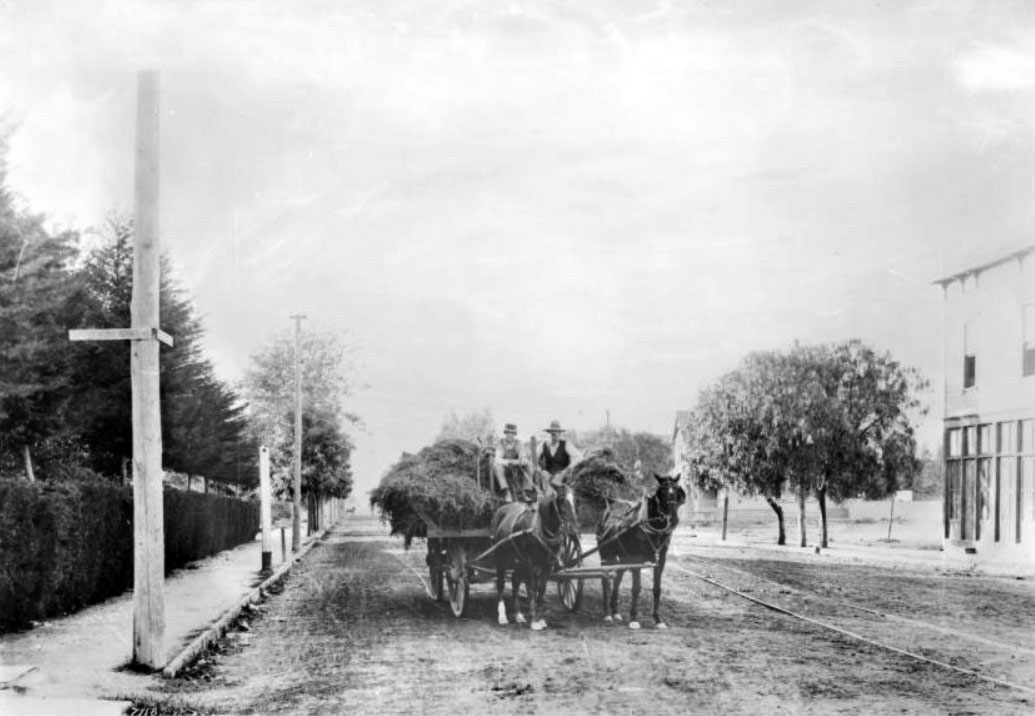 |
|
| (1888)^^ - Photographic portrait of brothers Ralph and Clarence Kinkaid with a load of hay on Pico Boulevard looking east from Figueroa Street. The two brothers sit at the help of a horse-drawn wagon loaded with hay, which spills out from either side. The residence of Judge O. Melveny is located on the northeast corner of the street while the Fred Barnen residence is located on the southeast and the Horace Bell on the southwest. The Kinkaid's ranch itself is located on the northwest corner. Streetcar rails are visible in the unpaved road. Click HERE to see contemporary view. |
Then and Now
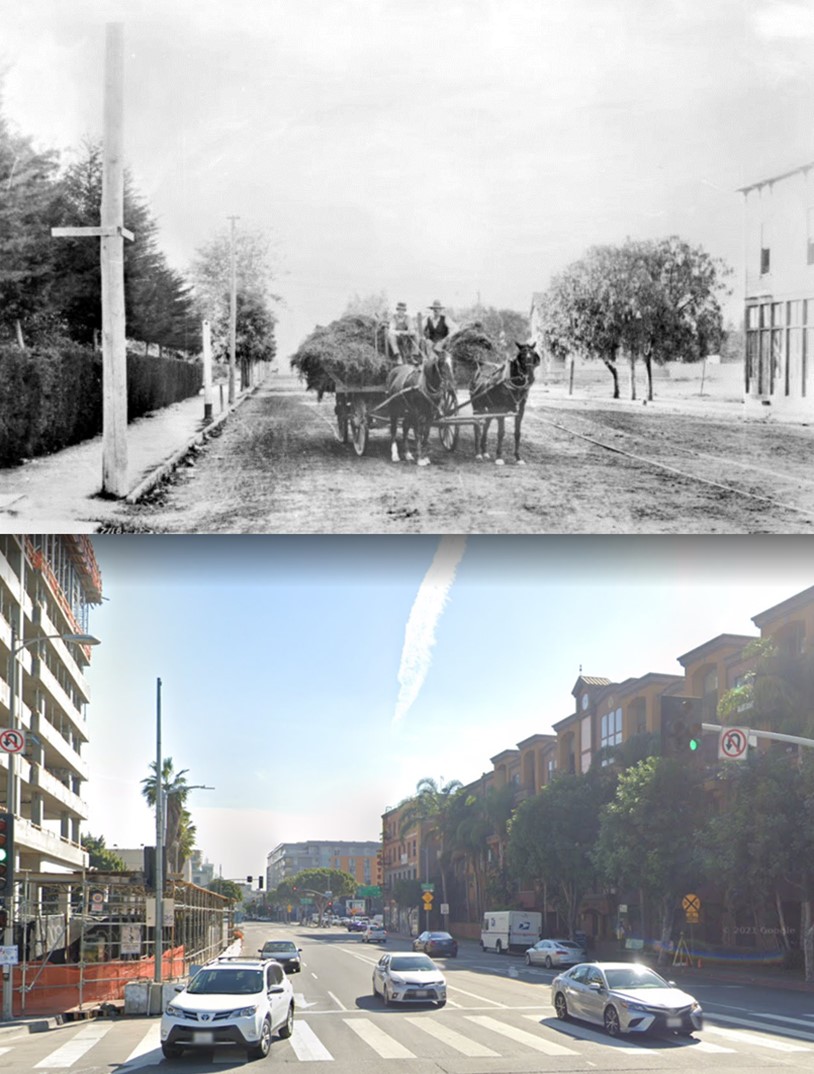 |
|
| (1888 vs. 2021)* – Looking East on Pico Boulevard at Figueroa Street. |
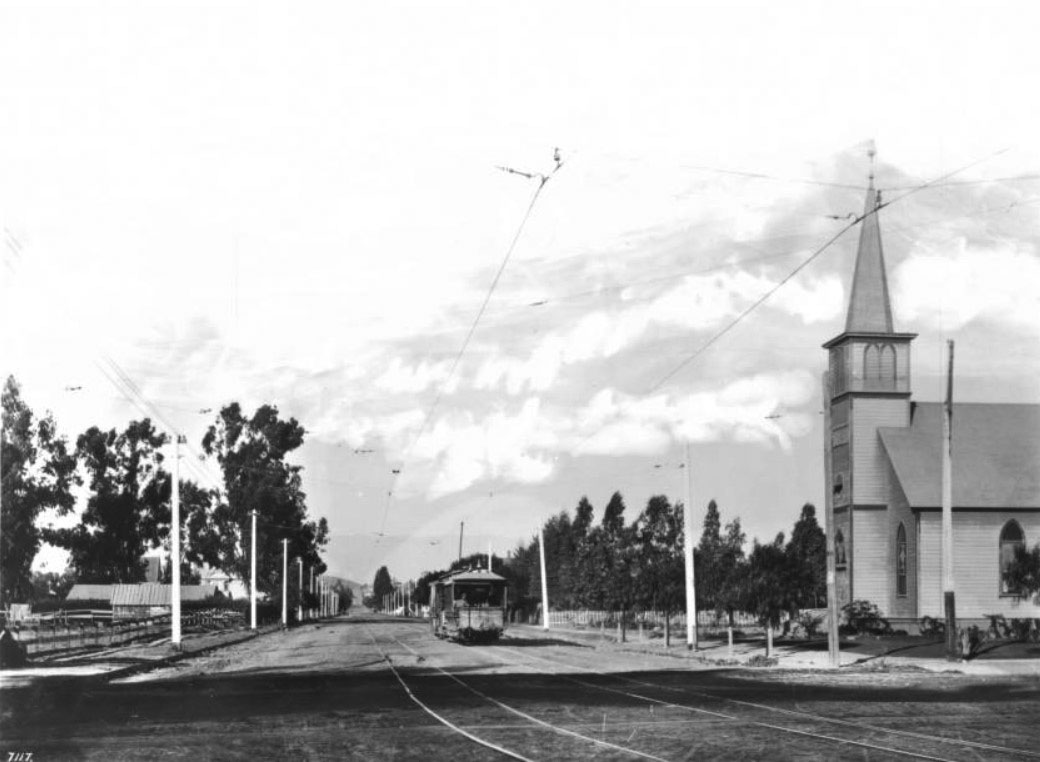 |
|
| (1897)^^ - View of Flower Street looking north from Pico Boulevard. A cable-car makes its way down the unpaved road, with a second set of tracks to the left of it, passing a church to the right. Sidewalks line either side of the street. To the left, a post-and-rail fence surrounds what appears to be a chicken coop and a small pasture. Click HERE to see contemporary view. |
Then and Now
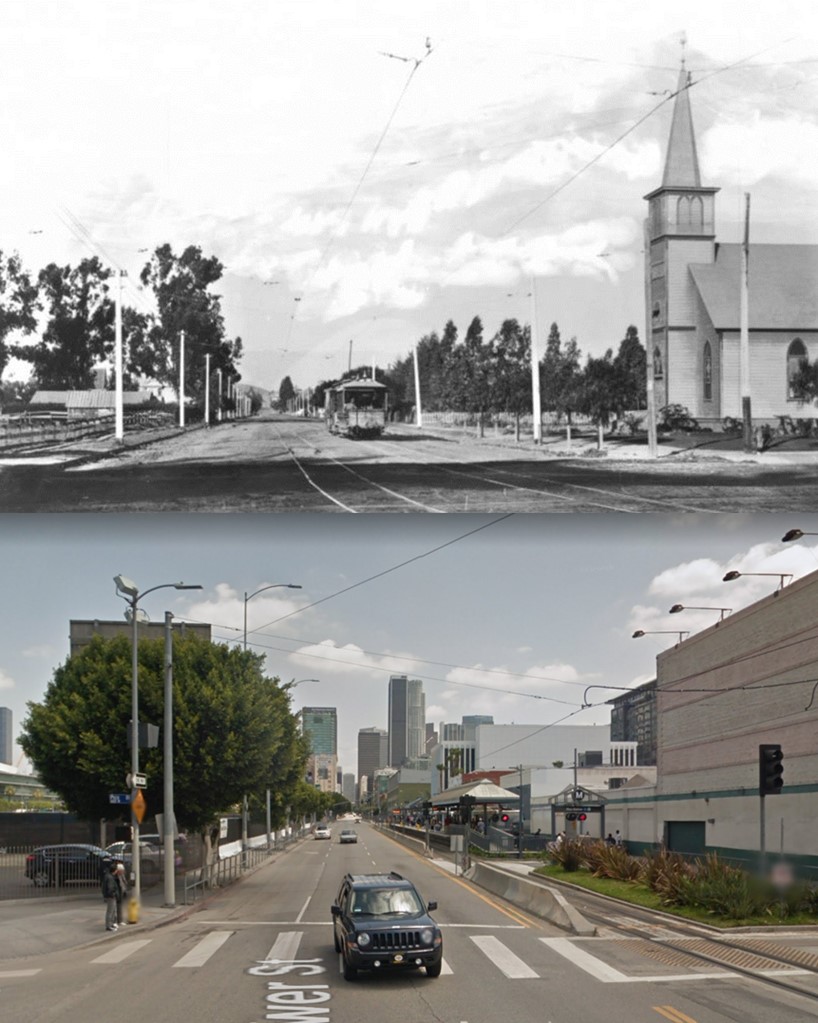 |
|
| (1897 vs. 2015)* – Looking North on Flower Street from Pico Boulevard. |
.jpg) |
|
| (1895)^ - Farm operations on the Mark C. Jones tract, at what is now Alvarado Street and Pico Boulevard, in 1895. William Dibble is standing in the wagon. |
Historical Notes In 1897, the Los Angeles Golf Club (predecessor of the Los Angeles Country Club) leased the land seen above and built a nine-hole golf course that came to be known as "Windmill Links," due to the use of an old windmill as the clubhouse. Jones subdivided the land into residential lots in 1902. The lots were sold for $10 each, with the caveat that the buyer was required to build a house costing at least $4,000. The area was promoted as a "second Chester Place," referring to the city's most prestigious street in the West Adams district. By 1906, the development was full. Alvarado Terrace Historical District is a designated historic district southwest of Downtown Los Angeles, located along Alvarado Terrace between Pico Boulevard and Alvarado Street. Six homes and a church in the district were designated as Historic-Cultural Monuments in 1971, and the entire district was listed in the National Register of Historic Places in 1984.*^ Click HERE to see complete list of LA HIstoric-Cultural Monuments. |
* * * * * |
Chinatown
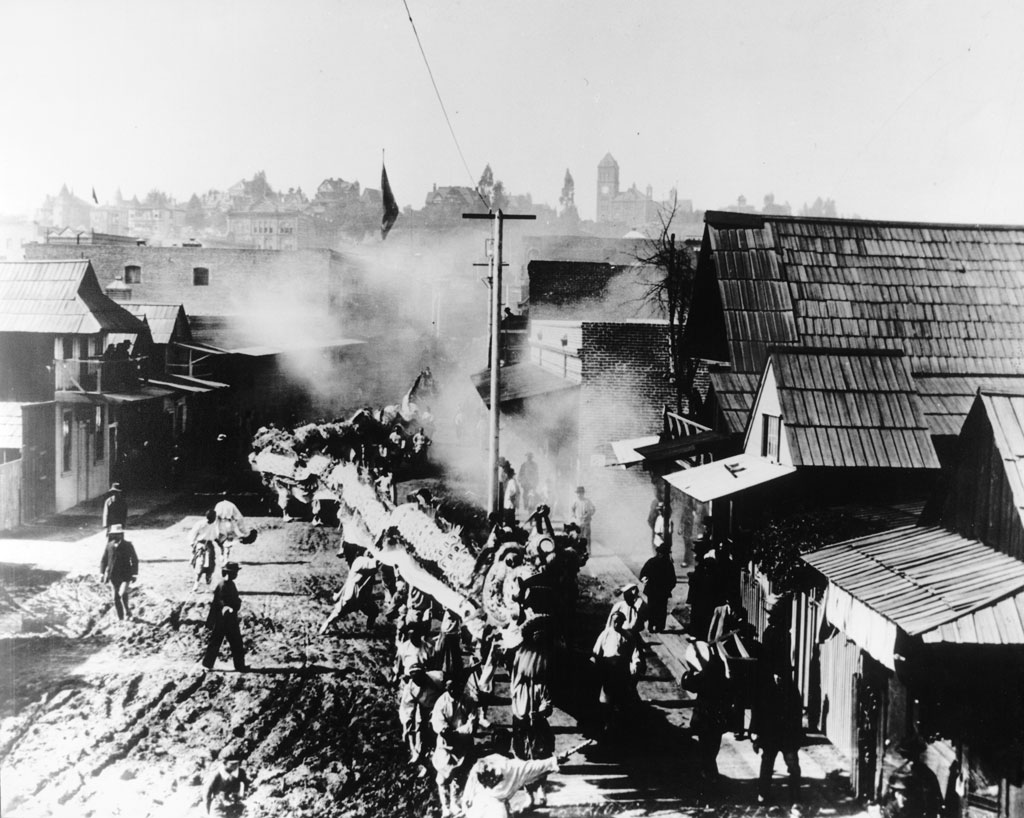 |
|
| (ca. 1890s)^^ - View of a Chinese New Year parade in Chinatown, Los Angeles. A dragon winds its way down the dirt street while the few onlookers show minor interest. In the distance the second Los Angeles High School can be seen on Fort Moore Hill. |
* * * * * |
Arcadia and Los Angeles Streets
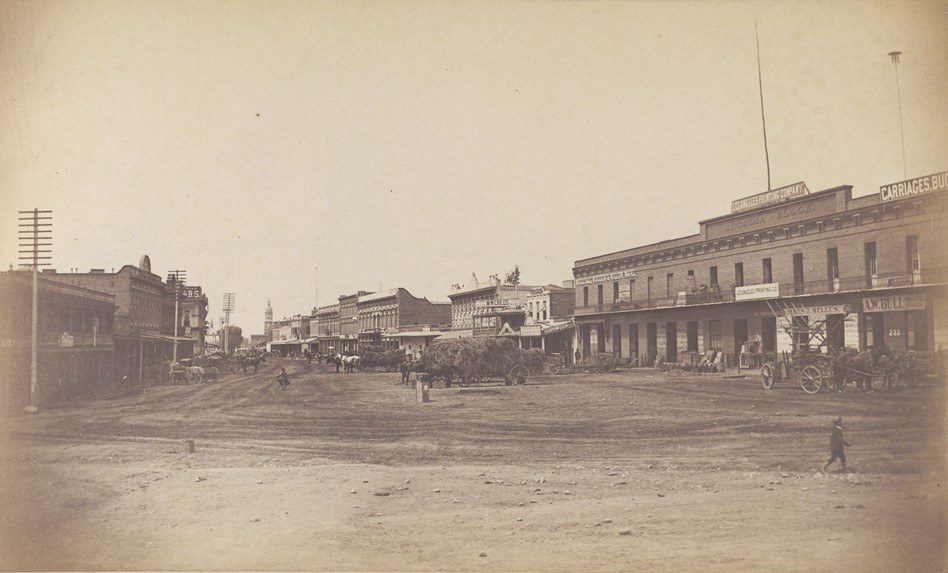 |
|
| (ca. 1890)* - View looking south on Los Angeles Street showing hay wagons, commercial buildings lining street. At right is the Arcadia block building housing the Los Angeles Printing Co., broom factory. |
Historical Notes The Arcadia Block building was the first business brick building in Los Angeles. |
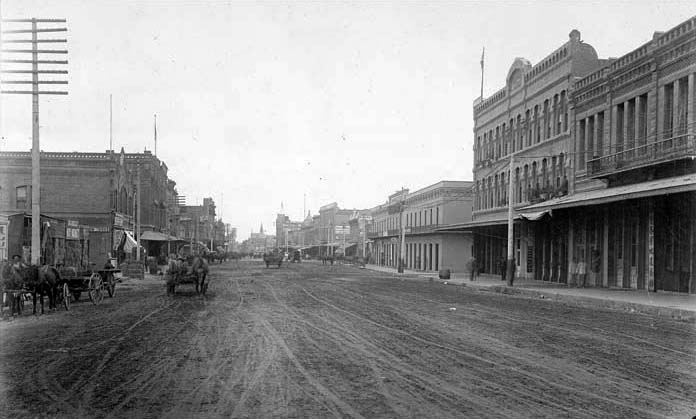 |
|
| (ca. 1895)* - View looking south on Los Angeles Street toward Arcadia Street. The Arcadia Block is seen on the SW corner with the Garnier Block and Jennette Block seen on the right. |
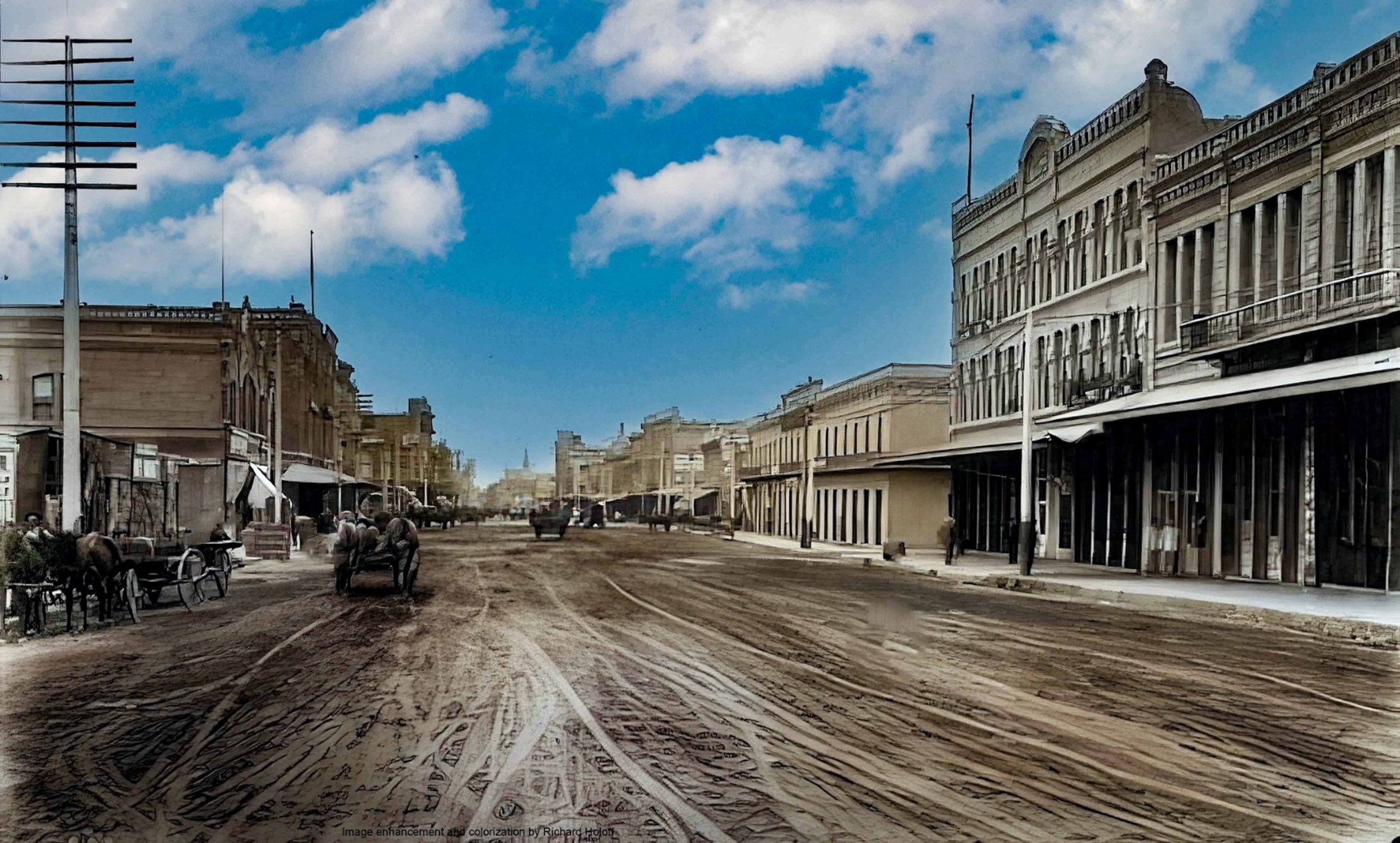 |
|
| (ca. 1895)* - View looking south on Los Angeles Street toward Arcadia Street.The Arcadia Block is seen on the SW corner with the Garnier Block and Jennette Block seen on the right. Image enhancement and colorization by Richard Holoff |
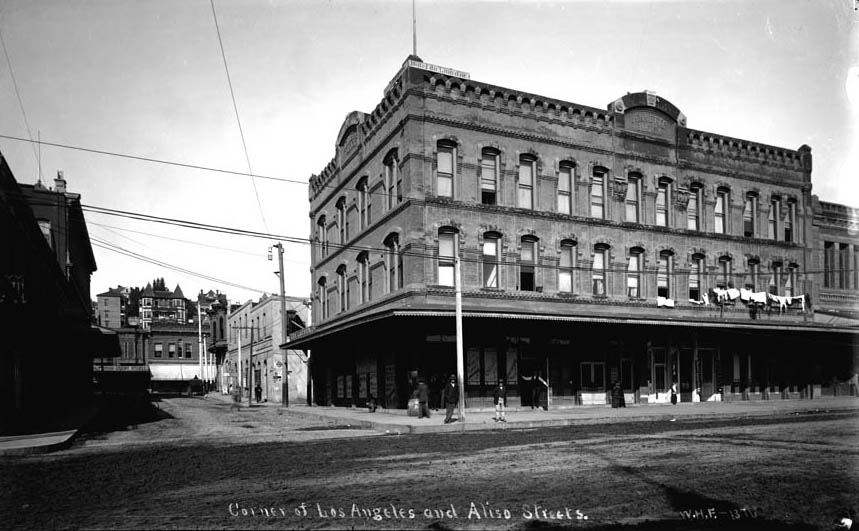 |
|
| (ca. 1895)* - Looking west on Arcadia Street from Los Angeles Street with Fort Moore Hill in the background. The three story Jennette Building is on the northwest corner of Arcadia and Los Angeles Streets with Sanchez Alley running directly behind it up to the Plaza at Republic Street. Photo is misidentified. Photo is mismarked - Aliso Street did not extend beyond Los Angeles Street. This is looking up Arcadia Street. |
* * * * * |
La Fiesta de las Flores Parade (aka La Fiesta de Los Angeles)
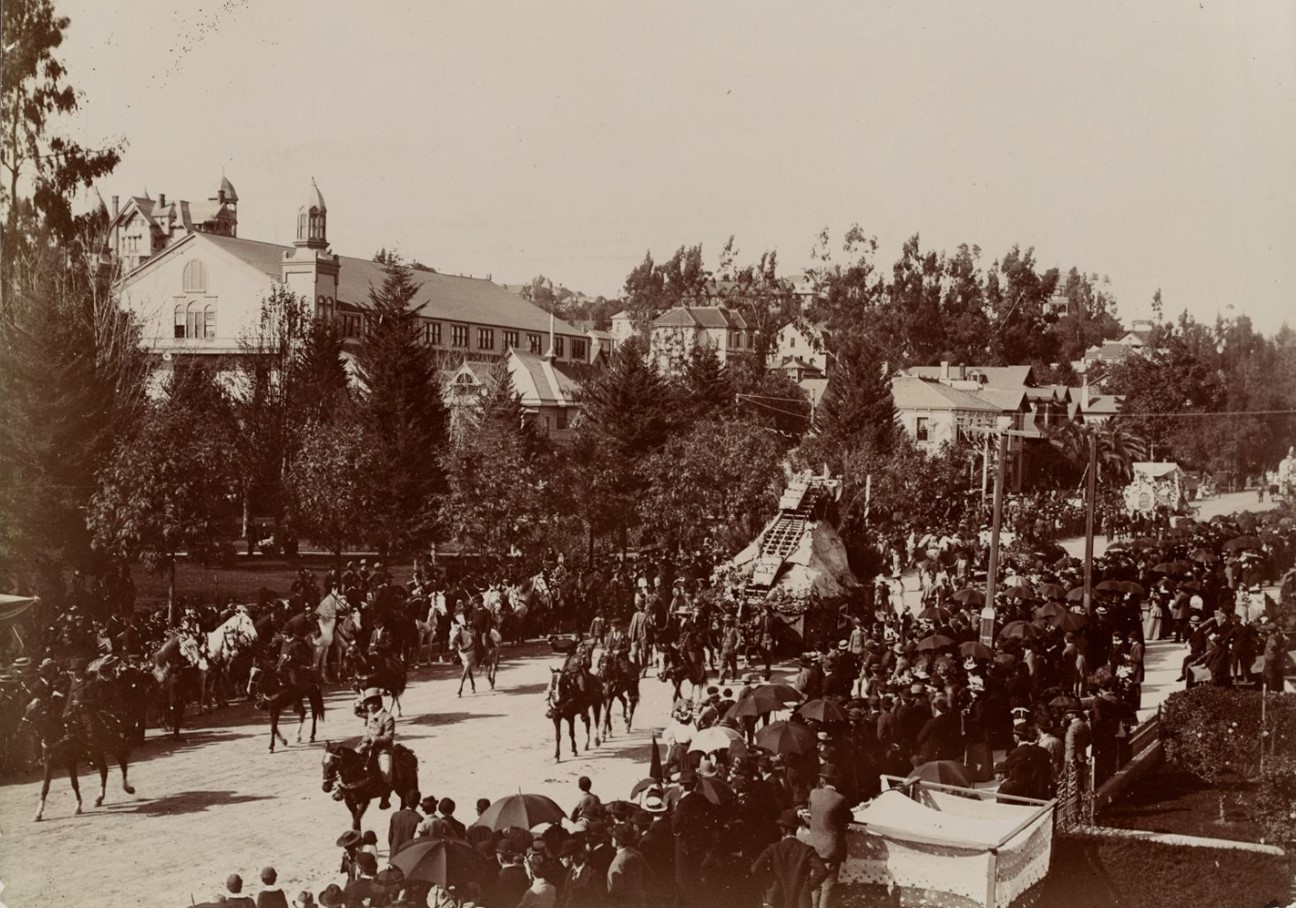 |
|
| (1894)* – A view looking northwest captures the inaugural La Fiesta de Los Angeles Parade on Hill Street, just south of 5th Street in downtown Los Angeles. Spectators and horseback riders watch as a float depicting the newly opened Mount Lowe Railway passes by. On the left is 6th Street Park, which later became Central Park and is known today as Pershing Square. The large building with towers beyond the trees is Hazard’s Pavilion, located at the northeast corner of Olive and 5th Street. The Rose Mansion can also be seen on the hillside of Bunker Hill. Photo from the Ernest Marquez Collection. |
Historical Notes “La Fiesta de Los Angeles” also called "La Fiesta de Las Floras" began on April 10, 1894 and was a four day festival that the city threw in its own honor celebrating its many different cultures. It continued throughout the 1890s and early 1900s. The event featured parades, floats, many flowers, athletic competitions, a costume ball, and carnival attended by masked revelers. It was conceived of by a local business man as a way to attract tourism at a time when the effects of the 1893 depression were being felt. |
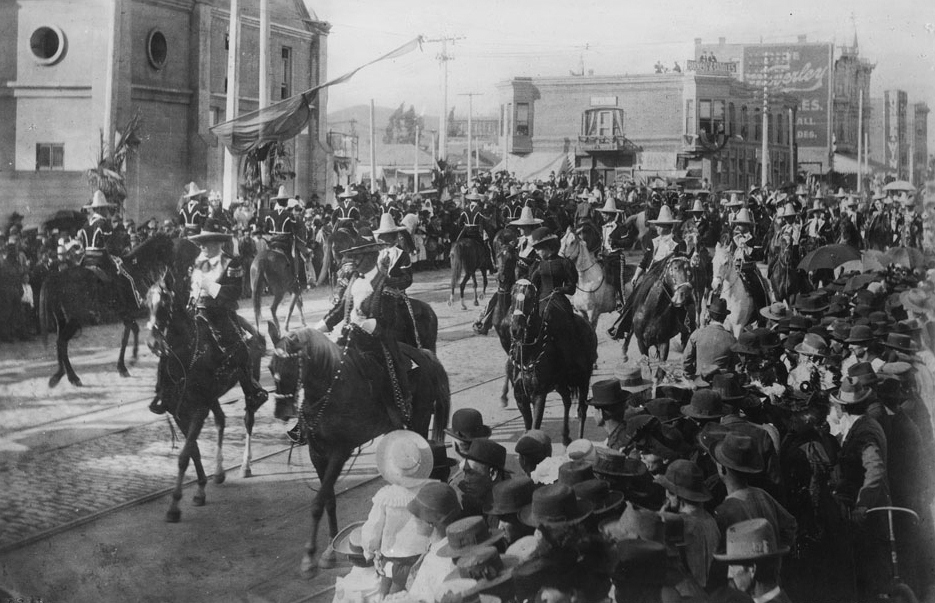 |
|
| (1901)* - Caballeros and señoras parading on horseback in front of the Plaza Church during La Fiesta de Los Angeles. Throngs of well-dressed people crowd the sidewalks on both sides of the street. The Grand Marshall of the parade is Francisco Figueroa. The young woman on the horse in black (foreground) is Katie Abbot, daughter of Merced Abbot of Merced Theatre. |
Historical Notes The Spanish title of the festival was reflective of a goal: to capture the color and the aura of old Los Angeles in its days as a pueblo under Mexican rule. Men in the garb of caballeros (horsemen) and vaqueros (cow hands) participated. So did Chinese, native Americans, and African Americans. It was a multi-cultural gala, distinct from any celebration elsewhere. |
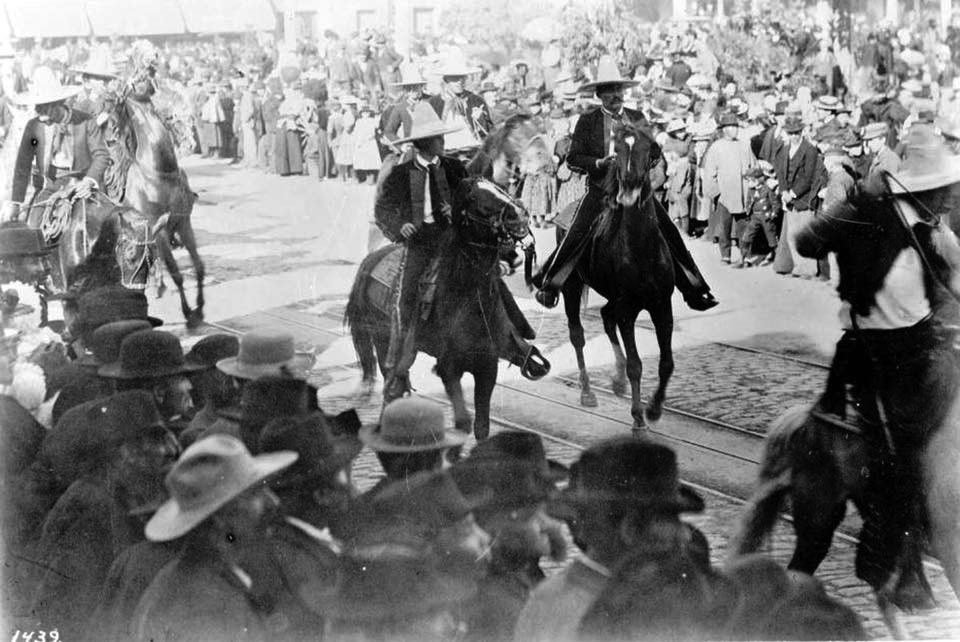 |
|
| (1895)* – Spectators line the streets to watch the La Fiesta de Los Angeles parade near the LA Plaza. |
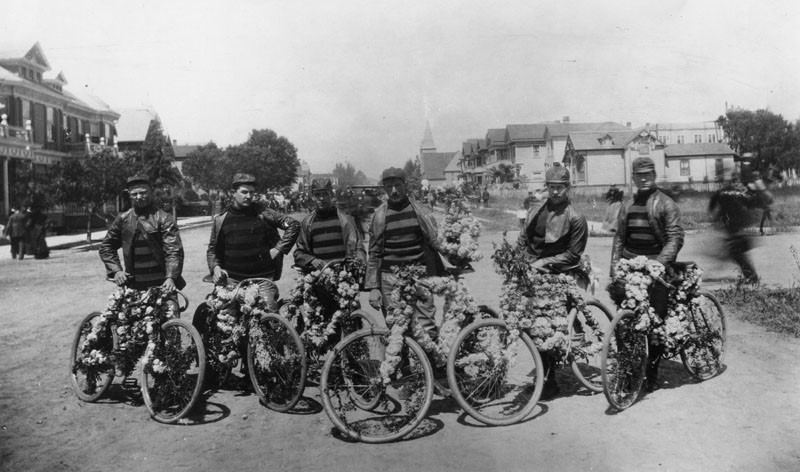 |
|
| (ca. 1894)^ - Cyclists in leather jackets and hats stand beside their flower-decorated bicycles as they pose on a wide, dirt avenue lined with houses. They are participating in the La Fiesta de las Flores parade. |
.jpg) |
|
| (ca. 1894)^ - Members of the cycling club are shown festively dressed prior to the La Fiesta de las Flores parade in downtown Los Angeles. |
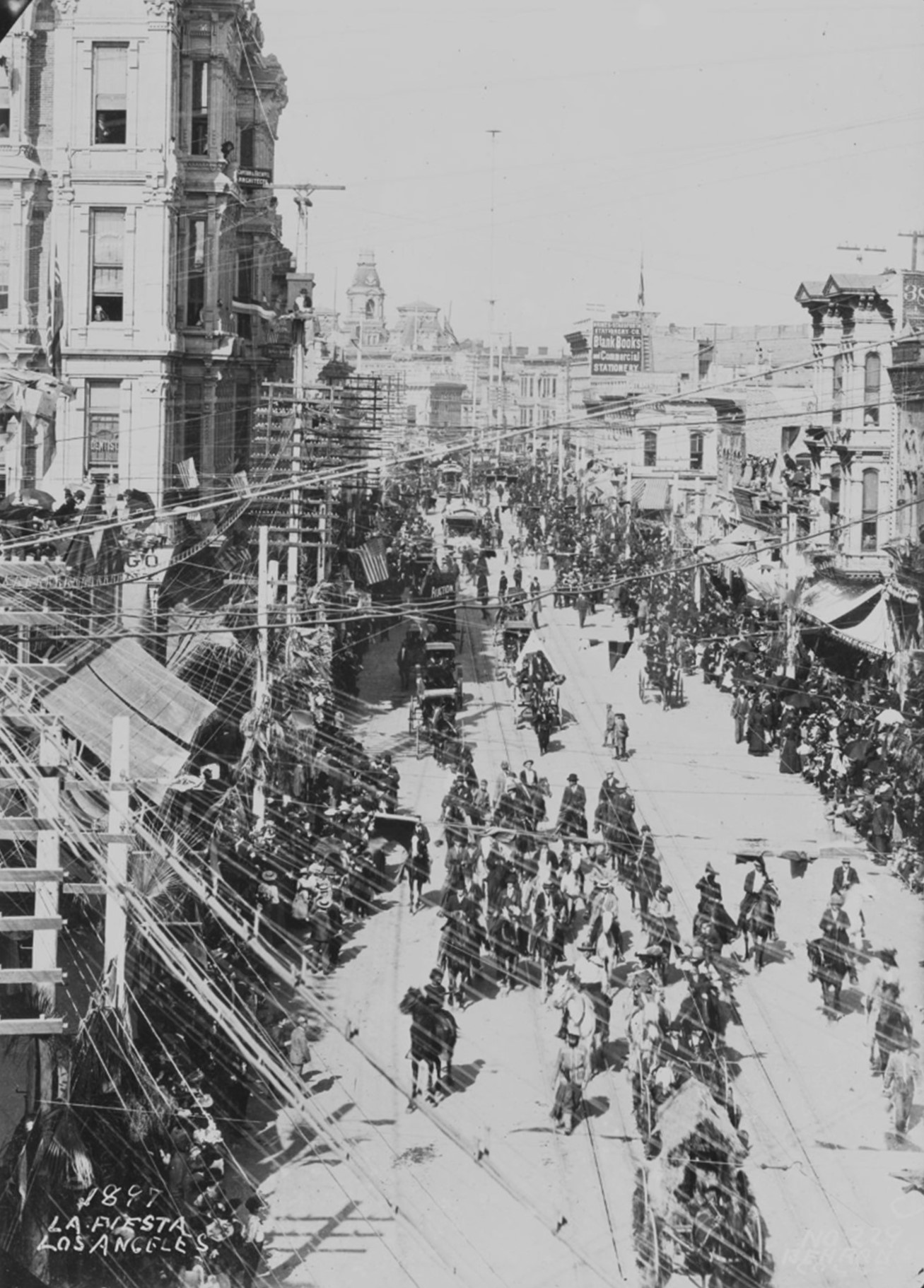 |
|
| (1897)* – Elevated view of "La Fiesta" parade on North Spring Street; shows horsemen in foreground, horse-drawn carriages and streetcars in background, utility poles and wires and spectators, multi-story business buildings, stores and shops at ground level; Jevne Grocer store in lower right foreground at 208-210 South Spring; Grimes-Strassforth Stationery Co., upper right, at 220 North Spring and 215-217 North Main; ornate cupolas of Baker Block and Main Street in background. |
Historical Notes Click HERE to see more early views of the La Fiesta de las Flores parade. |
* * * * * |
Broadway and 6th Street
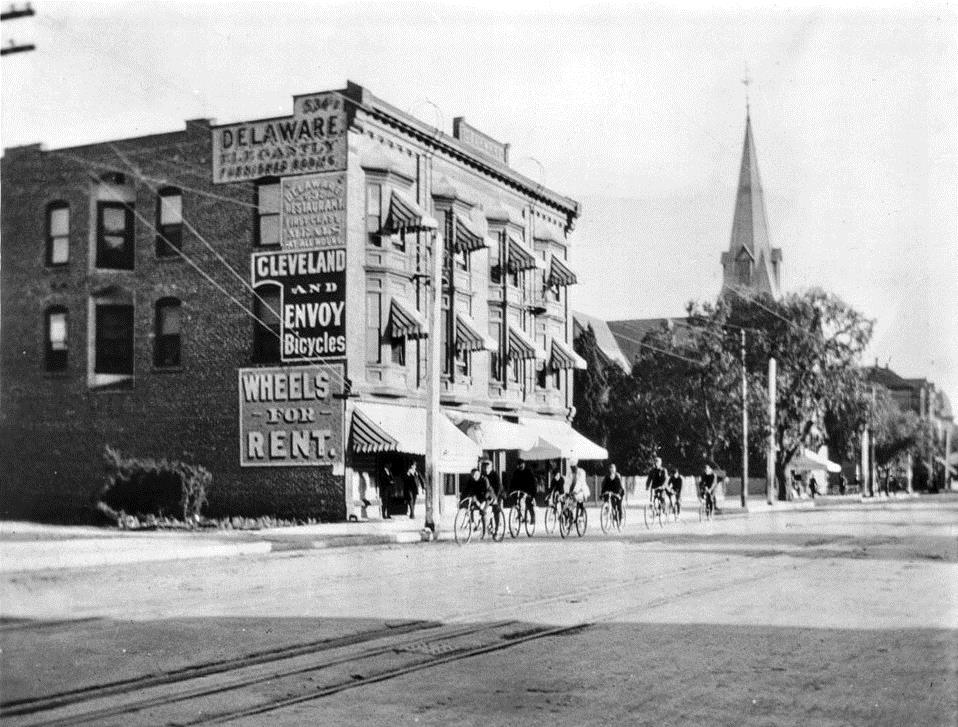 |
|
| (ca. 1896)^^ – View of the Delaware Hotel on Broadway, looking south between Fifth Street and Sixth Street, which later became the Dalton Theater. A group of nine individuals are bicycling past the front of the building whose brick-faced side sports signs which read "Delaware Elegantly", "Delaware Restaurant First Class [...] All Hours", "Cleveland and Envoy Bicycles" as well as "Wheels for Rent". Behind some tree cover in the background, the Spring St. School and the spire of the First Baptist Church can be seen. |
* * * * * |
Washington Street (later Washington Boulevard)
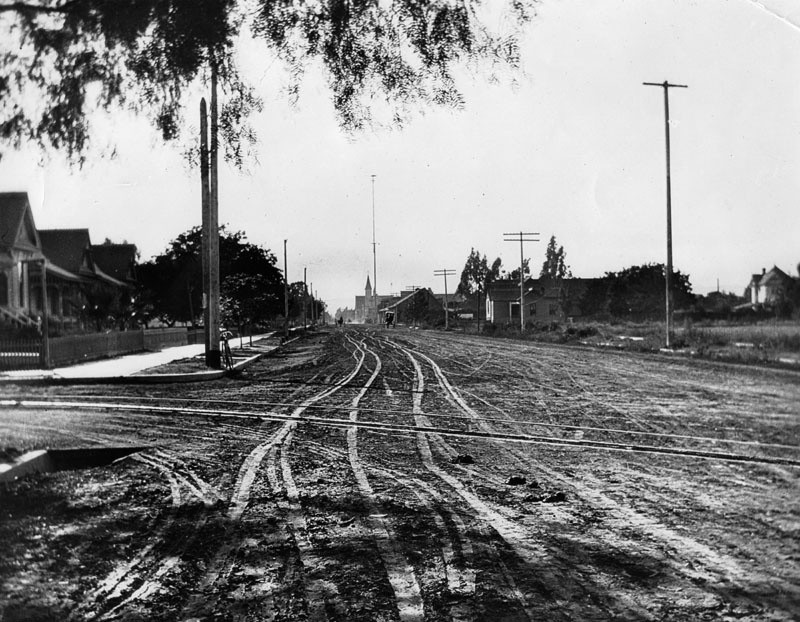 |
|
| (1896)^ - View is looking west at Washington Street (now known as Washington Boulevard) and Maple Street. There are homes on both sides of the wide dirt road. Horse-drawn carriages can be seen in the background, as well as an early structure for St. Vincent Church (center). |
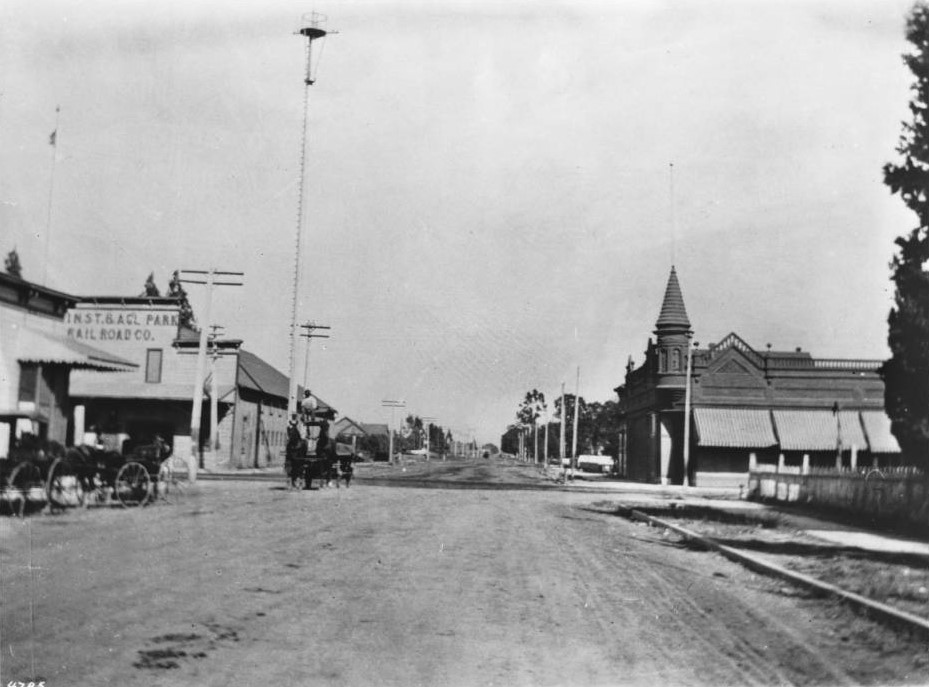 |
|
| (1896)* - View is looking east at Washington Boulevard from Main Street. There are storefronts on both sides of the wide dirt road. Horse-drawn carriages can be seen on the left as well as a very tall white pole or tower, with a small platform at the top. The platform is actually in the middle of the pole (see below). |
Historical Notes The tall pole seen in the upper-left of the photo is one of the City's first 150-ft tall electric light poles. Click HERE to see more in Early L.A. Streetlights. |
* * * * * |
Figueroa and Washington
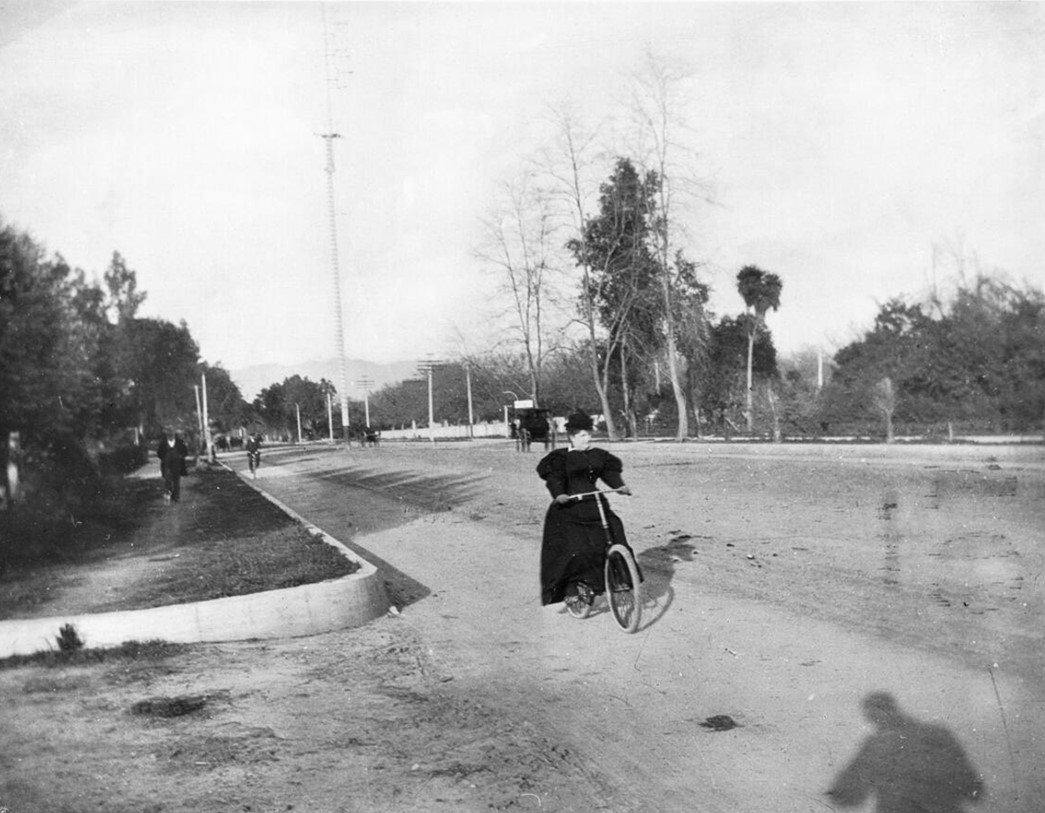 |
|
| (ca. 1898)* – Mrs. Henry Hazard on her bicycle at the corner of Washington and Figueroa Streets, looking north. Her husband, Henry T. Hazard, served as mayor of Los Angeles from 1889 to 1892 and played a key role in the city's late 19th-century development, particularly in infrastructure and city planning. In the distance, one of Los Angeles’ first electric streetlights stands tall. These 150-foot towers, equipped with carbon-arc lamps, were said to provide illumination comparable to a full moon. |
Historical Notes During his tenure as mayor, Henry Hazard focused on modernizing the city’s streets, expanding public services, and overseeing key civic projects. A lawyer by profession, he was also active in legal and real estate matters. Click HERE to see more on LA's 1st Electric Streetlights. |
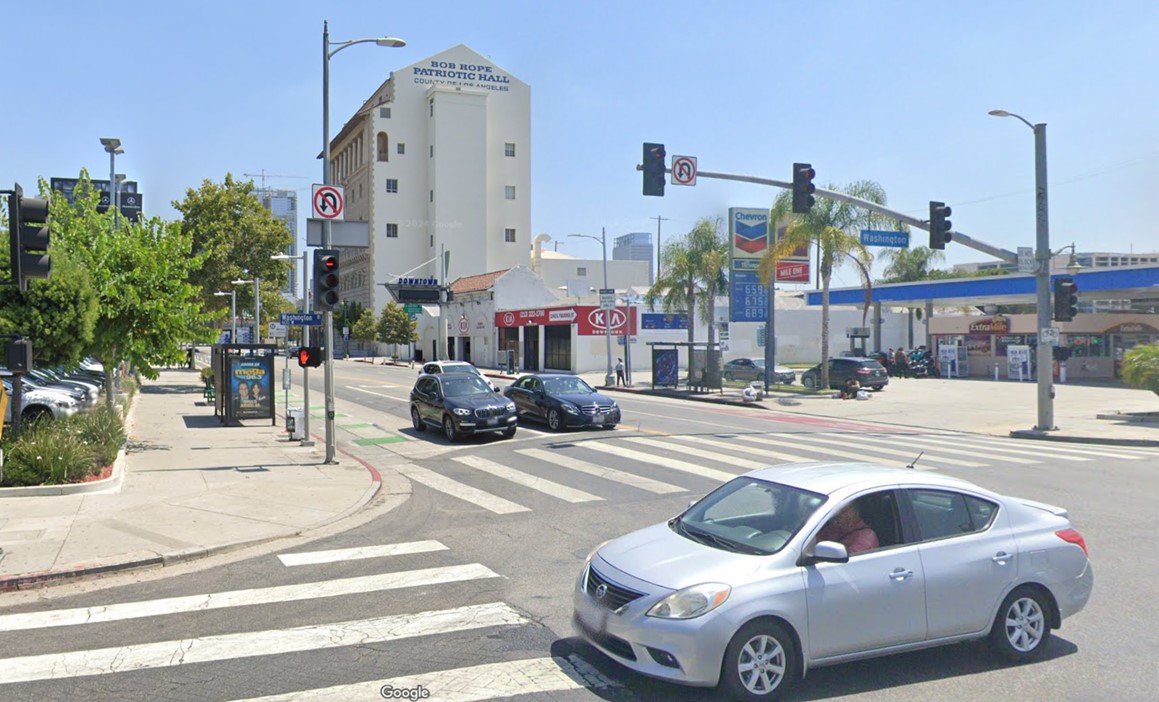 |
|
| (2022)* - Looking north on Figueroa Street at Washington Boulevard showing the 1926-built Patriotic Hall in the distance. |
Then and Now
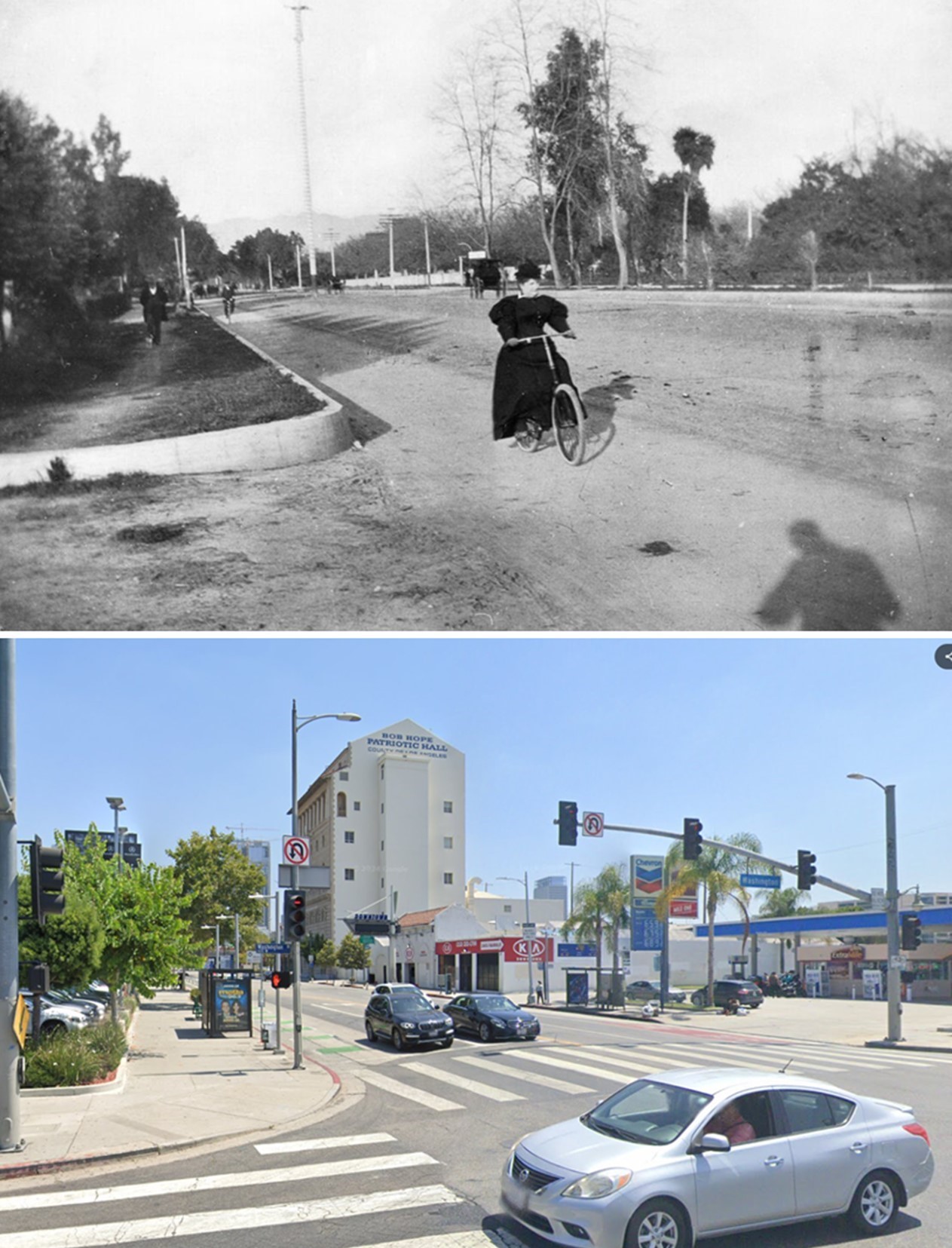 |
|
| (1898 vs. 2022)* - A 'Then and Now' comparison of Figueroa Street looking north at Washington Boulevard (originally Washington Street). Photo comparison by Jack Feldman. |
* * * * * |
First Automobile in Los Angeles
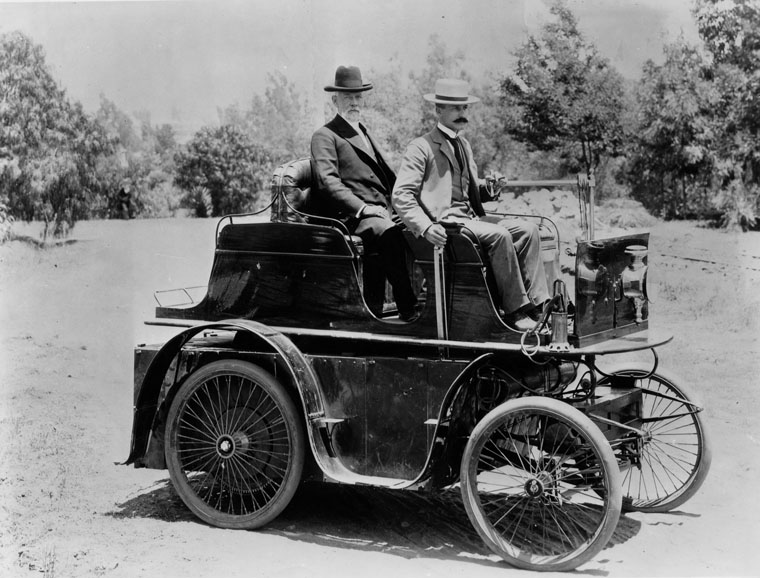 |
|
| (1897)^ - First automobile in Los Angeles, built for J. Philip Erie, the driver, a resident of Los Angeles at the time. |
Historical Notes The first automobile in Southern California appeared in 1897. It was built in a shop on Fifth Street in Los Angeles by S.D. Sturgis for J. Philip Erie. Erie became the first to drive an automobile on Los Angeles roads. By 1904, 1,600 cars were cruising the streets of Los Angeles. The maximum speed limit was 8 mph in residential areas and 6 mph in business districts. The passenger seen in the rear seat was William H. Workman, father of Los Angeles' Mayor Boyle Workman. |
* * * * * |
Echo Park Lake (Reservoir No. 4)
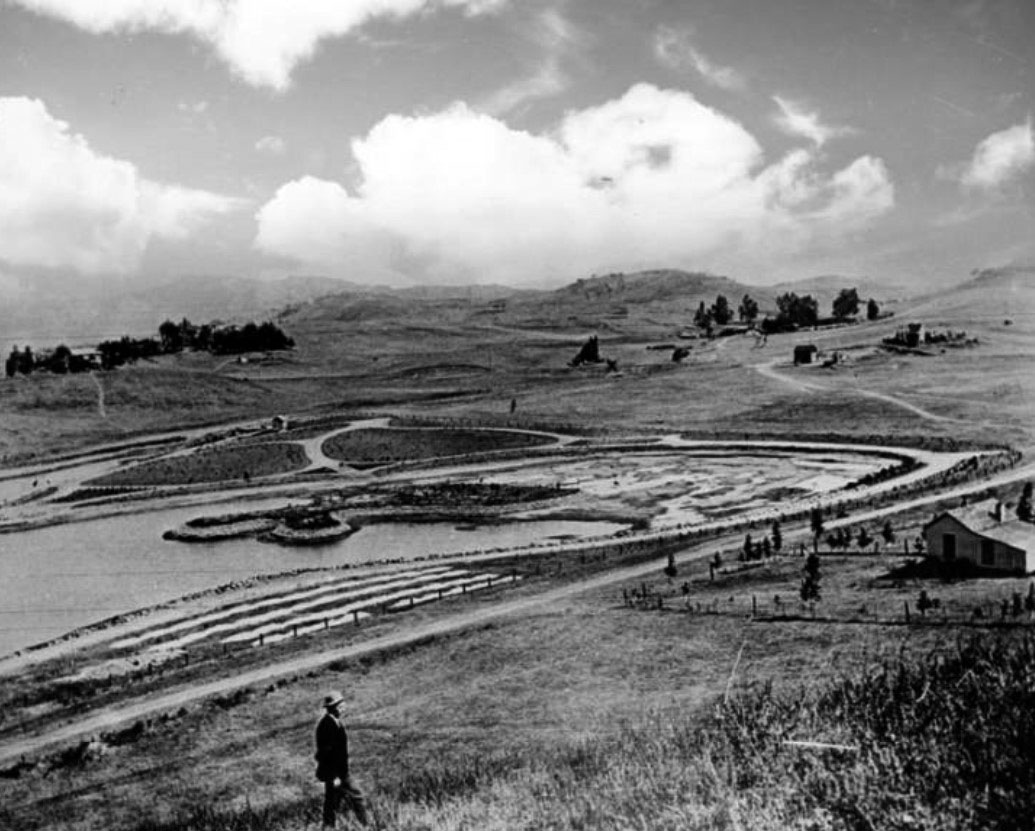 |
|
| (ca. 1894)^ - Early view of Echo Park Lake, looking northwest. The dirt road running along the lower half of the image is Montana Street, which would later become Echo Park Avenue. Trees and farmhouses pepper the landscape, and a man is visible at the bottom. |
Historical Notes Echo Park Lake didn’t start out as a man-made lake. Instead, its earliest use by the city was as a reservoir, storing water in a section sometimes known as the city’s “West End.” In those years this area was thought of as the city’s west side. The Los Angeles Canal and Reservoir Co. formed Reservoir No. 4 in 1868. The company obtained the water by digging a ditch that sent water flowing from the Los Angeles River – in the area now known as Los Feliz – along a zigzag path that merged with the Arroyo de los Reyes and then emptied into the reservoir.* The Arroyo de los Reyes originates near the Catholic school on Glendale Boulevard – right by the 2 off-ramp. It flowed southward, along Glendale Boulevard, occupied the area now taken by Echo Park Lake, and continued down to 2nd Street, then crossing through downtown LA, about a block or two south of Pershing Square, where it spread and created a big muddy mess. These flows eventually connected with the Los Angeles River, when they didn’t seep into the ground first.^ |
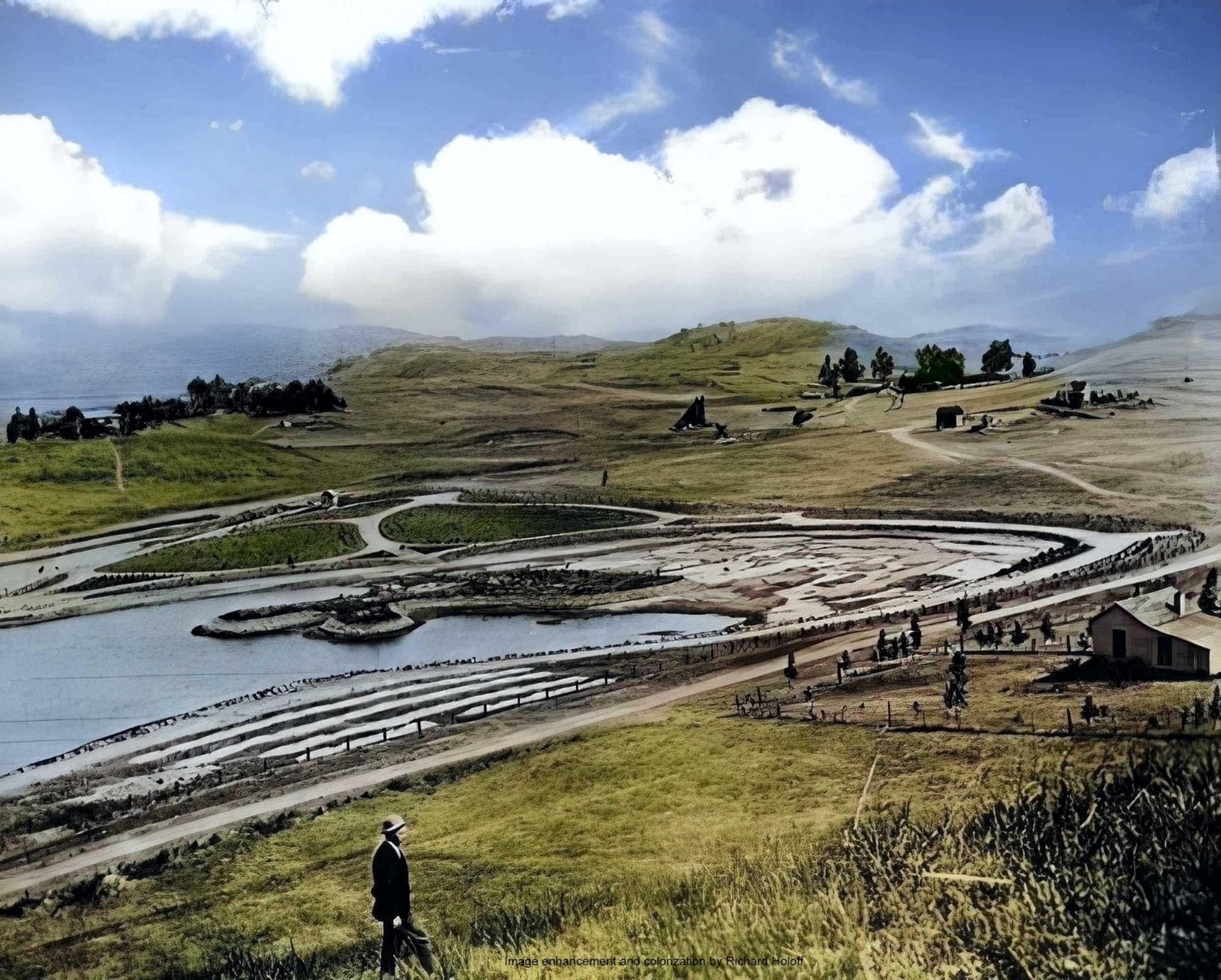 |
|
| (ca. 1894)^ - Early view of Echo Park Lake, looking northwest. The dirt road running along the lower half of the image is Montana Street, which would later become Echo Park Avenue. Trees and farmhouses pepper the landscape, and a man is visible at the bottom. Image enhancement and colorization by Richard Holoff. |
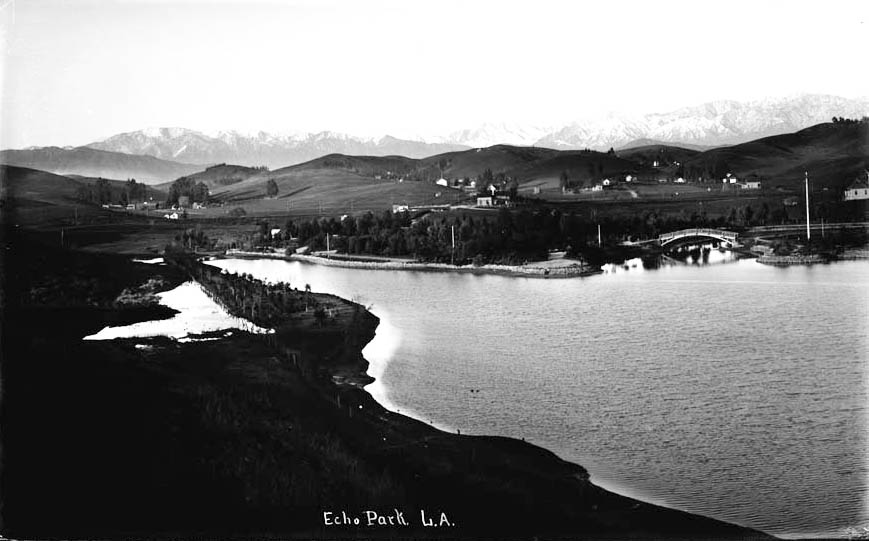 |
|
| (ca. 1895)^ - View looking northeast showing Echo Park with the snow-capped peaks of the San Gabriel Mountains in the distance and rolling countryside all around. Note the arched wooden bridge at center-right. |
Historical Notes In the late 1880s, a carriage maker turned real estate developer, by the name of Thomas Kelley, teamed up with other investors to purchase about 70 acres that included Reservoir No. 4—what is now Echo Park Lake. Kelley and his business partners sold off pieces of what they called the Montana Tract to individuals who built the business district along Sunset Boulevard and the densely packed homes and apartments that surround Echo Park Lake.* |
.jpg) |
|
| (ca. 1895)^ - View looking east showing Echo Park Lake and surrounding area with bridge seen at center-left. |
Historical Notes In those years, Reservoir No. 4 was held in check by a dam in the vicinity of Bellevue Avenue. From there, water traveled down the Woolen Mill Ditch to a mill near present-day Fifth and Figueroa Streets, not far from where Kelley lived. Kelley petitioned the city to provide a quitclaim, essentially a land swap, converting the reservoir lands into a park and private residences. That request, and quite possibly a legal challenge, led to three years of debate by the parks commission, the city council and the mayor.* |
.jpg) |
|
| (ca. 1895)^ - View looking south toward Bellevue Avenue and the dam holding up the lake, showing houses on bluff at left, a bank with trees on right, and two small wooden boats at center. |
Historical Notes In 1891, the city’s health officer inspected the lake's dam and determined that, if it were to hold a greater volume of water, it would pose a danger to residents who lived south of Bellevue Avenue. Two months later, city leaders struck a deal with the men who owned the land around the reservoir. Kelley and his associates – including William LeMoyne Wills, who like Kelley, would later serve on the school board – gave up 33 acres of land around the reservoir so that it could be used as a park. In exchange, the city agreed not to overflow the reservoir land, making the remaining land held by Kelley and his associates – including the street that would soon become Sunset Boulevard – far more valuable. When Mayor Henry Hazard signed the paperwork in 1891 allowing the park to be created, he envisioned a grand boulevard on Alvarado Street that would transport residents from Westlake – now MacArthur Park – to Echo Park Lake and then northeast to Elysian Park.* |
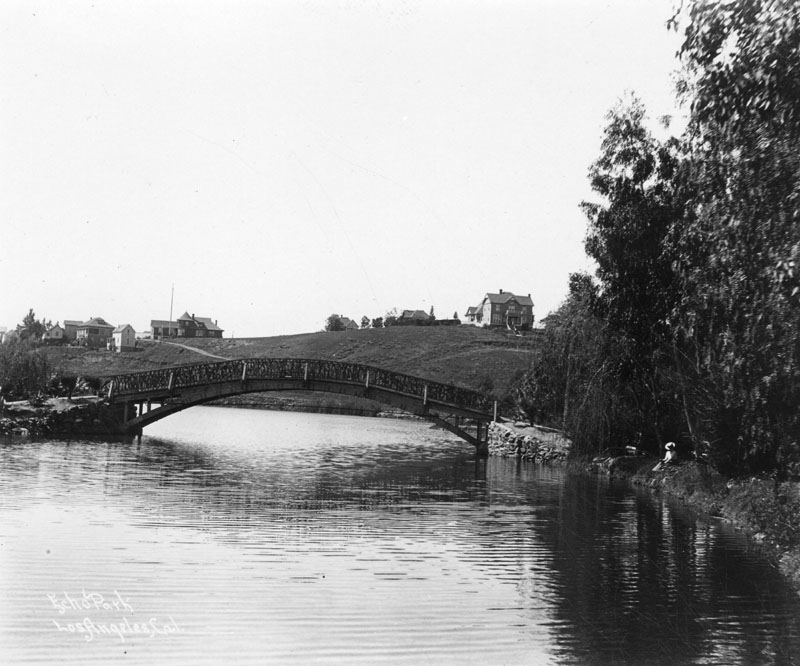 |
|
| (1900)* - Wooden bridge over Echo Park Lake as it looked at the turn of the century. Note the homes on the hillside behind the bridge and the woman with the hat relaxing alongside the lake. |
Historical Notes Designed in the rustic style, one of the lake's two bridges helped pedestrians reach the island seen on the left, while a second bridge passed over the lake’s northwest corner, where the ditch delivered water from the Los Angeles River (and lotus now grow). The city began work landscaping the park in October 1892. By 1895, the park and accompanying boathouse were completed. |
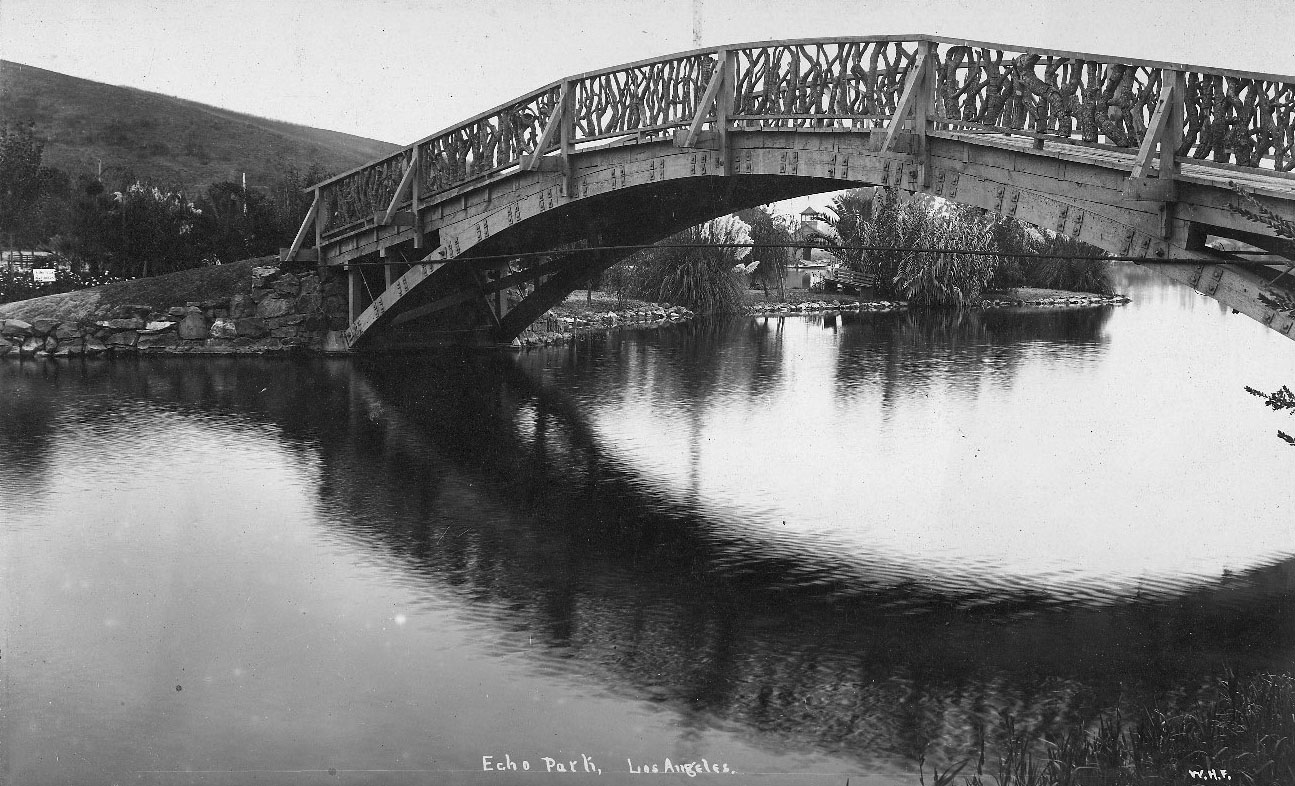 |
|
| (ca. 1895)^ – Close-up view looking south showing one of the two wooden bridges at Echo Park Lake. The bridge rail is made from fitted gnarled branches. In distance is a park bench and boathouse. |
Historical Notes The city began work landscaping the park in October 1892. By 1895, the park and accompanying boathouse were completed. |
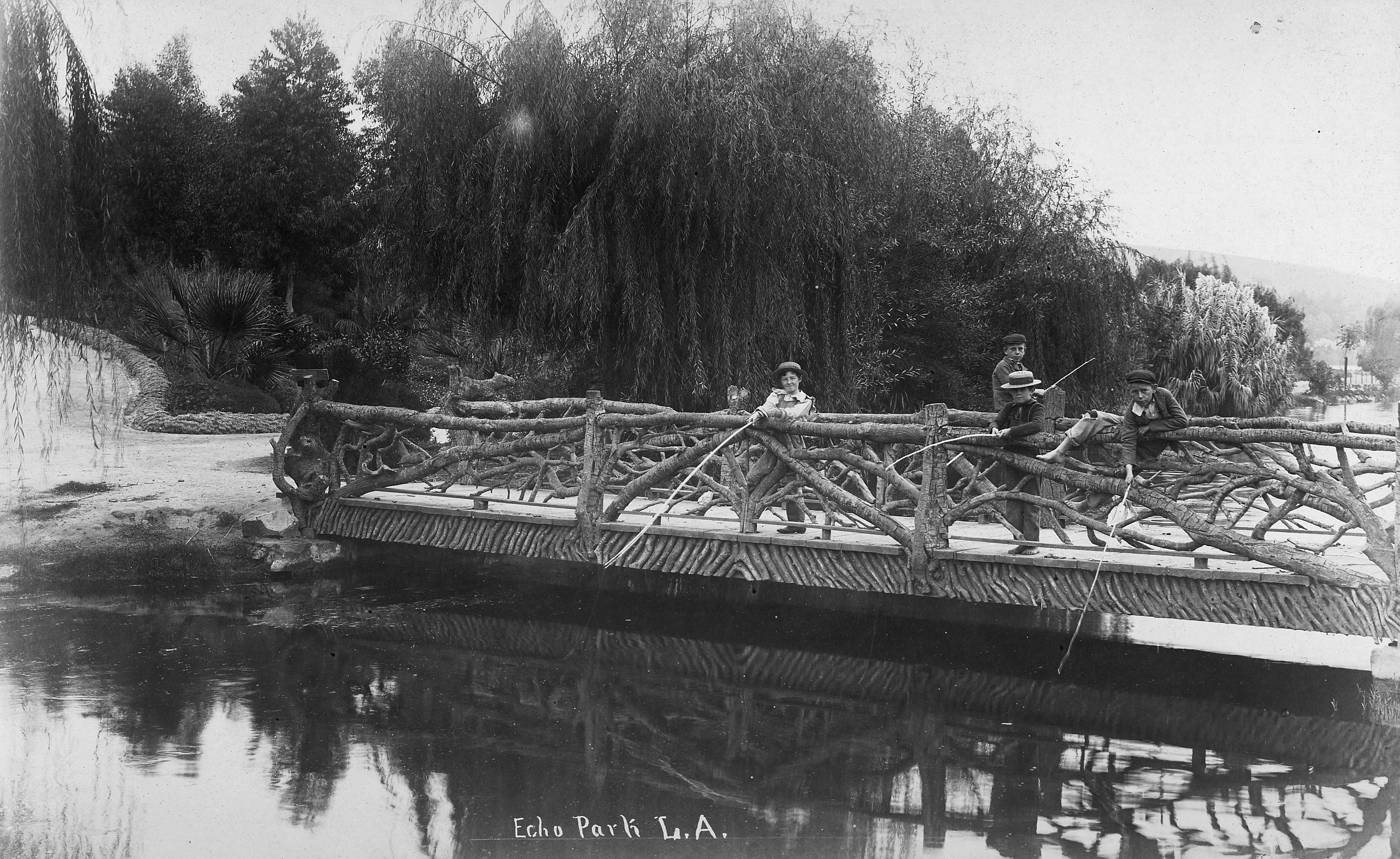 |
|
(1890s)^- View showing four boys fishing off one of the two bridges at Echo Park Lake with willow trees in the background. Note the “tree-limb” railing. |
Historical Notes The above bridge passed over the lake’s northwest corner, where the ditch delivered water to the lake from the Los Angeles River (where the lotus now grow). The city began work landscaping the park in October 1892. By 1895, the park and accompanying boathouse were completed. |
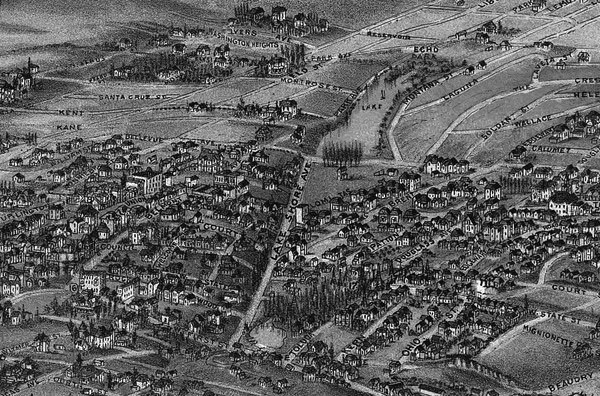 |
|
| (1894)*– Map showing Echo Park Lake (center-top) located at the intersection of Lake Shore Avenue (later Glendale Boulevard) and Bellevue Avenue. Note that there is a second smaller lake seen at lower-center. It was part of the Second Street Park, located at the intersection of Lake Shore Avenue and 1st and 2nd streets. Map courtesy of the Library of Congress. |
Before and After
 |
|
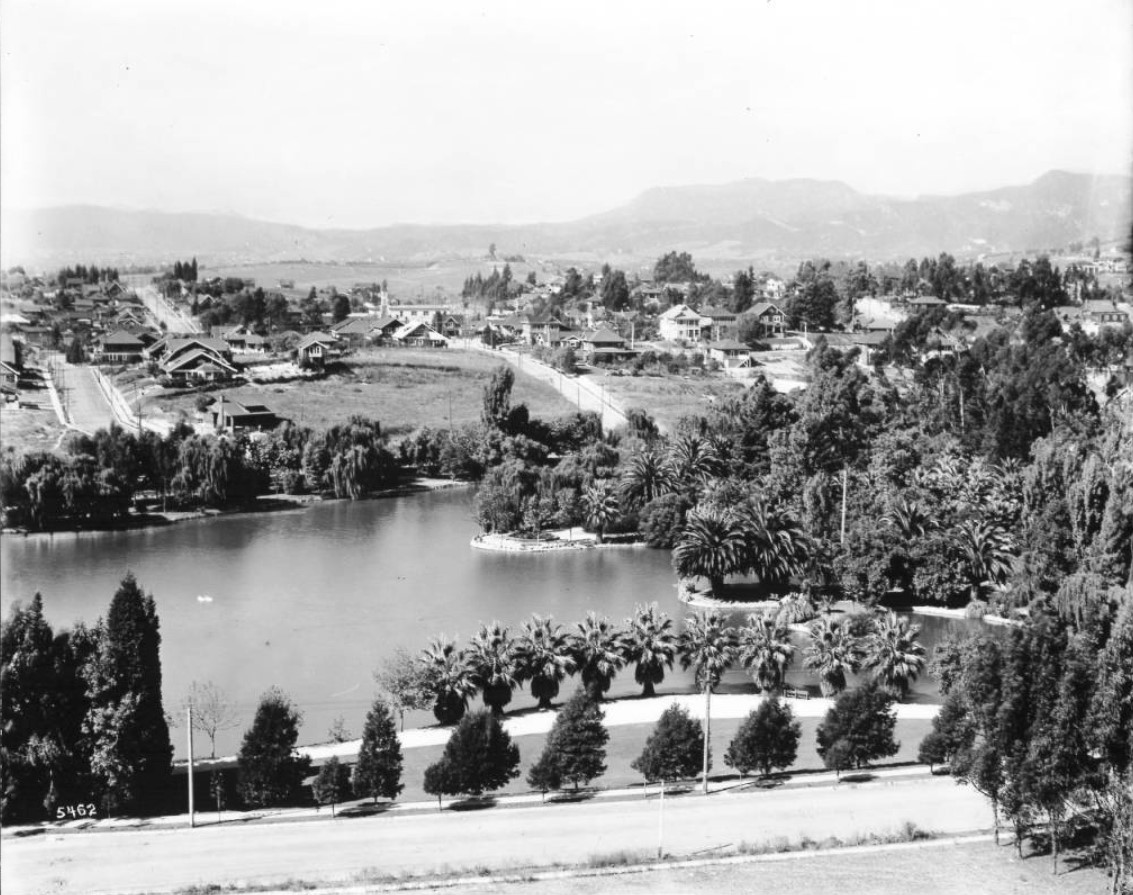 |
|
| (ca. 1894)^ vs. (1911)^ - Echo Park Lake before and after landscaping. |
Historical Notes Echo Park development began in 1891 with landscaping a year later. The first Superintendent of Parks for the city was an English immigrant named Joseph Tomlinson who was assigned the task of creating the park. Mr. Tomlinson, being somewhat homesick for his favorite park in Derbyshire, England, decided to model the park after his favorite childhood place to play. At the same time, the reservoir was closed and the stream was capped. The park superintendent created a 16-acre lake where the reservoir had been. It cost $5,637.00 to create the lake that is now filled with city water. Once that was accomplished, the planting began on the other 15 acres of park. One day, while overseeing the work, Mr. Tomlinson thought he heard his workers talking during a break, but he knew they were across the park from him. The park had an echo! He knew what the name of the park would be! Unfortunately, the plantings he installed destroyed the echo, but the name remained. The park was dedicated and opened to the public in 1895. The famous bed of lotuses that grow in the lake at the northwest end of the park, the largest stand of lotuses outside Asia, is a mystery yet to be solved. One legend says that evangelical Chinese missionaries planted them for use as food, but no one knows the real story. They appeared some time in 1923 or 1924. Nonetheless, they remain a beautiful addition to the park and have inspired the city to sponsor the annual Lotus Festival that celebrates Asian and South Pacific Island cultures.^^ By 1899, city leaders were intent on adding even more green space, by extending the parkland south to Temple Street. Bounded by Temple on the south and Bellevue on the north, the area was completed by 1907, with an extensive network of playing fields and courts for tennis and croquet. Called Echo Park Playground, it was only the second public playground to be built in the city of Los Angeles and still remains today. Click HERE to see more on the Echo Park Playground. Click HERE to see more contemporary views of Echo Park Lake (1975+). |
* * * * * |
Main and 4th Street
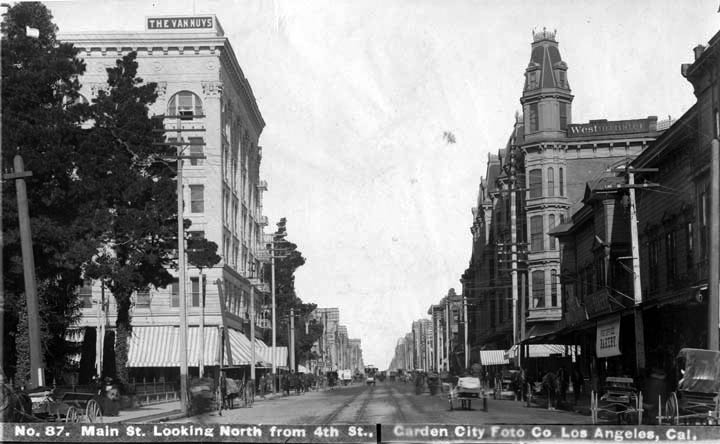 |
|
| (ca. 1898)^*# - View looking north on Main Street at 4th Street. On the N/E corner stands the Westminster Hotel. On the N/W corner is the Van Nuys Hotel. On the S/W corner (on the left) is the Hellman Residence and future site of the Farmers and Merchants Bank. |
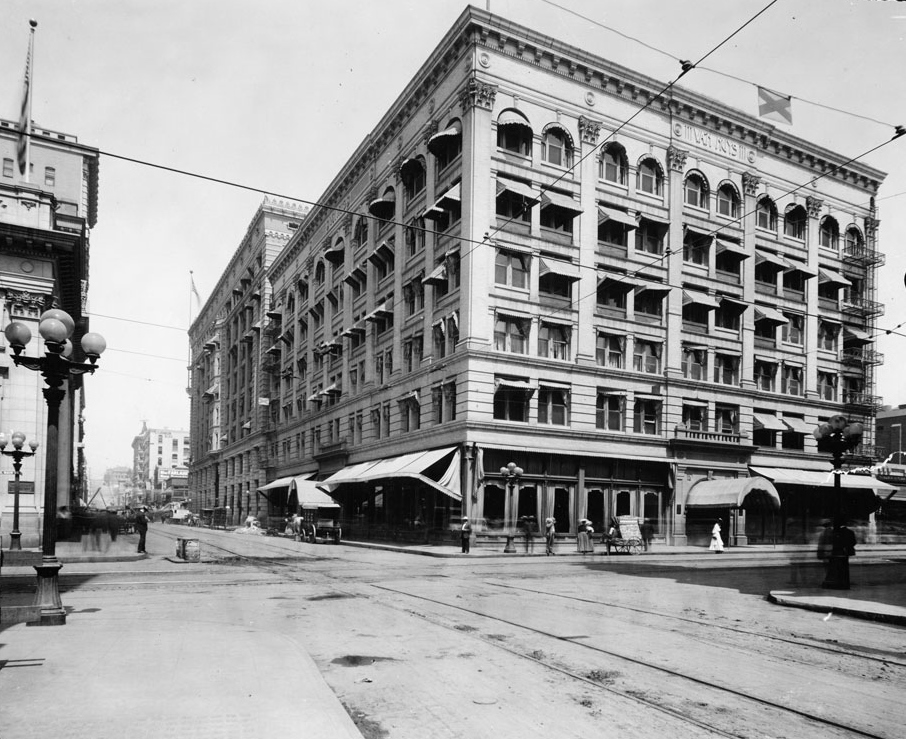 |
|
| (1905)^^ - View looking west on 4th Street at Main Street where the Van Nuys Hotel (later the Barclay) is seen on the northwest corner. Across the street, on the southwest corner, can be seen part of the Farmers and Merchants Bank (built in 1905). Both buildings are still standing. Click HERE to see contemporary view. |
Historical Notes In 1985, the Barclay Hotel Building (Van Nuys Hotel Building) was designated Los Angeles Historic-Cultural Monument No. 288 (Click HERE to see complete listing). |
* * * * * |
Overhead Line Congestion
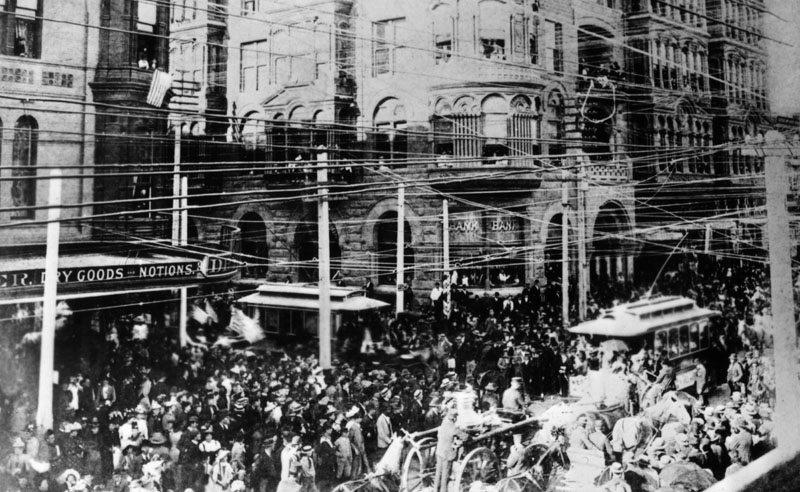 |
|
| (1892)^ - The streets are crowded during a Columbus Day parade on October 26, 1892 at the interesection of Spring and 2nd Streets. The Bryson-Bonebrake Building can be seen in the background (NW corner). On the left (SW corner) is the B.F. Coulters store on the ground floor of the Hollenbeck Hotel. Note the overhead wire congestion. |
Historical Notes Before most cables ran underground, all electrical, telephone and telegraph wires were suspended from high poles, creating strange and crowded streetscapes.* |
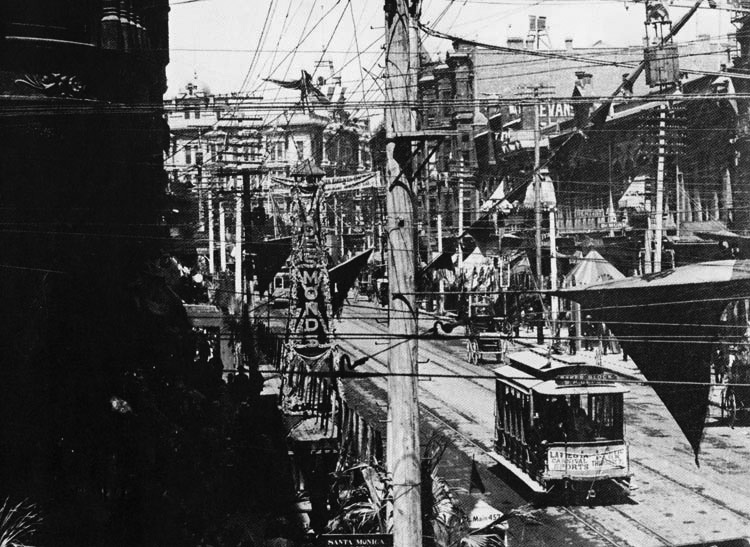 |
|
| (late 1890s)^^# - View of the south 100 block of Spring Street showing overhead line congestion mainly from electric streetcar car and telephone wires. The corner of the Bryson Block looms darkly at extreme left. |
Historical Notes By the early 20th Century, wooden poles were carrying telephone lines and electrical lines as well as telegraph lines. Between electrification and the rapid adoption of telephony, wooden poles grew larger and more heavily burdened with utility lines to an extent that is unimaginable today.* |
* * * * * |
Gasoline Powered Streetcar
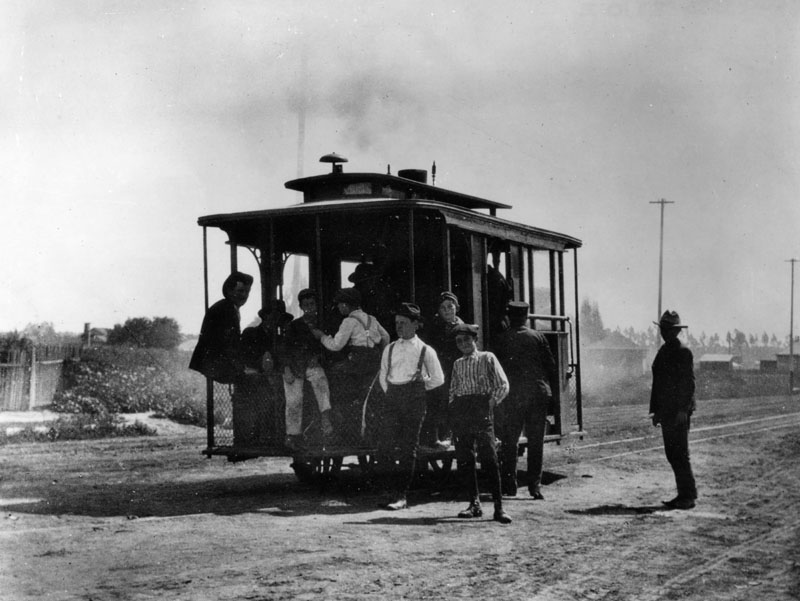 |
|
| (1897)^ - Young boys fill a small gasoline powered streetcar of the "Mateo Street & Santa Fe Ave. Street Car Co." seen traveling on an unpaved Santa Fe Avenue at 9th Street. |
Historical Notes The Mateo Street Line ran from First and Santa Fe Avenue South via Santa Fe Avenue to Fourth, using a private right-of-way to Mateo, then from Mateo to Ninth Street. The Los Angeles Railway purchased the Mateo Street Line in April, 1901.* |
* * * * * |
Broadway Parade
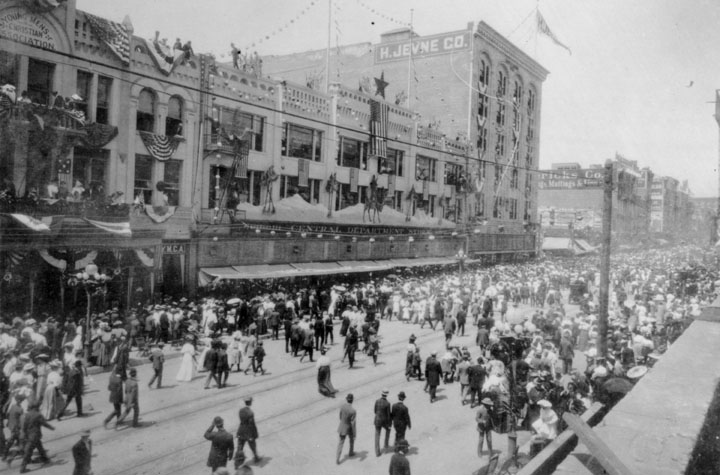 |
|
| (1898)^ - A view of Broadway in 1898. Pedestrians stroll through the street, and flags are draped from buildings for a parade or other festivities. People are gazing at pedestrians from balconies of the Young Men's Christian Association (YMCA) building. |
* * * * * |
LA Sharpshooters (aka Kelly's Kayotes)
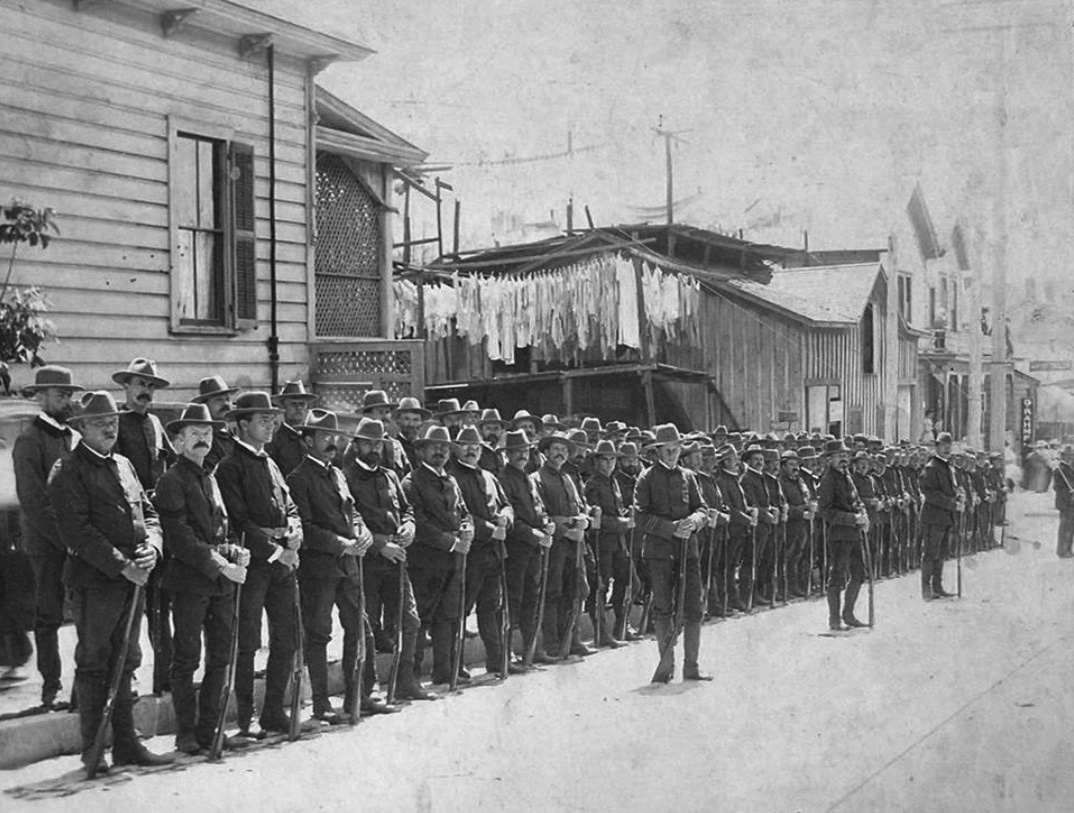 |
|
| (ca. 1898)^*^# – View showing the Los Angeles Sharpshooters, also known as Kelly's Kayotes, an exclusive club of marksmen that existed in the late 1890s. |
Historical Notes The Los Angeles Sharpshooters, also known as Kelly's Kayotes, was an exclusive club of marksmen that existed in the late 1890s. The team was formed in May 1898, under the leadership of Captain Allen Kelly, with around 65 members. Its team rifle was the Winchester. After receiving permission from the Governor to carry firearms in Los Angeles County, the Sharpshooters made quite a showing marching in the July 4 parade. Soon others wanted to join and by the end of the month, there were over 100 members, with others wanting to join. Of course, in order to be accepted, an applicant needed to prove himself with a rifle. The club did, however, offer honorary membership at $20, which was then invested in ammunition. Their practice range was a gulch called "Hunter Highland View" in Highland Park. Apparently, during their meetings, there would be a lot of drinking, smoking, and tall stories. However, they took their drills seriously. The team occasionally competed against divisions of armed forces (like the National Guard) and other sharpshooter organizations. Rifle tournaments were held on Round Hill and Glassell Park. The group ended around 1901-02, when it appears to have merged with another gun club, thus losing its identity.^*^# |
* * * * * |
Water in Early Los Angeles
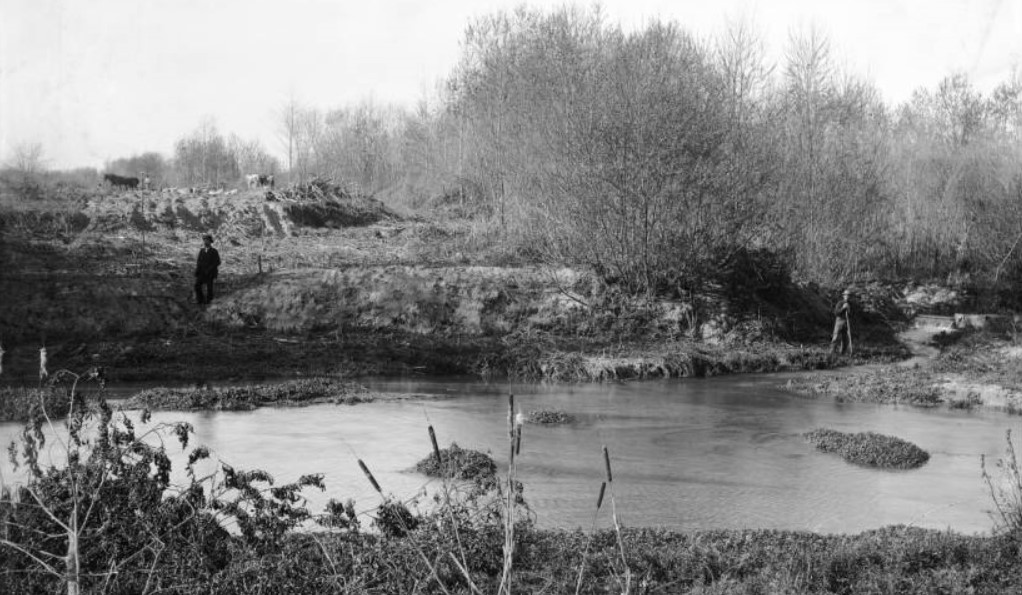 |
|
| (ca. 1895-1898)^^ – View of 2 men standing near a water ditch at the bank of Los Angeles River, north side of Griffith Park. One man leans against a shovel. Horses are visible in the background. Trees are behind the man with the shovel (at right). In the foreground are relatively still waters and cattails.; Originally, the record was entitled as "Los Angeles River headwaters in Griffith Park". The Los Angeles River's headwaters, however, are farther NW in the San Fernando Valley, CA. |
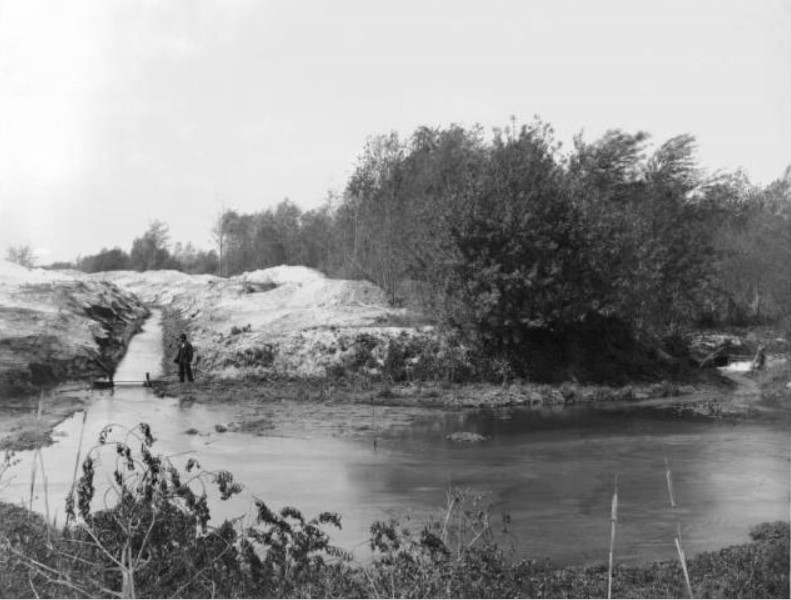 |
|
| (ca. 1900)^^ - View of a man standing near a water ditch at the bank of Los Angeles River, north side of Griffith Park. The ditch (full of water) has been dug at left. A stand of trees is beside the relatively still water. This is the same view as previous photo but a couple of years later. |
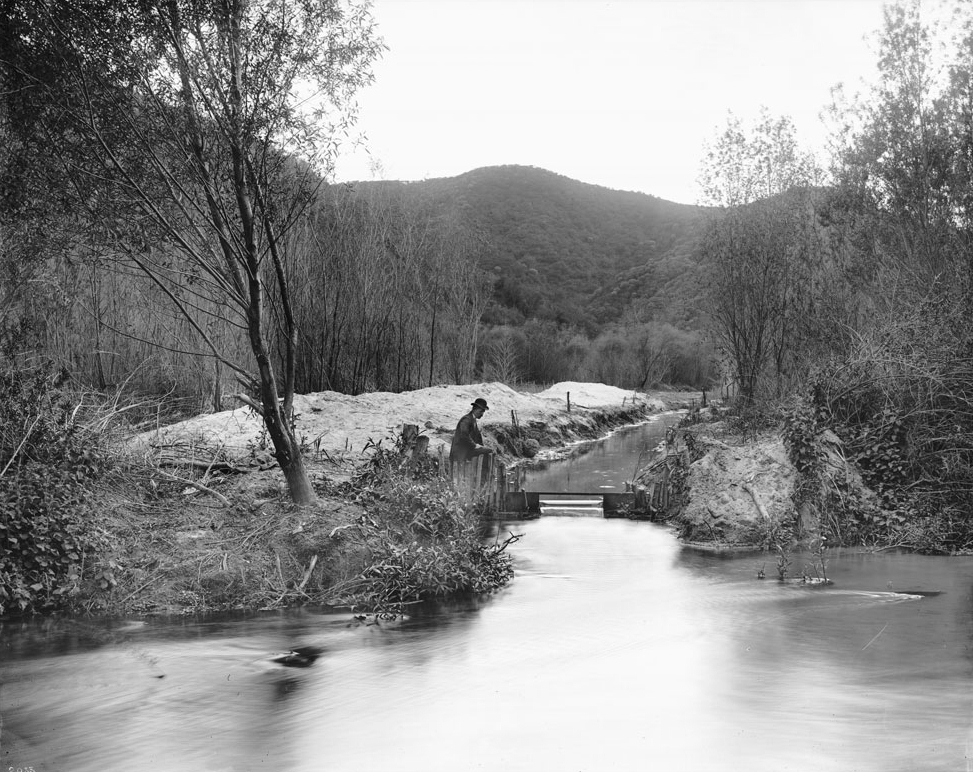 |
|
| (1898)^^ - A man is seen by a water ditch gate at the bank of the Los Angeles River at the present-day site of Griffith Park. |
Click HERE to see more in Water in Early L.A. |
* * * * * |
Zanja Madre
.jpg) |
|
| (ca. 1890)#^*– View looking northwest showing an unpaved Figueroa Street. Note the water-filled ditch (Zanja) on the west side of Figueroa with walkway crossings in front of each of the large homes. A two-story Victorian-style house is visible to the left, followed further to the right by a one-story clapboard-sided home with a porch, to the left of which a windmill is situated. |
Historical Notes The Zanja (Spanish for ditch) was the original water supply channel for the southwest part of the city. It was built in 1868 and rebuilt in 1885 with concrete. By the 1880s there were 10 zanjas that covered 93 miles.^ |
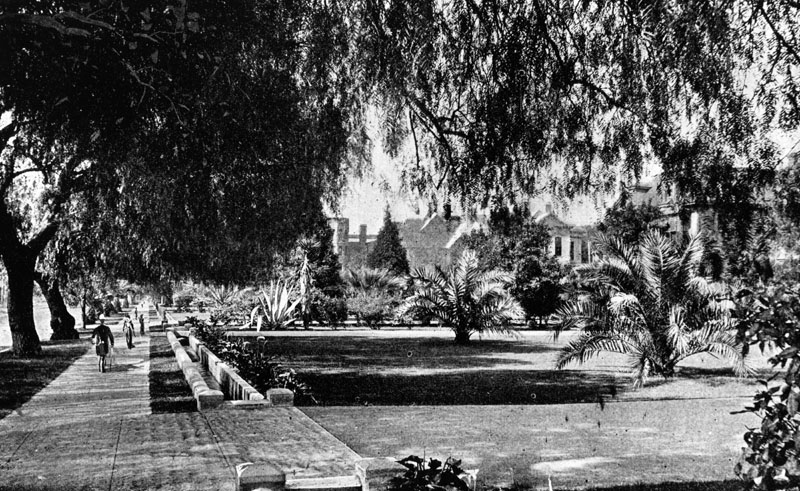 |
|
| (ca. 1895)^ - View of Figueroa Street near 23rd Street, showing the Zanja water supply channel and people walking on the sidewalk. The houses have massive lawns. |
Historical Notes The original water supply for Los Angeles was delivered in open trenches despite serious problems with public dumping into the trenches. In the 1880s and 1890s gradually piped water was introduced into more expensive neighborhoods, and the zanjas were used for irrigation only. The zanjas served the city until 1902, when they were replaced with a system of underground pipes.^ |
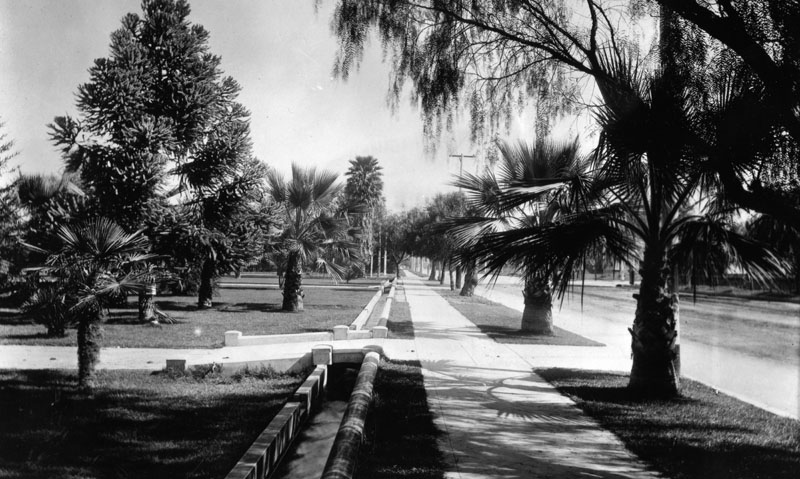 |
|
| (ca. 1900)^ - Zanja on Figueroa Street near Washington Boulevard. The original water supply channel for the southwest part of the city was built in 1868 and rebuilt in 1885 with concrete. |
Click HERE to see more in Zanja Madre (Original LA Aqueduct) |
* * * * * |
Adams and Figueroa
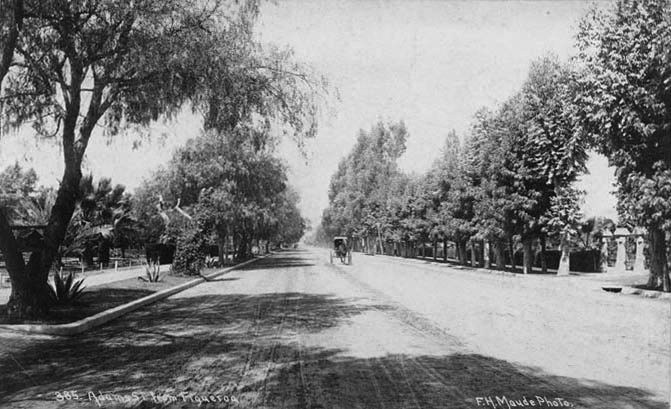 |
|
| (1897)^*# - View of Adams Boulevard as seen from Figueroa St. A horse-drawn carriage is seen moving toward the camera on the tree-lined dirt road. |
Then and Now
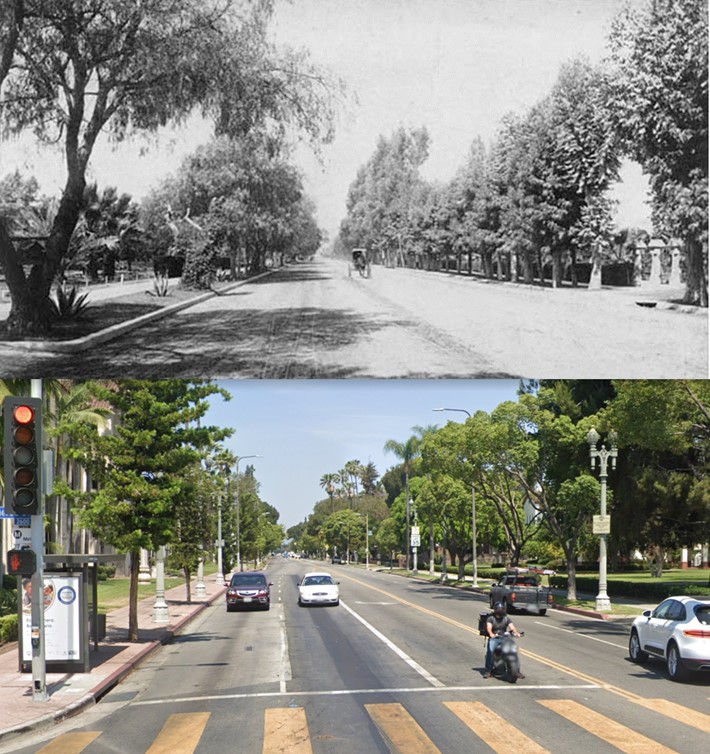 |
|
| (1897 vs. 2021) – Adams Boulevard looking West from Figueroa Street. Not much has changed. |
Western and Pico
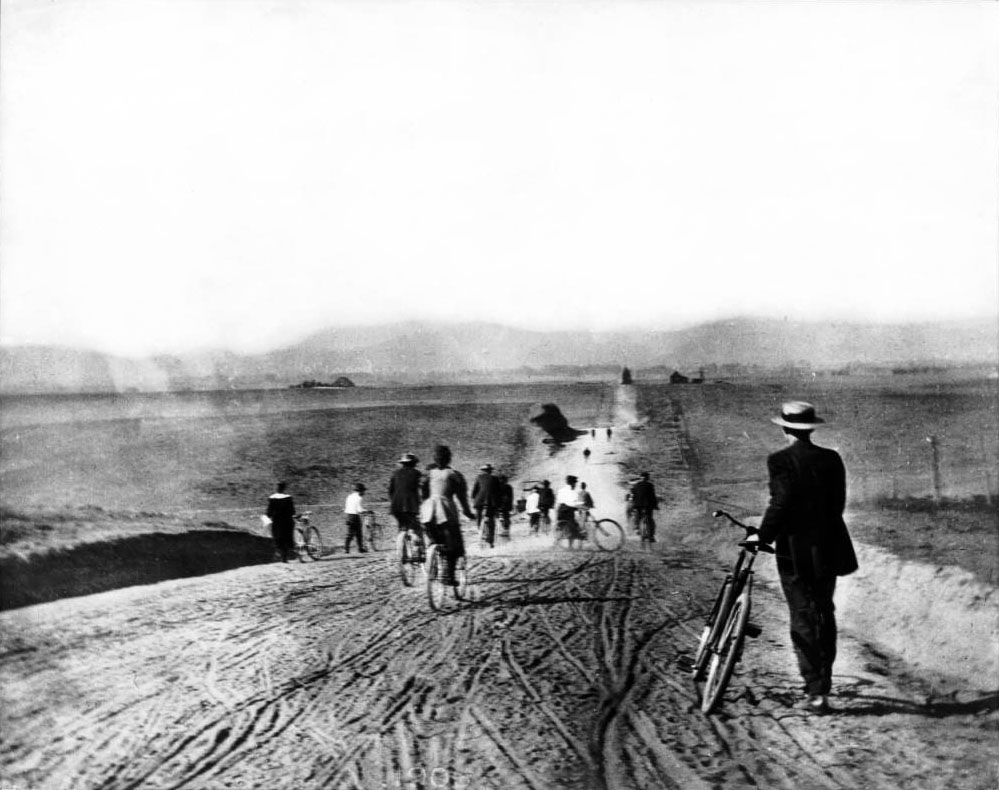 |
|
| (1895)^^ - The Los Angeles Times Bicycle Club on Western Avenue north of Pico. |
Historical Notes Western Avenue, apart from Sepulveda Boulevard, is one of the longest north–south streets in Los Angeles. The name of the street is derived from its history as the westernmost border of Los Angeles before annexations in the early 20th century expanded the city. Western Avenue eventually ends north of Franklin Avenue in the Hollywood Hills. It swerves to become an east/west street, Los Feliz Boulevard.*^ |
Then and Now
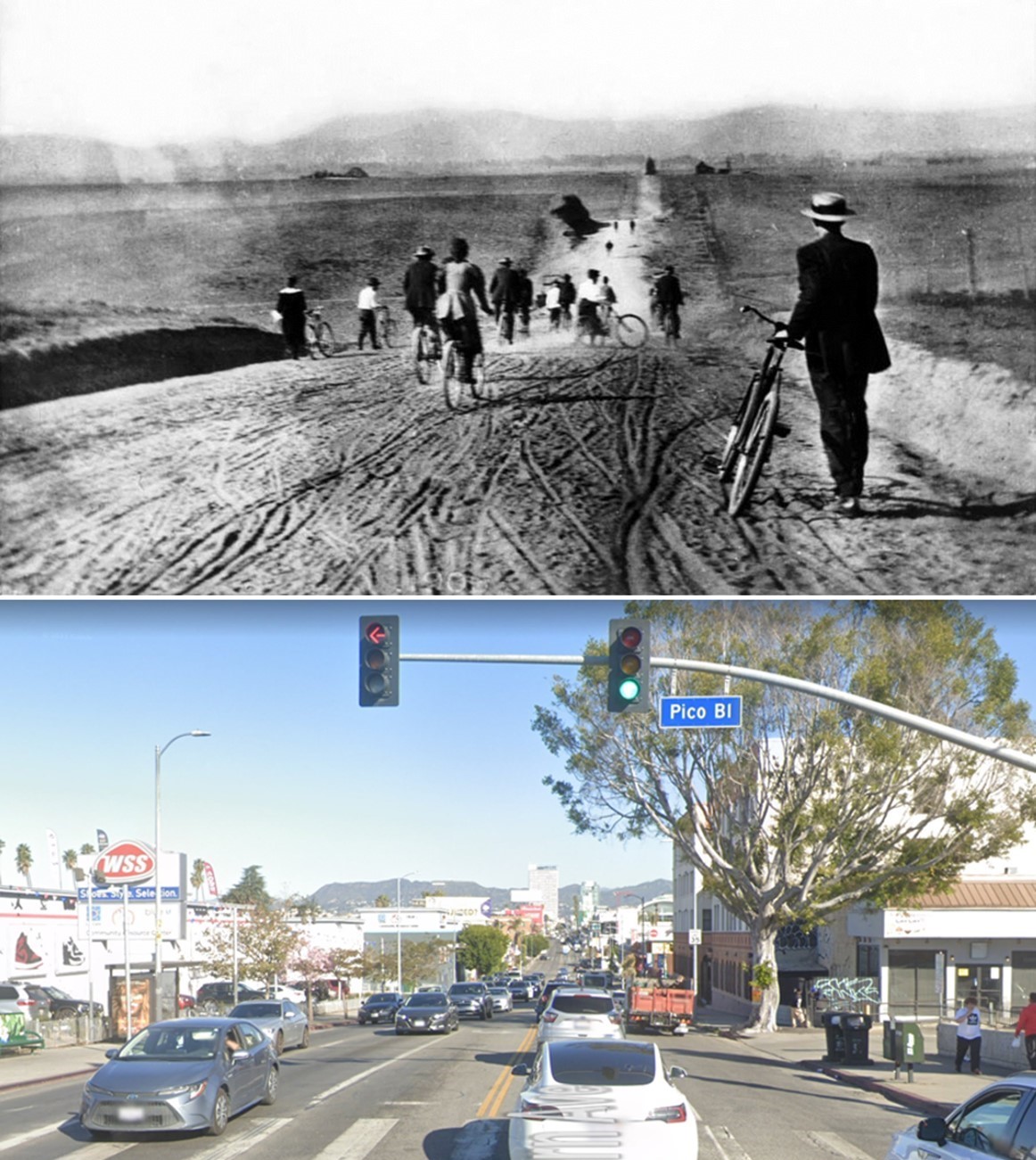 |
|
| (1895 vs. 2023)* - Western Avenue looking North from Pico Boulevard. |
Western and Santa Monica
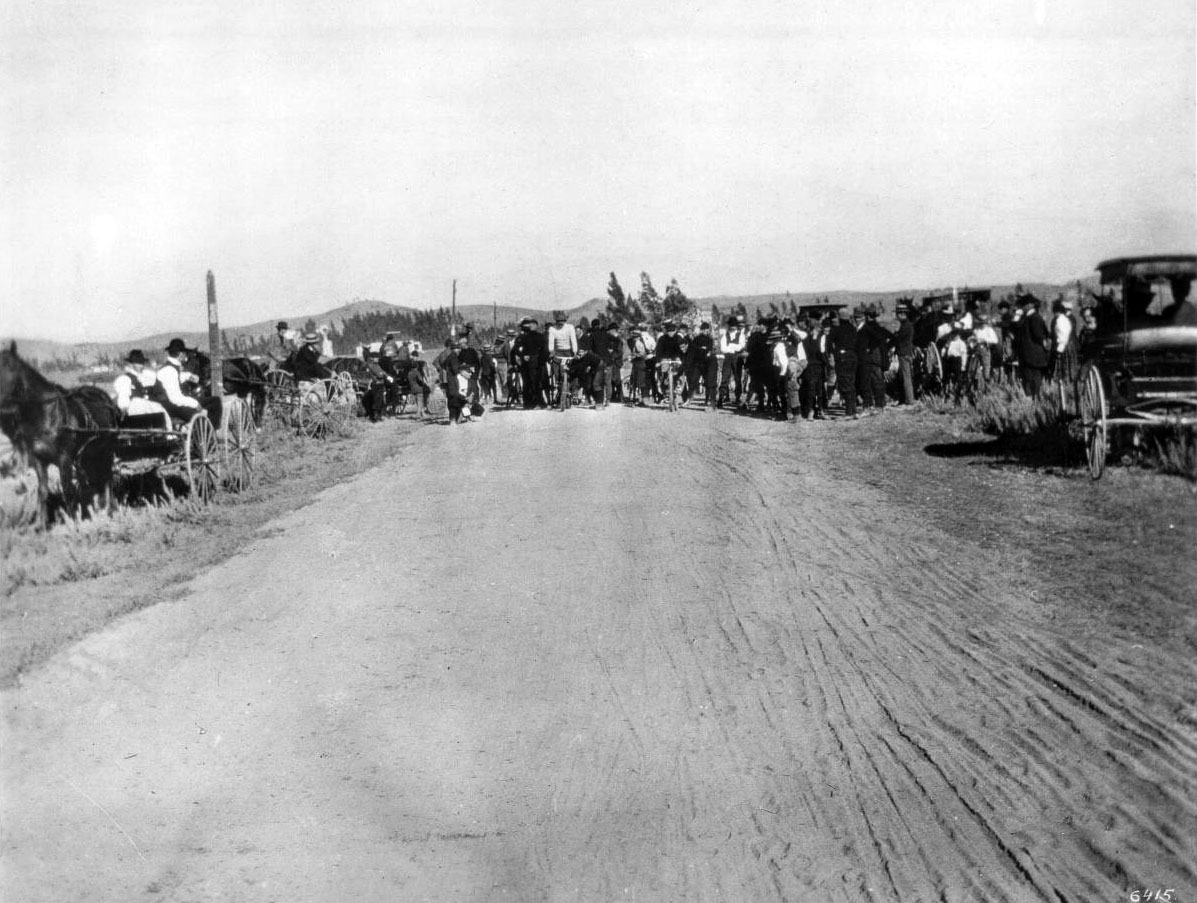 |
|
| (1896)^^ - Bicycle race on Western just north of Santa Monica Boulevard. |
Historical Notes Western Avenue derives its name from its history as the western–most border of Los Angeles city limits in the 19th century, before annexations in the early 20th century expanded the city westward and onwards.* |
Western and Melrose
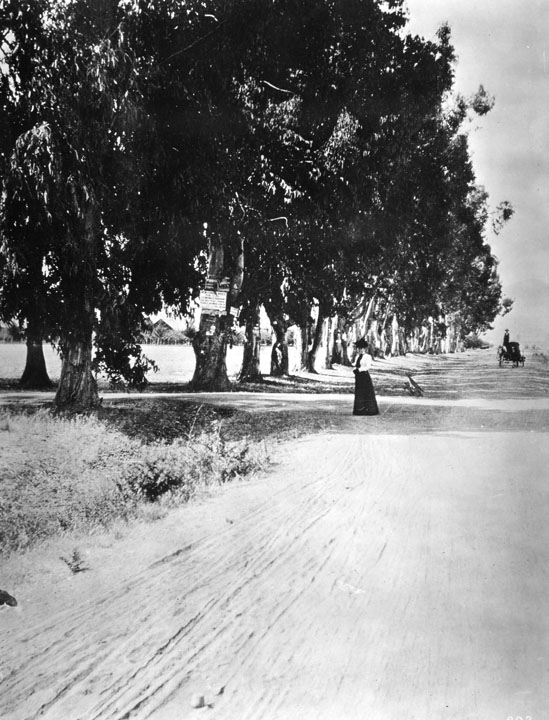 |
|
| (1899)^ - Western Avenue looking north from Melrose along a dirt road and a row of trees. |
Western and Washington
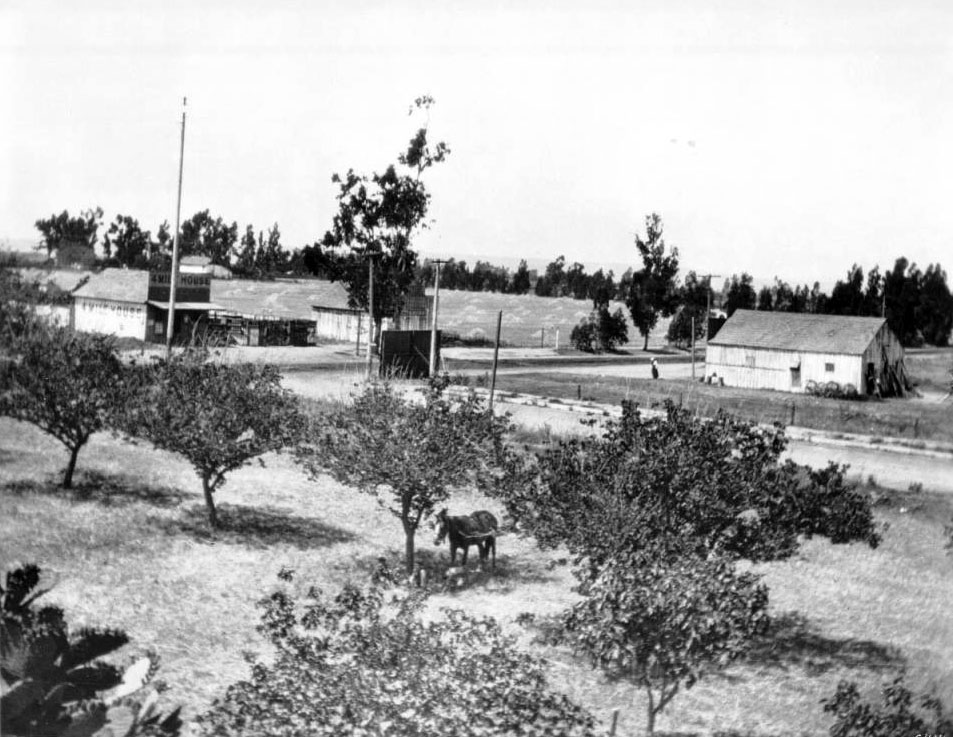 |
|
| (ca. 1897)^^ - Orchard at Western Avenue and Washington Boulevard. A mule or horse appears to be tied to a tree. |
* * * * * |
North Main Street
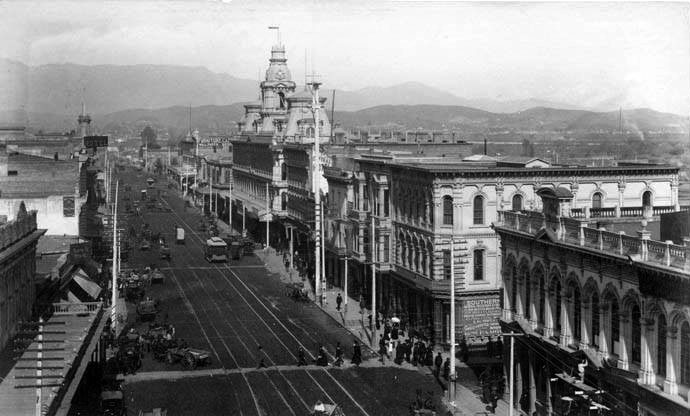 |
|
| (1898)#*** - View looking north on Main Street showing the Baker Block in the background. Pedestrians are seen crossing the streetcar tracks on Main Street in front of the Ducommun Building. One of the City's original 150-ft electric streetlights stands at center of photo. Click HERE to see more in Early L.A. Streetlights. |
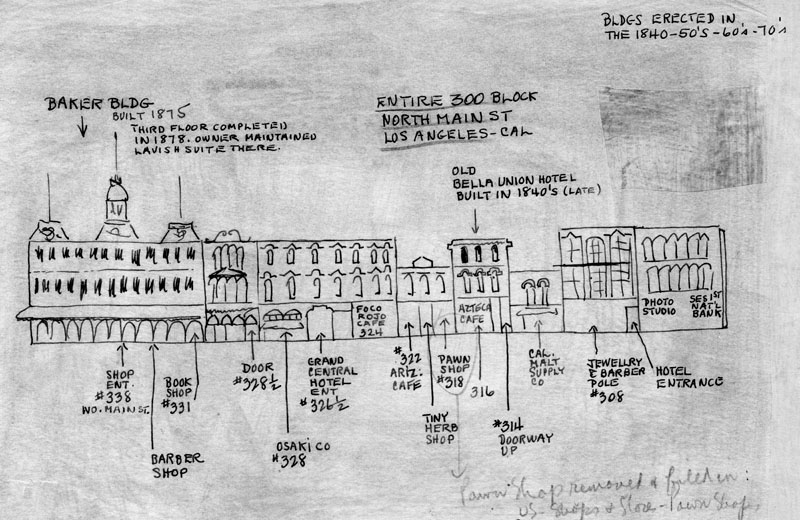 |
|
| (late 1800s)^ - Drawing of North Main Street showing the location of the businesses in the entire 300 block, starting with the Baker Block on the left. The building on the far right is the Ducommun Building, located at 304 N. Main Street. |
Click HERE to see more in Early Views of the Historic 300 Block of N. Main Street |
* * * * * |
View from First and Spring
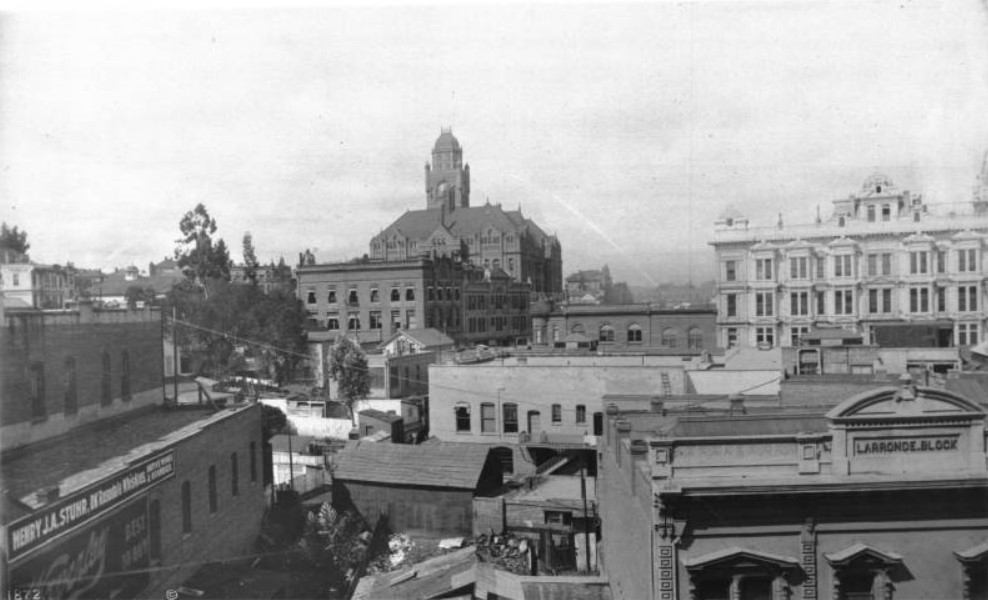 |
|
| (ca. 1890)^ - Panoramic view of downtown Los Angeles from Spring and 1st Streets looking north. The County Courthouse with clock tower is located on Poundcake Hill (former site of the high school) in the center background. At center-right is the Phillips Block (2nd 4-story building built in LA - 1887). Most of the buildings are two- or three-story brick structures. Mostly roofs are visible. Legible signs include: "Henry J.A. Stuhr, OK Rosedale Whiskies, native wines & brandies", "Waverly [...], best to buy", "Larronde Block", and "Los Angeles ABC Tract Co." |
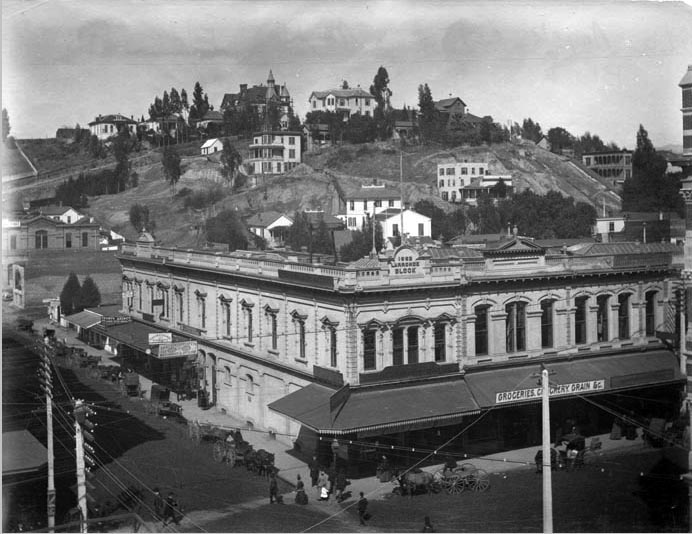 |
|
| (ca. 1898)^## - View of the northwest corner of Spring and 1st Streets showing the Larronde Block with Bunker Hill in the background. Horse drawn-wagons are parked in front of the Larronde Block and pedestrians are seen crossing the intersection. Sign on the awning facing Spring Street reads: "Groceries Crockery Grain - " |
Historical Notes At one time, the name Larronde was a fairly well known one in the City of Angels. Pierre Larronde was a native Frenchman who landed in San Francisco in 1847 and made a killing in the gold mines. When he relocated to Los Angeles in 1851, he amassed a further fortune by successfully raising sheep on one of the Ranchos. Always the astute businessman, Larronde cashed out his sheep empire in the late 1880s and focused his energies on real estate. His holdings included prime land at the corner of First and Spring, and a parcel on North Hope Street near Temple where he built the family home.#**# |
* * * * * |
Aliso and Alameda Streets
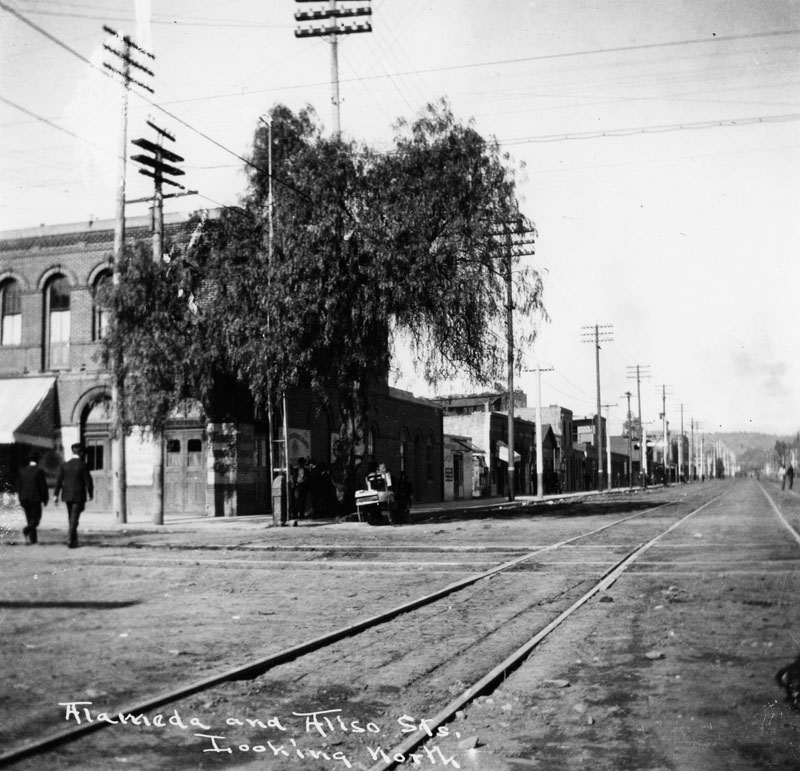 |
|
| (ca. 1890s)* - Looking north on Alameda Street at Aliso Street. |
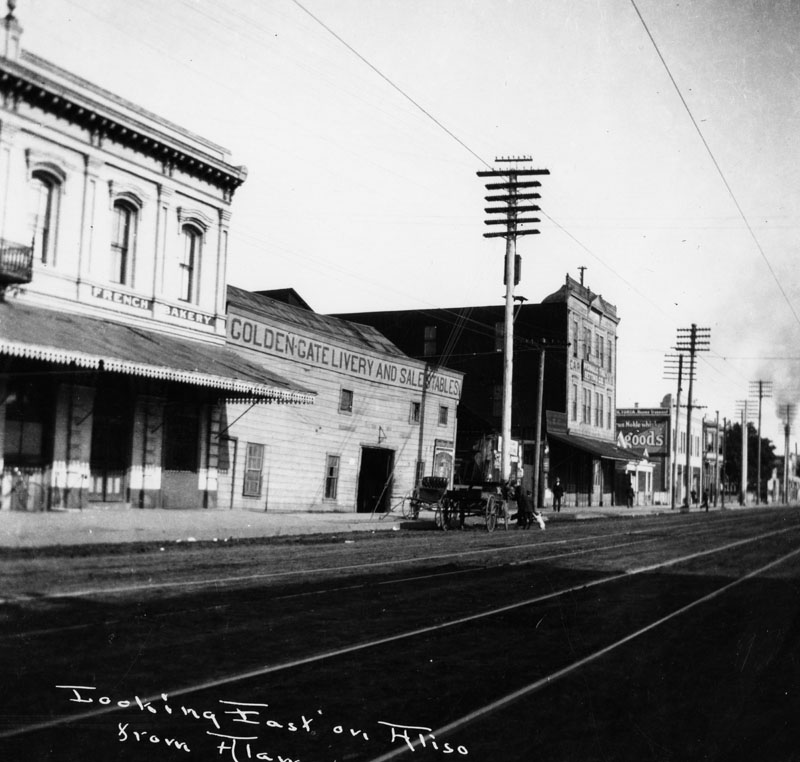 |
|
| (ca. 1890s)* - View looking east on Aliso Street from Alameda Street. A French bakery is seen next to the Golden Gate Livery and Sale Stables. |
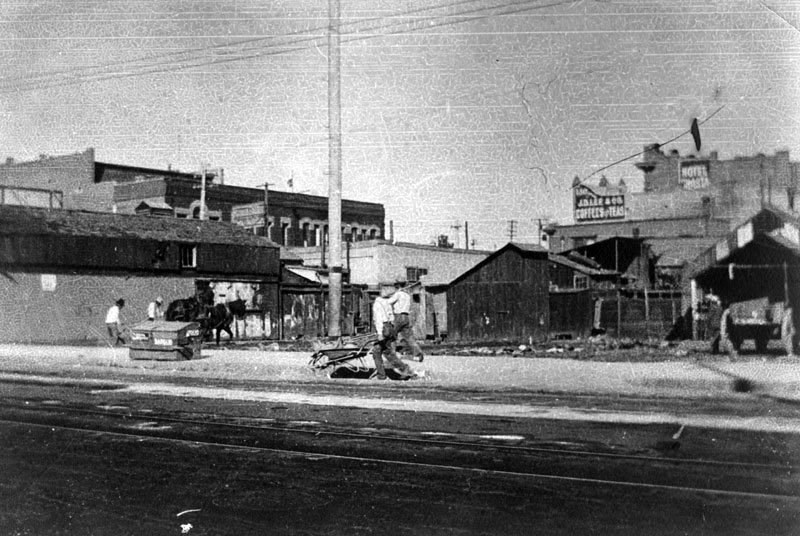 |
|
| (1898)* - Alameda Street north of Aliso Street showing men working in the street on June 6, 1898. |
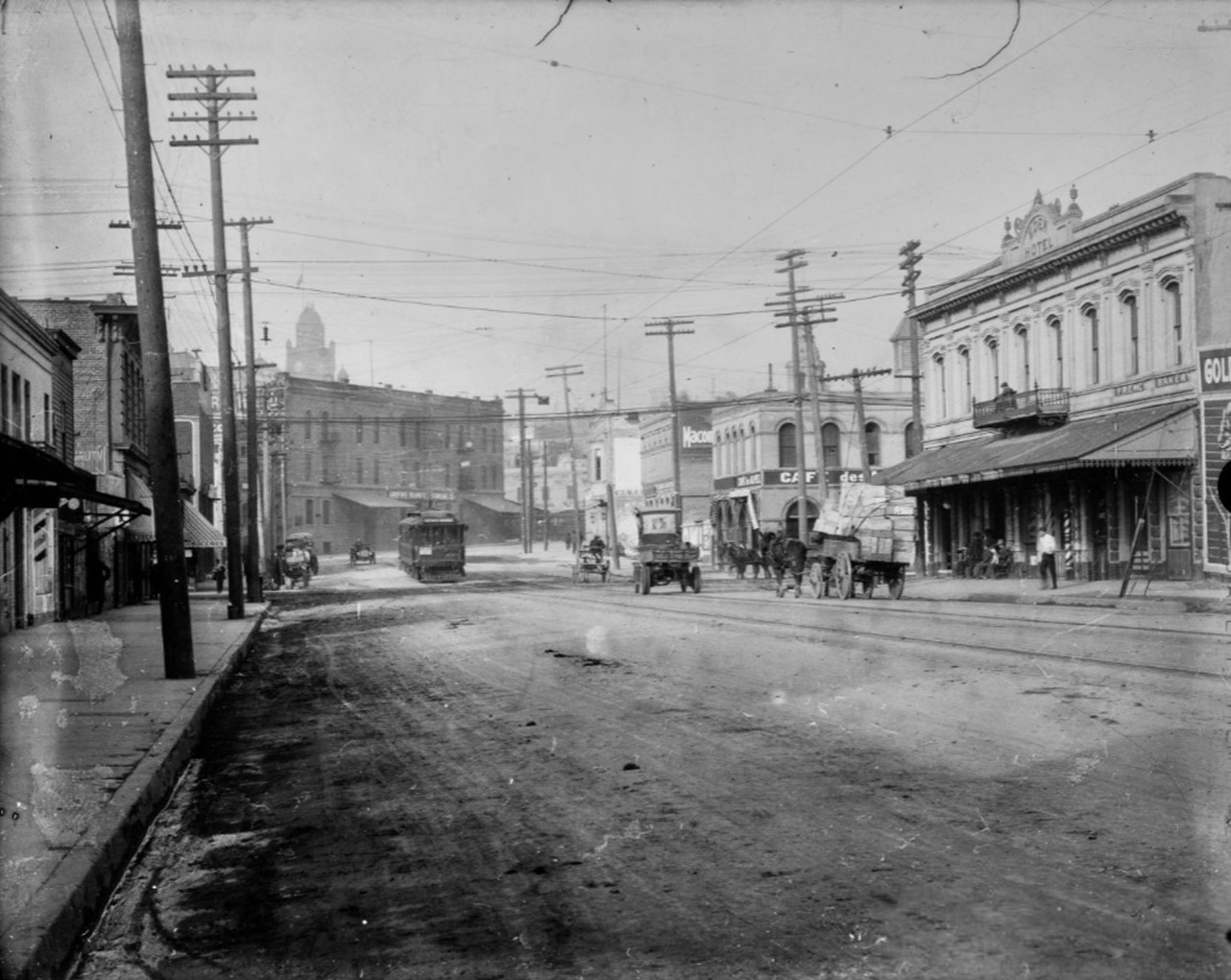 |
|
| (ca. 1905)* - Image of Aliso Street in downtown Los Angeles with signs labeling buildings "Griffins Transfer and Storage Co." and "Cafe des Alpes" next to "Eden Hotel," which are located on opposite corners of Aliso and Alameda Streets. A Pacific Electric streetcar sign reads "Sierra Madre" and automobiles and horse-drawn wagons are seen in the dirt road. |
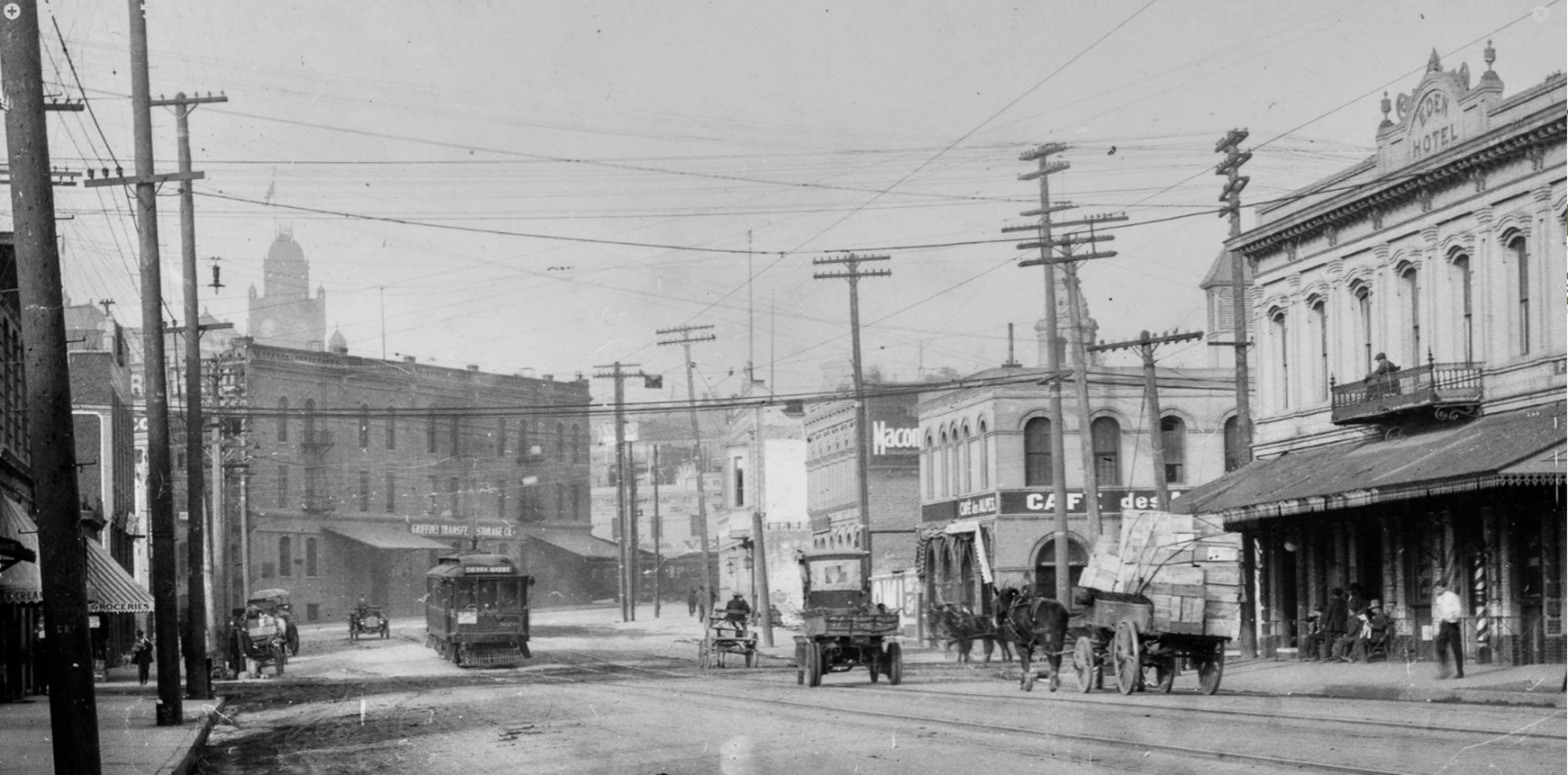 |
|
| (ca. 1905)* – Looking west on Aliso Street toward Alameda Street with the Eden Hotel on the NE corner on the right. The clock tower of the LA County Courthouse is seen the distance on Poundcake Hill. |
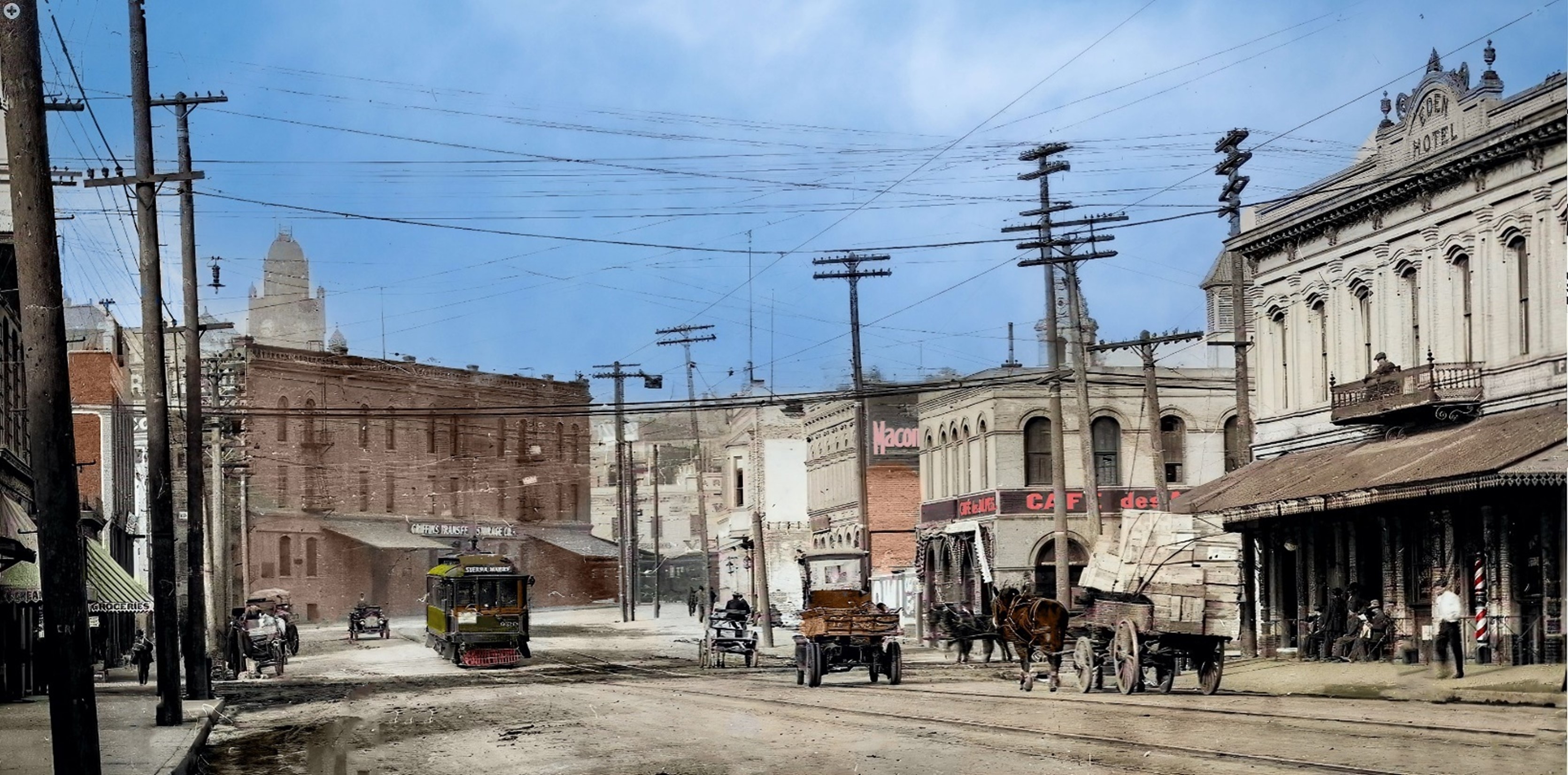 |
|
| (ca. 1905)* – Looking west on Aliso Street toward Alameda Street with the Eden Hotel on the NE corner on the right. The clock tower of the LA County Courthouse is seen the distance on Poundcake Hill. Image enhancement and colorization by Richard Holoff. |
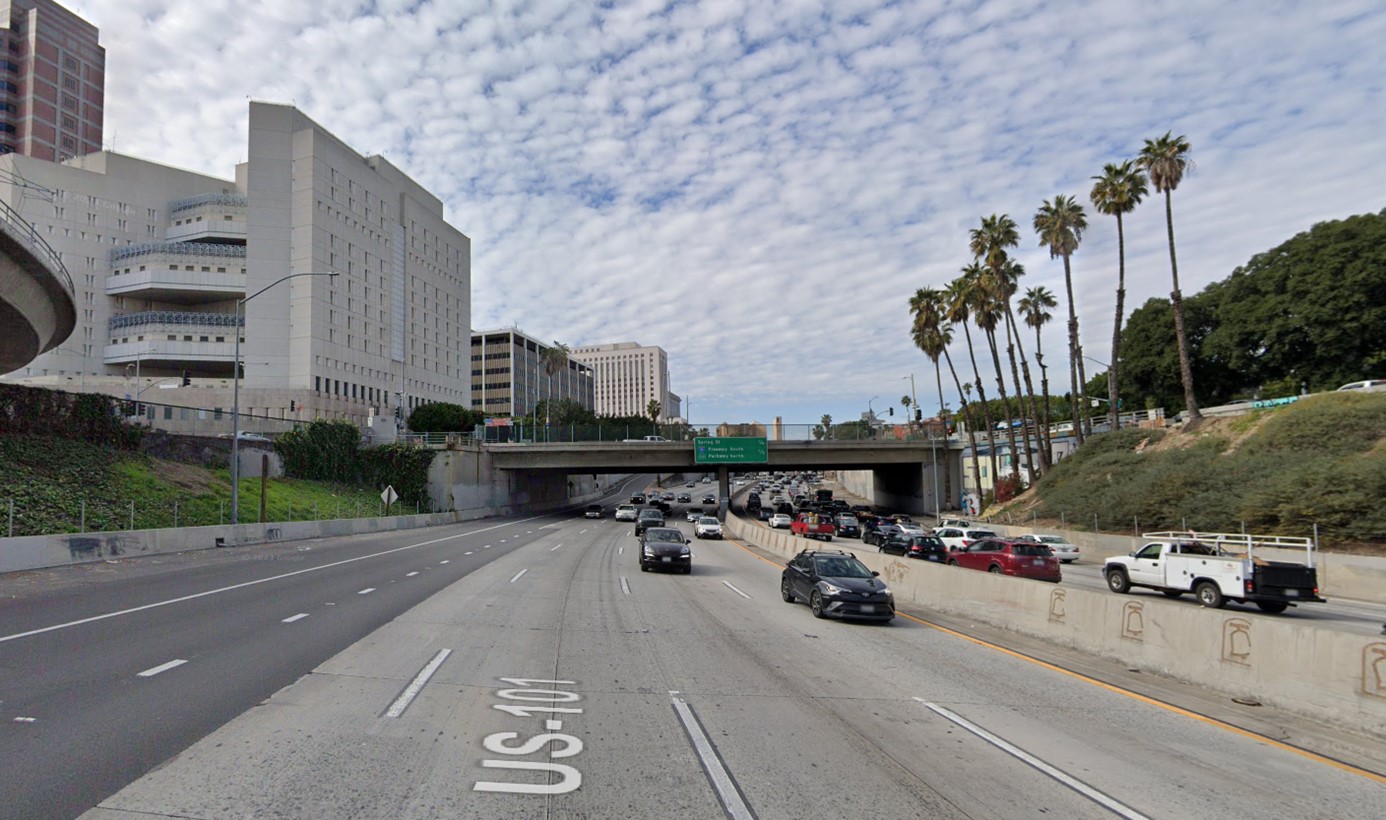 |
|
| (2023)* – Looking west on the US-101 Freeway toward the Alameda Street overcrossing. |
Then and Now
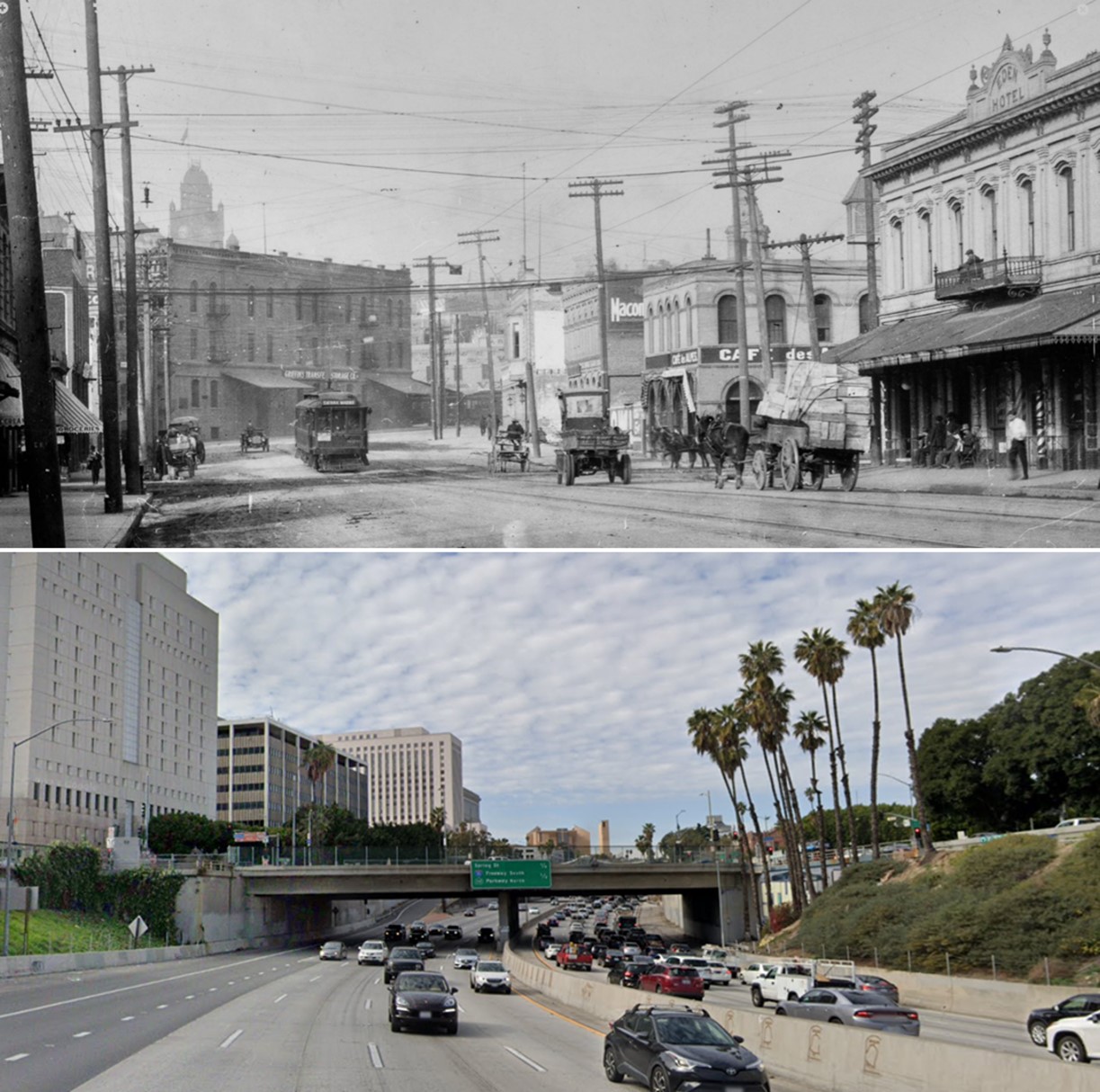 |
|
| (1905 vs 2023)* – Looking west on Aliso Street (today 101-Frwy) toward Alameda Street (today Alameda Street overcrossing). |
Aliso Street
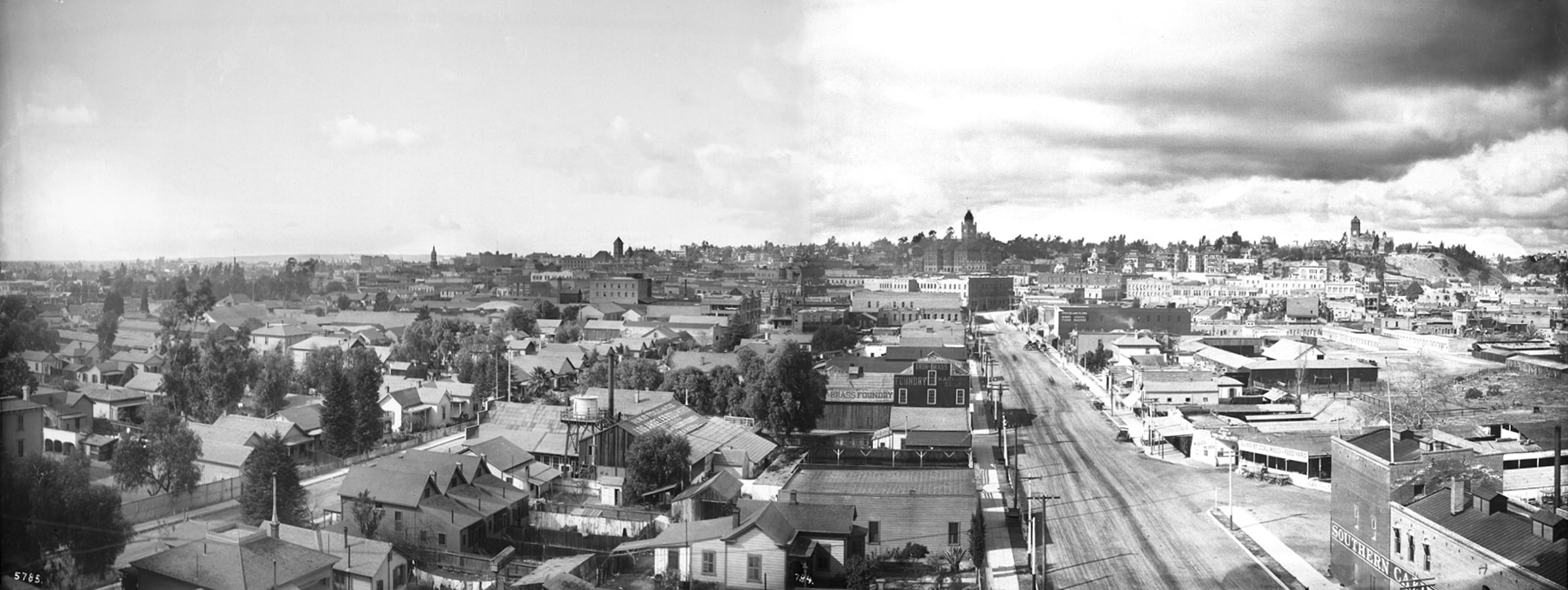 |
|
| (1899)* - Panoramic view of Los Angeles looking westerly on Aliso Street (right) from the brewery (Maier Brewing Co). Residential buildings cover a majority of the area in the foreground. Horse-drawn carriages are parked along the curb of the street at right. The tall building with the clock tower (center) is the LA County Courthouse. The tall building to the upper right, also with a clock tower, is Los Angeles High School. |
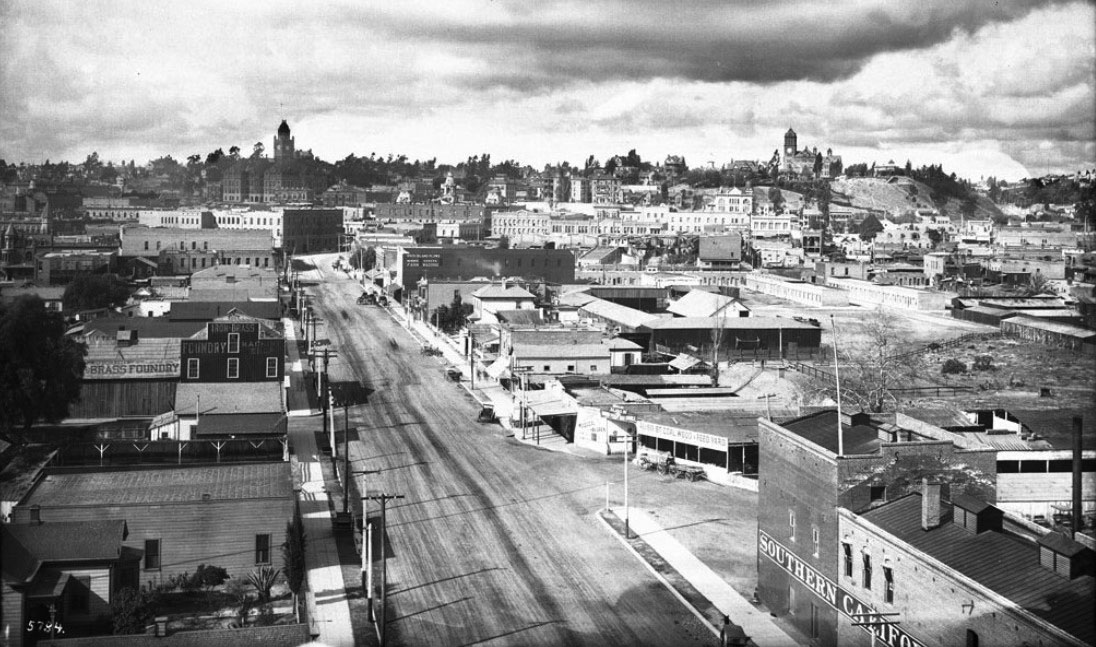 |
|
| (1899)* - Panoramic view of Los Angeles looking westerly on Aliso Street from the brewery (Maier Brewing Co). Residential buildings cover a majority of the area in the foreground. Horse-drawn carriages are parked along the curb of the street at right. The tall building with the clock tower to the upper left is the LA County Courthouse. The tall building to the upper right, also with a clock tower, is Los Angeles High School. |
Historical Notes Aliso Street was first named in 1854. When early settlers arrived at the Los Angeles River (El Rio de Nuestra Senora de Los Angeles de Porcinucula) by way of Mission Road, they picked as a nearby gathering point a huge sycamore that gave them shelter and became a landmark, "El Aliso." That Spanish word for sycamore was later used to name the road carved out near the river. The landmark "El Aliso" was located right about where this photo was taken from. Today, the tree's site is underneath an onramp for the 101 freeway, directly across the highway from Union Station. |
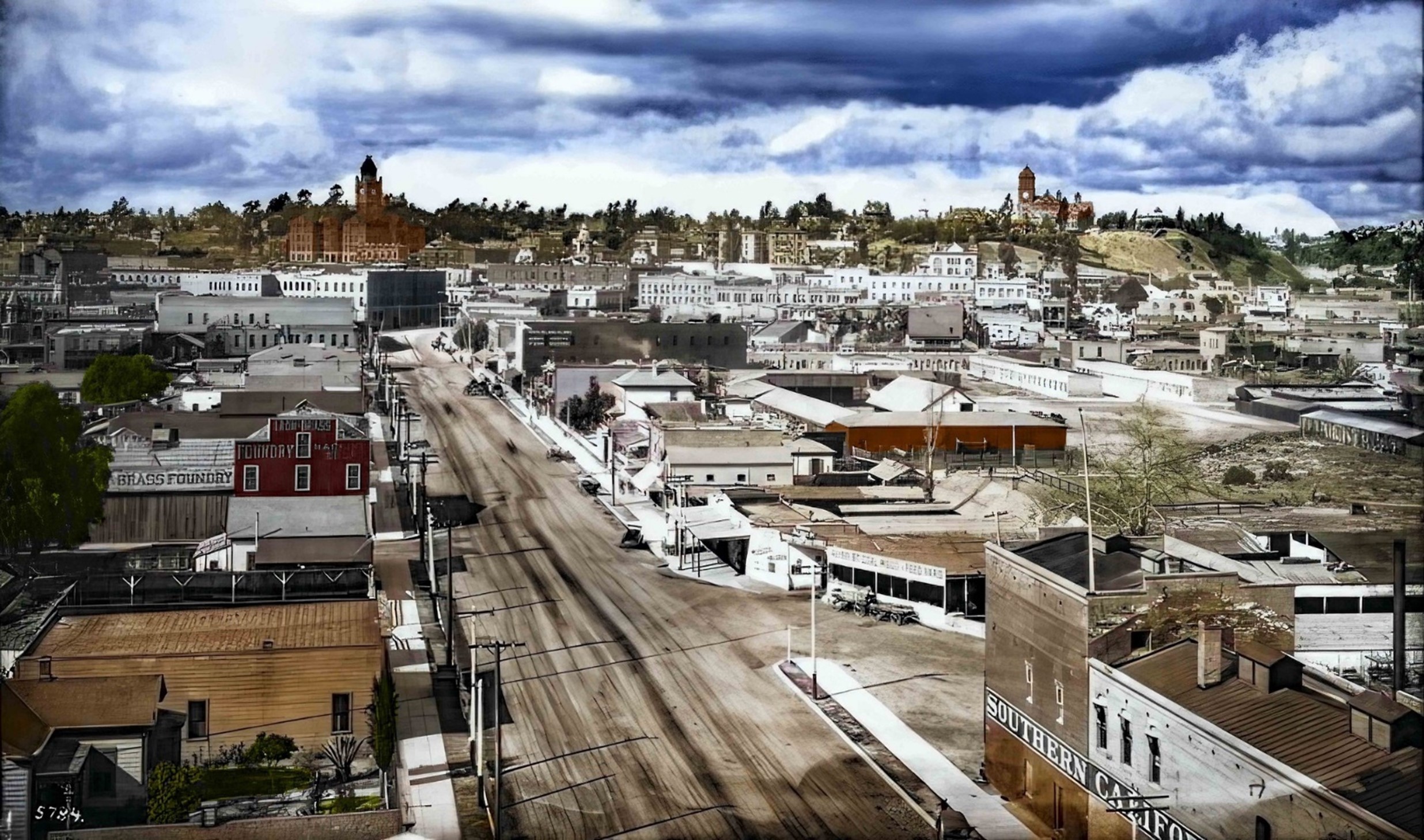 |
|
| (1899)* - Panoramic view of Los Angeles looking westerly on Aliso Street from the brewery (Maier Brewing Co). Residential buildings cover a majority of the area in the foreground. Horse-drawn carriages are parked along the curb of the street at right. The tall building with the clock tower to the upper left is the LA County Courthouse. The tall building to the upper right, also with a clock tower, is Los Angeles High School. Image enhancement and colorization by Richard Holoff |
Then and Now
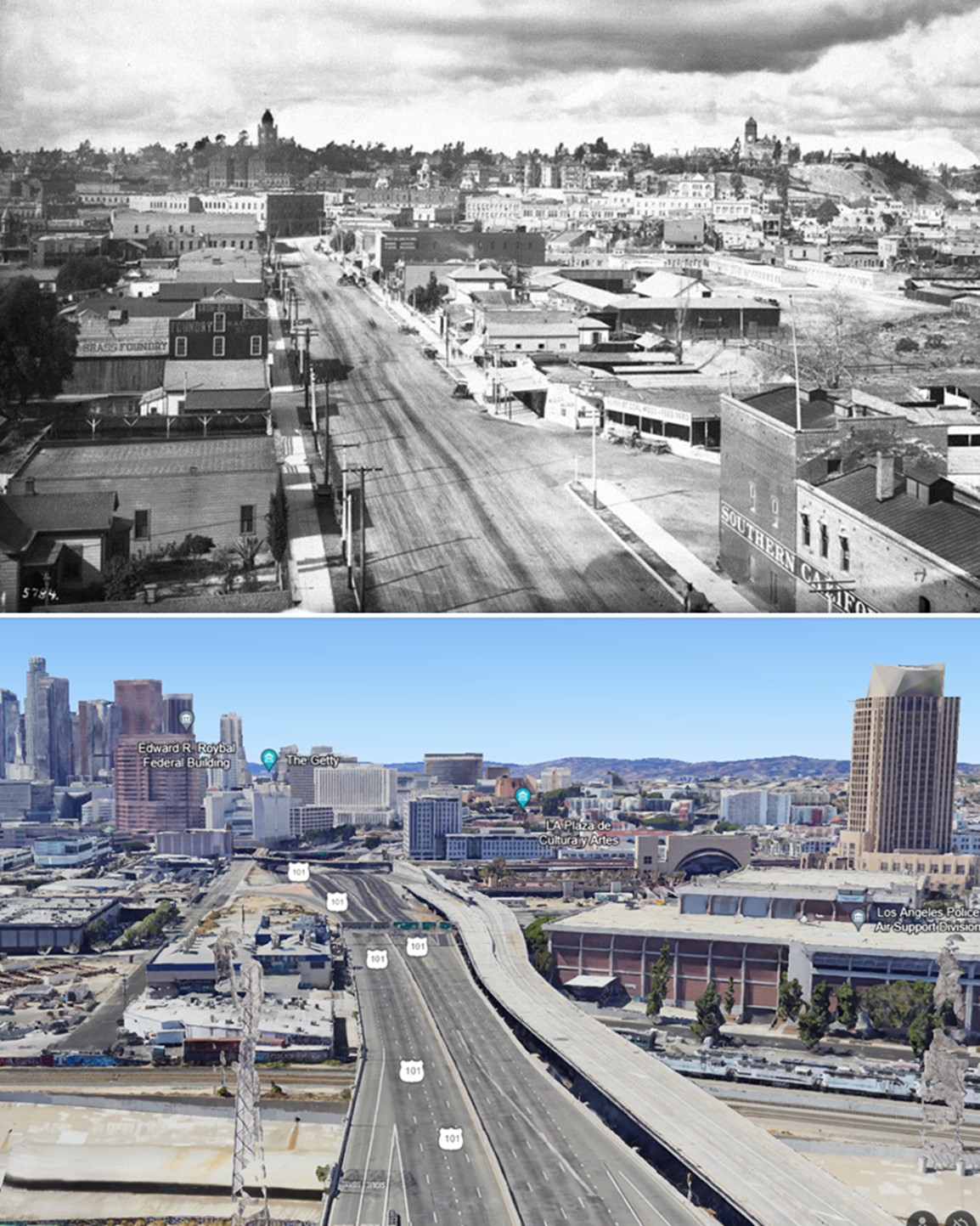 |
|
| (1899 vs 2022)* – Looking westerly on Aliso Street (today 101 Freeway) toward downtown Los Angeles. |
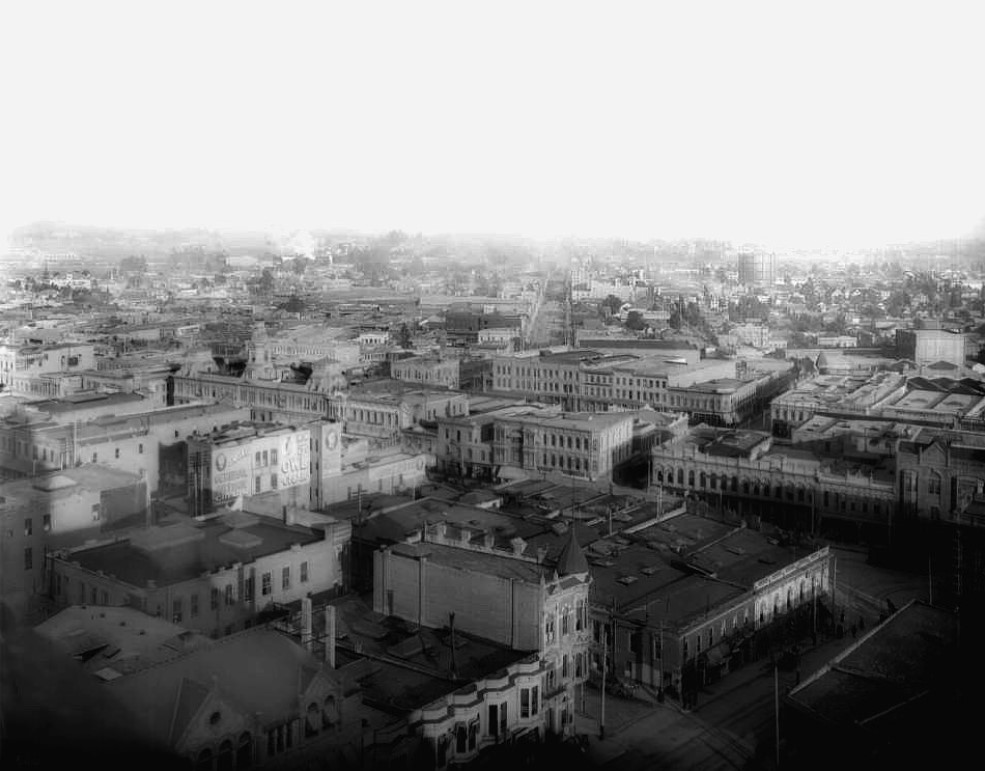 |
|
| (ca. 1900)^ – View looking northeast in line with Aliso Street as seen from the County Courthouse. Aliso Street did not extend past Los Angeles Street until the 1940s. Note the large tank to the right of Aliso Street. It was a gas holder (aka Gasometer) installed by LA Gas and Electric Corporation at the turn of the century. |
Historical Notes Aliso runs directly away from the camera in the middle distance. Baker Block is at center-left. The confluence of Temple, Spring and Main Streets is in the lower right. The intersection of Temple and New High Streets is in the bottom center-right at the base of the peaked turreted building. Central Jail is in the lower left corner beyond the blurred diagonal roof cornice from the courthouse. The section of today's Hollywood Freeway that runs through downtown goes right through where Aliso Street is shown above. It also makes a slight turn and runs directly under where the Baker Block once stood on the 300 block of North Main Street. Click HERE to see more in Early Views of the Historic 300 Block of N. Main Street |
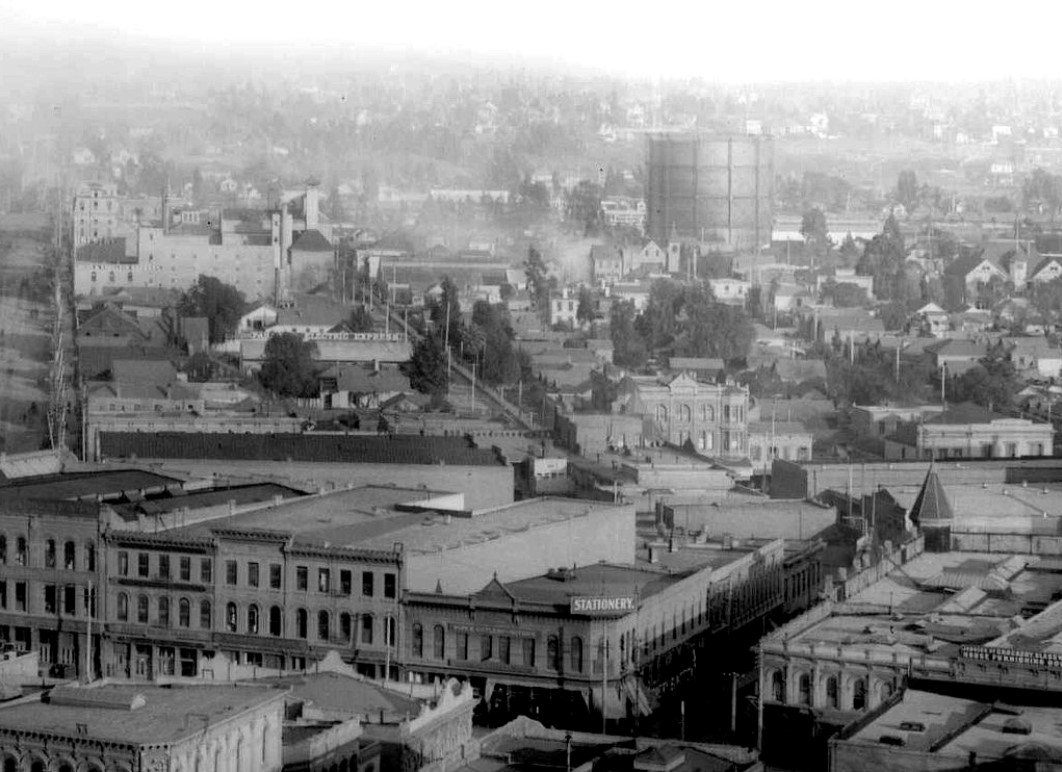 |
|
| (ca. 1900)^ – Closer view looking northeast from the County Courthouse with Aliso Street at left and the large Gasometer at top-right. |
Historical Notes Detail shows Aliso Street on the left edge with the Maier Brewery reaching through from Aliso to Commercial Street about halfway up the image. Hotel Oriental in bright sunlight, directly beneath the Gasometer and below the dark stand of trees at Commercial and Alameda Streets. Stationary store is on the northeast corner of Commercial and Los Angeles Streets. |
* * * * * |
Los Angeles Railway
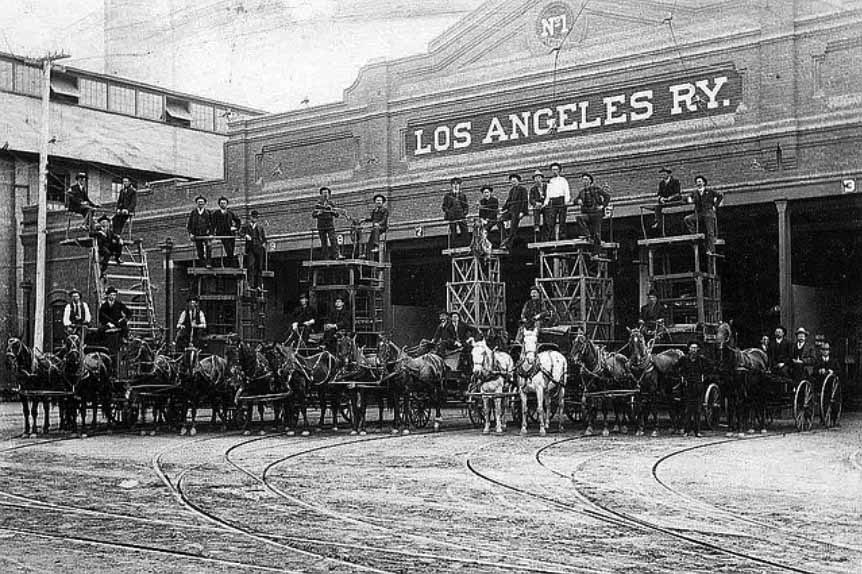 |
|
| (ca. 1899)*## – View of Los Angeles Railway (LARy) Division 1, horse-drawn tower wagons, facing Central Avenue south of 6th Street. This site is still in operation. |
Historical Notes Los Angeles Railway (1895-1945) also known as the Yellow Cars of Los Angeles, was the local streetcar transit system running down the center of city streets and connecting the city center to neighborhoods in about a six mile radius of downtown. The original address for the above site was 648 South Central Avenue, but was later changed to 1130 East Sixth Street. Today the division operates hundreds of natural gas powered Metro buses for the Gateway Cities Service Sector.* |
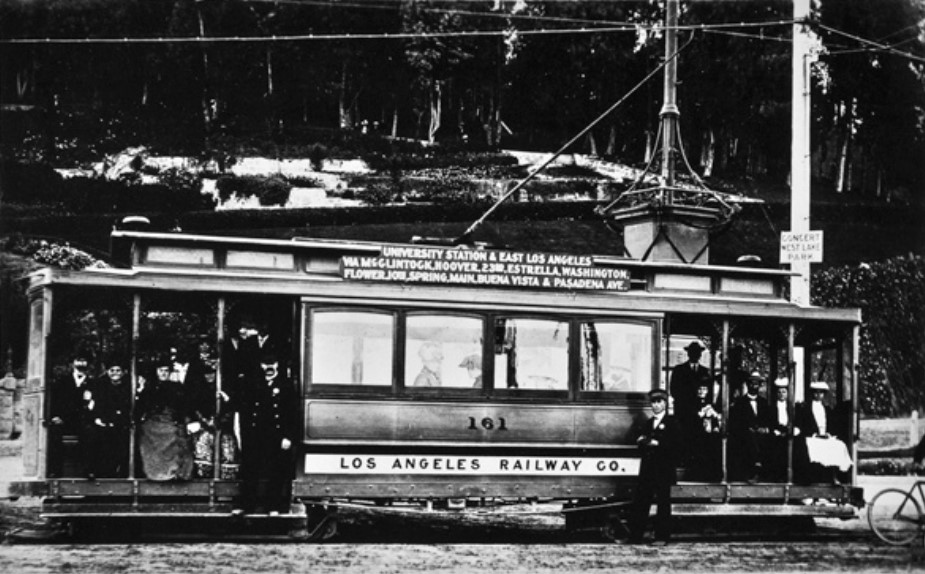 |
|
| (1900)*## – View showing No. 161, a former Main St and Agricultral Park car with Elysian Park behind. No. 161 was built in 1898 and scrapped in 1933. |
Historical Notes There were about 642 miles of track at its peak in 1924. Henry E. Huntington ran the system until his death in 1927. The Huntington Estate later sold LARy to Los Angeles Transit Lines in 1945.* Click HERE to see a map of the Los Angeles Railway System (Includes: LARy/Yellow Cars, PERy/Red Cars, LA Inter-Urban, LA Pacific R.R., and the LA & Redondo Ry). |
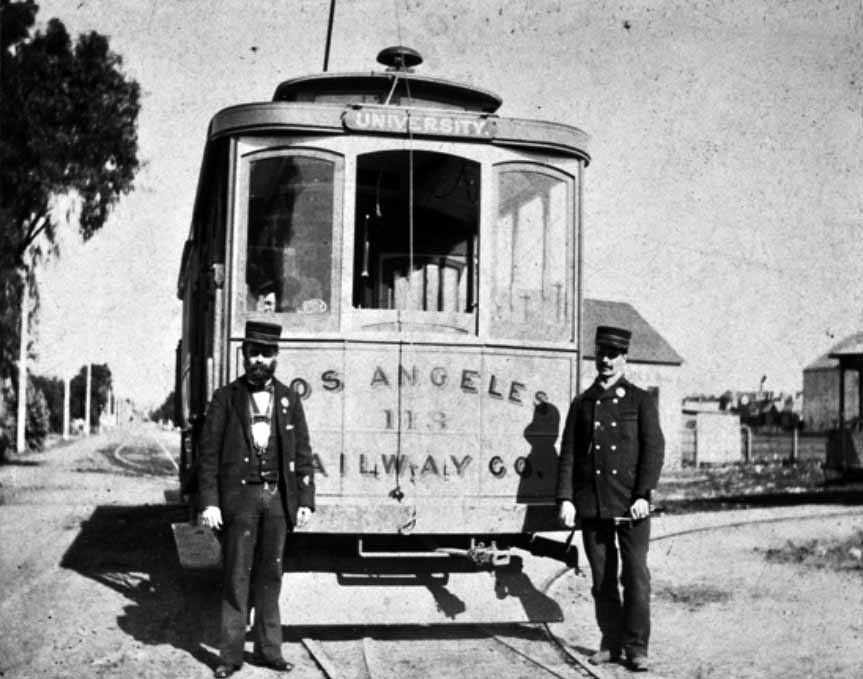 |
|
| (ca. 1900)*## – View showing two conductors standing in front of Los Angeles Railway Car No. 113 on 39th Street, opposite the entrance to Agricultural Park. |
Historical Notes The system slowly morphed into a bus system over the years until the last streetcar ran in 1963. After a 27 year absence, light rail returned to Los Angeles with the opening of the Metro Blue Line in 1990.* |
* * * * * |
Los Angeles Traction Company
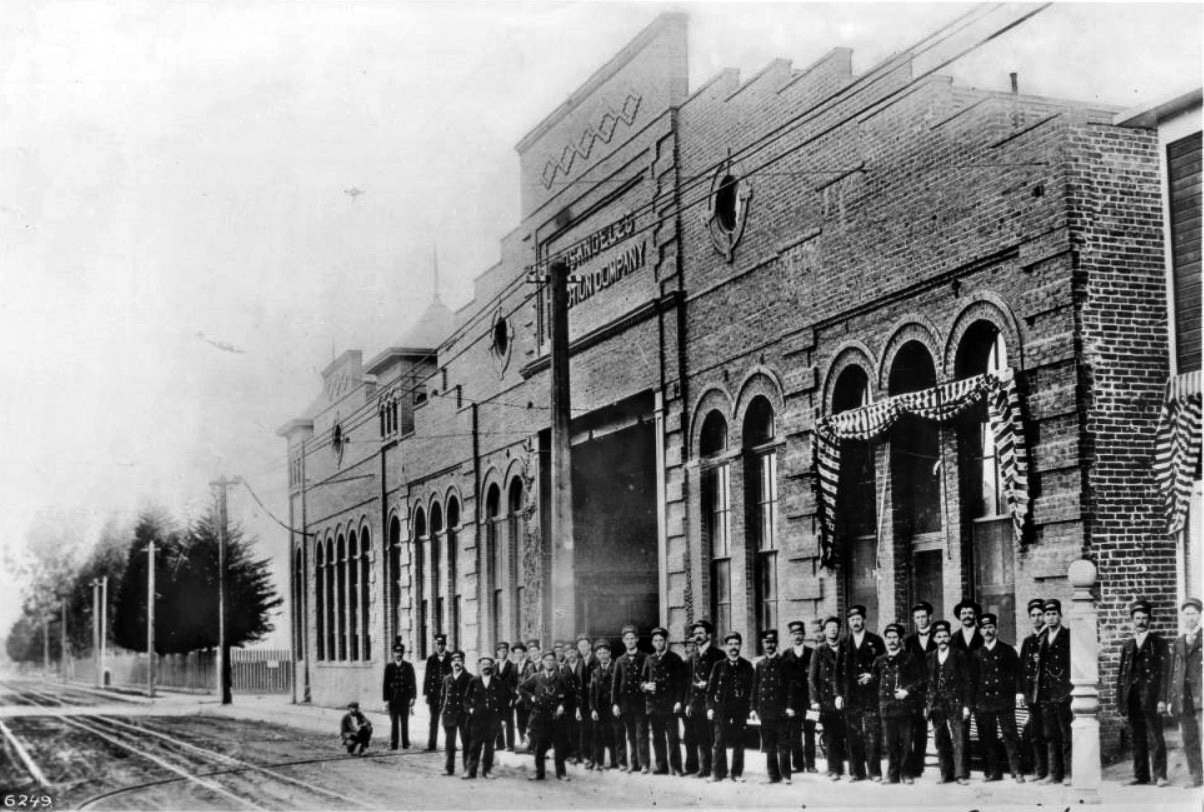 |
|
| (1897)^^ - The above is a photograph of the powerhouse and main offices of the L.A. Traction Company building on the southwest corner of Twelfth and Georgia Bell Streets. A group of thirty men in uniforms of what appear to be peacoats and kepi hats can be seen standing in front of the arched windows of the Traction Company building. Identifiable men include: Al Clifford, Captain of the Police Department, and Y.C. Knapp, the moustached man pictured in the back row. The brick building has tall, thin arched windows. A sign reading, "Los Angeles Traction Company" is visible above the entrance. Beyond the building, telephone poles recede into the background at the extreme left along a picket fence. |
Historical Notes W. S. Hook came here from Illinois in 1895 and organized the LOS ANGELES TRACTION COMPANY, and commenced to build a system of car lines. The first line starting at the Santa Fe Station, then by way of Third Street to Hill Street, Hill to Eighth Street; Eighth to Figueroa Street; Figueroa to Eleventh Street; Eleventh to Georgia Street; Georgia to Sixteenth Street; Sixteenth to Burlington Avenue; thence on Burlington Avenue, Hoover, Twenty-fourth and Vermont Avenue to Vermont Avenue and Thirty-ninth Street. This line was put in operation from the Santa Fe Station to Sixteenth Street and Burlington Avenue on the 29th day of August, 1895. The construction continued and in a few months the line was completed and in operation to Vermont Avenue and Exposition Boulevard and a year later was extended to Thirty-ninth Street. Franchises were obtained by the Los Angeles Traction Company, as follows: From Eighth Street, Lake, Seventh and Commonwealth Avenue to First and Virgil Streets. From Twenty-fourth Street and Vermont Avenue by way on Twenty-fourth, Normandie and West Adams to Western Avenue. From Jefferson and Wesley Avenue (now University Avenue) west on Jefferson to Fourth Avenue. On East Fourth Street and connecting streets from Third and Stephenson Avenue to First and Fresno Streets. All these lines were built and in operation by 1898.* |
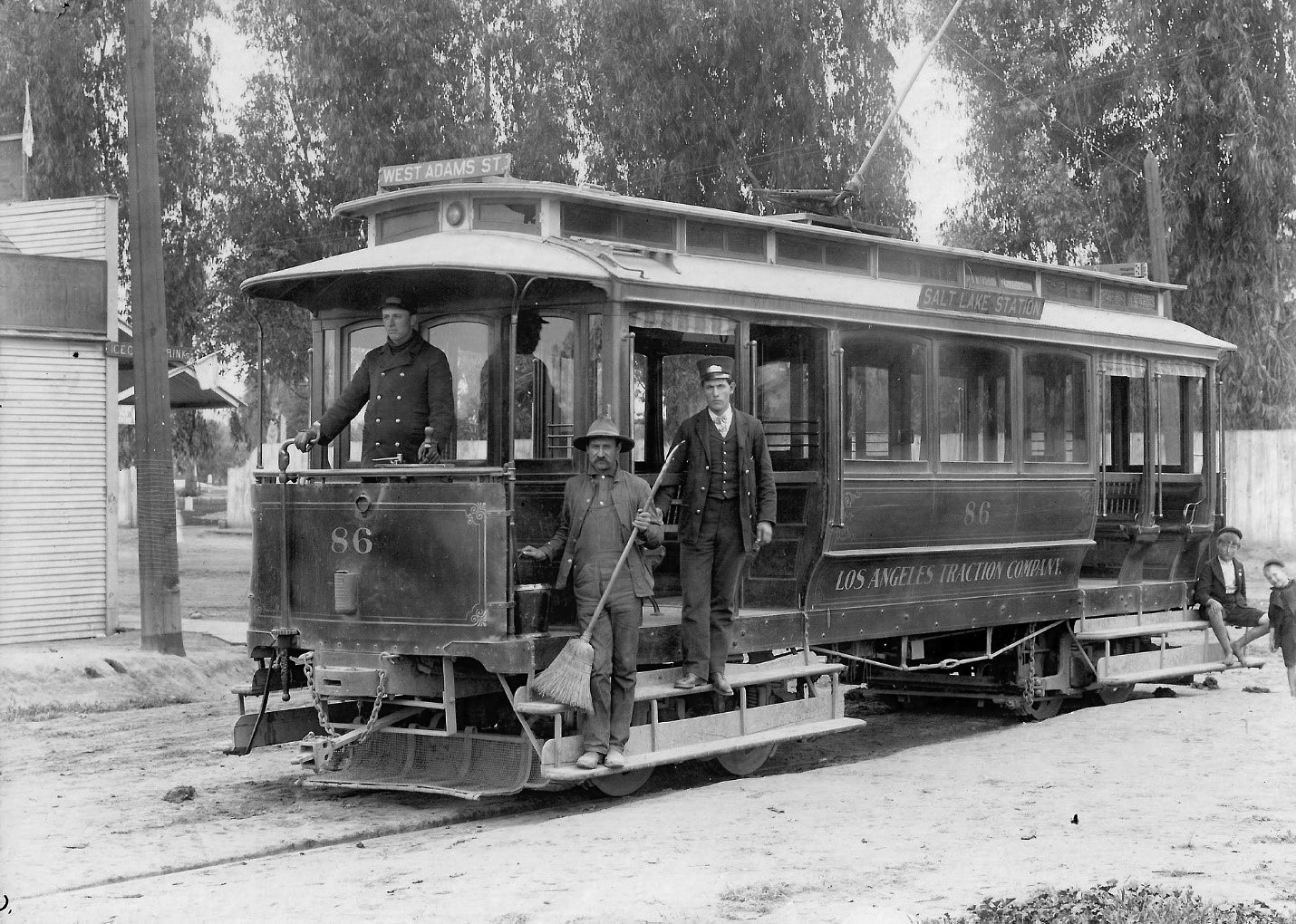 |
|
| (ca. 1899)^.^ - View showing a Los Angeles Traction Company streetcar at East First and Fresno Streets. Evergreen Cemetery is in the background. Pictured are the Motorman, Conductor and track sweeper. Also notice the two young boys at the back of the car. Soon the car will depart for its western terminal at Adams and Western Avenue, via Fresno, East Fourth, Merrick, Stephenson (now Traction Avenue), East Third, Hill Street, Eighth, Figueroa, Eleventh, Georgia Street, Sixteenth (now Venice Blvd.), Burlington Avenue, Hoover, Twenty-Fourth, Normandie Avenue, and West Adams. |
Historical Notes The Hooks sold their interests in the Los Angeles Traction Company to the Southern Pacific Company who continued to operate these lines until 1910 when they were transferred to the LOS ANGELES RAILWAY.* |
* * * * * |
Spring and Court Streets
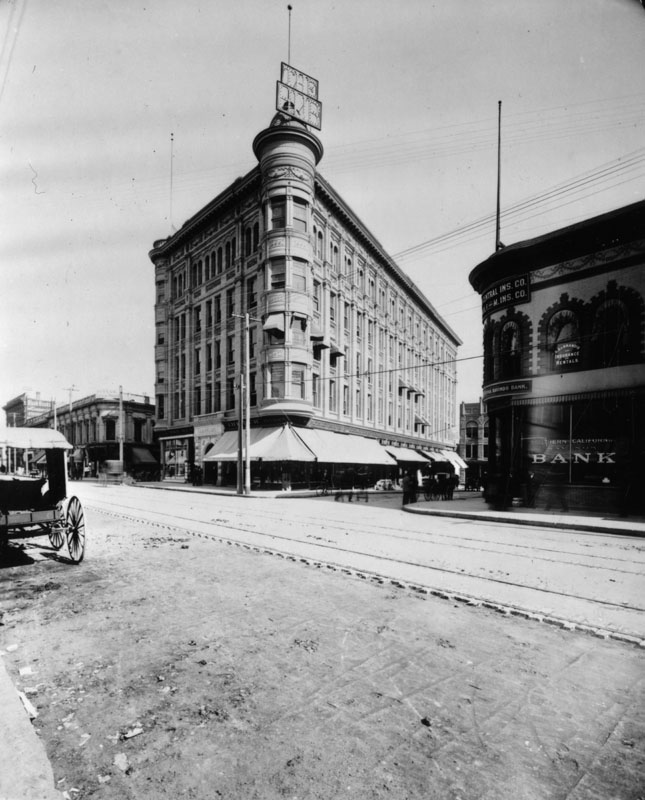 |
|
| (ca. 1900)^ - View of the John Anson Bullard Block on Spring and Court streets, looking north on Spring. Southern California Savings Bank is on the southeast corner across the street. Streetcar tracks are seen on Spring, and a carriage is parked at left. A lighted sign above the turret announces the bar in the building. |
Historical Notes The Bullard Block was once the site of the old Clocktower County Courthouse. Today, City Hall stands at this location. |
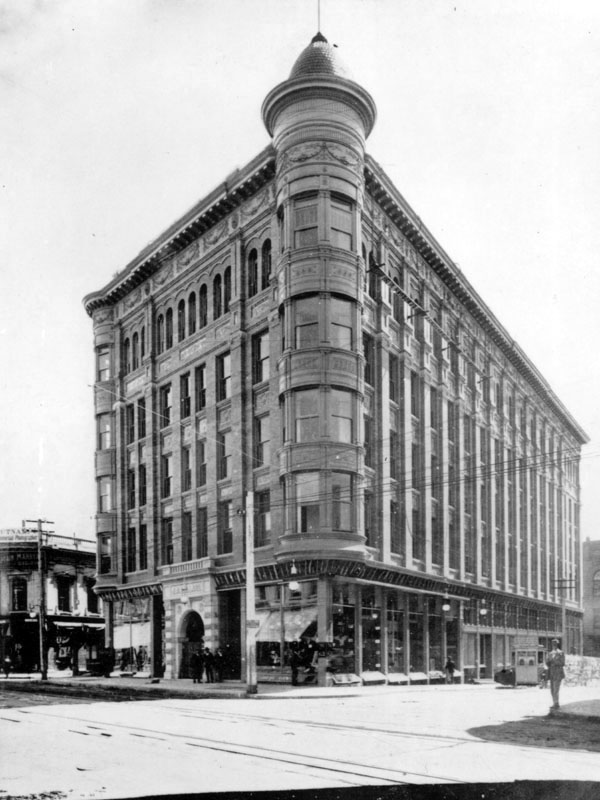 |
|
| (ca. 1900)^ - Closer view of the intersection of Spring and Court streets. The Bullard Building stands on the northeast corner. |
Historical Notes Click HERE to see more Early Views of Spring and Court Streets (1800), where the old Clocktower County Courthouse. Today, City Hall stands at this location. |
* * * * * |
Los Angeles Plaza
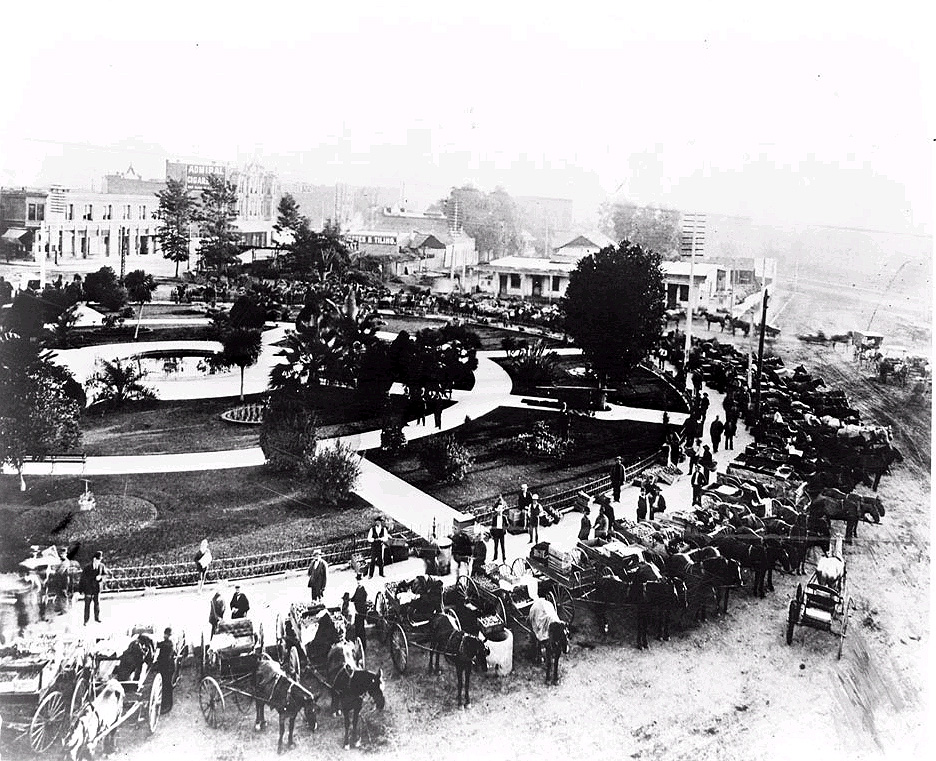 |
|
| (ca. 1900)^*# - Open air market at the Los Angeles Plaza. View is looking northwesterly from the Plaza Firehouse. The Old Mission Church is out of view to the left. |
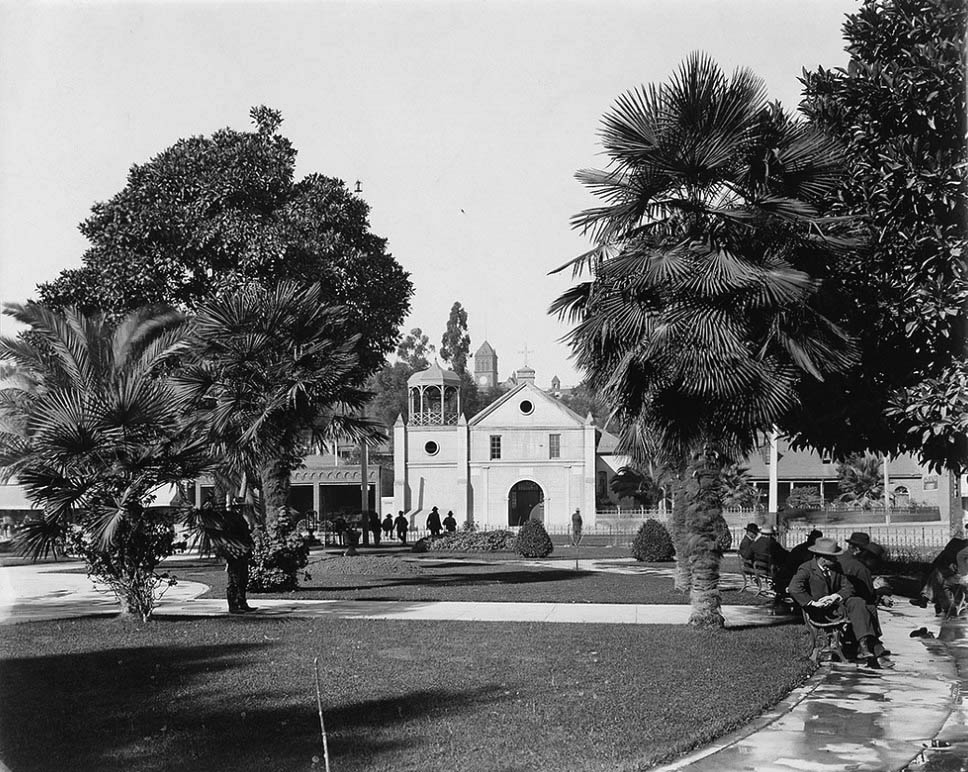 |
|
| (ca. 1900)*#*#* - View of the Old Mission Church from across the LA Plaza. Several men are seen relaxing on the Plaza's benches. There is a clear view of Los Angeles High School (2nd location, built in 1891) up on Fort Moore Hill and its relative relationship to the Plaza and the Plaza Church. |
Historical Notes The new Los Angeles High School replaced the original one that was built in 1872, at the former site of Central School on what was then known as Poundcake Hill, at the southeast corner of Fort Street (later Broadway). This second location atop a hill was completed in 1891 and LAHS moved in. It was an enormous, for then, building. The new high school was built on part of the site of the abandoned Fort Moore Hill Cemetery, the first Protestant cemetery in Los Angeles, which was spread over the slopes of the hill. Early buildings commissioned to house the Los Angeles High School were among the architectural jewels of the city, and were strategically placed at the summit of a hill, the easier to be pointed to with pride. One of the school's long standing mottos is "Always a hill, always a tower, always a timepiece." ^* |
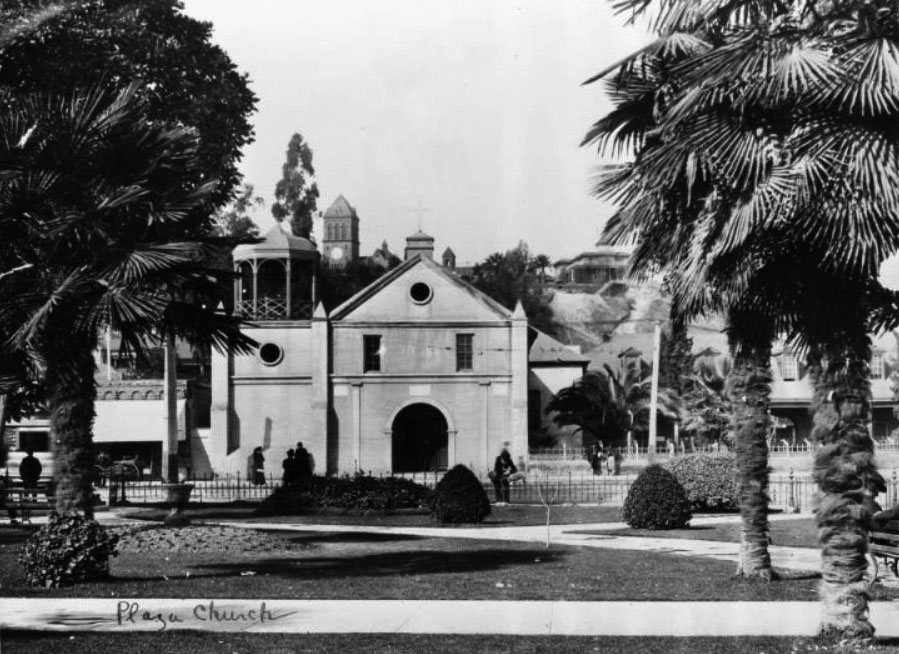 |
|
| (ca. 1900)^^- Closer view of the Old Plaza Church as seen from the Los Angeles Plaza. The clock tower of Los Angeles High School can be seen in the background. |
Historical Notes This would be one of the last photos taken of the Plaza Church with its gazebo-like tower. It would soon be replaced with a "bell wall" similar to the one it had prior to 1861.*^ |
 |
|
| (ca. 1900)^*# - Front view of the Old Mission Church with its newly installed "bell wall", similar to the one it had prior to 1861. |
Before and After
 |
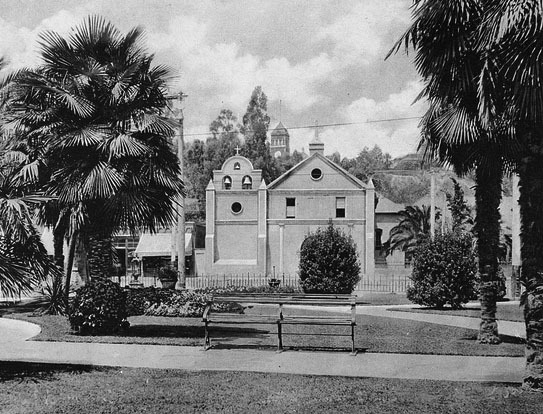 |
|
| (ca. 1900)^^ - Old Mission Church with "Gazebo Tower" |
(ca. 1901)^*# - Old Mission Church with "Bell Tower" |
Click HERE to see more in Early Plaza of L.A. |
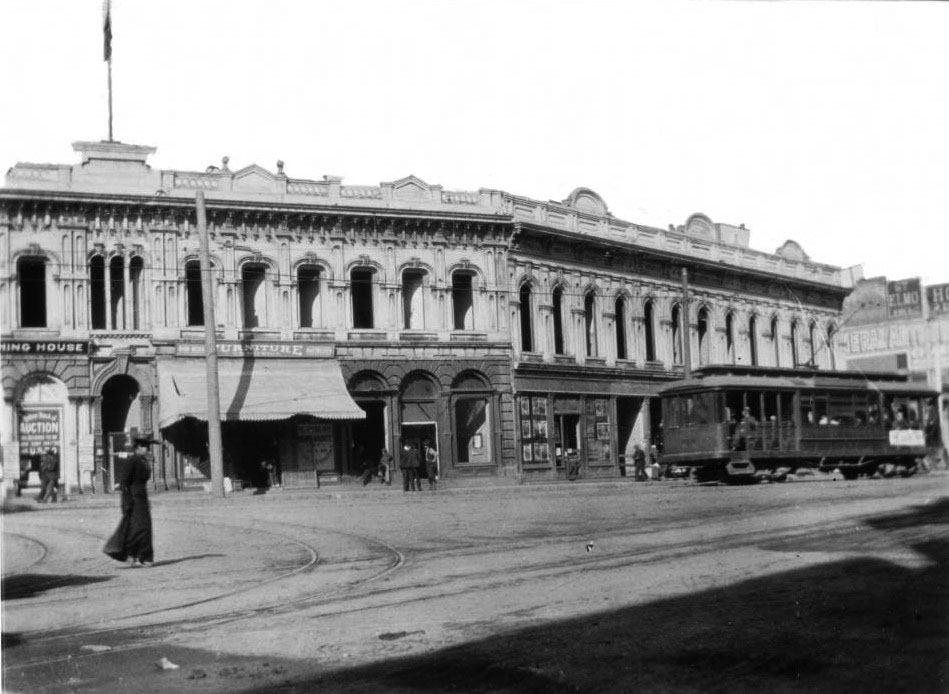 |
|
| (1900)^^ – View looking northwest showing the Downey Block on the northwest corner of Main and Temple streets. There is a streetcar in the street in front of the building at right, and several pedestrians can be seen as well. |
Historical Notes The Downey Block was demolished in 1904. Since then the corner has been the site of two Federal Buildings: the Federal Building and Post Office (1910 - 1937) and the Federal Courthouse and U.S. Post Office Building (1940 - Present). |
* * * * * |
More Historical Early Views
Newest Additions
Early LA Buildings and City Views
History of Water and Electricity in Los Angeles
* * * * * |
Please Support Our CauseWater and Power Associates, Inc. is a non-profit, public service organization dedicated to preserving historical records and photos. We are of the belief that this information should be made available to everyone—for free, without restriction, without limitation and without advertisements. Your generosity allows us to continue to disseminate knowledge of the rich and diverse multicultural history of the greater Los Angeles area; to serve as a resource of historical information; and to assist in the preservation of the city's historic records.
|
References and Credits
* DWP - LA Public Library Image Archive
^ LA Public Library Image Archive
^* The Valley Observied: Street Name Origins; Timeline of Valley History
^# Chatsworth Historical Society
#^ Huntington Digital Library Archive
*# Publications of the Historical Society of Southern California, Volume 9: Eternity Street
***Los Angeles Historic - Cultural Monuments Listing
+**Facebook.com: Old Photos of Los Angeles
*^*California Historical Landmarks Listing (Los Angeles)
*#*KCET: When L.A.'s Most Famous Streets Were Dirt Roads
*^#Public Art in LA: Campo Santo
*##Metro.net - Los Angeles Transit History
^##California State Library Image Archive
**#The Cable-Car-Guy.com: The Los Angeles Railway; Temple Street Cable Railway
^^#CSULB - A Visit to Old LA: Hamburger Dept. Store; Overhead Line Congestion on Spring
^*#Noirish Los Angeles - forum.skyscraperpage.com; Arcade Palm Tree; Spring St. Central Market; Adams and Figueroa; Westminster Hotel; Angels Flight; Robinson Manison and Teed Street; Main and 4th; Hollenbeck Park
#^*Flickr.com: Michael Ryerson
^#*LA Almanac: First Automobile in Southern California
^#^Historic Hotels of Los Angeles and Hollywood (USC - California Historic Society: Van Nuys Hotel
**^History Matters: Calle de los Negros, 1880s
^^*LA Fire Department Historical Archive
^^^LA Times: The Gush of Oil Was Music to 'Queen's' Ears; Gas-powered carriage didn't have much speed to burn
****Theeastsiderla.com: Angelino Heights Oil Boom
***^TheZephyr.com: O.T. Johnson
***#Historicechopark.org: Echo Park Lake
#***Photos of Vintage Los Angeles: Facebook.com
++^^Boyle Heights History Blog: Hollenbeck Park
*^^*Los Angeles Past: City Hall (ca. 1895)
^*^*KCET - El Aliso: Ancient Sycamore Was Silent Witness to Four Centuries of L.A. History
^*^#Facebook.com - Bizarre Los Angeles
*^#*Automobile Club of Southern California
*#**Mojave Desert.net: Remi Nadeau
*#^*USC Facebook.com
*###Nuestra Señora Reina de los Angeles Asistencia Gallery
^#*#Electronic Scrapbook of Alhambra History
*##^The Street Railway History of Los Angeles - erha.org
^##*Pacific Coast Architecture Database (PCAD): Bryson-Bonebrake Block
^###Exposition Park History - Expositionpark.org
^^##UC Irvine - The White City by Miles Clement
^**^Wikipedia Images: Early L.A. Oil Wells
#^^*Early Downtown Los Angeles - Cory Stargel, Sarah Stargel
#^*^Calisphere: University of California Image Archive
#*#*Walk N Ride LA: Exposition Park
#*#^LAPL-El Pueblo de Los Angeles Historical Monument Photo Archive
#*^^The Department Store Museum: J. W. Robinson's
#**#On Bunker HIll: Larronde Block and Residence; Crocker Mansion
#*^#Google Maps
*#*#*Flickr.com: Views of Los Angeles
*^ Wikipedia: Arcadia Bandini de Stearns Baker; Bunker Hill; Prudent Beaudry; Jonathan Temple; Los Angeles High School; Joseph Widney; Pershing Square; Port of Los Angeles; Belmont High School; Hollenbeck Park; Ducommun; Isaias W. Hellman; Abel Stearns; Sawtelle Veterans Home; Arcade Station; Alhambra; Fort Moore; History of Santa Monica; History of Los Angeles; Burbank; Mt. Lowe Railway; Los Angeles City Oil Field; La Grande Station; MacArthur Park; Los Angeles Athletic Club; Western Avenue; History of Los Angeles Population Growth; Garvanza, Los Angeles; Highland Park; Cawston Ostrich Farm; Arroyo Seco; History of Santa Monica; Los Angeles and Independence Railroad; Pío Pico; John Edward Hollenbeck; Alvarado Terrace Historic District; Sawtelle, Los Angeles; Angelino Heights; Angels Flight
< Back
Menu
- Home
- Mission
- Museum
- Major Efforts
- Recent Newsletters
- Historical Op Ed Pieces
- Board Officers and Directors
- Mulholland/McCarthy Service Awards
- Positions on Owens Valley and the City of Los Angeles Issues
- Legislative Positions on
Water Issues
- Legislative Positions on
Energy Issues
- Membership
- Contact Us
- Search Index
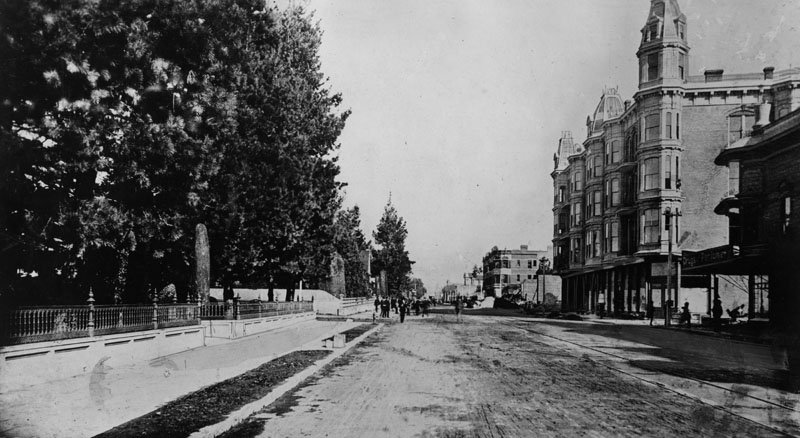
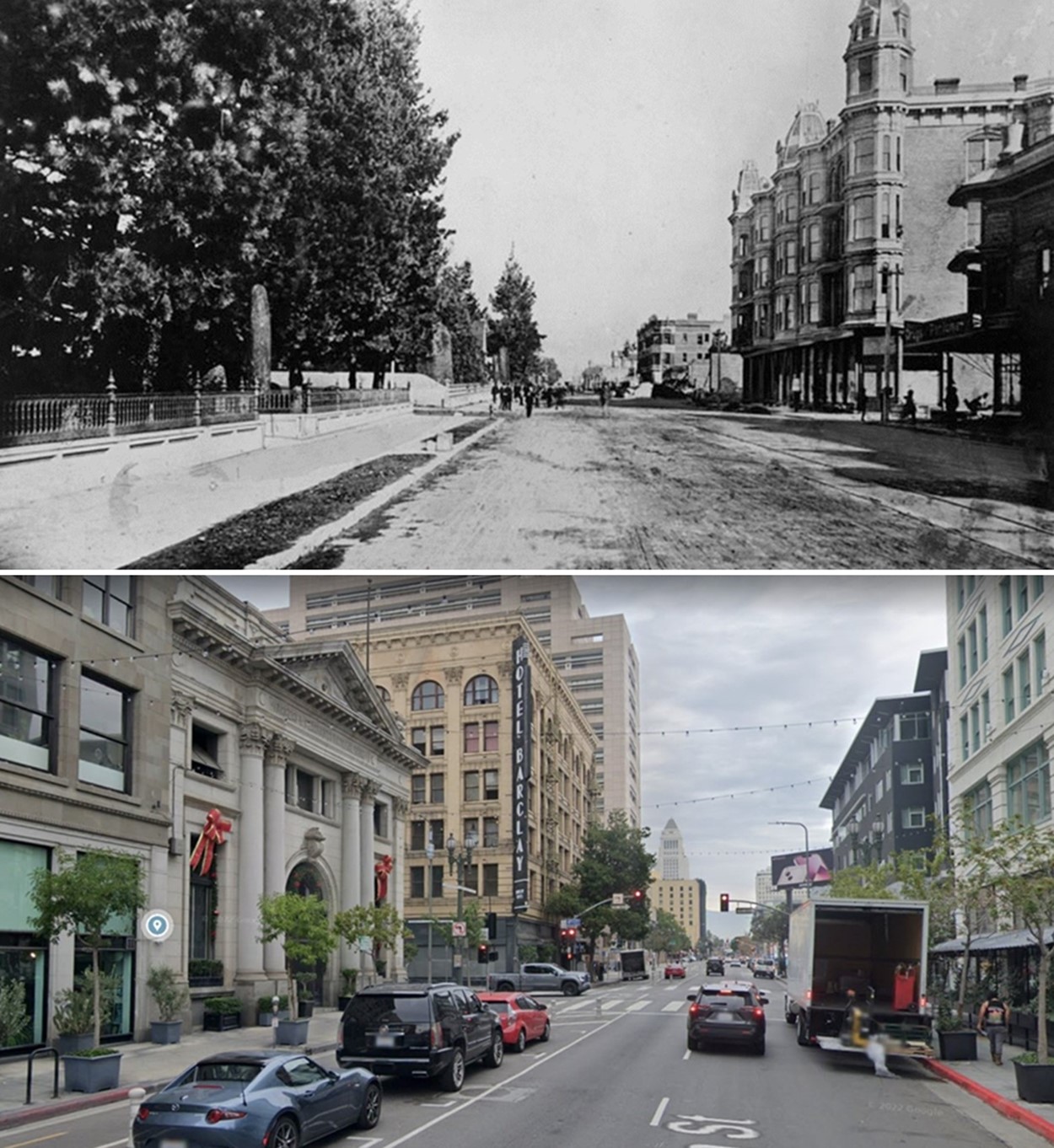
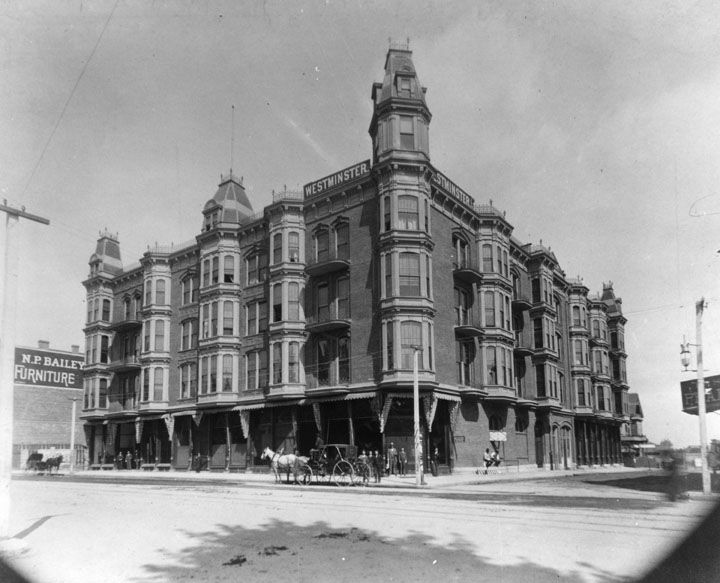
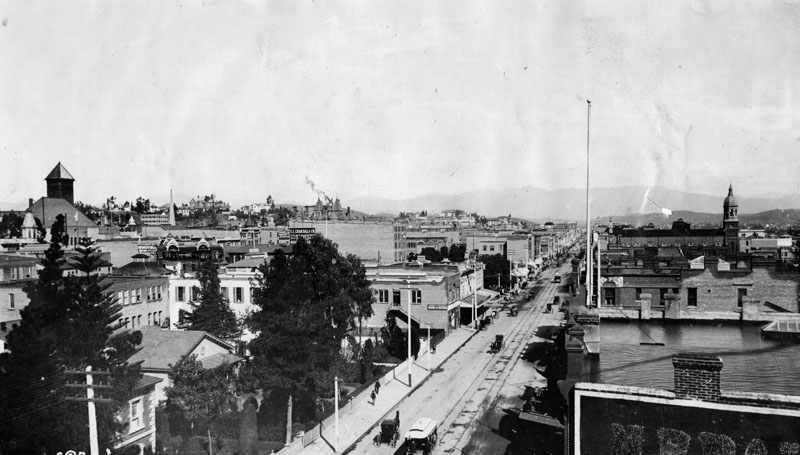
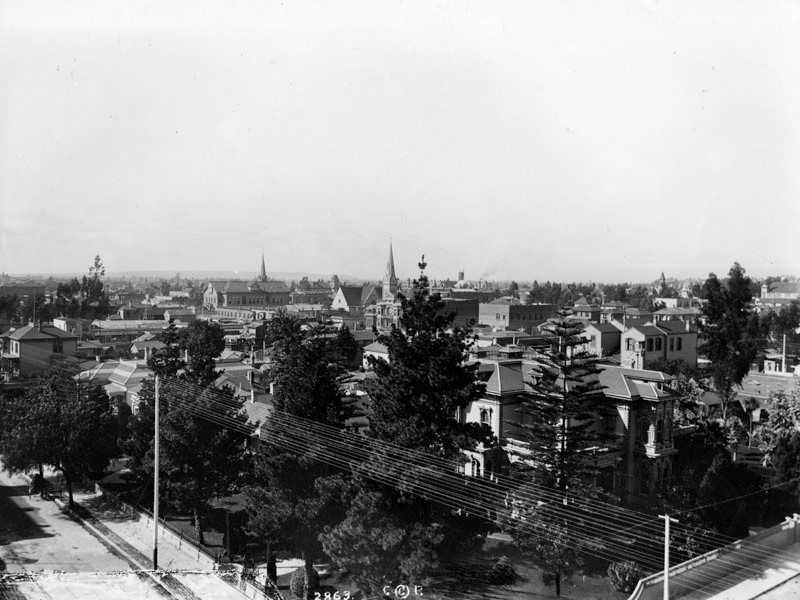
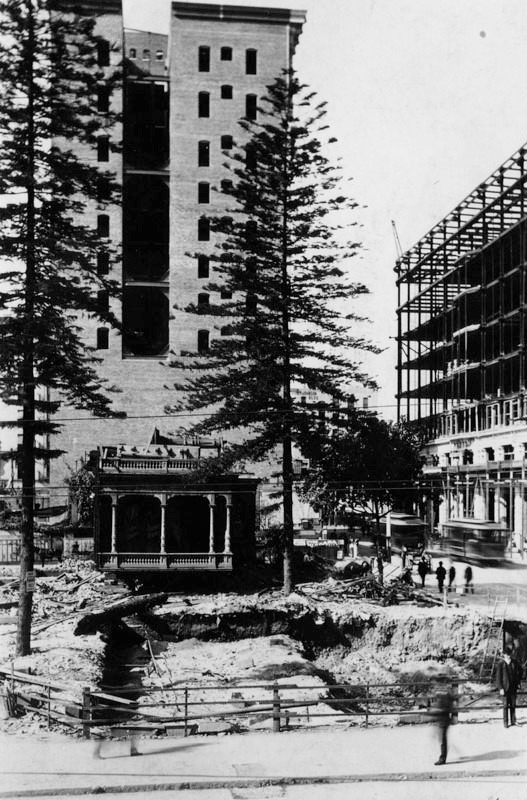
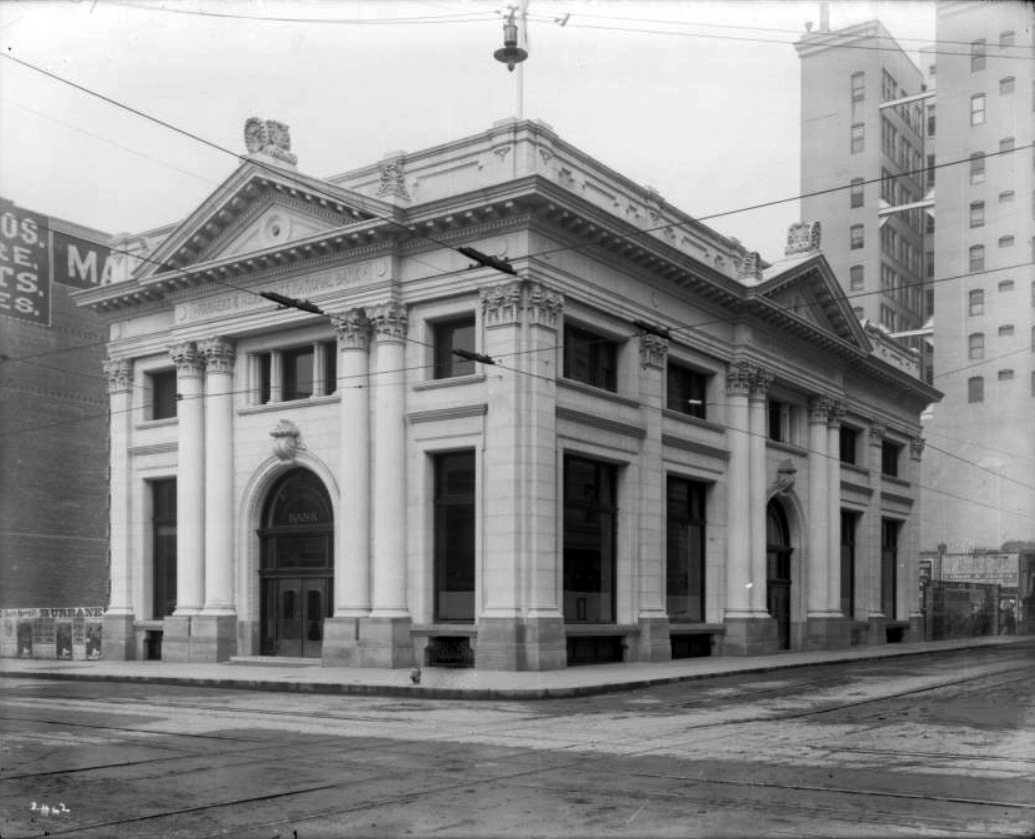
.jpg)
